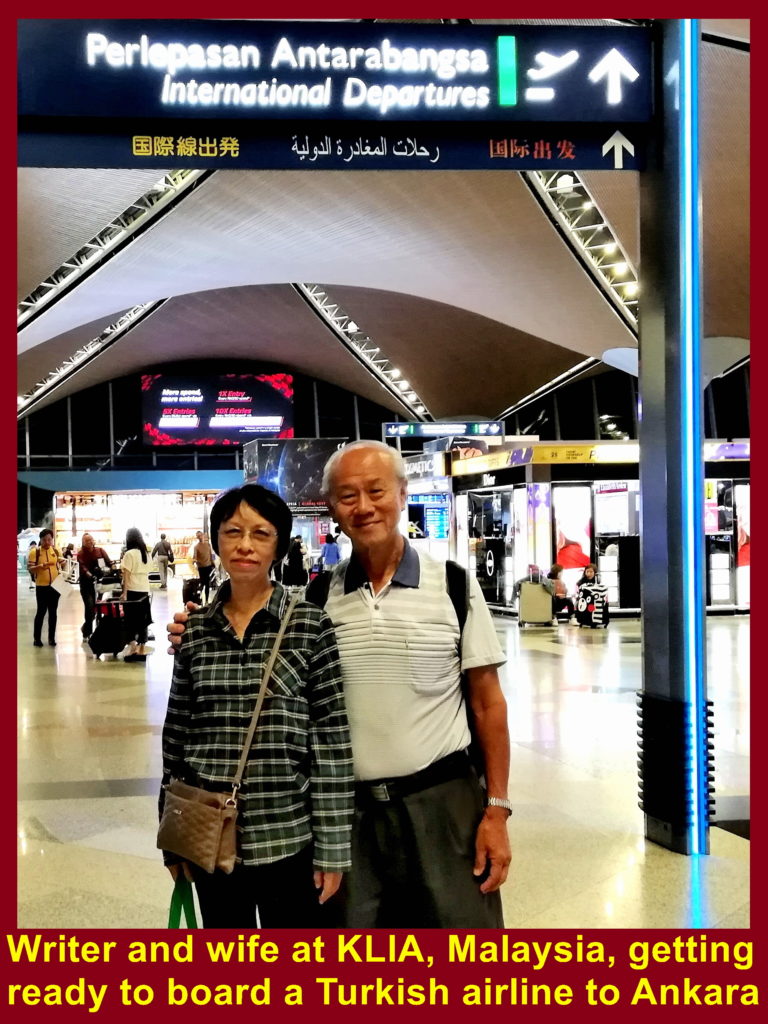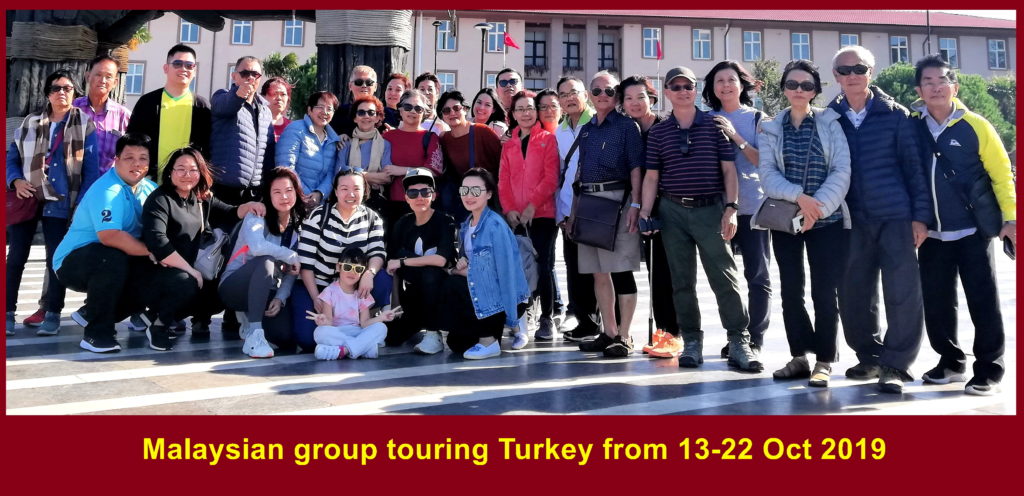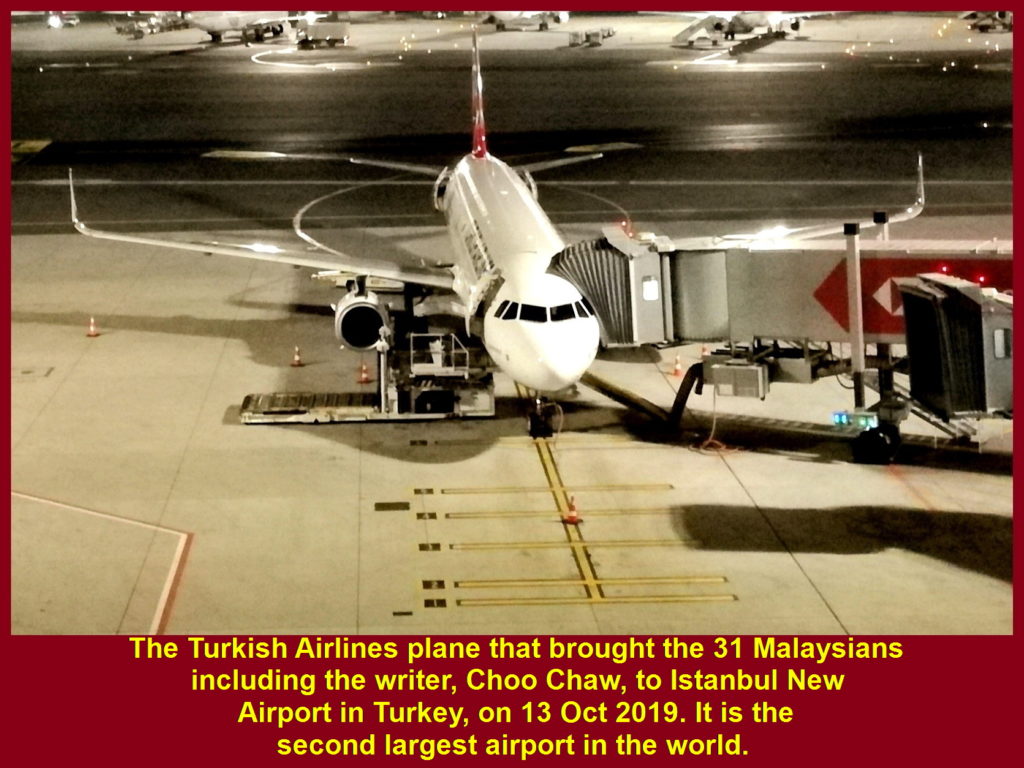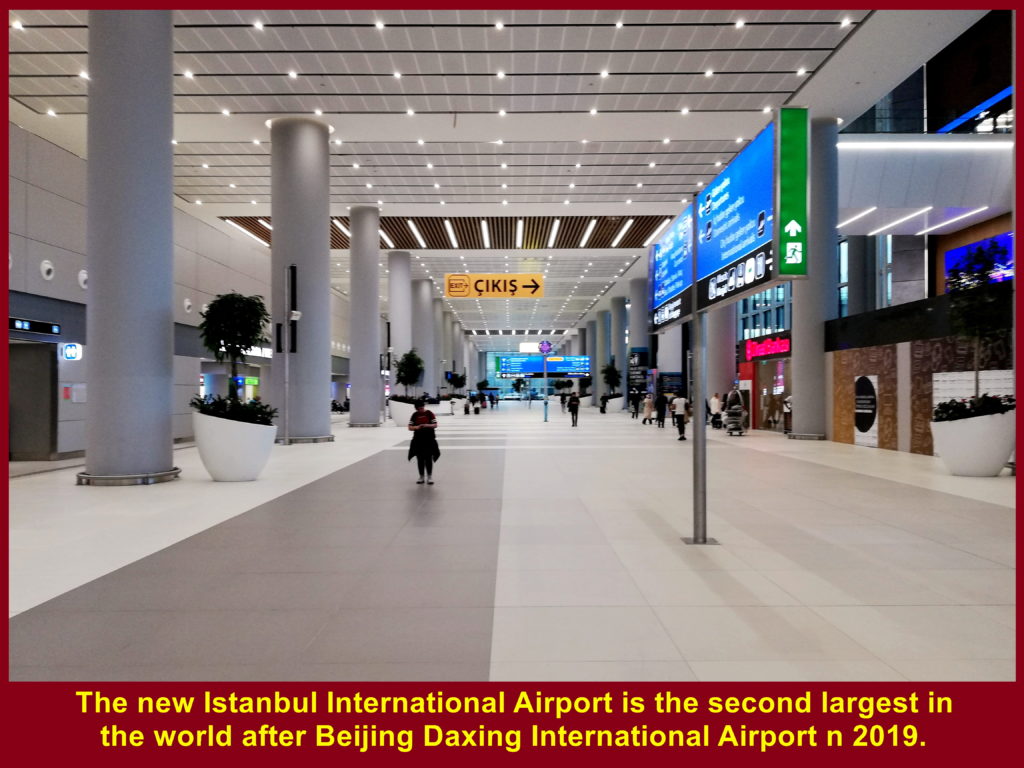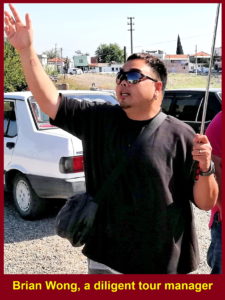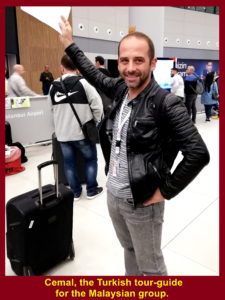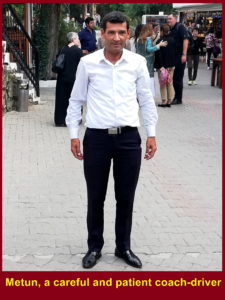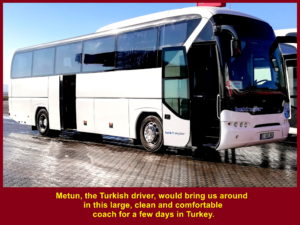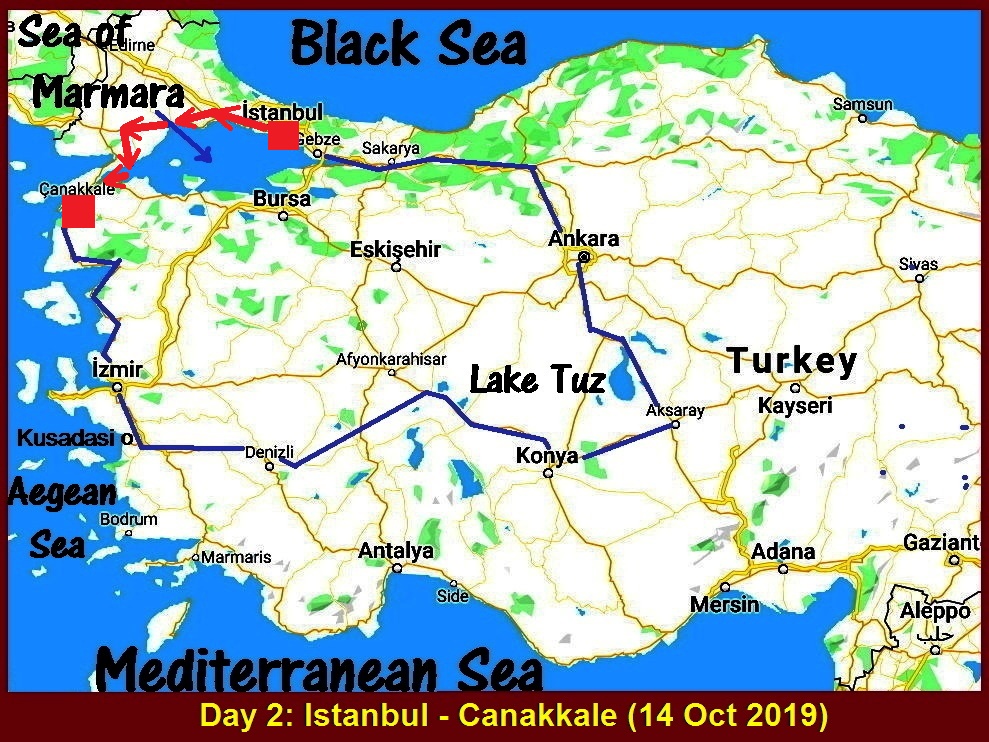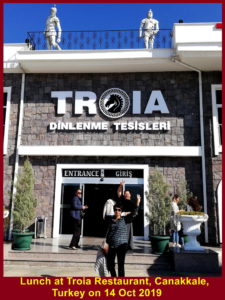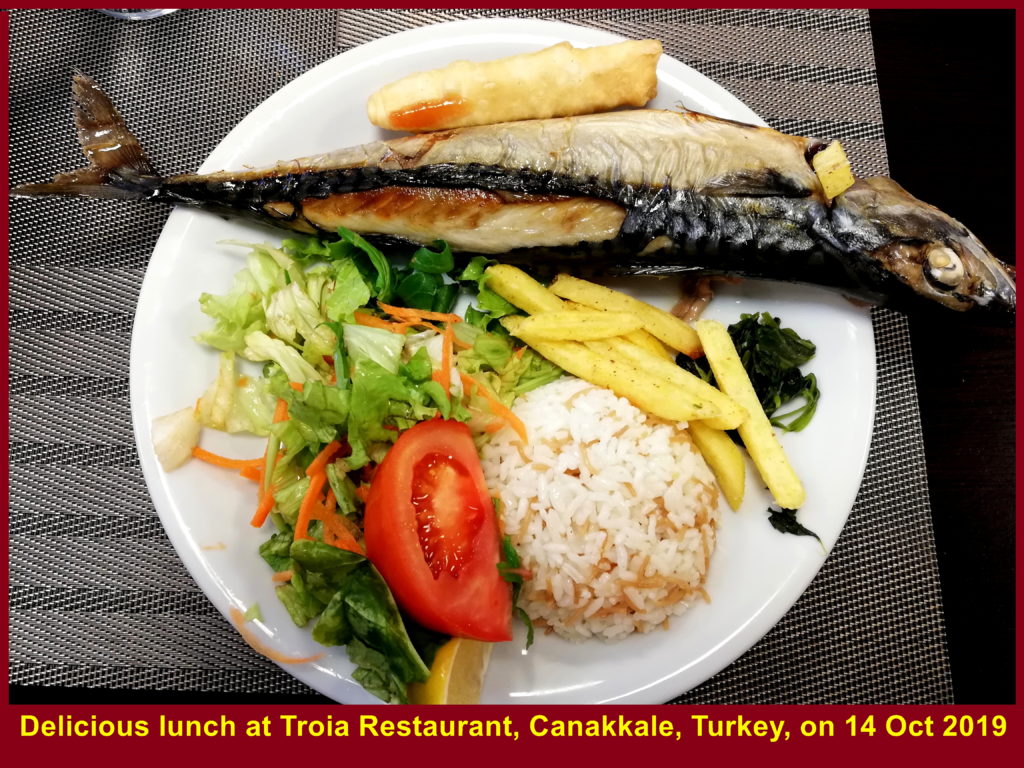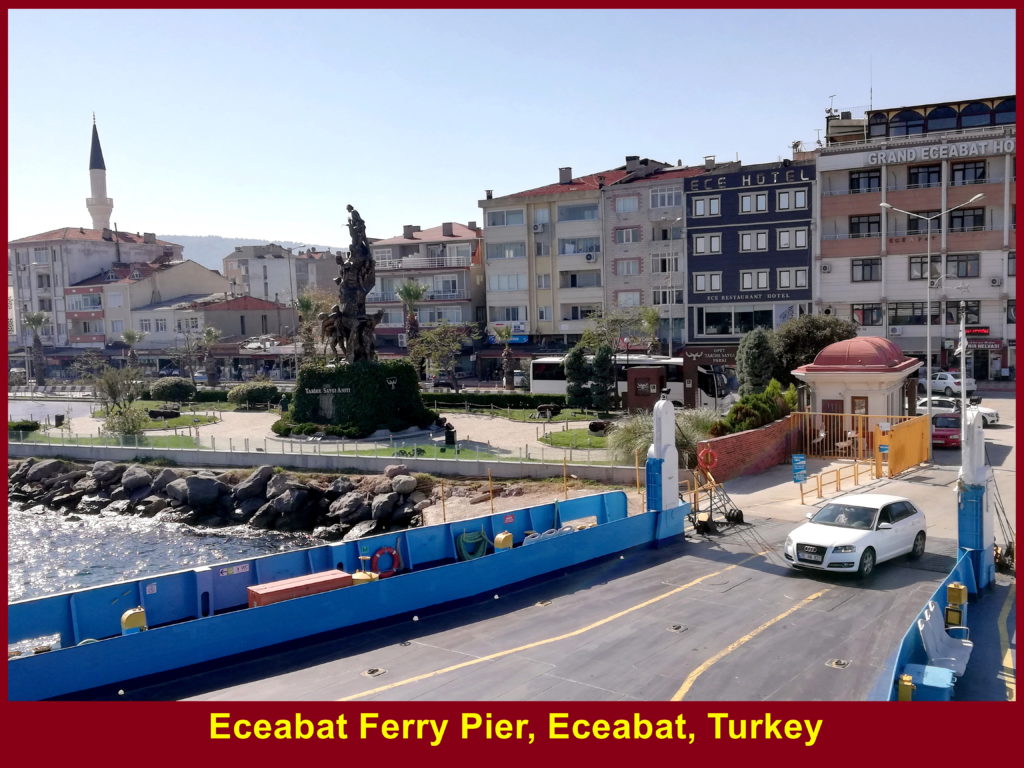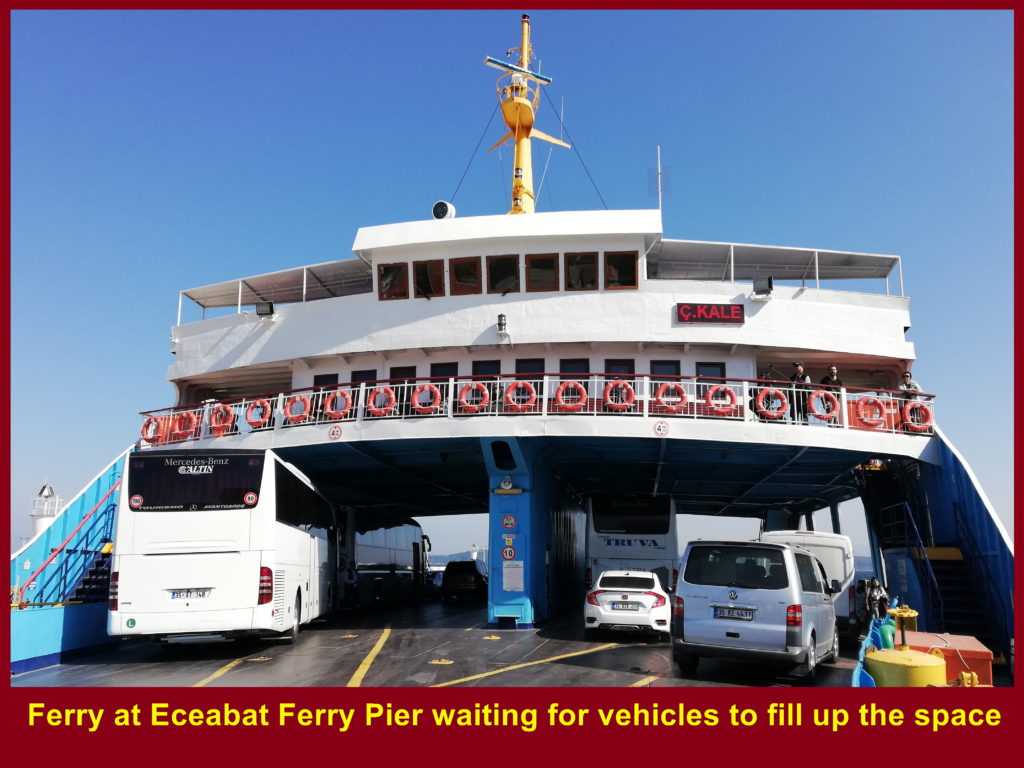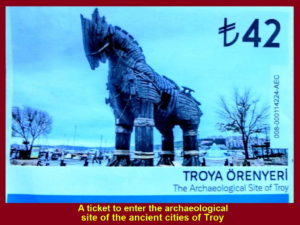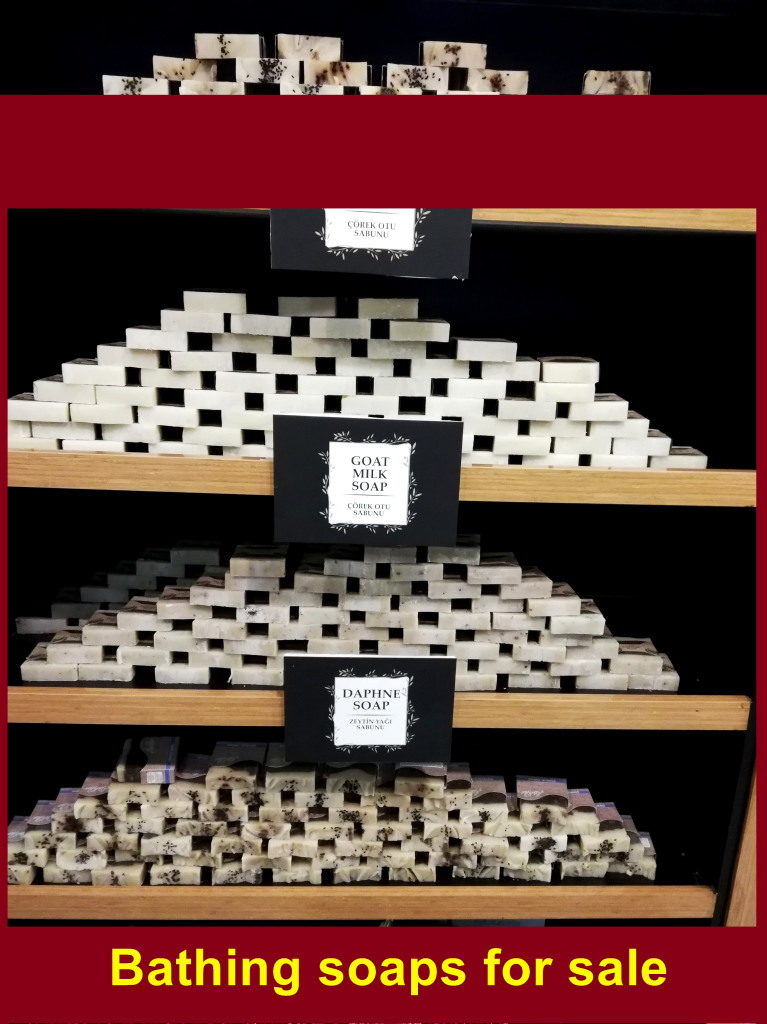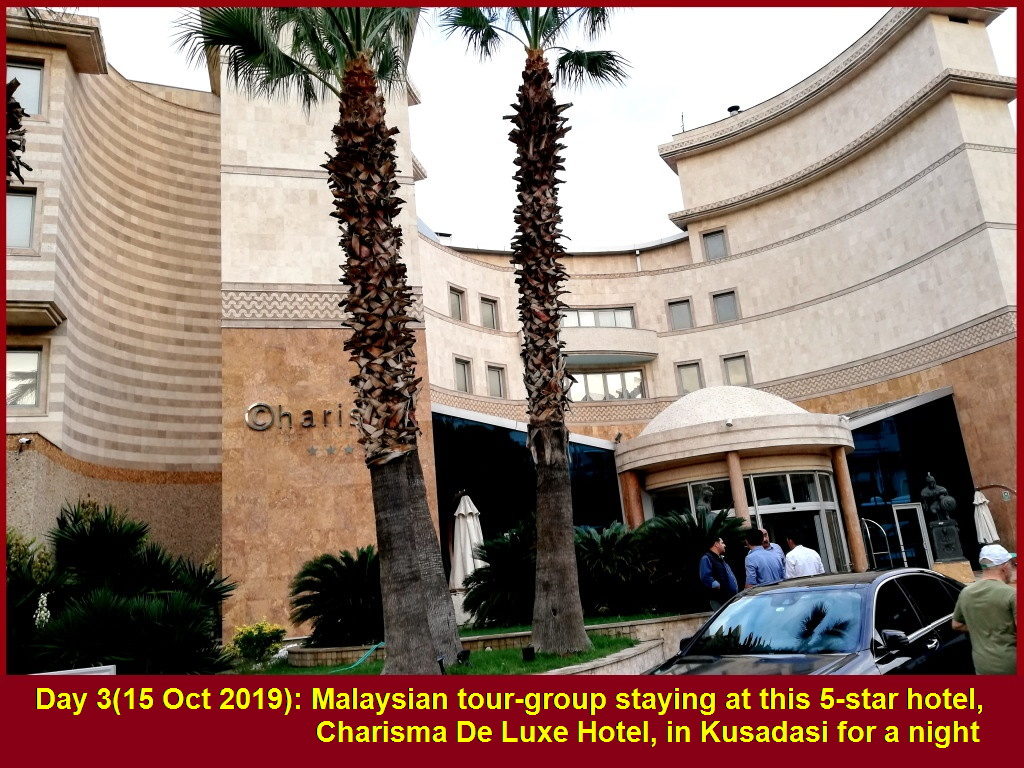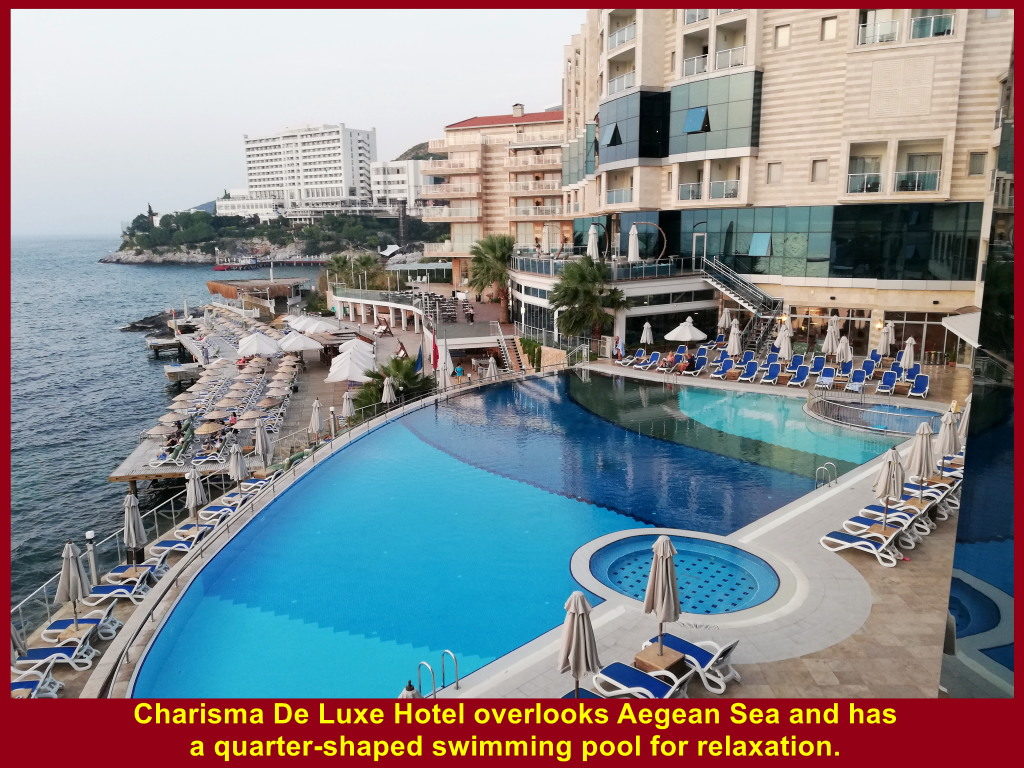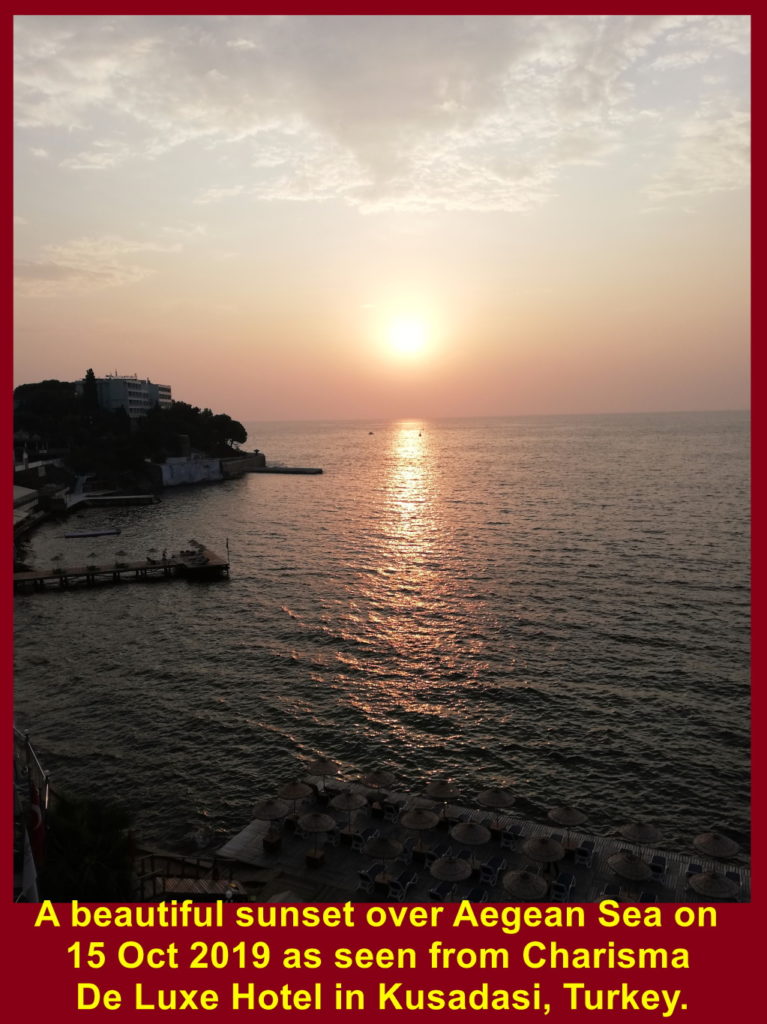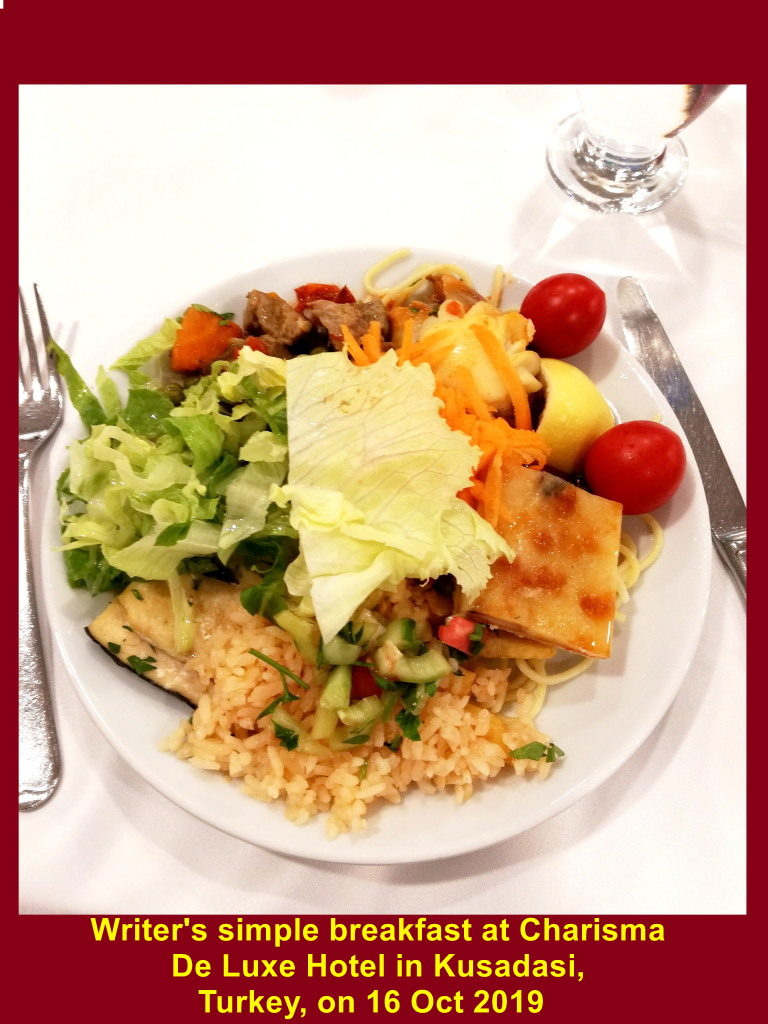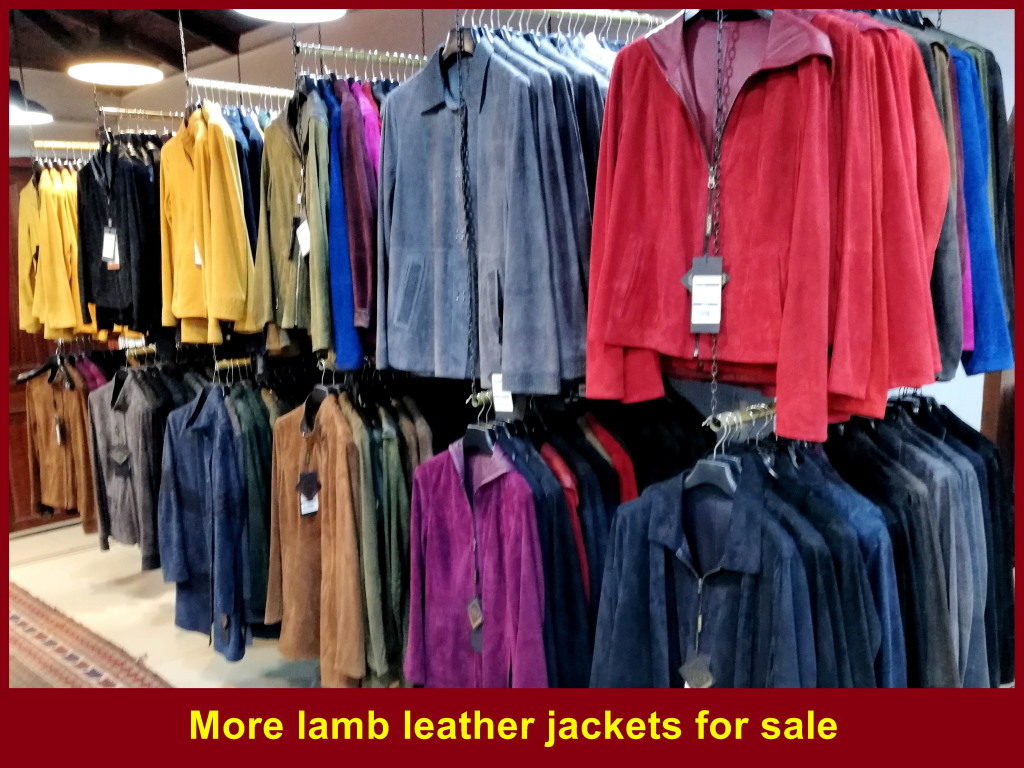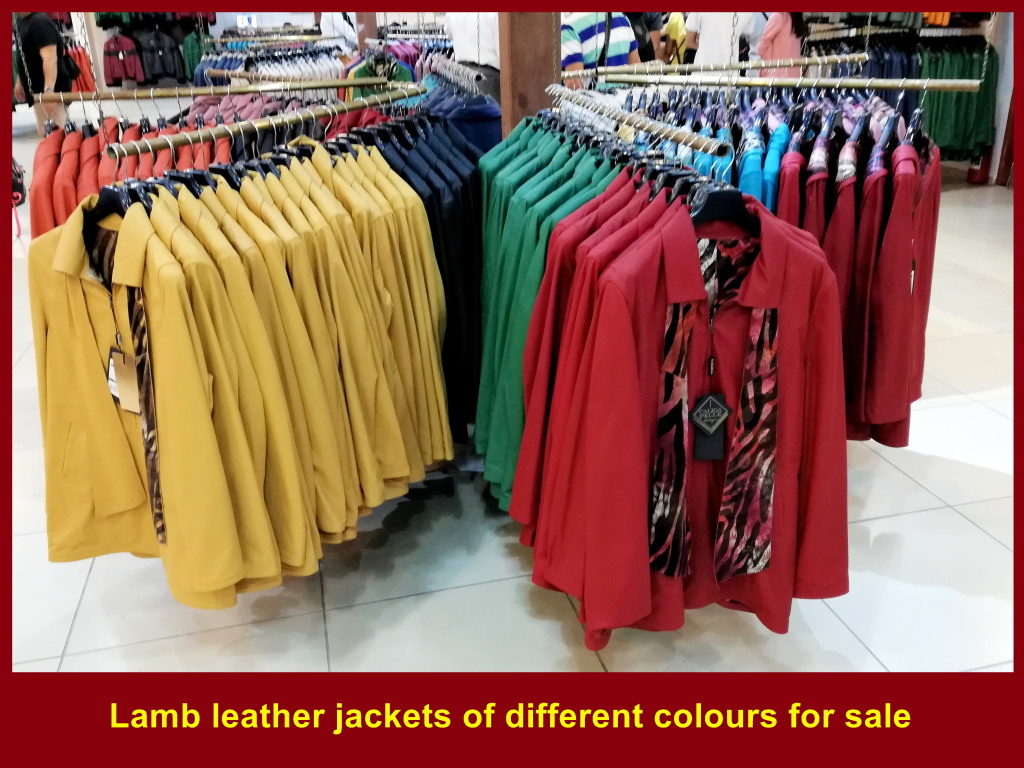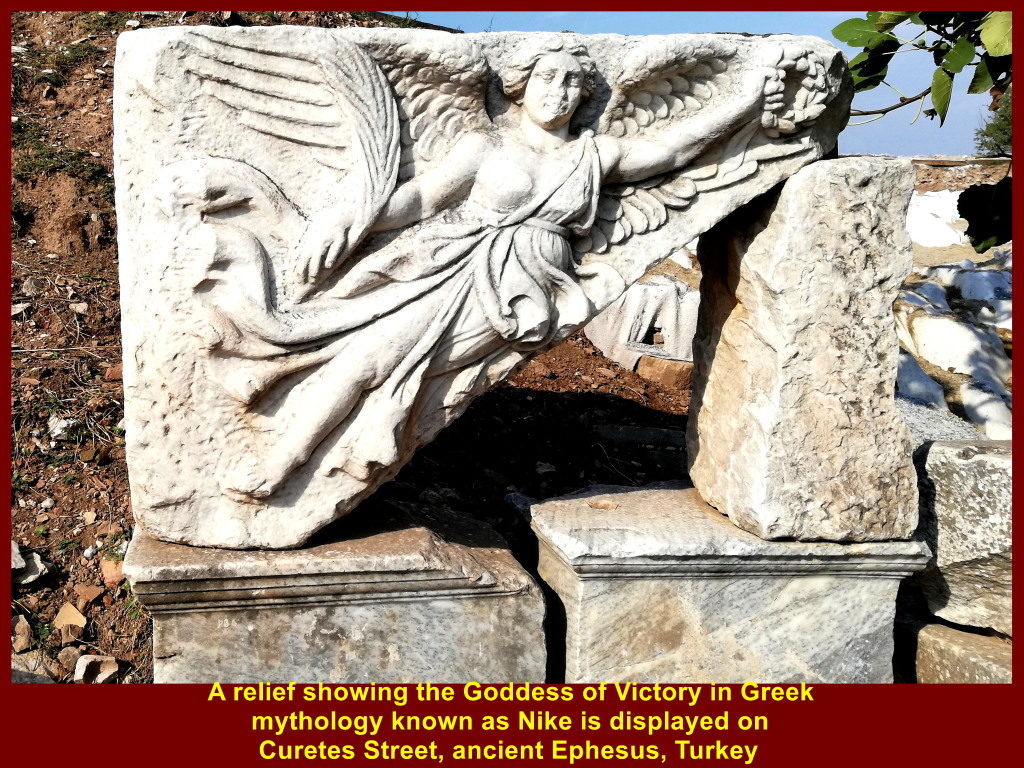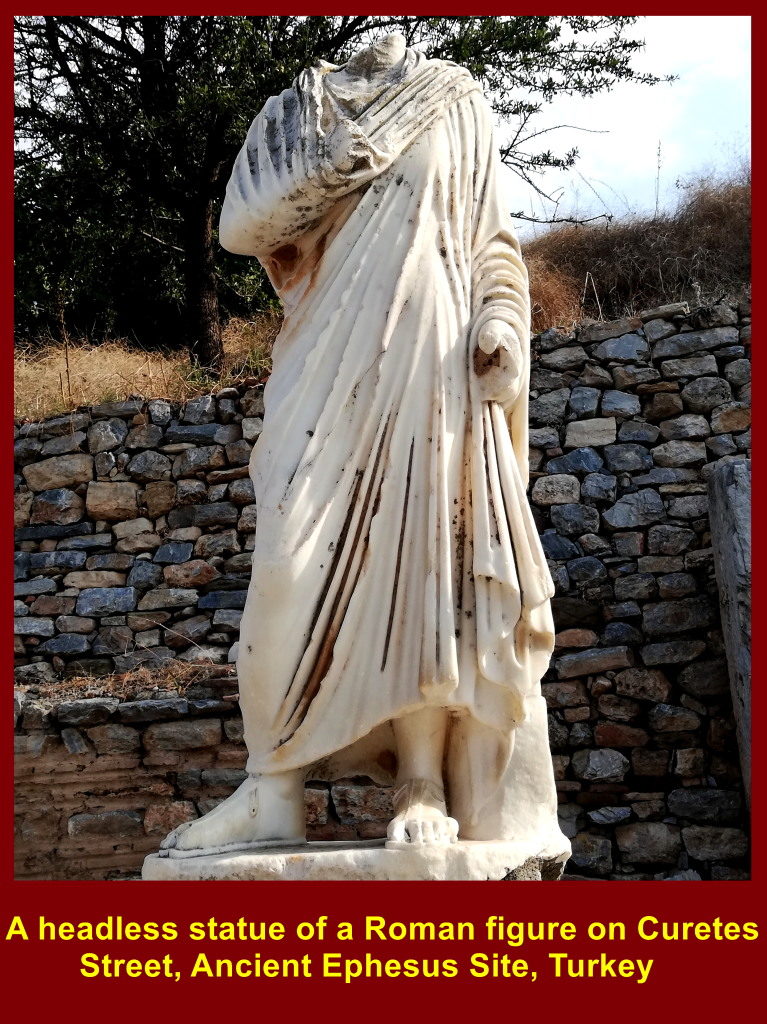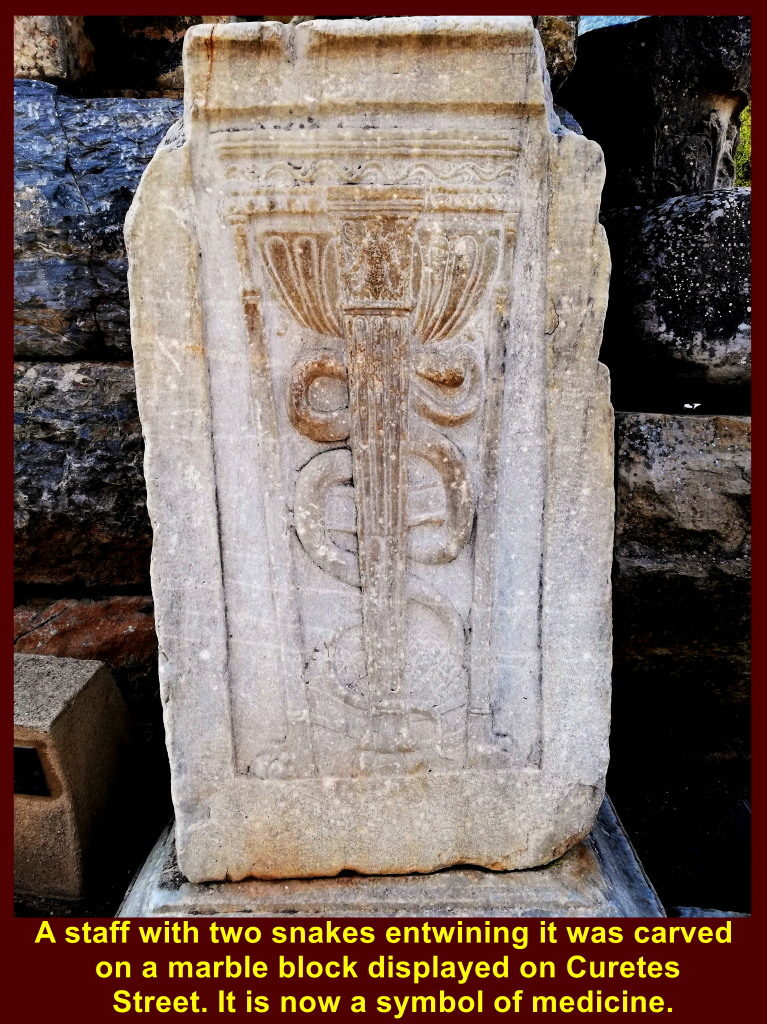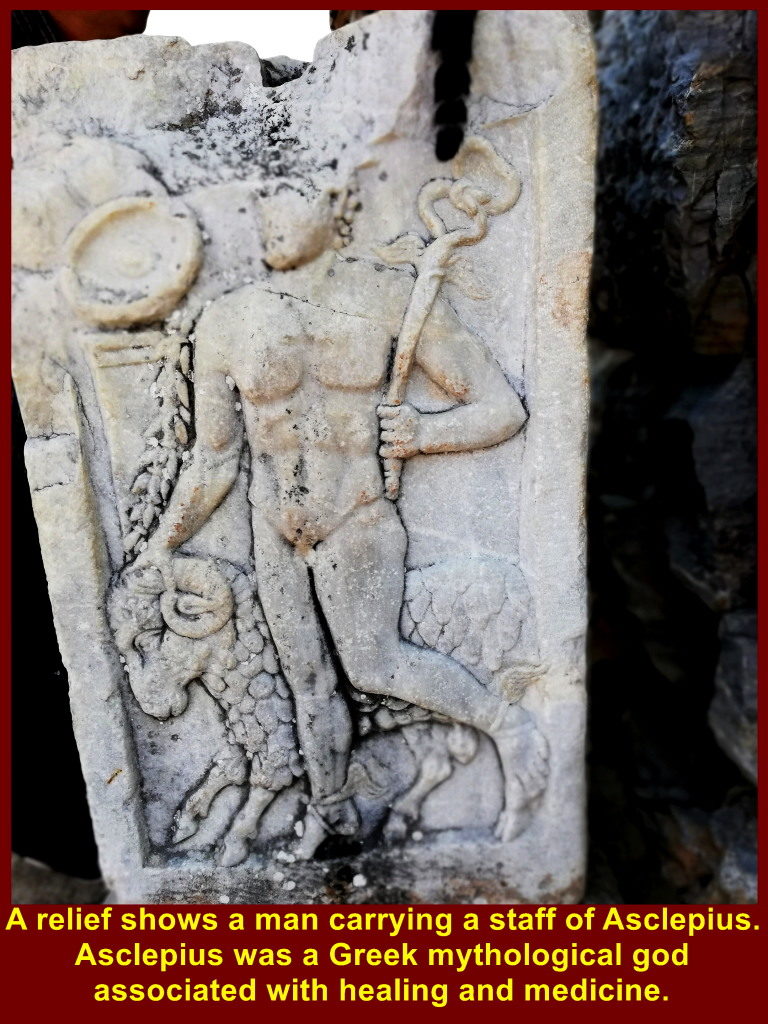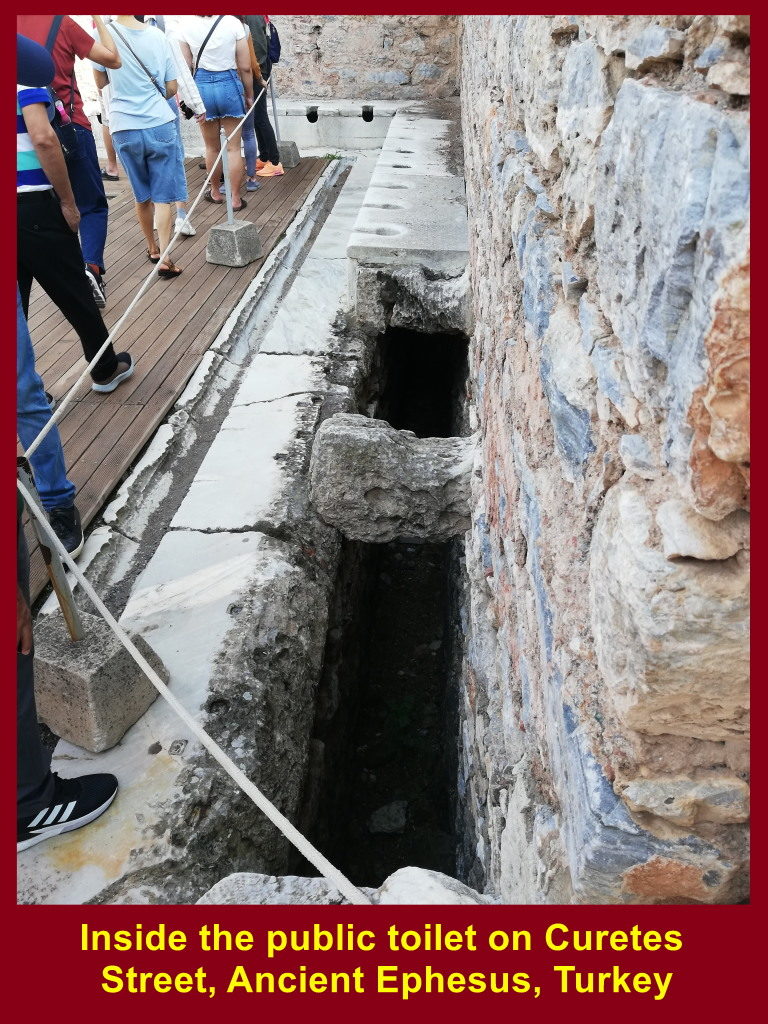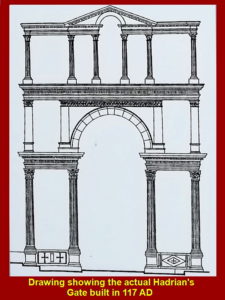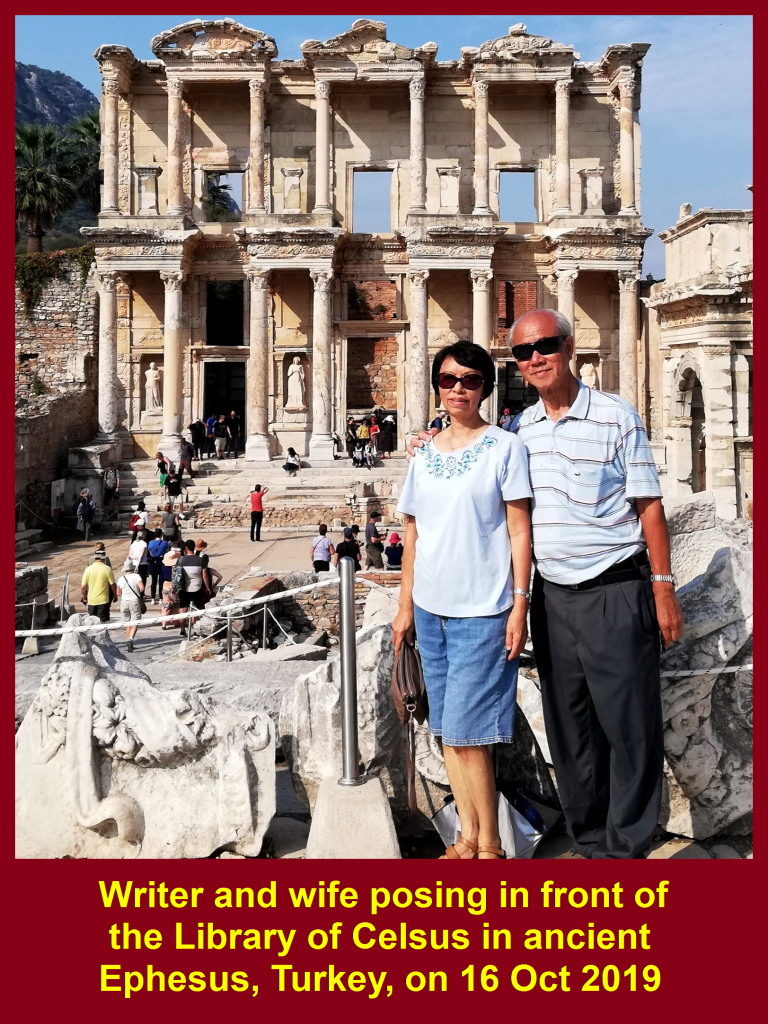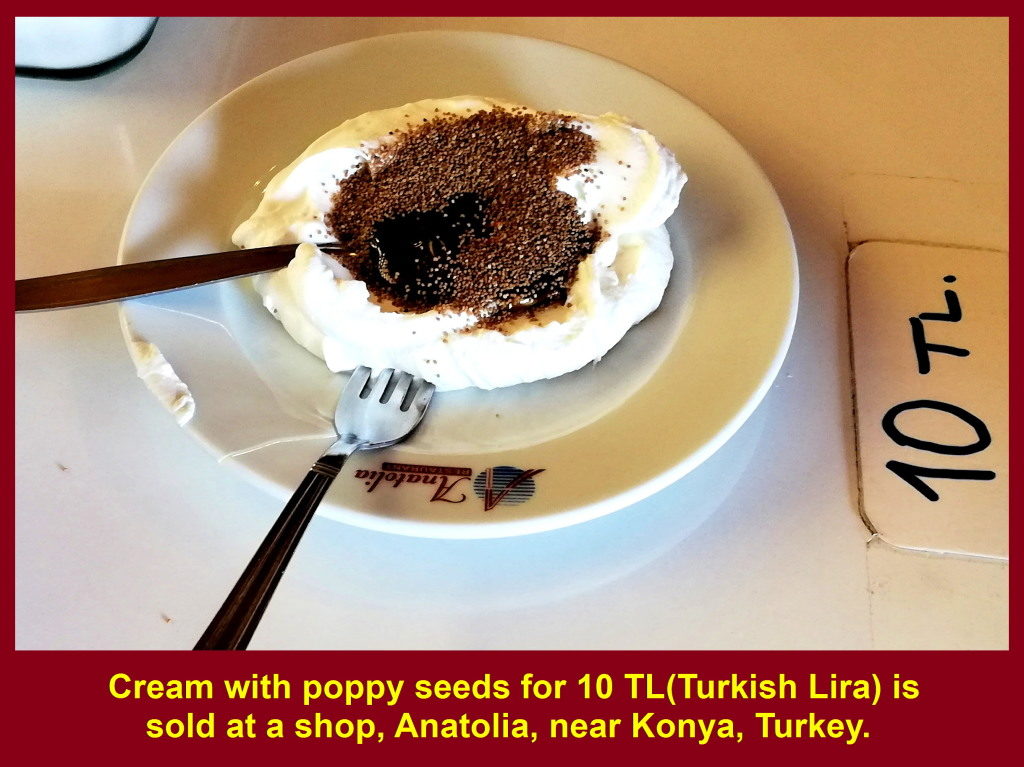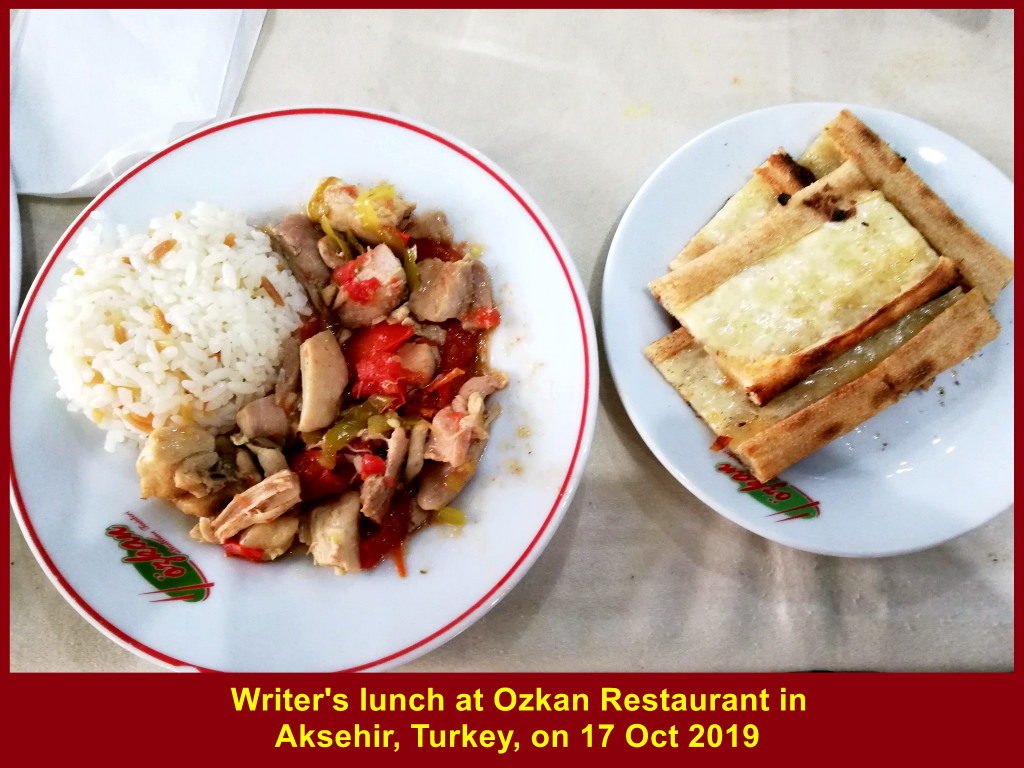Writer’s List of Visited Countries
Writer’s List of Visited Countries:
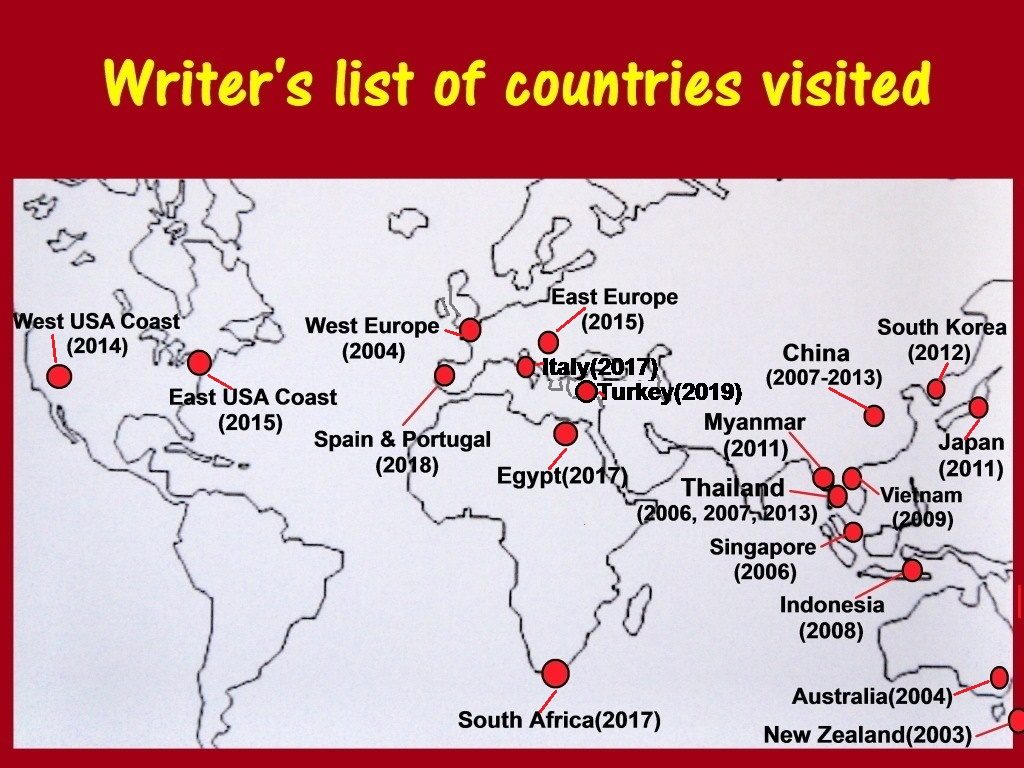
(Click on the name of a country or city below and read about the writer’s tour in the country or city.)
Australia Travel:
Part I: Melbourne/Mornington Peninsula/Phillip Island),
China Travel:
i. Beijing, Tianjin, Chengde Travel:
Part II: Beijing, Tianjin, Chengde
ii. China Relatives & Ancestral Places(Fujian Province)
Part I: Parents’ China Relatives
Part II: Hanjiang, Meizhou Island
iii. Hong Kong Travel
iv. Macau Travel
v. Shanghai Travel
Part I: Hangzhou, Suzhou, Wuxi, Nanjing
Part II: Nanjing Bridge, Shanghai City, Shanghai Expo, Hangzhou
vi. Shenzhou, Hezhou, Quilin, Zhaoqing Travel
Part II: Quilin, Yangshuo, Zhaoqing, Shenzhen
vii. Taiwan Travel
Part II: Checheng, Kaohsiung, Taichung, Sanyi, Yehliu, Jioufen
viii. Yunnan Travel
Part I: Kunming, Jiu Xiang, Shilin, Dali
ix. Zhangjiajie Travel:
Part I: Tianmen, Zhangjia jie, Wulingyuan, Tianzi, Yuangjiajie
Part II: Dragon King Cave, Shaoshan, Changsha, Macau
x. China Expedition 2013:
Egypt Travel
Part I :Salah el Din Citadel, Muhammad Ali Mosque, Tahrir Square and Egyptian Museum
Part II :Valley of the Kings, Hatshepsut Temple and Colossi of Memnon
Part III :Hot Air Balloons and Karnak Temple Complex
Part IV :Papyrus Paper-Making, Luxor Temple and Esna Lock
Part V :Edfu Temple, Kom Ombo Temple and Galabia Party
Part VI :Abu Simbel Temples and Nubian Village(Elephantine Island)
Part VII :Unfinished Obelisk, Aswan High Dam and Philae Temple
Part VIII:Ahmed Hamdi Tunnel, Moon Beach(Ras Sudr), and St. Catherine
Part IX :Mount Sinai, Catherine’s Monastery and Sharm el Sheikh
Part XI :Cairo Food, Saqqara Step Pyramid Complex and Memphis
Part XII :Great Giza Pyramid Complex and Khan el Khalil Bazaar
Europe Travel:
i. Eastern Europe Travel
Part VI: Prague(Czech Republic)
ii. Western Europe Travel
Part I: Germany, Switzerland, France
Part II: France, Belgium, Holland, England
Indonesia Travel:
i. Bali Travel
Italy Travel:
Part V(Final): Verona and Milan
Japan Travel:
Part I: Osaka, Kyoto, Hamamatsu
Part II: Owakudani Valley, Mt. Fuji, Tokyo
Myanmar Travel:
Part I: Yangon, Bagan, Mount Popa
New Zealand Travel:
Portugal Travel:
Singapore Heritage Trail Discovery:
Part I: Chinatown, Little India
Part II: Malay Heritage, Civic District
11. South Africa Travel:
Part I: Air Flight from KLIA to Cape Town, Cape Town Shantytowns
Part II: Table Mountain, Malay Quarter, Castle of Good Hope. A & V Waterfront
Part III: Hermanus, Cheetah Outreach, Stellenbosch, Jewel Africa
Part IV: Duiker Island of Seals, Cape Point, Boulders
Part V: Cape Town to Johannesburg, Pilanesberg National Park(Game Drives)
Part VI: Sun City, Union Buildings, Vootrekker Monument
Part VII: Kruger Museum, Church Square, Melrose Museum, Carnivore Restaurant
Final Part: Gold Reef City: Gold Mine Museum
South Korea Travel:
Part II: Sokcho, Everland, Dongdaemum, DMZ, Seoul
Spain Travel:
Thailand Travel:
i. Bangkok, Ayuthaya Travel:
ii. Chiang Mai, Chiang Rai, The Golden Triangle Travel:
Part I: Chiang Mai, Chiang Rai, The Golden Triangle
iii. Phuket Travel:
iv. Part I: Thailand (from China Expedition 2013)
Turkey Travel:
Trojan Horse/Ancient Troy Cities
Hierapolis/Pamukkale Travertine
Uchisar Valley/Kaymakli Underground City
Gerome Valley/Turkish Night Show
Hot Air Balloon/Lake Golu/Anitkabir
Hagia Sophia/Topkapi Palace/Blue Mosque
U.S.A & Canada Travel:
i. East Coast of U.S.A. & Canada
Part I: Philadeiphia, Washington D.C.
Part II: Niagara Falls, Toronto
Part III: Colborne, 1000 Islands, Ottawa
Part VII: Woodbury Common Premium Outlets
ii. West Coast of U.S.A.
Part II: San Francisco, Monterey Bay, Las Vegas
Part V: Premium Outlets(S. California)
Part VII: Hollywood Walk of Fame(Los Angeles)
Part VIII: Universal Studios Hollywood
Part IX: Universal Studios Hollywood Theme Park
15. Vietnam Travel:
Hanoi:
Part II: Hoa Lo, Tam Coc, Hanoi
END
Turkey Travel Part I: Ancient Troy Cities
Day 1
Sunday, 13 Oct 2019
Departure to Istanbul
Long Journey to Istanbul from Malaysia
At 11.20 p.m. on 13 Oct 2019(Malaysian time and date), the writer, Choo Chaw, and his wife together with 29 Malaysians flew by a Turkish Airlines plane from KLIA, Malaysia, to Istanbul to visit some interesting places in Turkey.
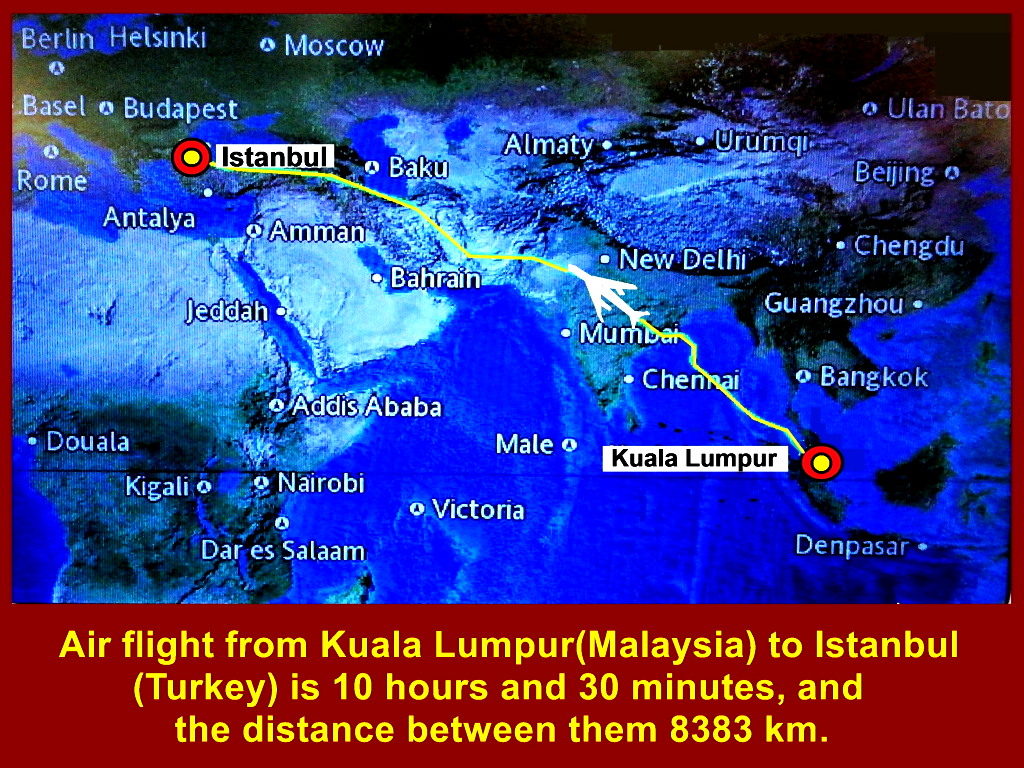
Writer and Wife at KLIA
Writer and wife at KLIA, Kuala Lumpur, Malaysia, getting ready to board a Turkish Airlines plane.
Writer’s Tourmates
Below was the Malaysian group of 31 members(including writer and wife) going to Turkey for a short vacation from 13-22 Oct 2019
Air-flight to Istanbul
Air-flight from KLIA(Kuala Lumpur) to Istanbul(Turkey) takes 10 hours and 30 minutes, and the distance between them is 8383 km.
Location of Istanbul in Turkey
The map below shows the location of Istanbul in Turkey
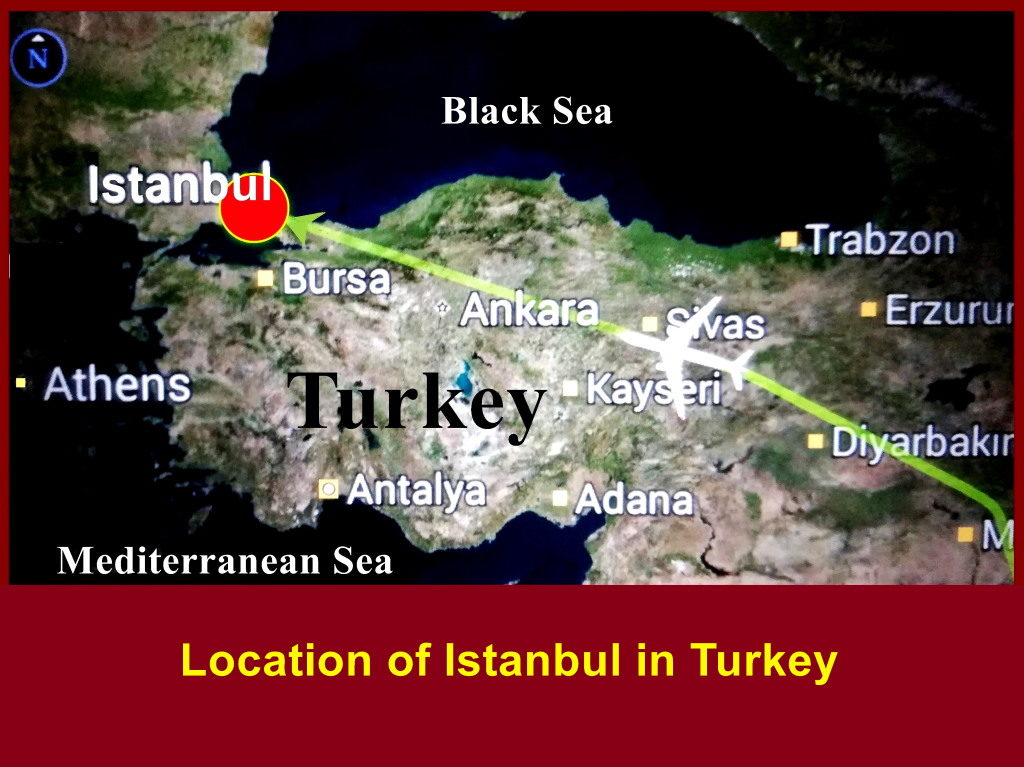
Day 2
Monday, 14 Oct 2019
Arrival at Istanbul
The Turkish Airlines plane that carried us arrived at Istanbul New Airport, at 5.30 am on 14 Oct 2019(Turkey time and date).
Turkish Airlines Plane
The Turkish Airlines plane in the photo below brought all of us to Istanbul New Airport in Turkey from KLIA, Kuala Lumpur, Malaysia, safely.
New Airport of Turkey
The New Airport in Istanbul opened on 29 Oct 2018 is the second largest in the world after Beijing Daxing International Airport in China which was opened on 25 September, 2019.
The photo below shows the interior of a small part of Istanbul New Airport, Turkey
Tour Manager
Our capable tour group manager, Brian Wong, from a travel agency, Chiu Travel Sdn. Bhd. in Batu Pahat, Johor, Malaysia, would lead us in the Turkey tour.
Turkish Tour Guide
On arrival at Istanbul New Airport, a Turkish tour-guide, Cenmal, welcomed us. He would bring us around in his country during the tour.
Turkish Coach-Driver
Metun, our Turkish coach-driver, would drive us around for several days in Turkey. He was a careful and patient driver.
Coach
Metun’s coach was large, clean and comfortable for the journey in Turkey.
Travel from Istanbul to Canakkale
When we arrived at the Istanbul New Airport, Metun drove us to Canakkale which was 240 km away in the south-west.
Lunch at Troia Restaurant
On the way to Canakkale, we stopped at a restaurant, Troia Restaurant, for lunch.
Writer’s lunch at the restaurant was delicious although it was simple.
Ferry from Eceabat to Canakkale
After lunch we continued our journey. Soon we arrived at Eceabat where we boarded a ferry and crossed Dardanelles Strait to Canakkale City which is 6 km away in 25 minutes.
Eceabat Ferry Pier, Eceabat, Turkey, as shown in the photo below.
Ferry for Passengers and Vehicles
The ferry we boarded was large and sailed smoothly to Canakkale.
Departure to Canakkale
Canakkalle City is 6 km from Eceabat
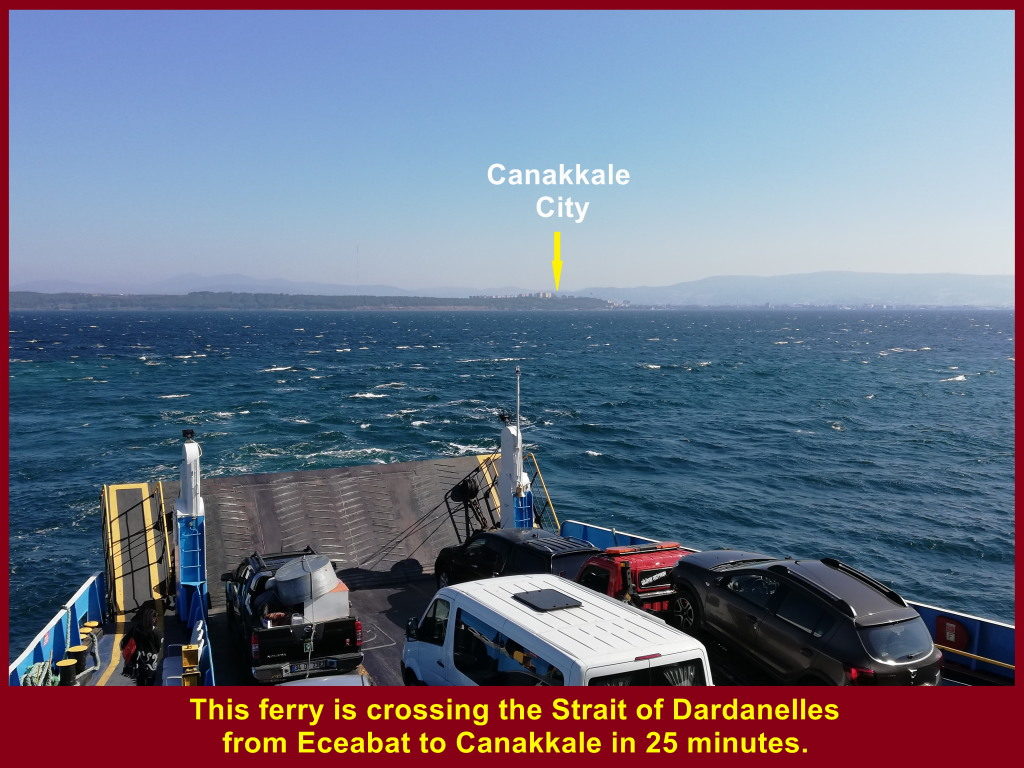
Writer and wife on a ferry from Eceabat to Canakkale
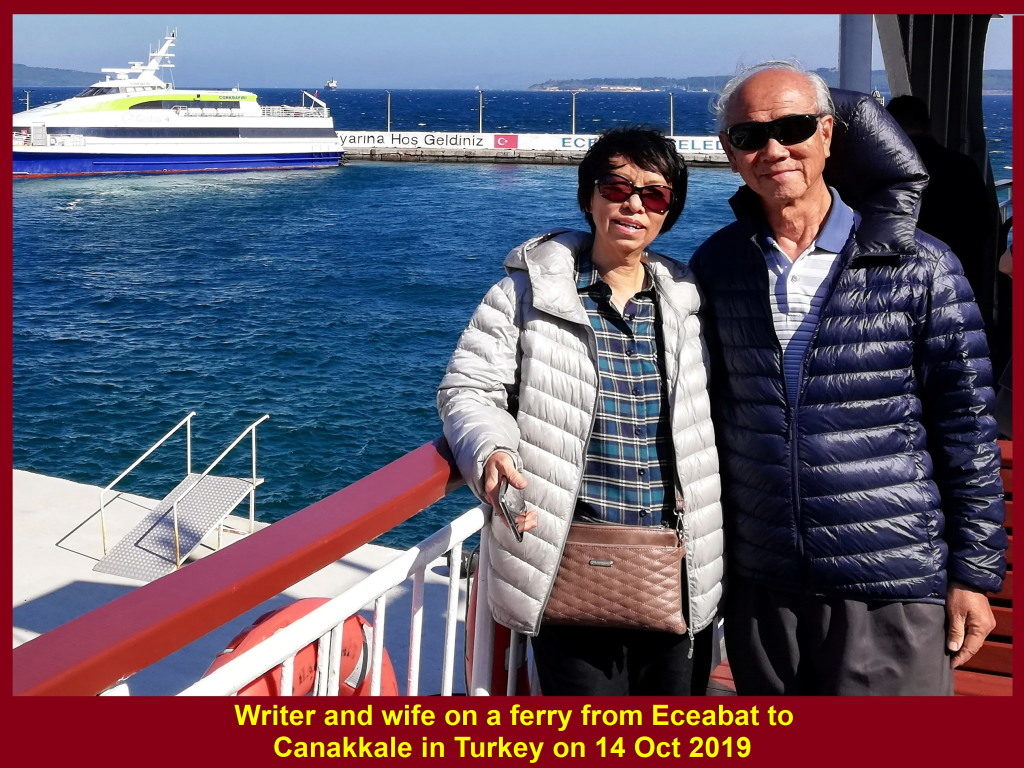
Arrival at Canakkale
25 minutes later, we arrived at Canakkale ferry terminal and went straight to a waterfront nearby.
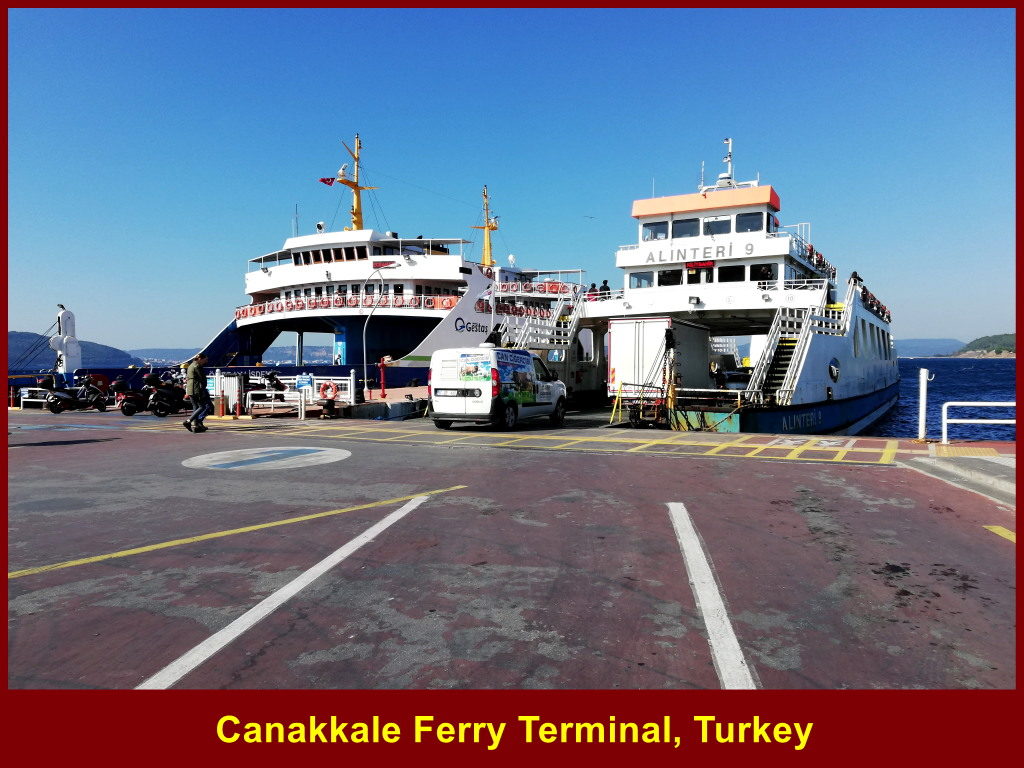
From the ferry terminal we saw the Canakkale Waterfront.
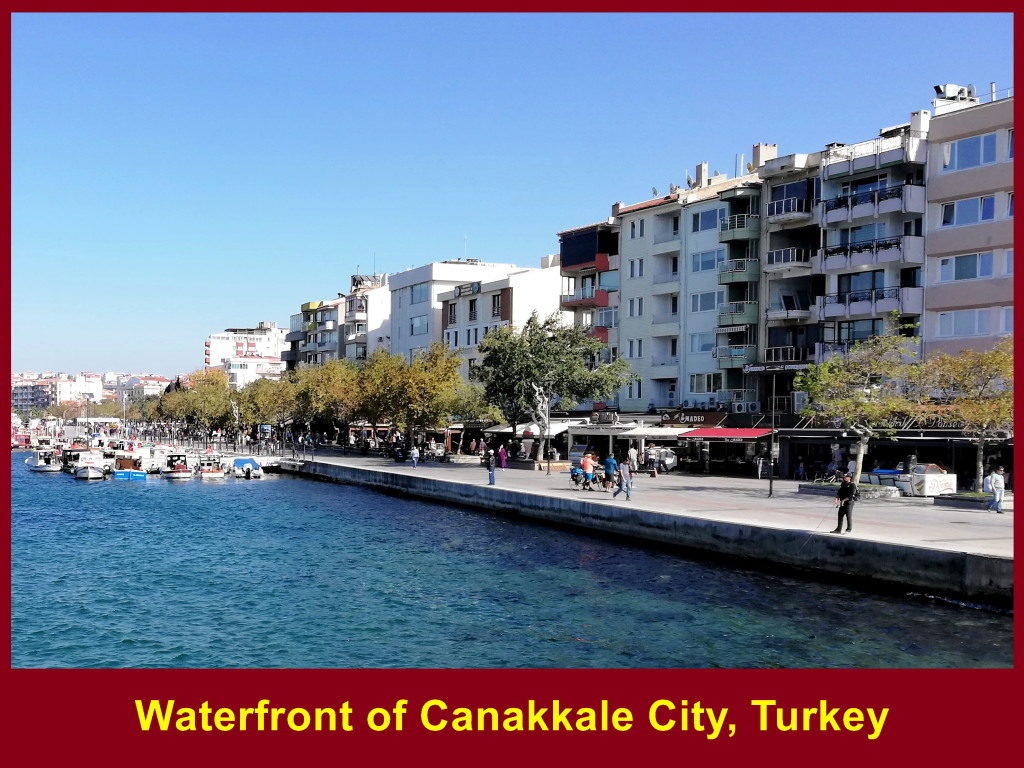
Trojan Horse
On the waterfront we were awe-struck by a huge wooden black Trojan Horse. It was used in making a 2004 movie known as “Troy”.
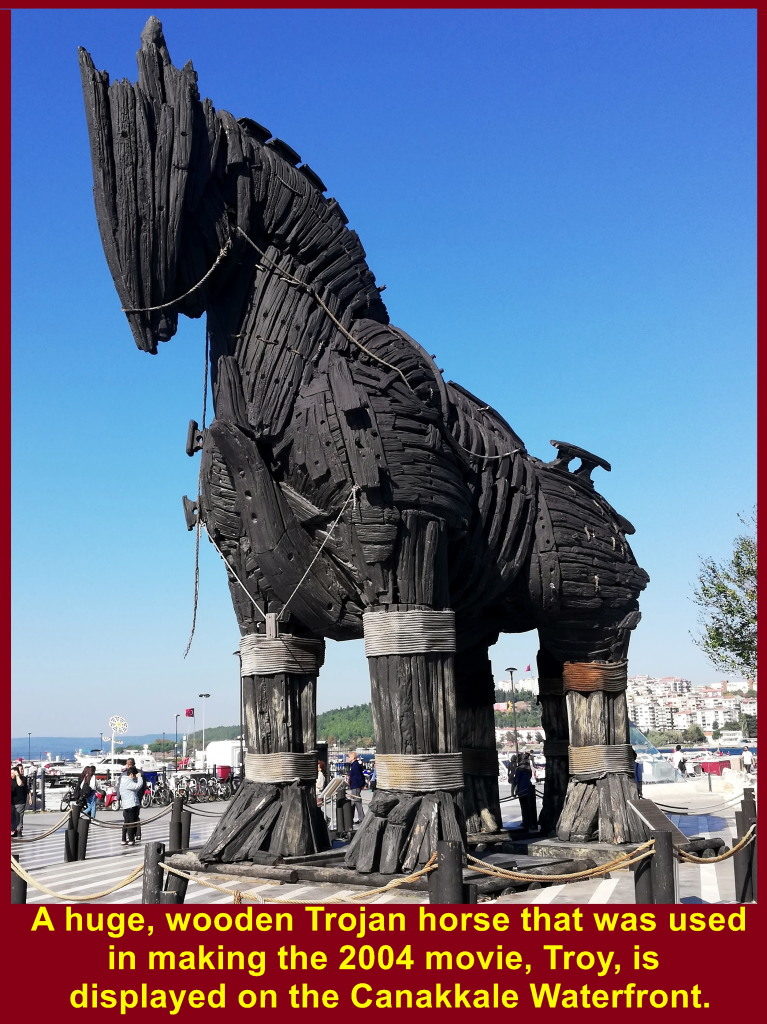
Group Photo
We took an opportunity to take a group photo in front of the black horse for remembrance.
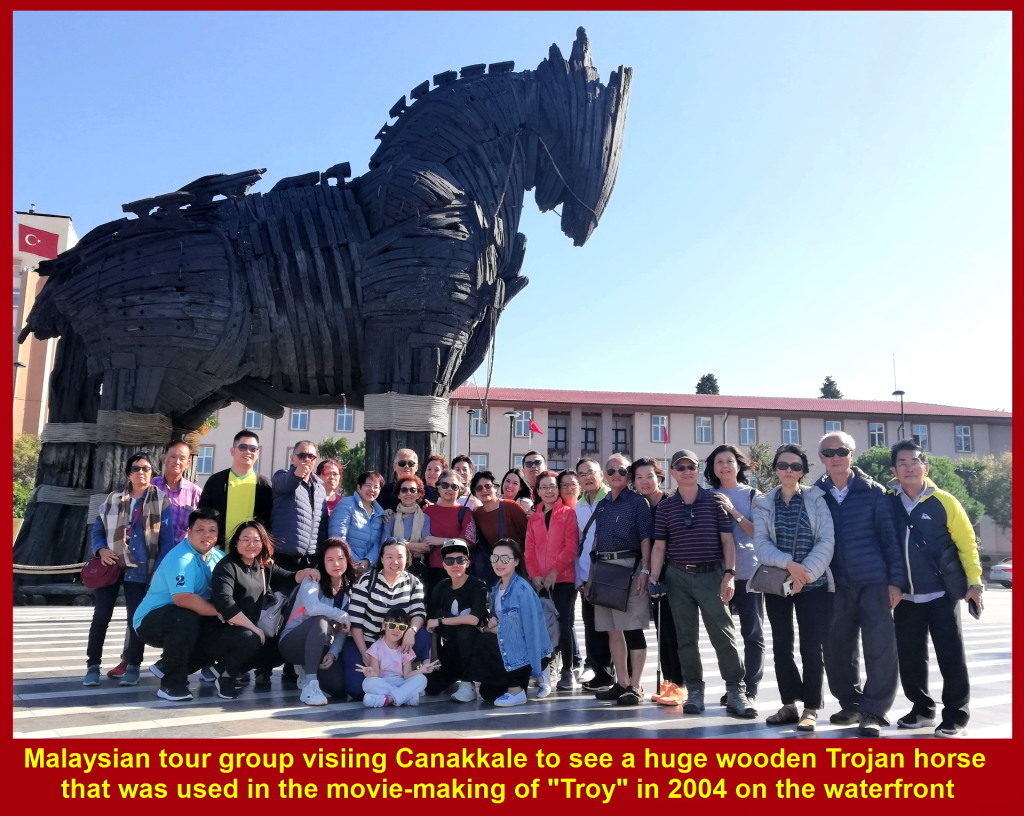
The Trojan Horse Story
According to a Greek mythological story, a Greek army in ancient times failed to capture Troy in Turkey for 11 years. Then they gave a huge wooden horse to the king of Troy as a present. At night the Greek soldiers hidden in the horse appeared and attacked the Troy soldiers. Subsequently, the Greek army captured the place.
Archaeological Ancient Site of Troy(3500 BC-500 AD)
After an hour on the waterfront, we left the Canakkale Waterfront and travelled 27 km to an archaeological ancient site that is known as “Troy”. It is a place where 9 ancient cities were built one on top of each other in a period of 3500 years from 3000 BC until 500 AD.
Entrance of the Site
At the entrance of the site, we queued up to enter the archaeological ancient site of Troy with a fee.
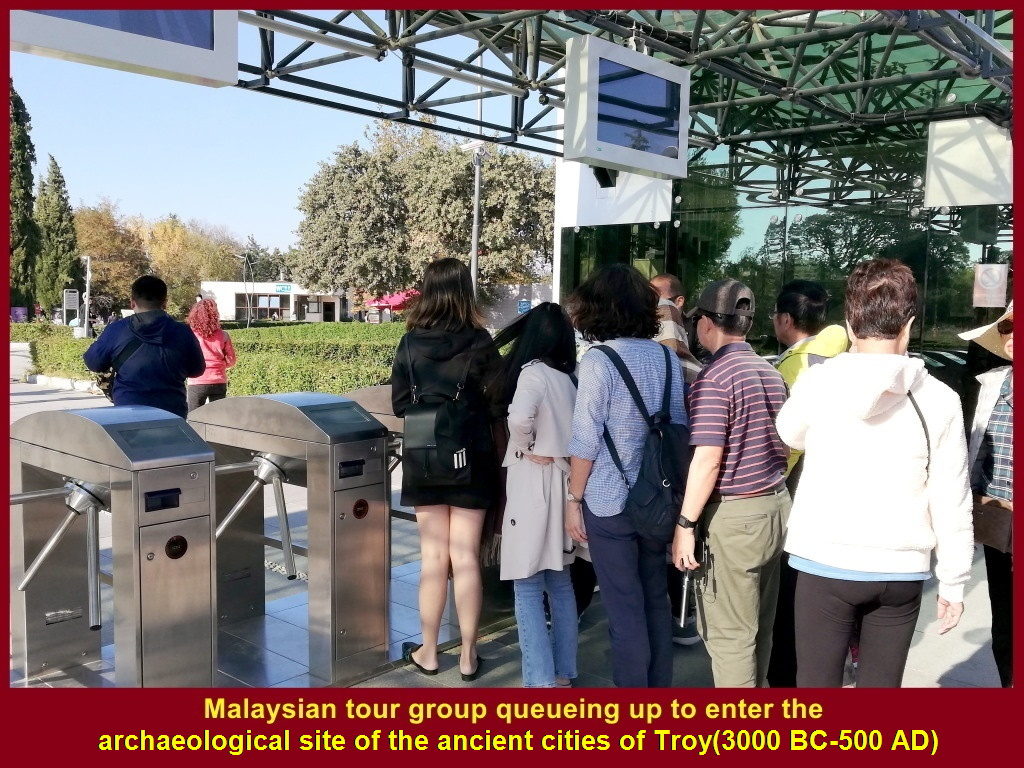
A 42 TL(Turkish Lira) ticket was required for a visitor to enter the site.
Replica of Trojan Horse
After the entrance, there was a replica of a large wooden Trojan Horse that attracted our attraction.
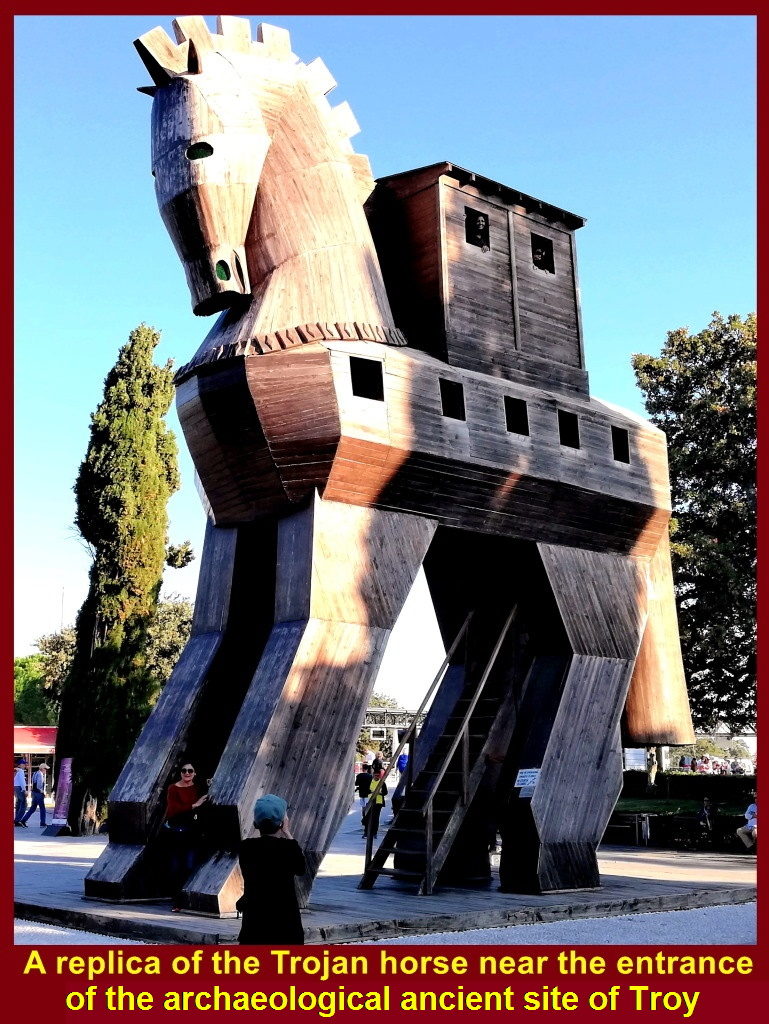
Visitors were allowed to enter the wooden horse and climb up to the top level.
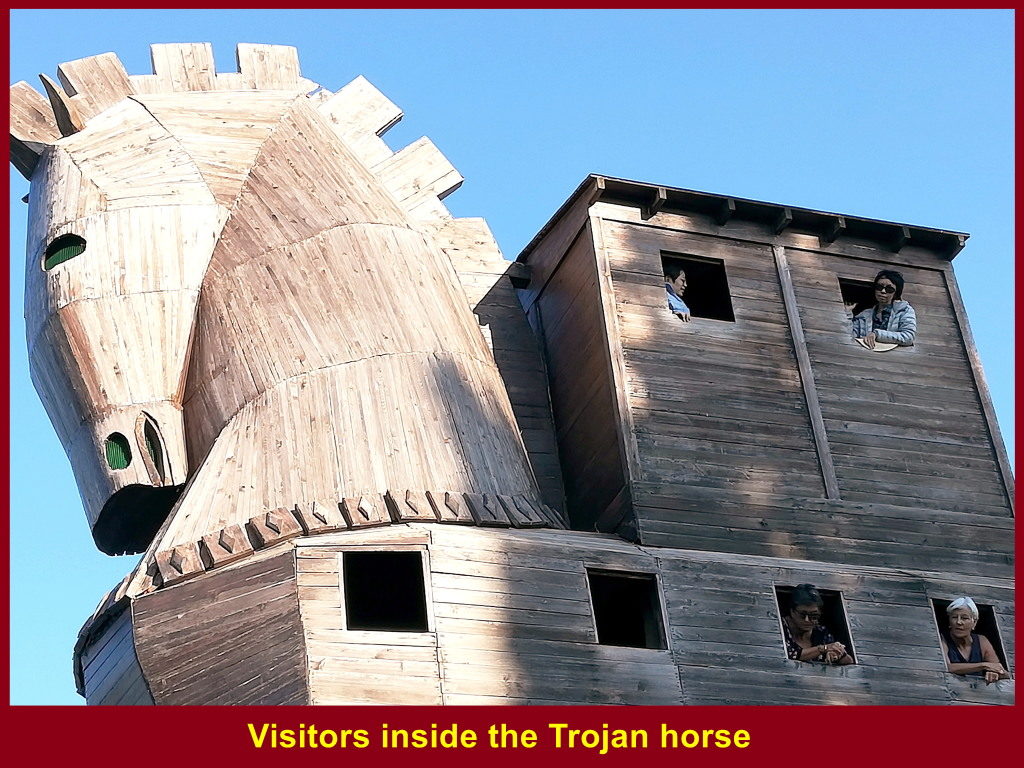
Touring the site of Ancient Cities of Troy
We spent an hour touring the site to see the ruins of different ancient cities of Troy.
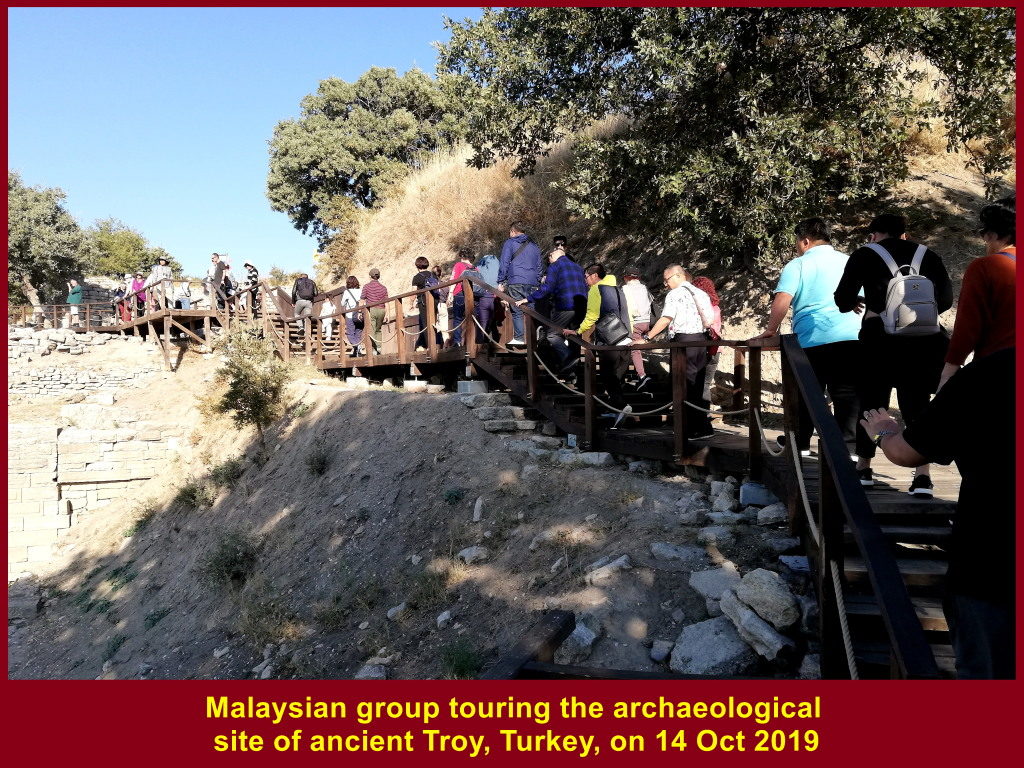
Nine Cities of Troy
We learned that there were 9 cities built on top of each other forming a large mound in a long period of 3500 years, i.e. from 3000 BC until 500 AD.
The diagram below shows 9 cities, Troy Cities I-IX, built in different periods from 3000 BC until 500 AD totalling 3500 years.
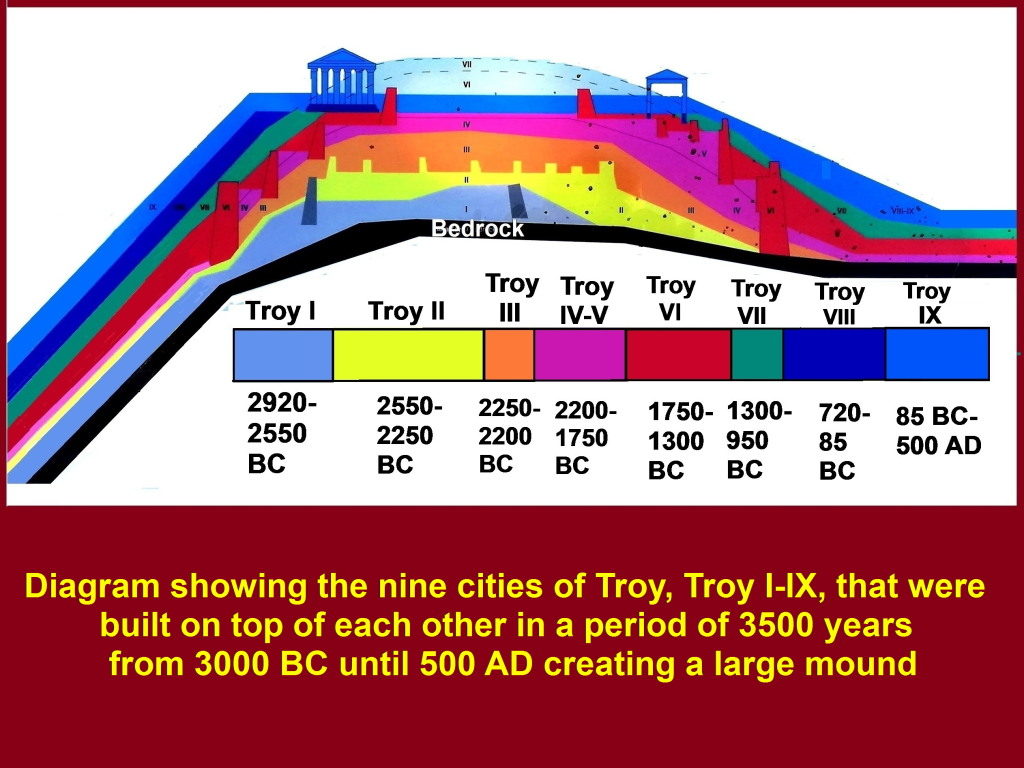
Picture of Troy IX, the last city of Troy
A picture below shows the reconstruction of the last city of Troy, Troy City IX(85 BC-500 AD).
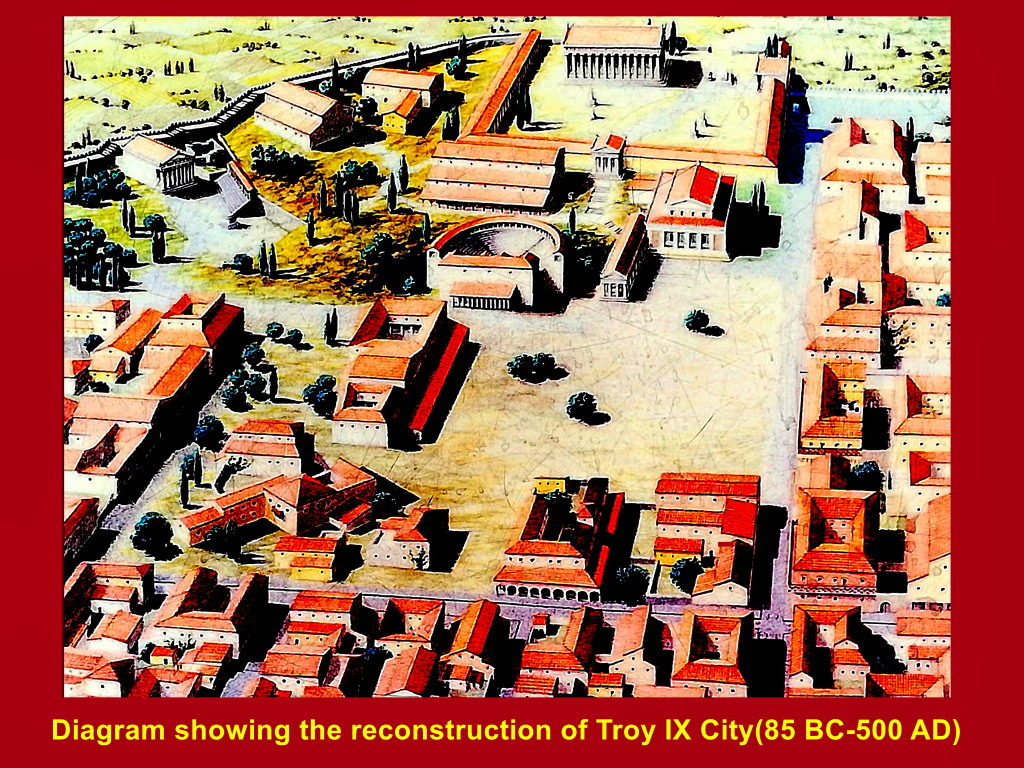
The photos below show some of the ruins of different cities of Troy in the olden days.
(i) Odeion(a Roman theatre) of Troy IX City(85 BC-500 AD) was built for concerts, lectures and other purposes
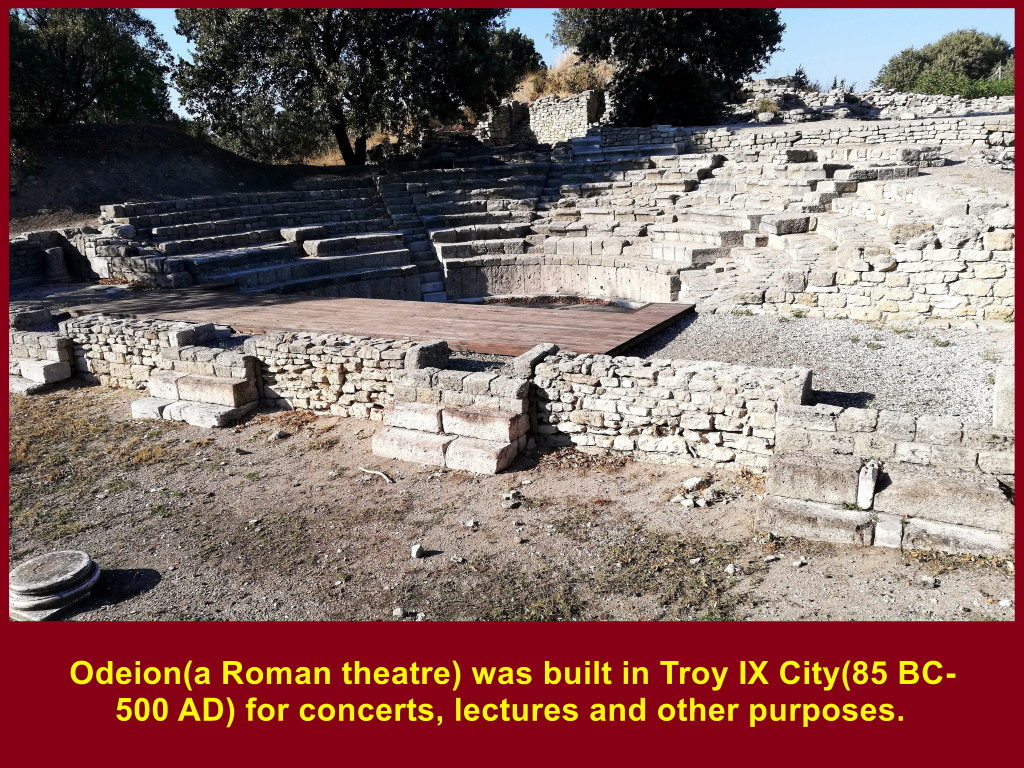
(ii) Palace of Troy VI City(1750-1300 BC) in ruin
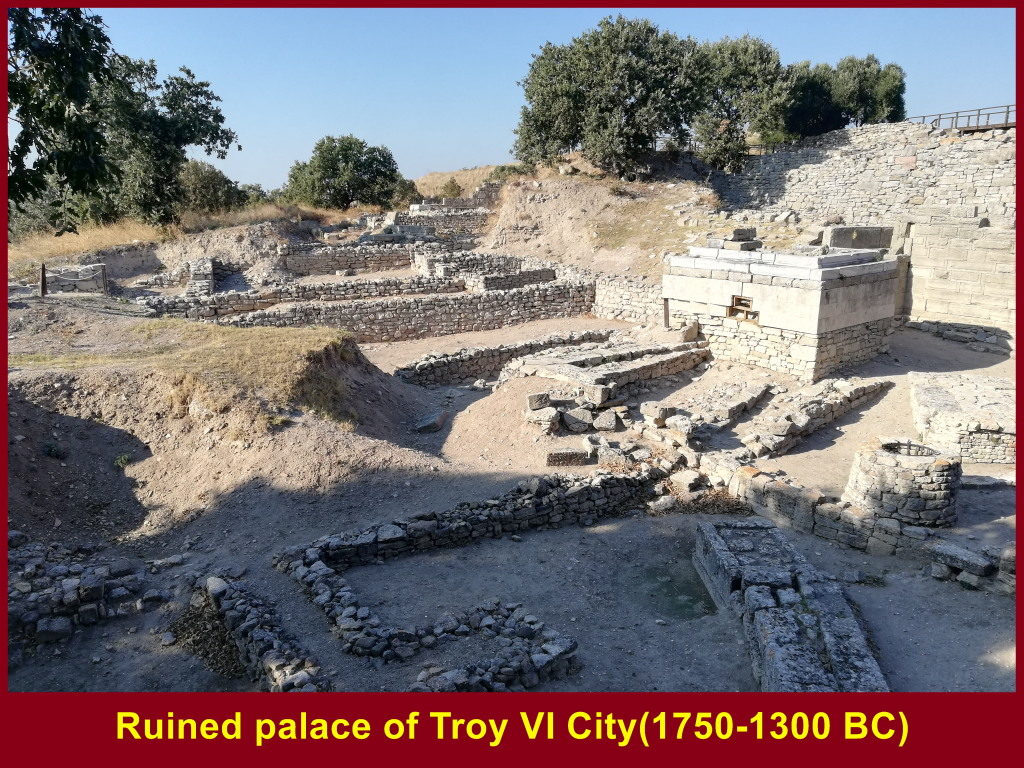
(iii) Bouleterion(Council-Chamber) of the Greek and Roman Ilion in Troy VIII-IX(720 BC-500 AD)
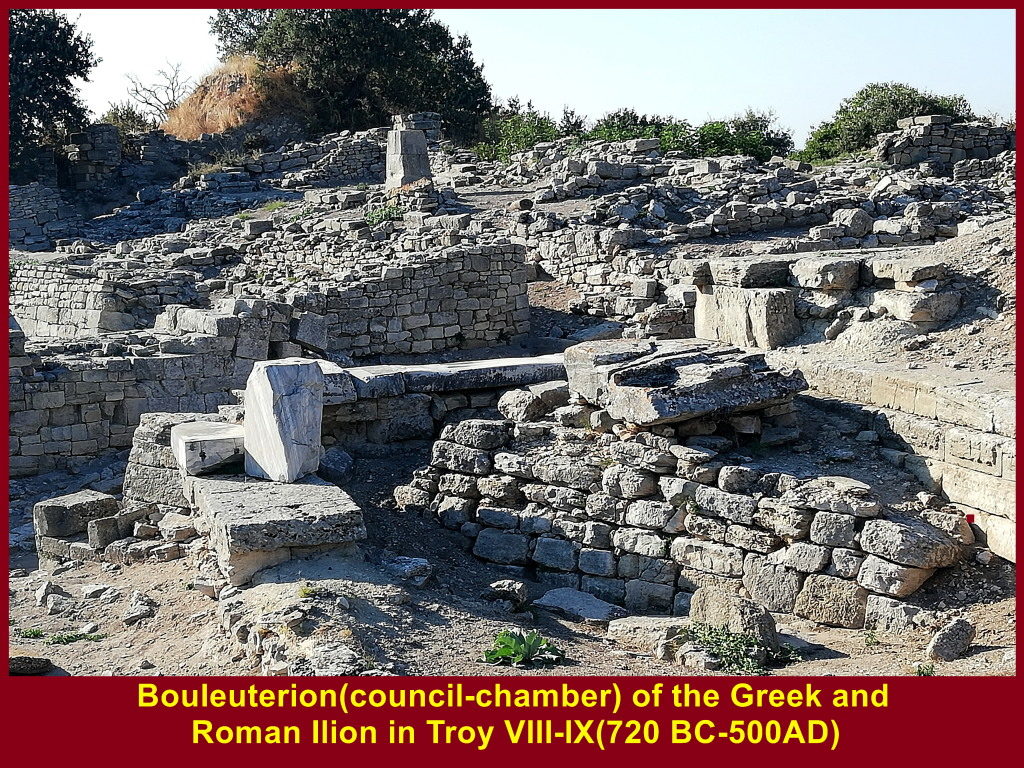
(iv) Citadel Wall of Troy II-III Cities(2550-2200 BC)
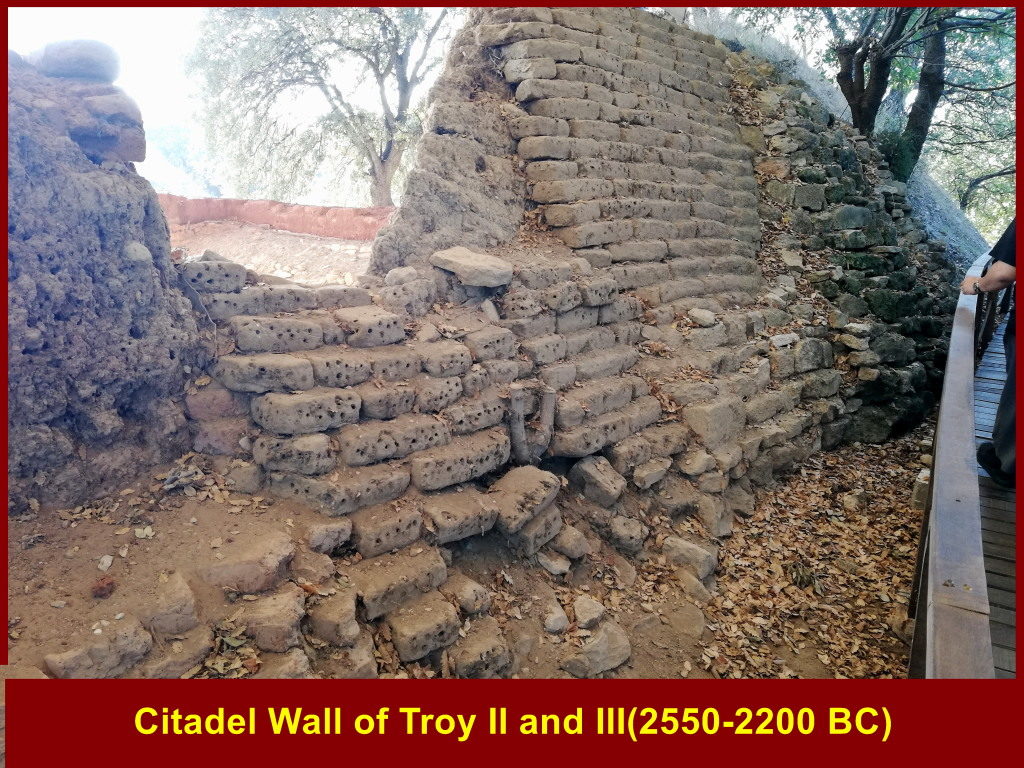
(v) A portion of the ruined walls of Troy VII City(1300-950 BC)
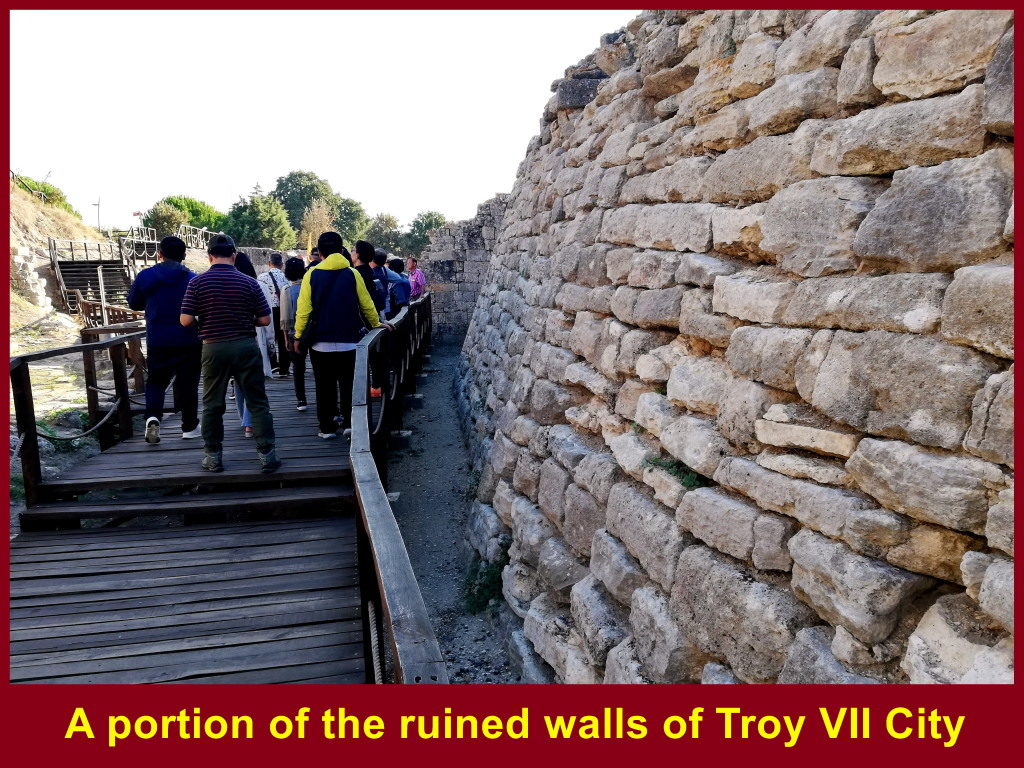
(vi) A partially restored ramp of Troy II fortress(2550-2250 BC)
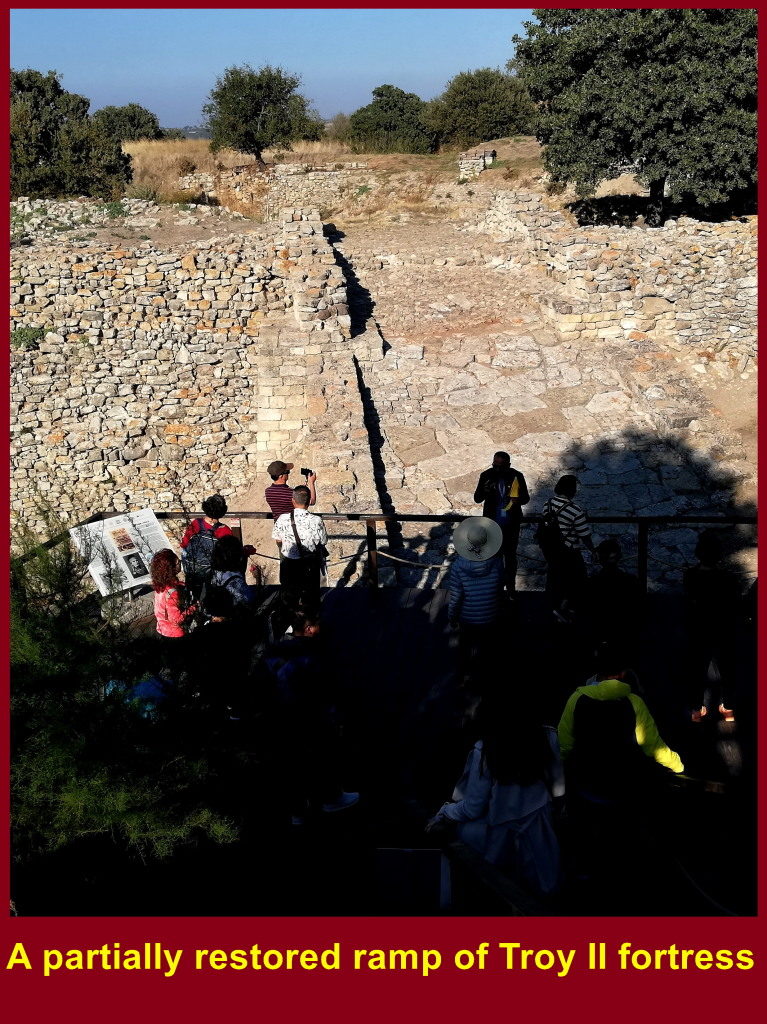
(vii) Burnt or fired mud-bricks in the Troy II fortifications(2550-2250 BC)
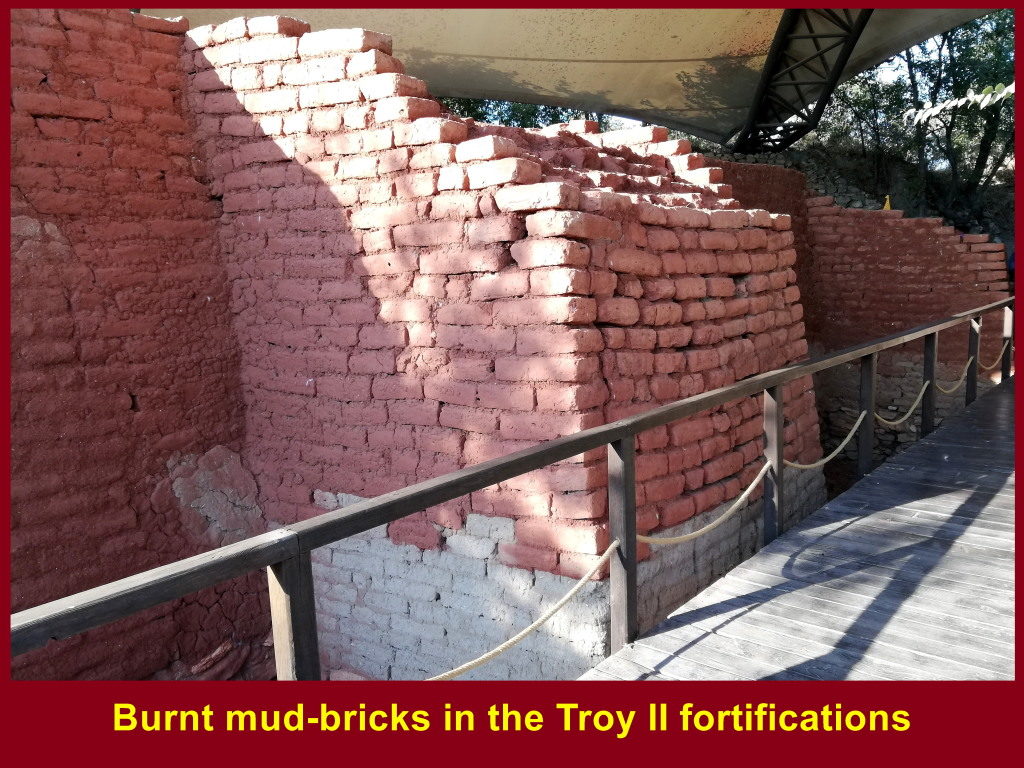
(viii) Trench and wall in the foreground of ancient Troy, and fertile land and Aegean Sea beyond.
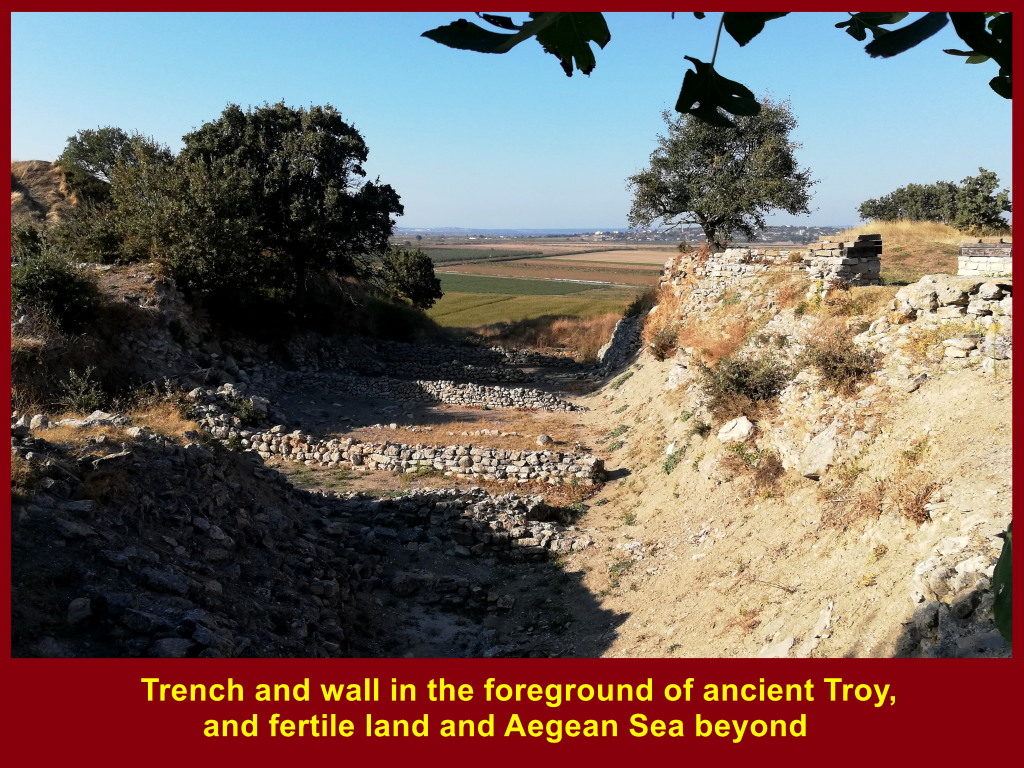
(ix) A partially-restored well built in 300 BC in the City of Troy VIII(720-85 BC)
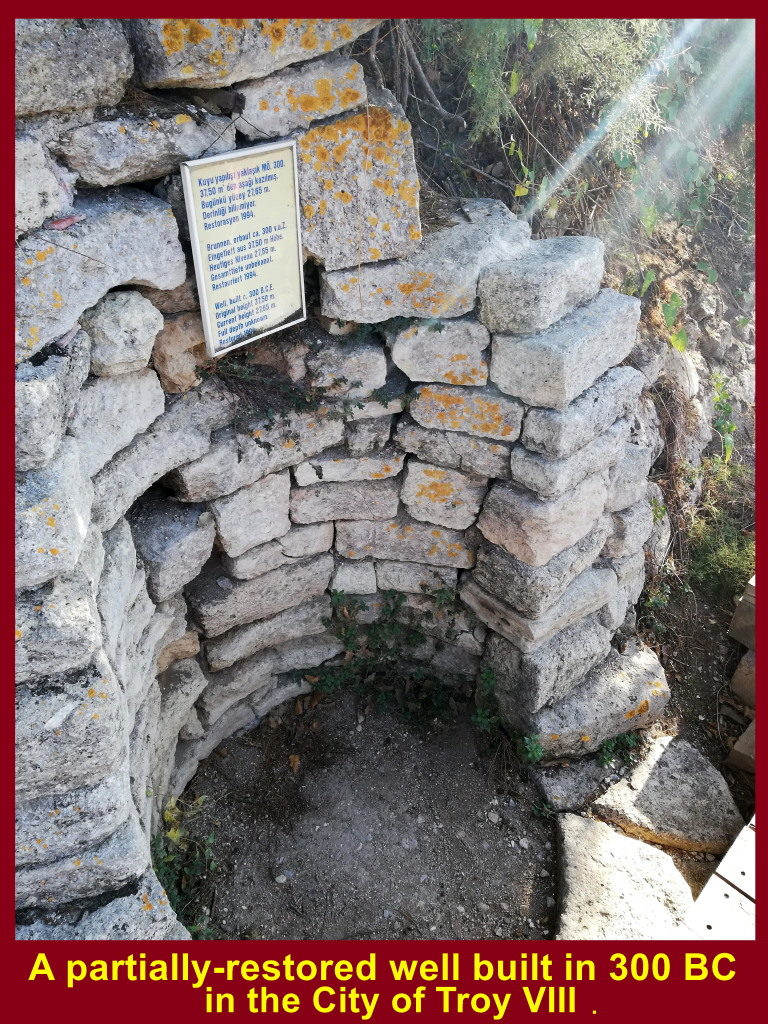
(x) Storage vessels for olive oil, wine, grains and water. Discarded ones were used as burial urns since the early Bronze Age(3000-1200 BC)
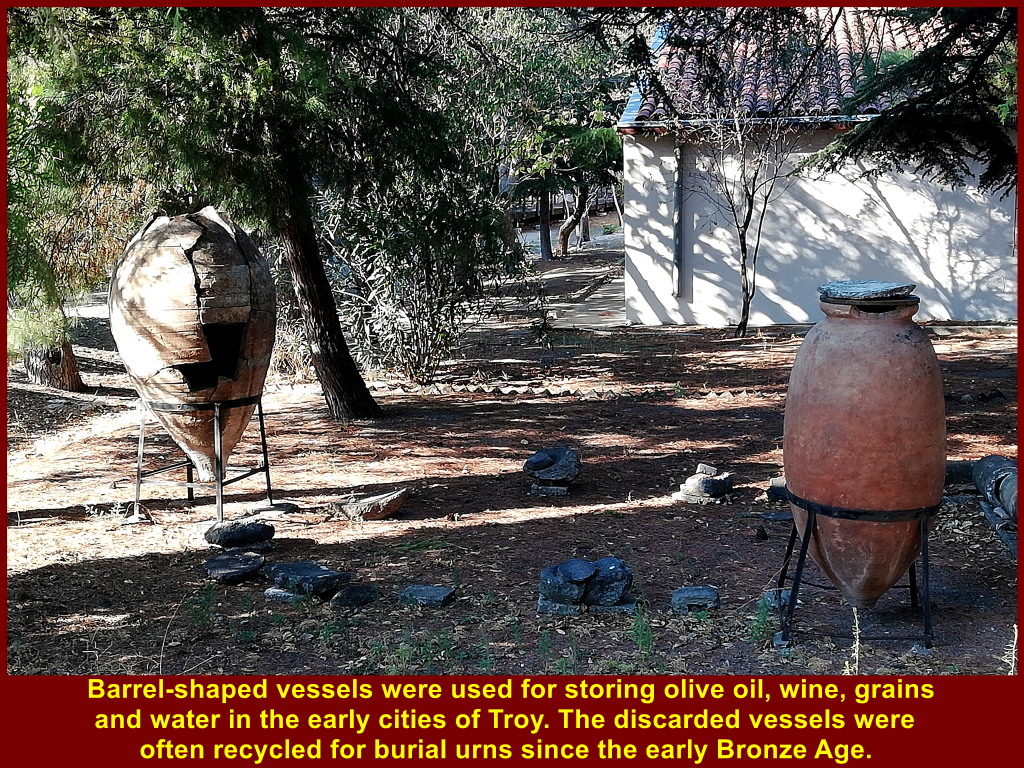
Kolin Hotel, Canakkale
After spending an hour touring the archaeological site of ancient Troy, we went to Canakkale for dinner and stayed at Kolin Hotel for a night on 14 Oct 2019.
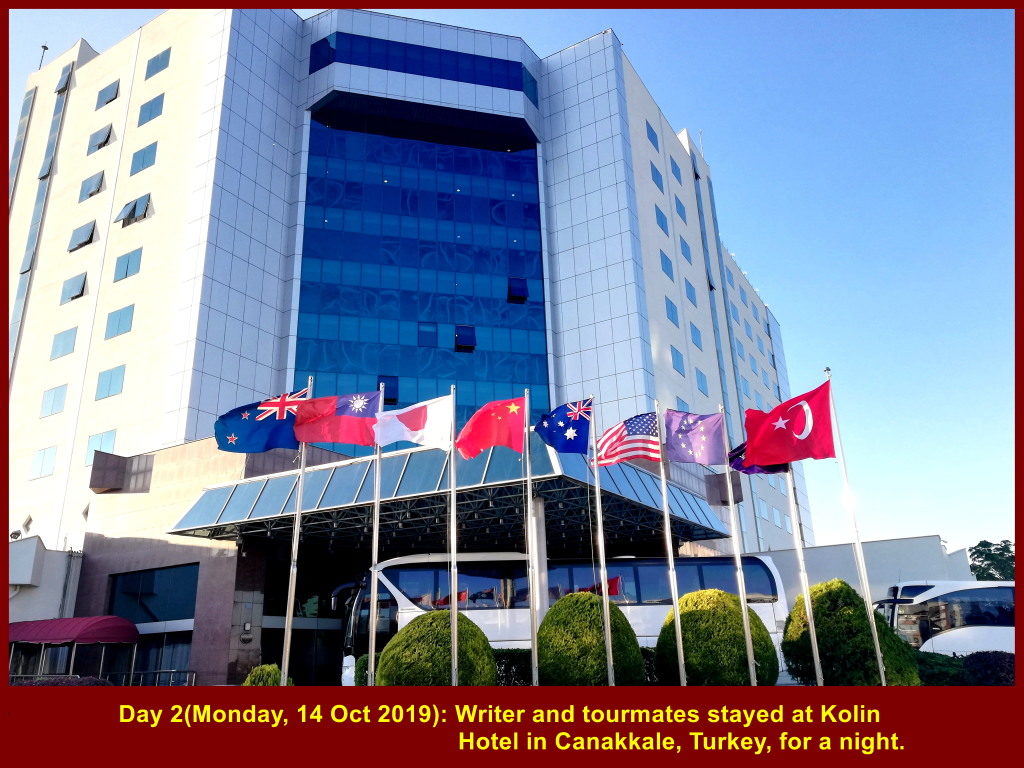
Places visited during Turkey Tour(13-22 Oct 2019):
Trojan Horse/Ancient Troy Cities Asklepion Ephesus Hierapolis/Pamukkale Travertine Sultanhani Caravanserai Pasabag Valley Uchisar Valley/Kaymakli Underground City Gerome Valley/Turkish Night Show Hot Air Balloon/Lake Golu/Anitkabir Hagia Sophia/Topkapi Palace/Blue Mosque Bosphorus Boat Cruise Spice Bazaar/Grand Bazaar
Turkey Travel Part II: Asklepion
Filed under: Asklepion, House of Virgin Mary, Turkey Travel
Day 3
Tuesday, 15 Oct 2019
In the morning of 15 Oct 2019, we left Canakkale and travelled to Asklepion, an ancient hospital, in Pergamon hear Bergama.
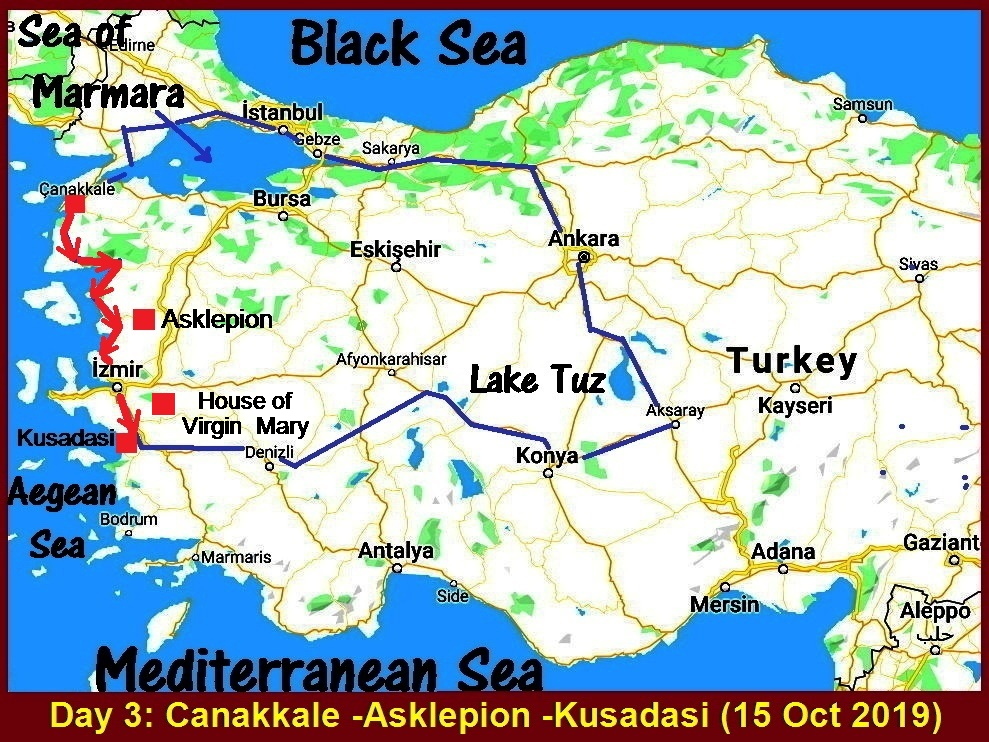
Olive Product Shop
On the way, we stopped at a shop, “adrapure”, that was selling olive oil products.
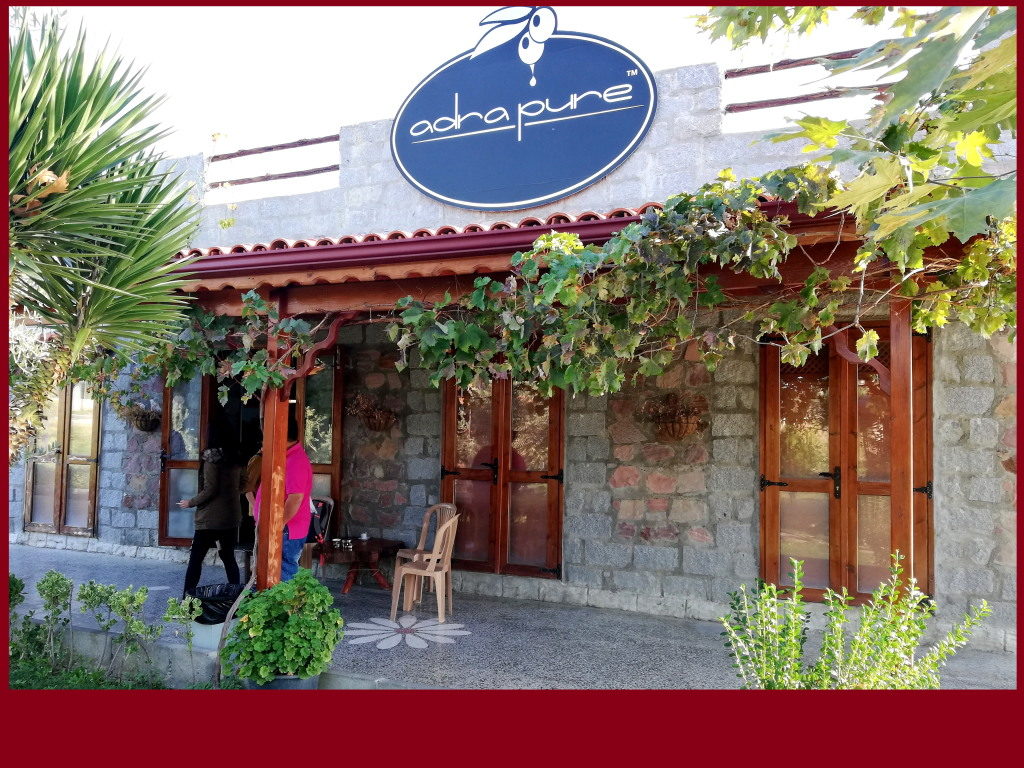
A salesgirl introduced the olive oil products to our tourmates.
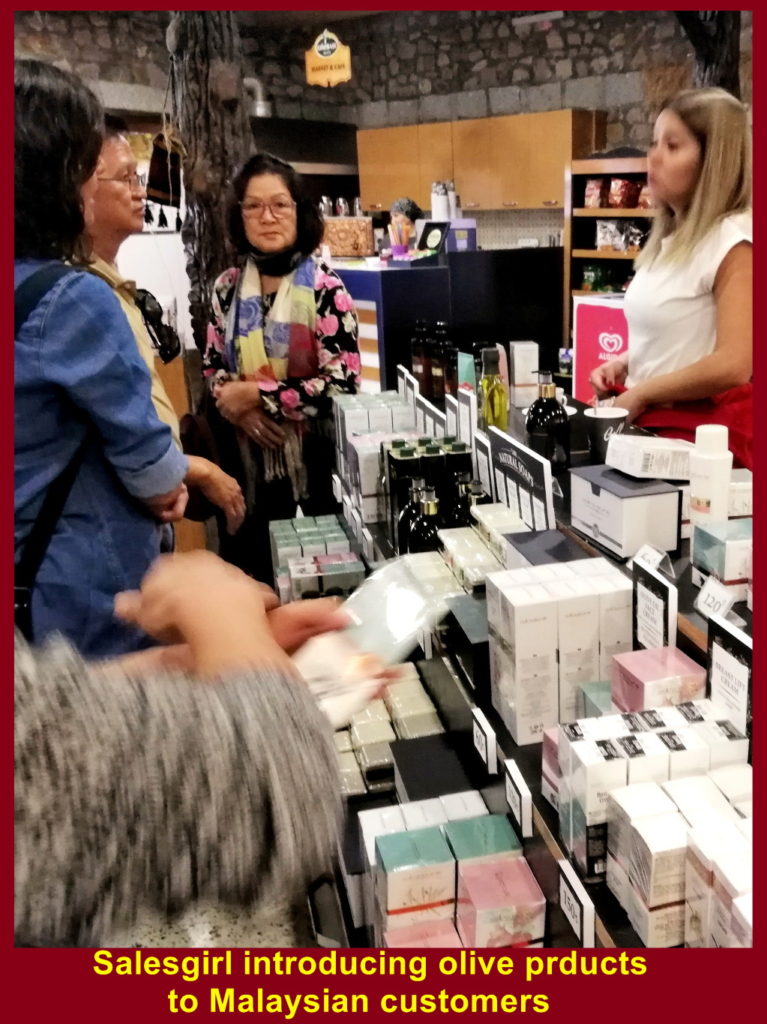
The following products were for sale at the shop.
(i) Olive oil
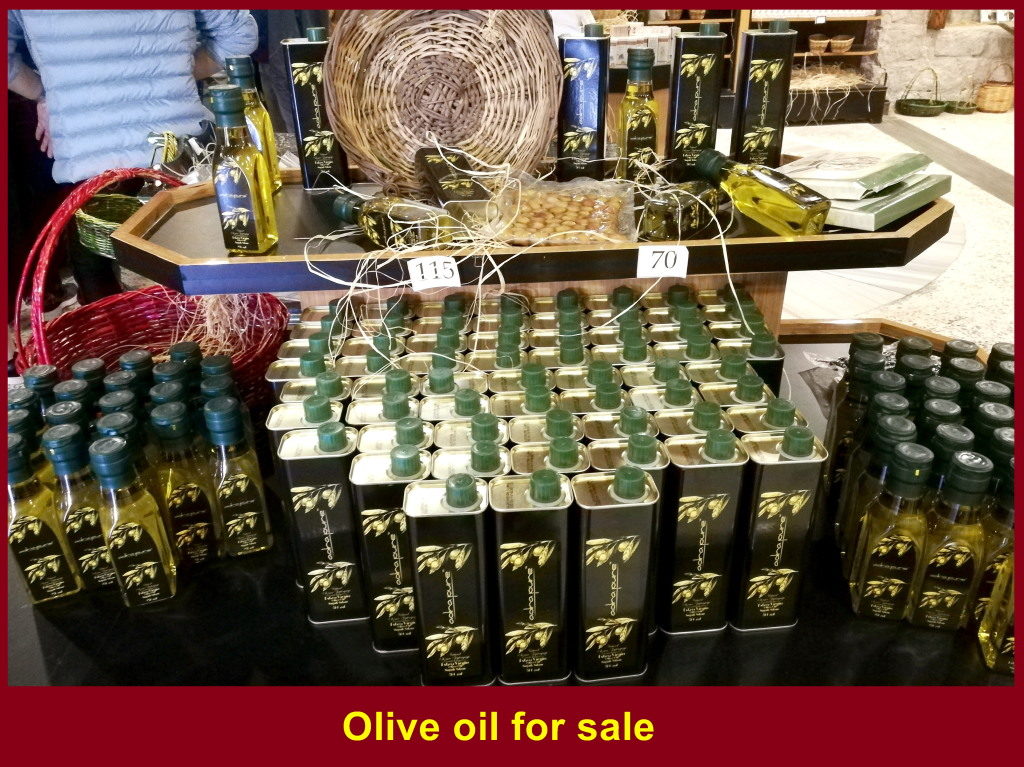
(ii) Beauty care products that used olive oil
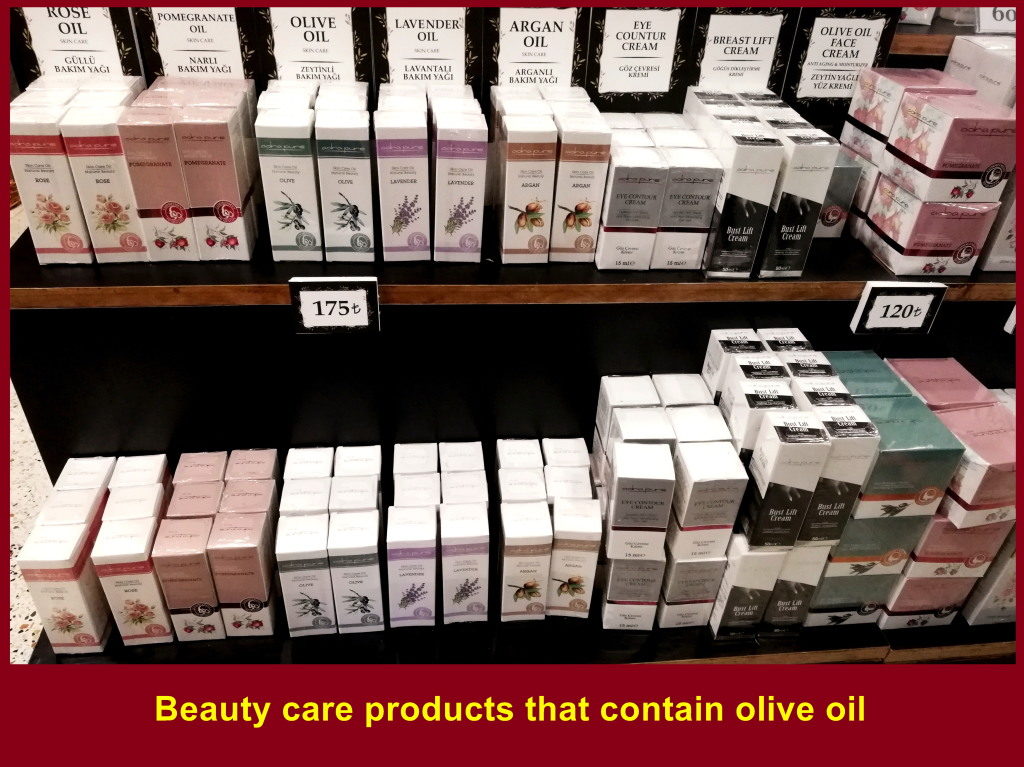
(iii) Bathing soaps
Olive Trees
There were few olive trees outside the shop.
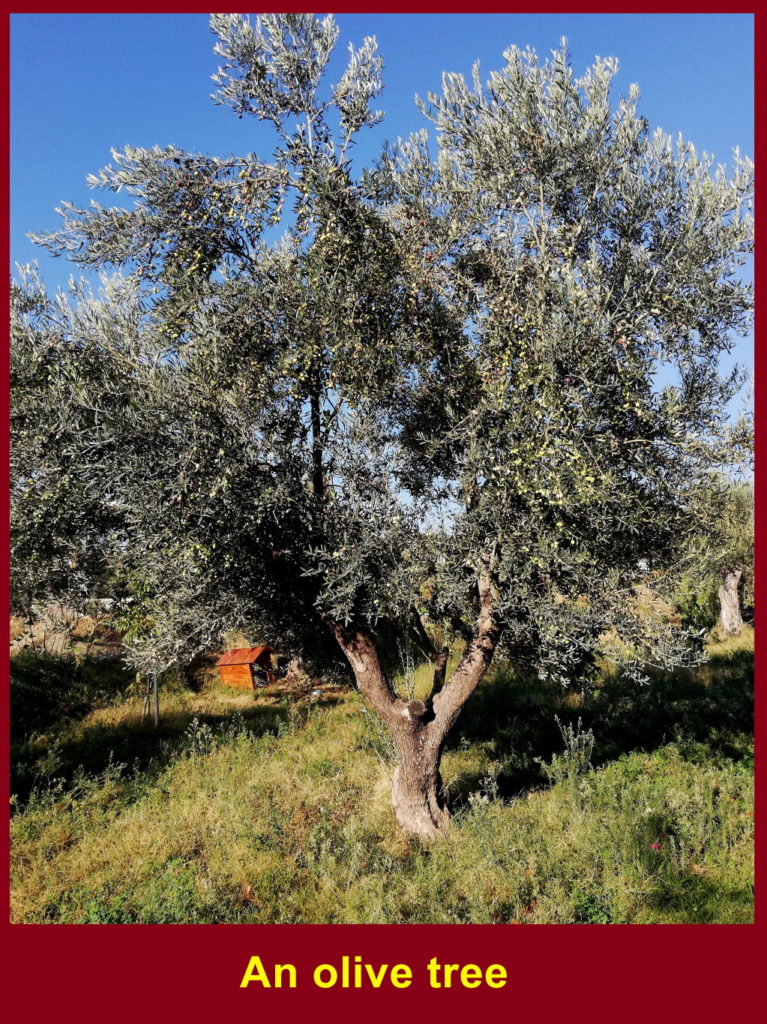
Olive Fruits
As I was walking in the garden, I noticed that all the trees were bearing fruits and tasted a few of them. They were bitter in taste.
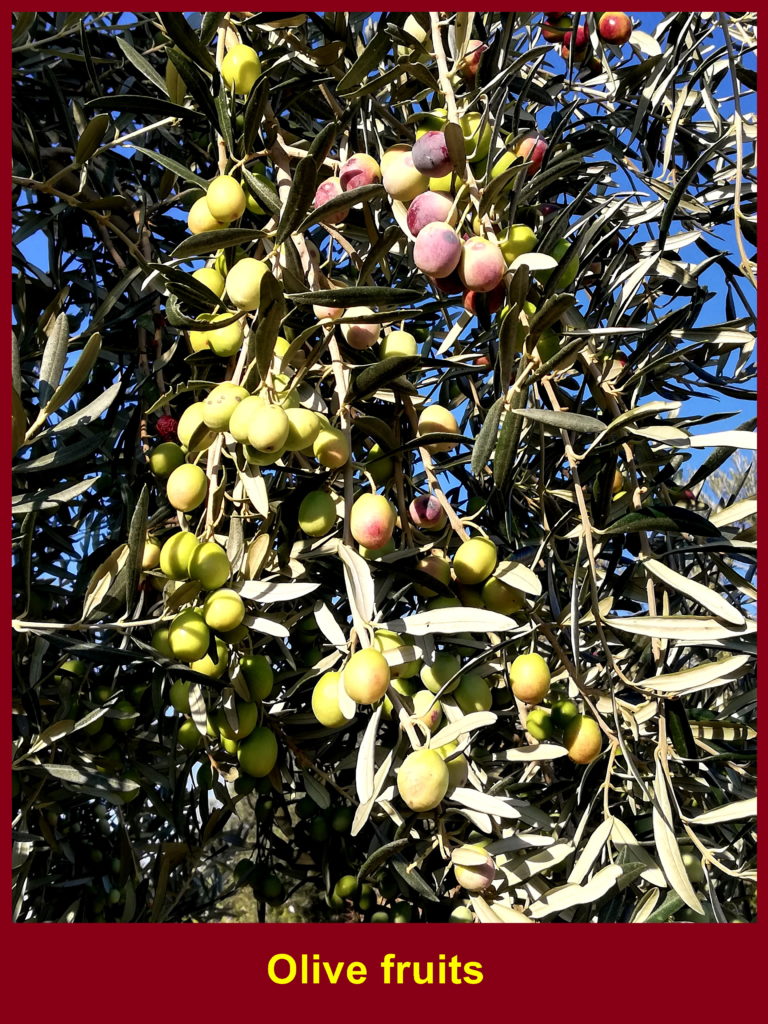
Picking Olive Fruits
There was a picture in the shop that showed the farmers picking olive fruits.
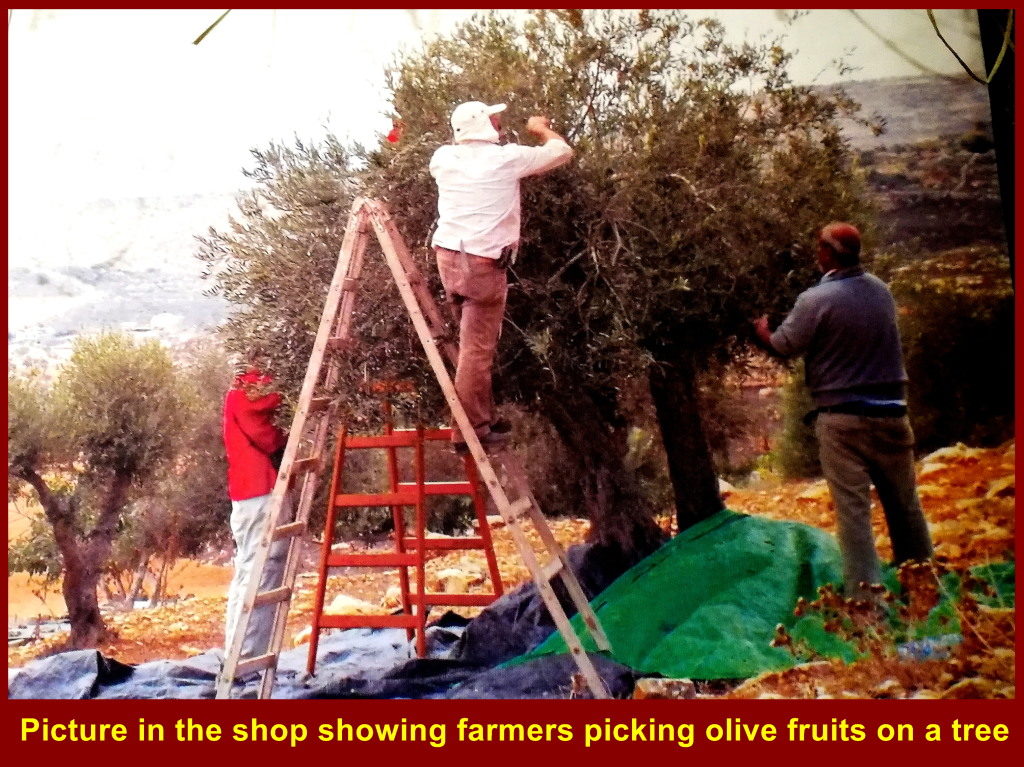
Asklepion
Soon we left the shop and continued our journey the ancient hospital or healing centre in Pergamon near Bergama. It is known as Asklepion that was established in the 4th. Century BC in dedication to the Greek God of Healing and Medicine, Asclepius.
We noticed that many parts of the place were in ruin.
Drawing of the Actual Hospital
The drawing below shows the actual hospital or healing centre in the olden days.
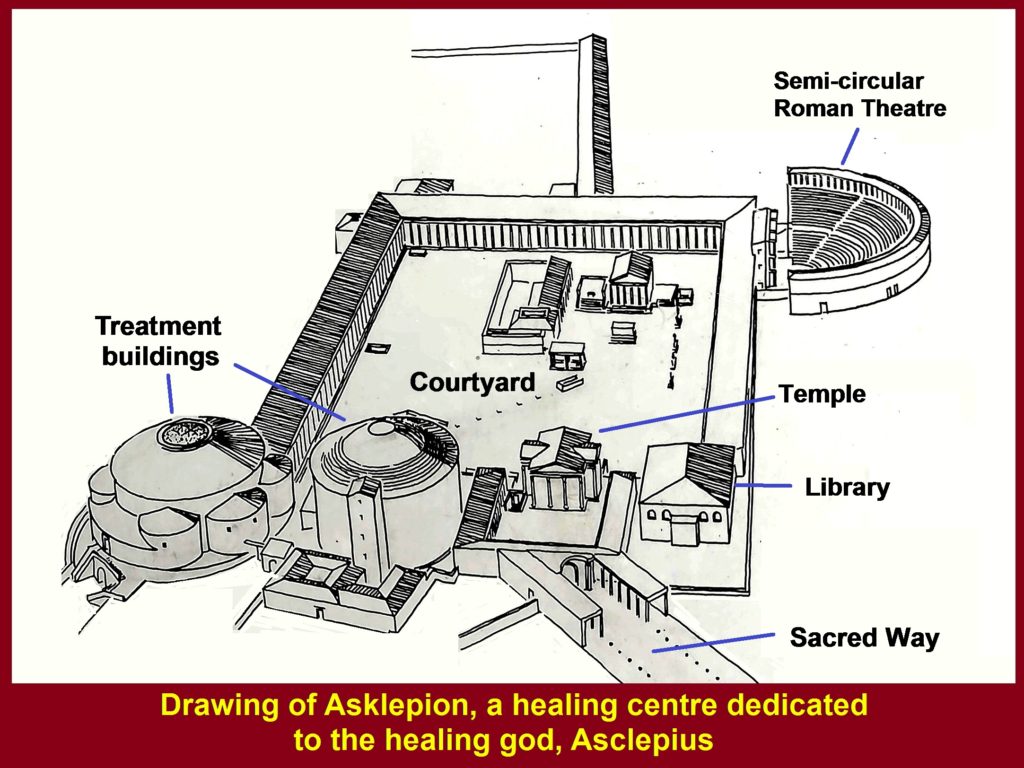
Writer and wife visited Asklepion, the healing centre in the olden days, on 15 Oct 2019.
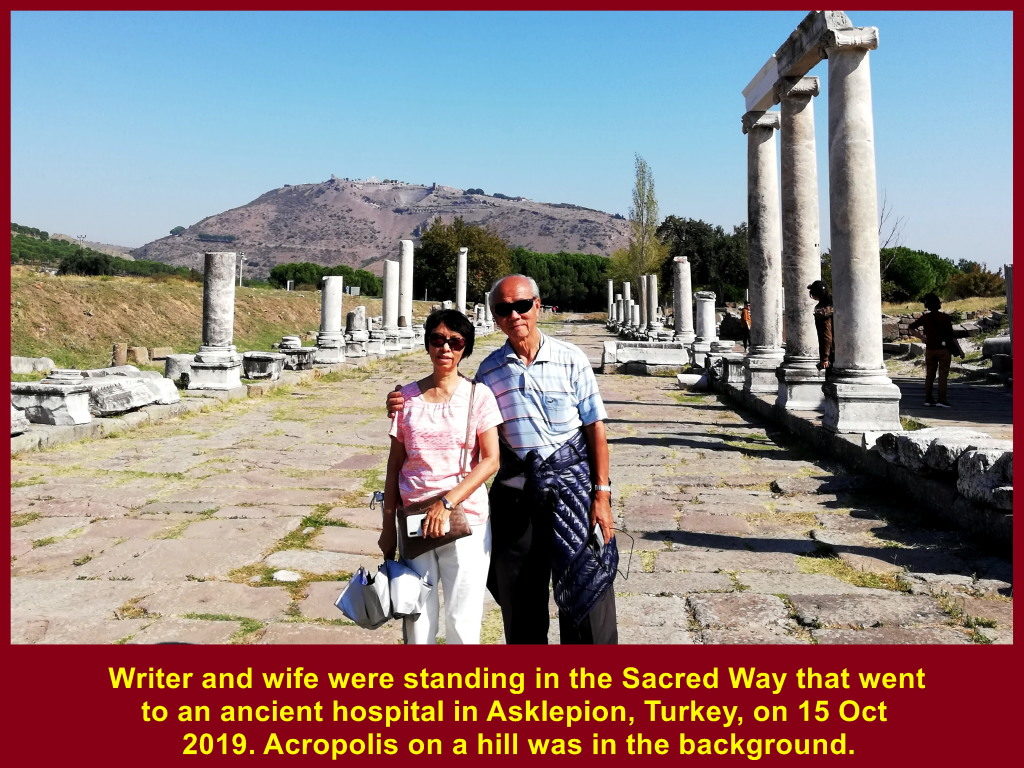
Sacred Way
Sacred Way was a long path to the entrance of the hospital or healing centre. It was there sick persons were checked if they were qualified to be admitted into the centre. For examples, the healing centre would not accept persons who were near death and pregnant women, as it had to keep its reputation.
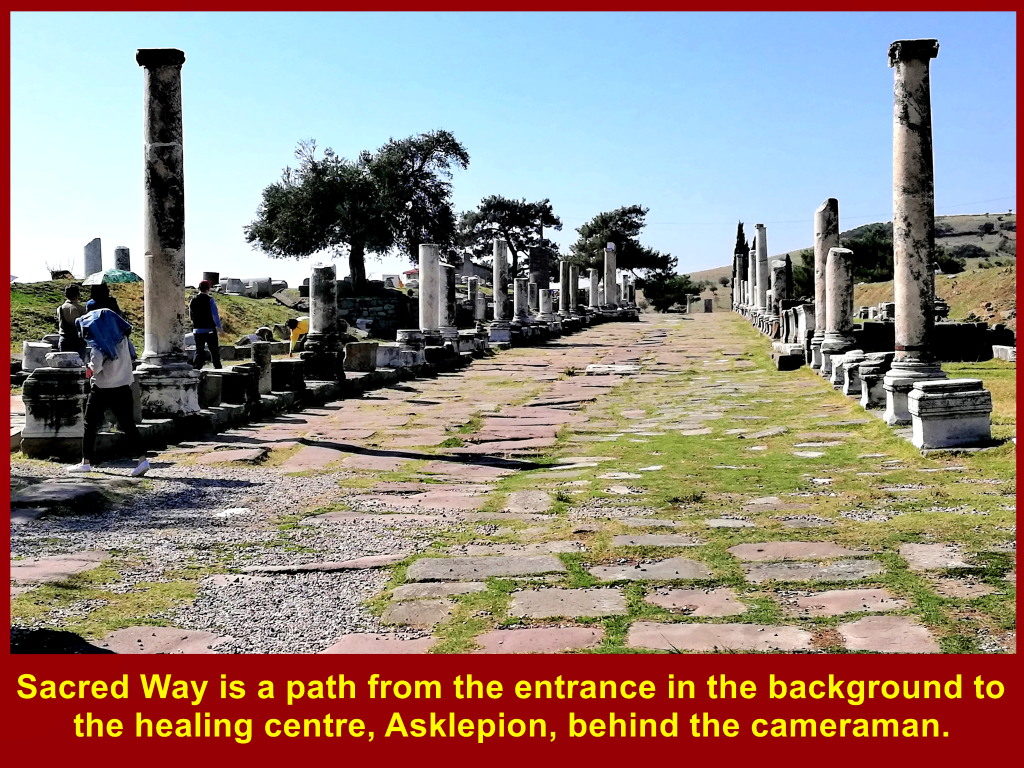
Colonnade
Colonnade with missing roof for patients to go to the semi-circular Theatre for shows or entertainment in the olden days.
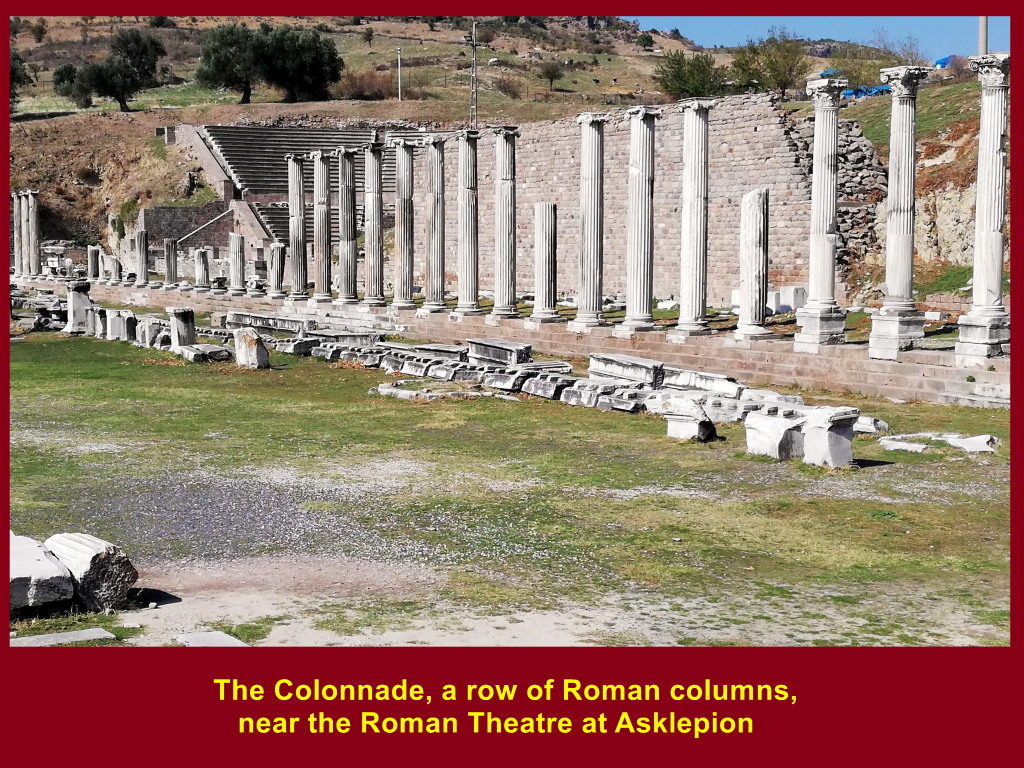
Group Photo
Writer and tourmates took a group photo at the Colonnade for remembrance on 15 Oct 2019.
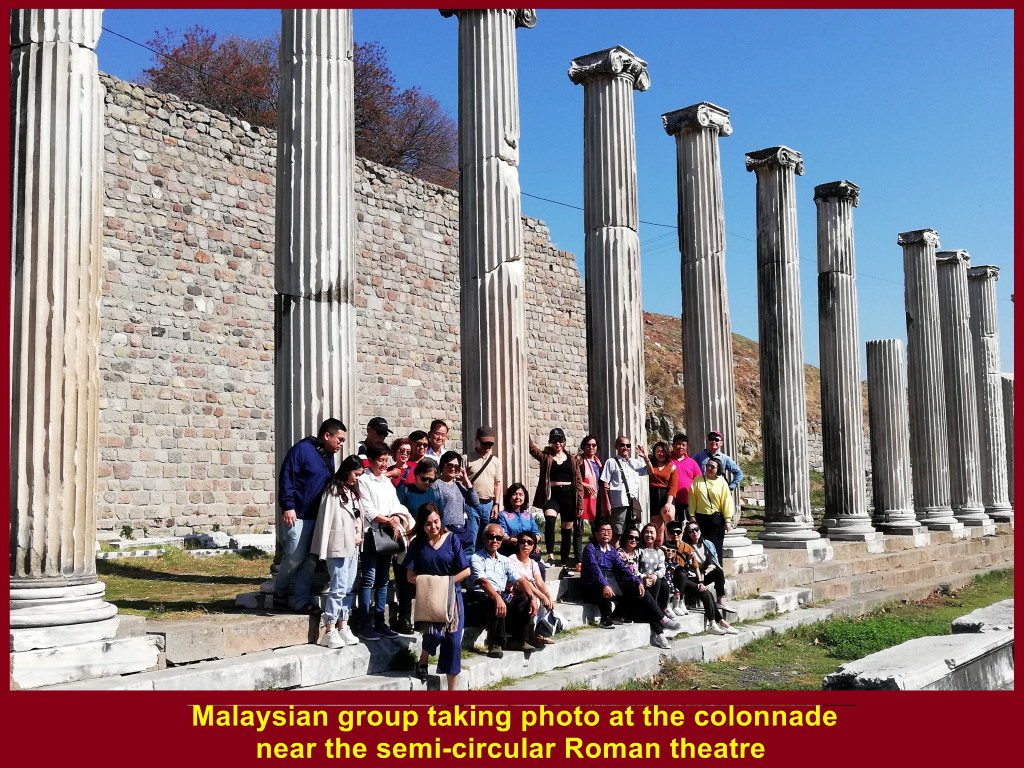
Roman Theatre
Patients watched shows in the Roman Theatre at Asklepion for relaxation in the olden days.
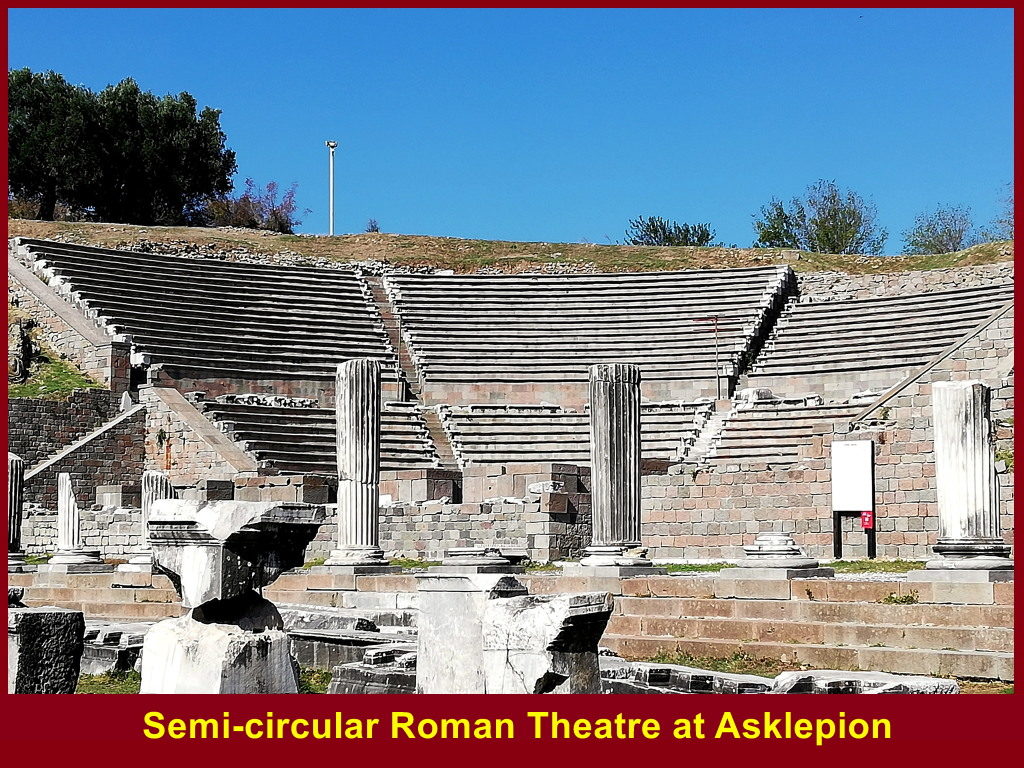
View of the Sacred Way, Colonnade and Theatre
A view of the Sacred Way, Colonnade and the Roman Theatre as seen from Asklepion, the healing centre that was established in the 4th. Century BC.
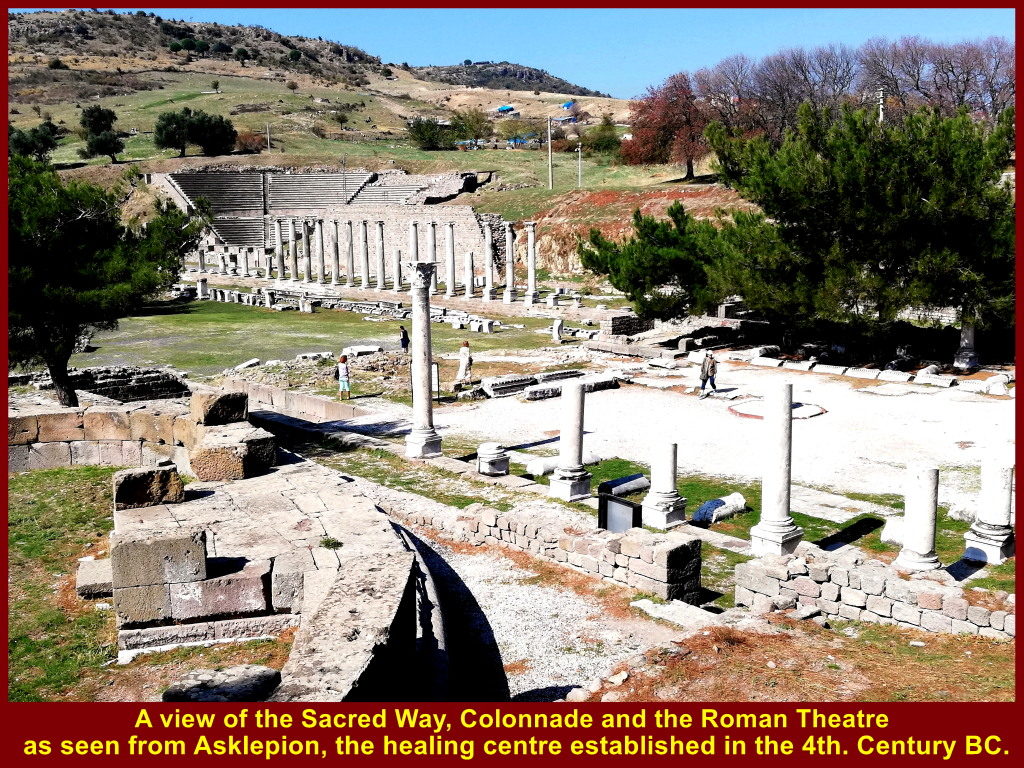
Miracle Water
The underground water was used to treat patients in the olden days. Later, that miracle water was found to contain radioactive substances. The water was still flowing while we were there.
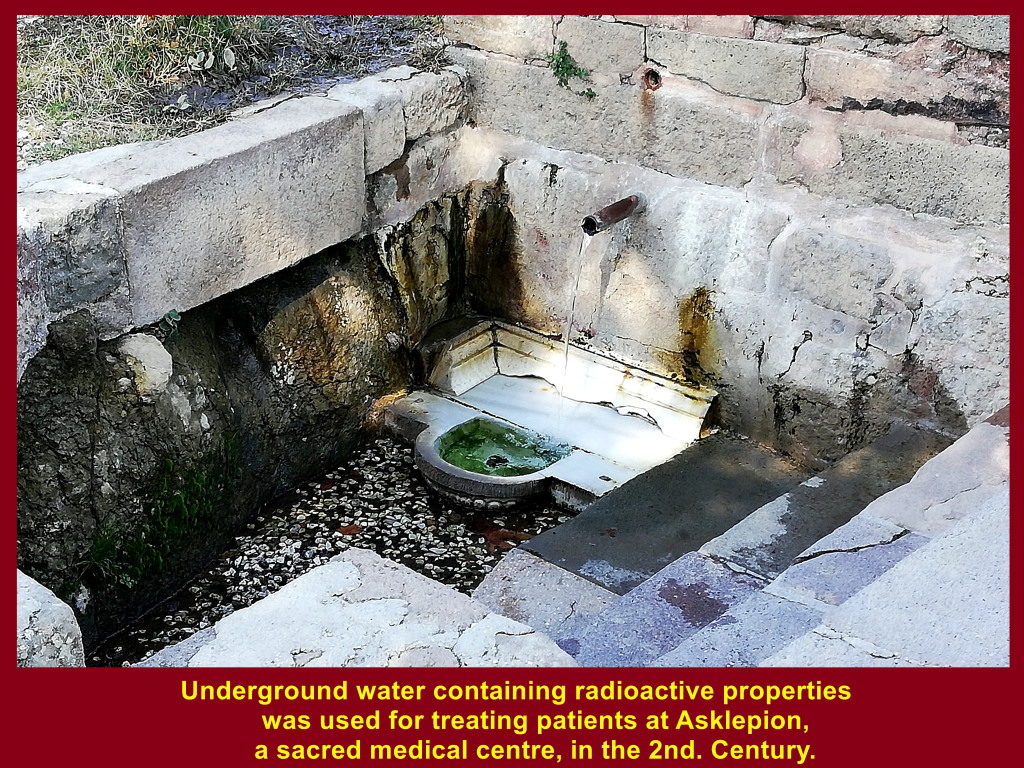
Entrance to Treatment Rooms
An entrance of Asklepion leading to the treatment rooms for patients in the olden days.
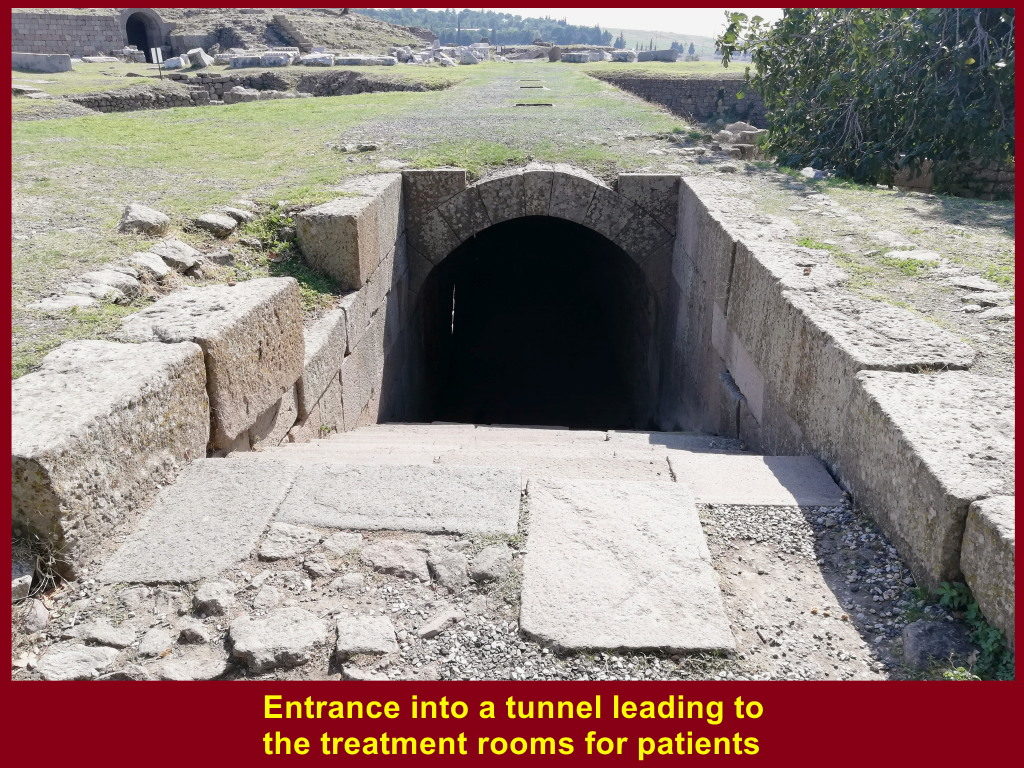
A Tunnel
Interior of the tunnel leading to the treatment rooms for patients in the olden days.
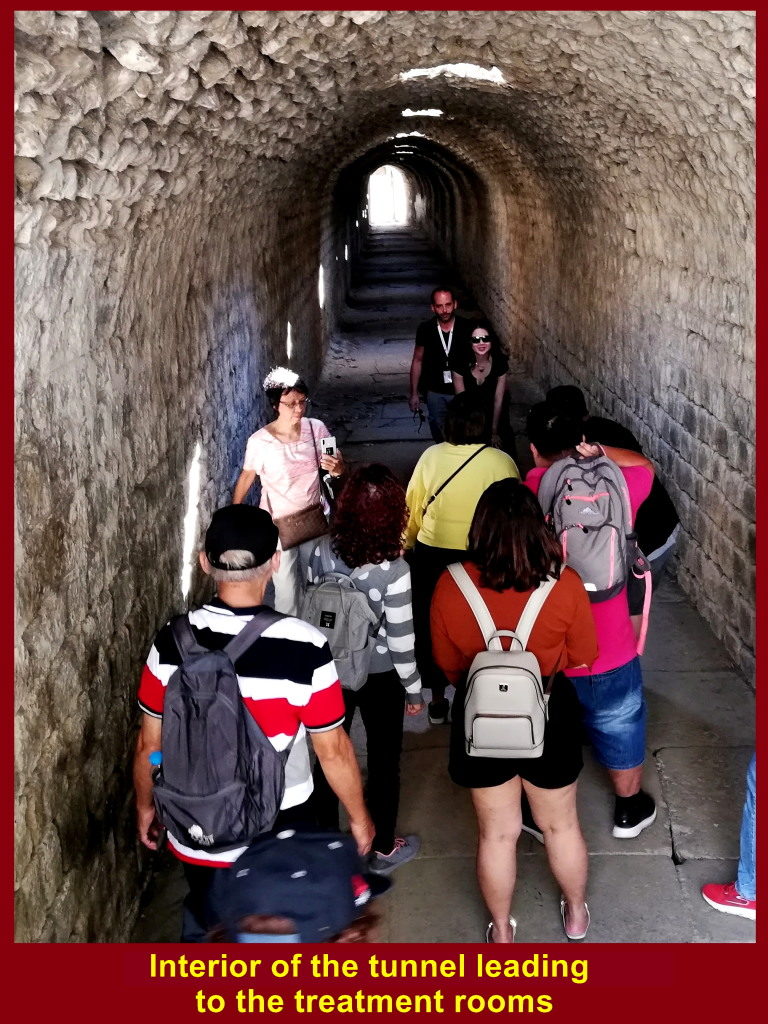
Underground Treatment Rooms
Underground treatment rooms were used for patients to dream in the olden days. Doctors or priests would then treat the patients according to their dreams.
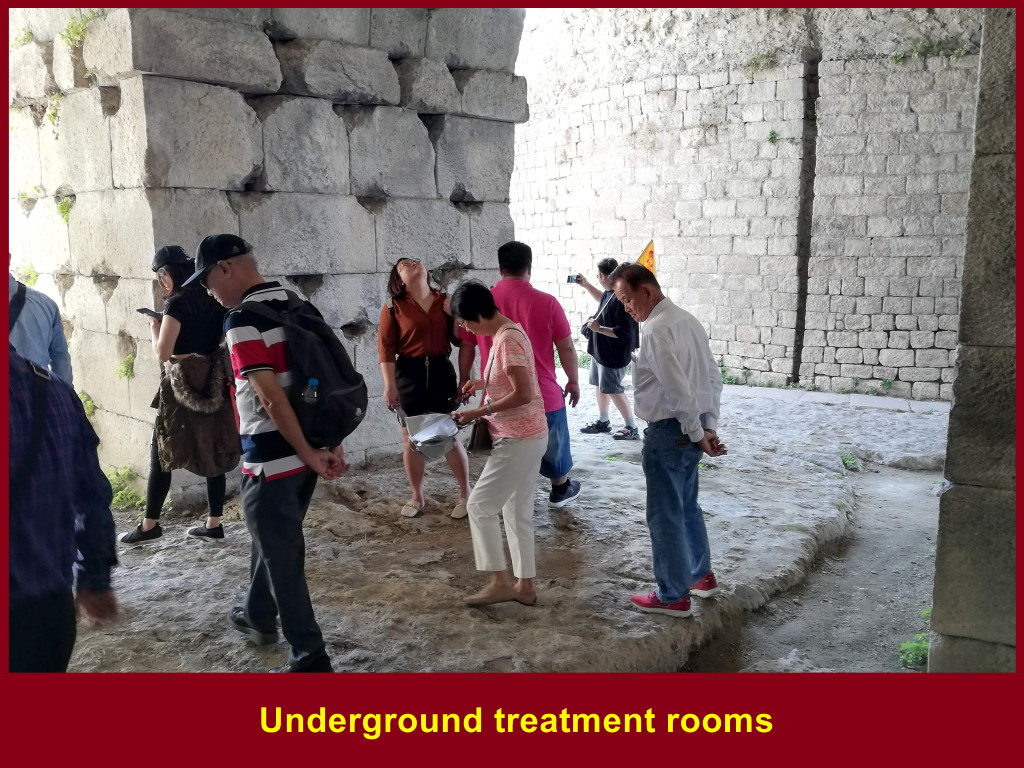
Treatment rooms and sleeping chambers for patients to dream in the olden days are located underground.
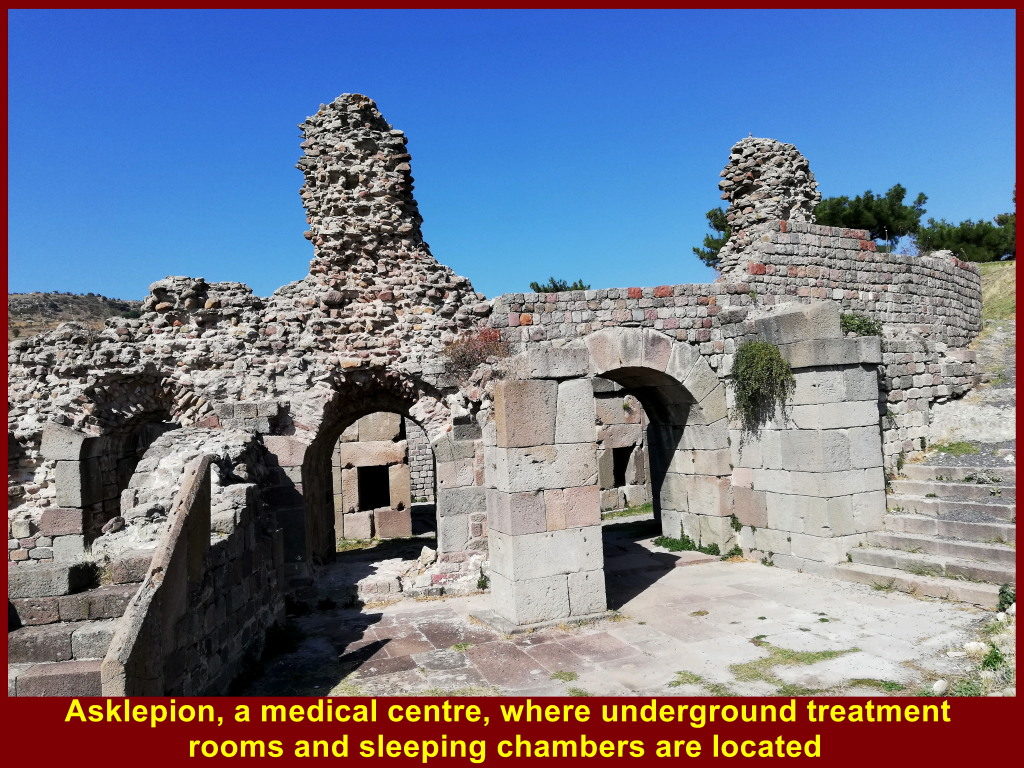
Ruined Treatment Building
Ruined treatment building for patients in the olden days at Asklepion, Pergamon near Bergama.
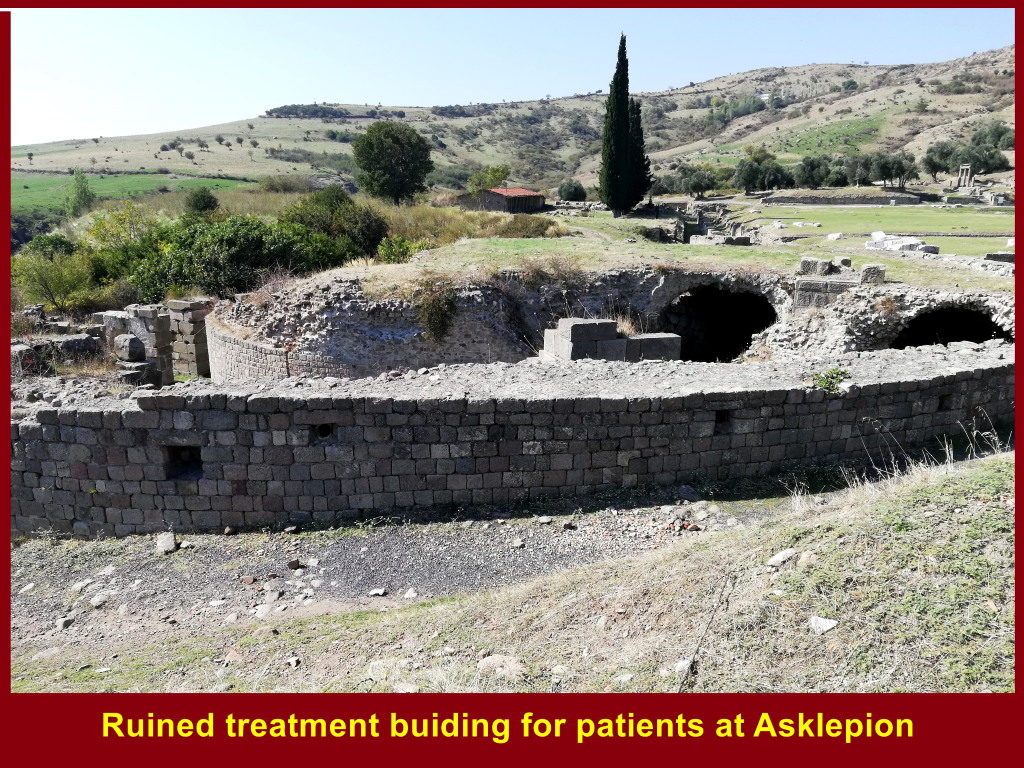
Treatment Rooms
Treatment rooms for patients in the olden days at Asklepion, a healing centre dedicated to the god of healing and medicine, Asklepius.
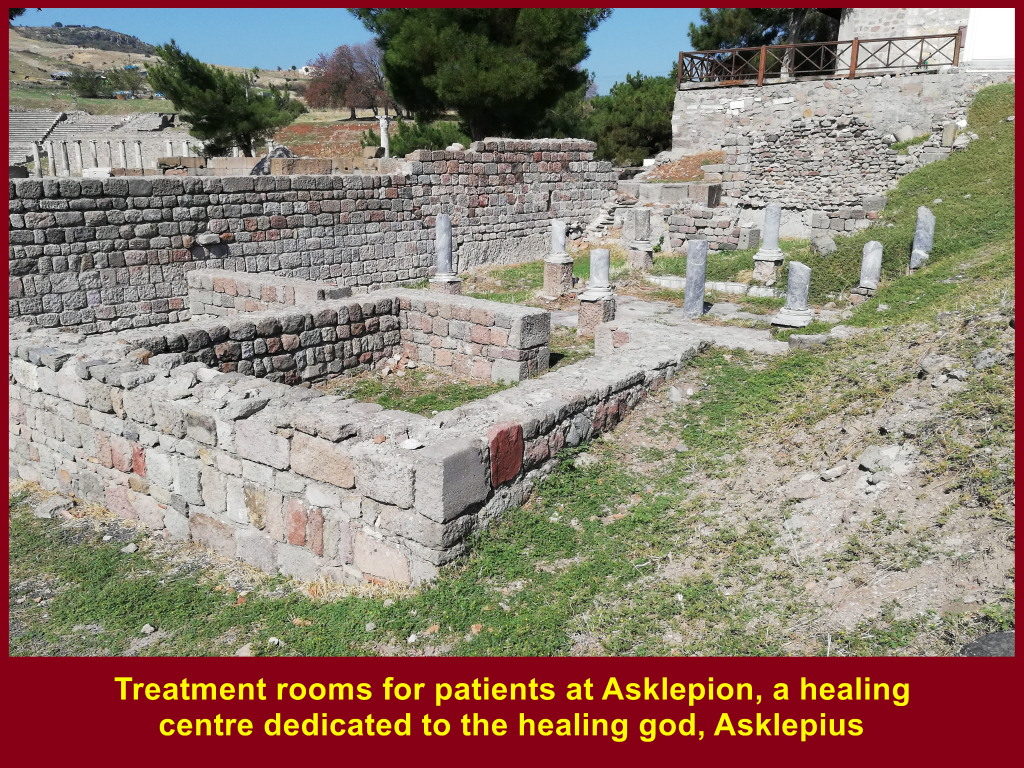
Pool for Treatment
One of the three pools used for treating patients in the olden days at Asklepionin in Pergamon near Bergama.
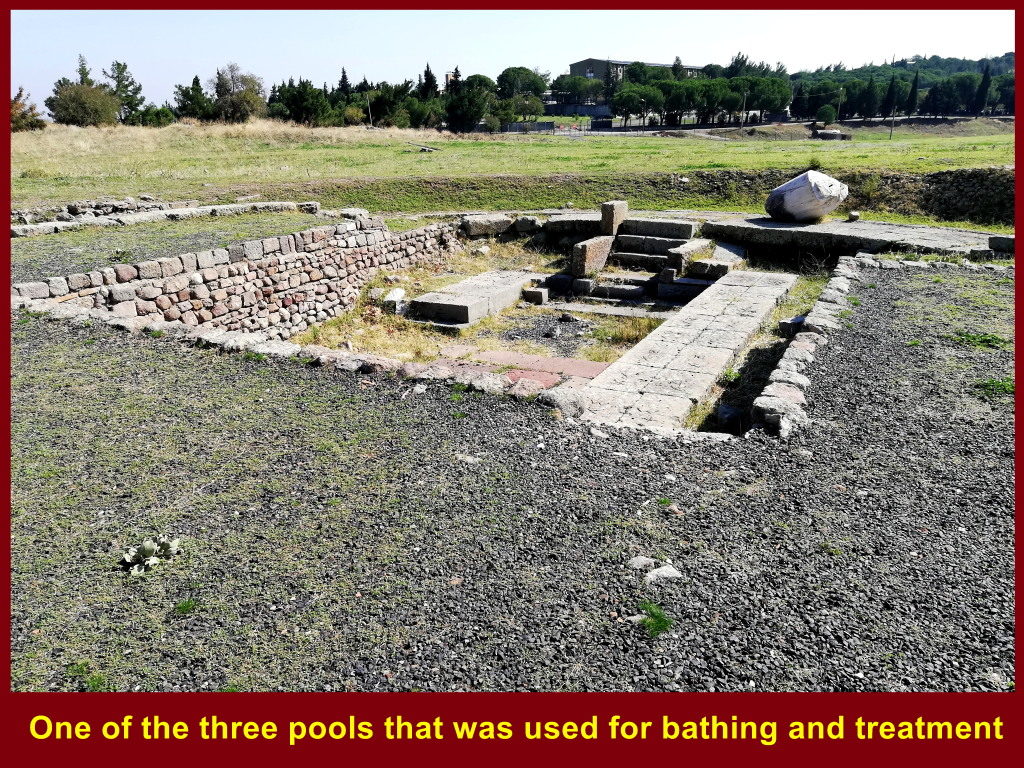
Acropolis
View of Acropolis on a hill where kings lived in the olden days as seen from the medical centre, Asklepion.
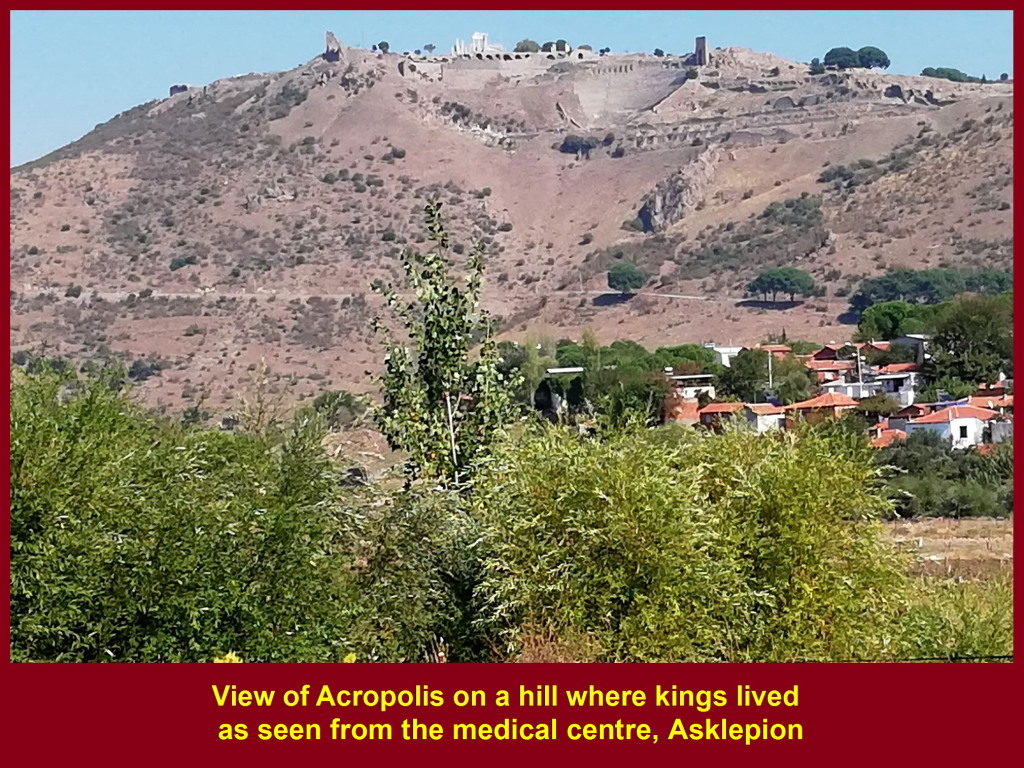
Virgin Mary’s House
Later, we travelled 131 km from Asklepion in Pergamon to a place in the south where Virgin Mary’s house was thought to be located. It is on Mount Koressus that is 7 km from Selcuk, Turkey.
Path to the House of Virgin Mary
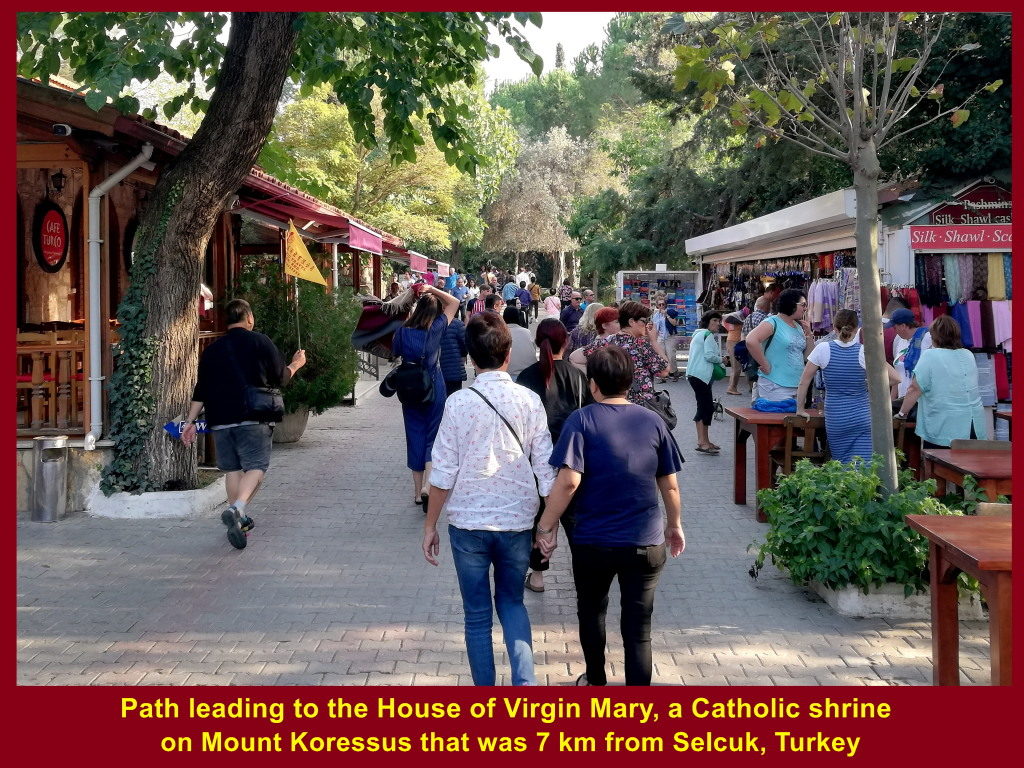
Group Photo
Writer and tourmates visited the House of Virgin Mary, a Catholic shrine, on Mount Koressus which is 7 km from Selcuk, Turkey, on 15 Oct 2019.
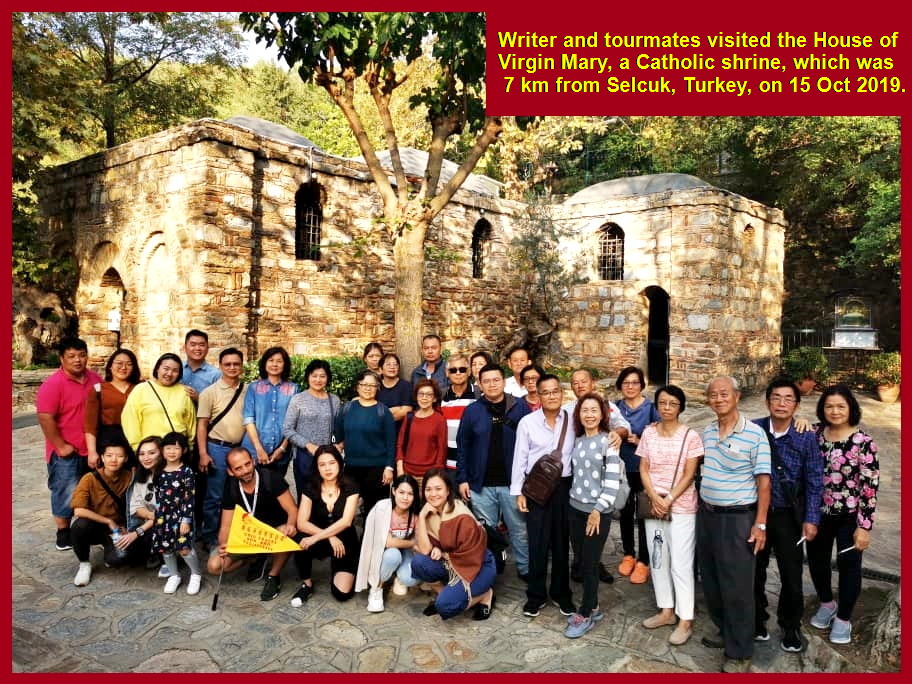
Entering the House of Virgin Mary
Visitors were entering the House of Virgin Mary where photographing was prohibited inside, while writer’s wife was standing in front of the house.
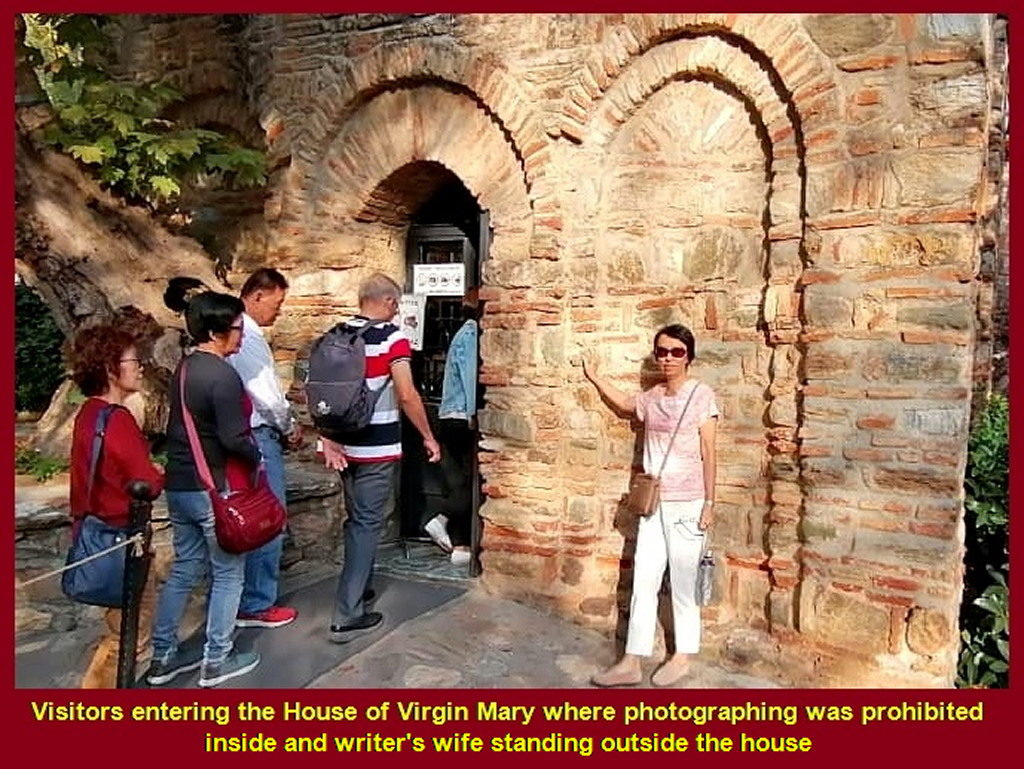
A Model Stable
A model stable near the House of Virgin Mary showed the birth of Jesus, the Son of God, while her husband, Joseph, was watching.
Virgin Mary gave birth to Jesus in Bethlehem in Israel over 2000 years ago.
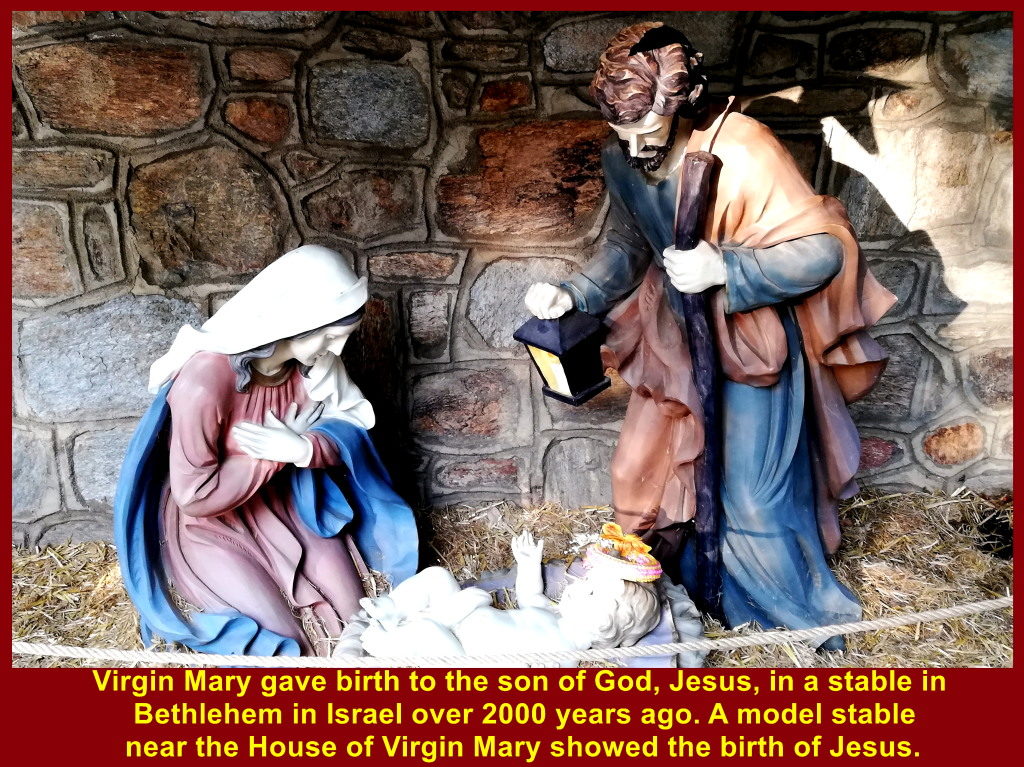
Statue of Virgin Mary
A statue of Virgin Mary was seen near Virgin Mary’s house.
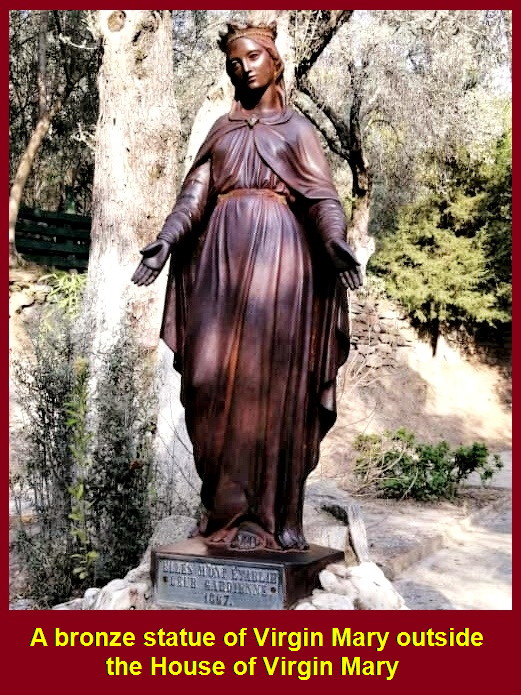
Open Air Place of Worship
There was an open air place of worship near the house.
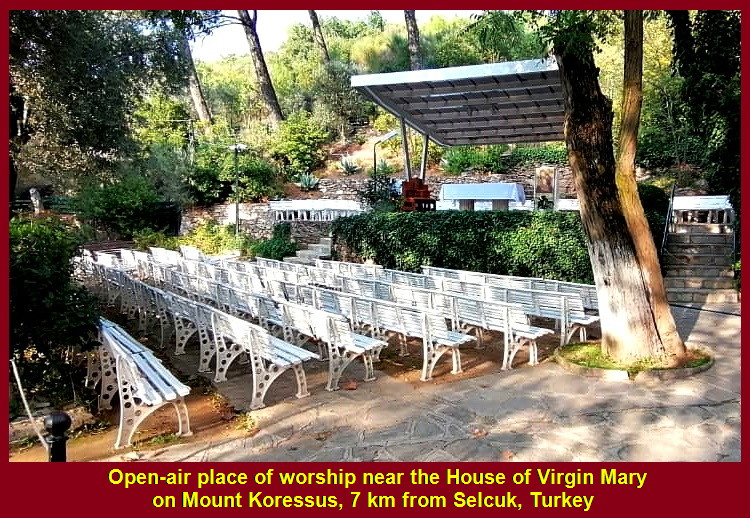
Statue of St. John
Statue of Saint John, the apostle, was spotted near Virgin Mary’s house. It was believed that St. John had brought Virgin Mary to the house on Mount Koressus which is 7 km from Selcuk, Turkey.
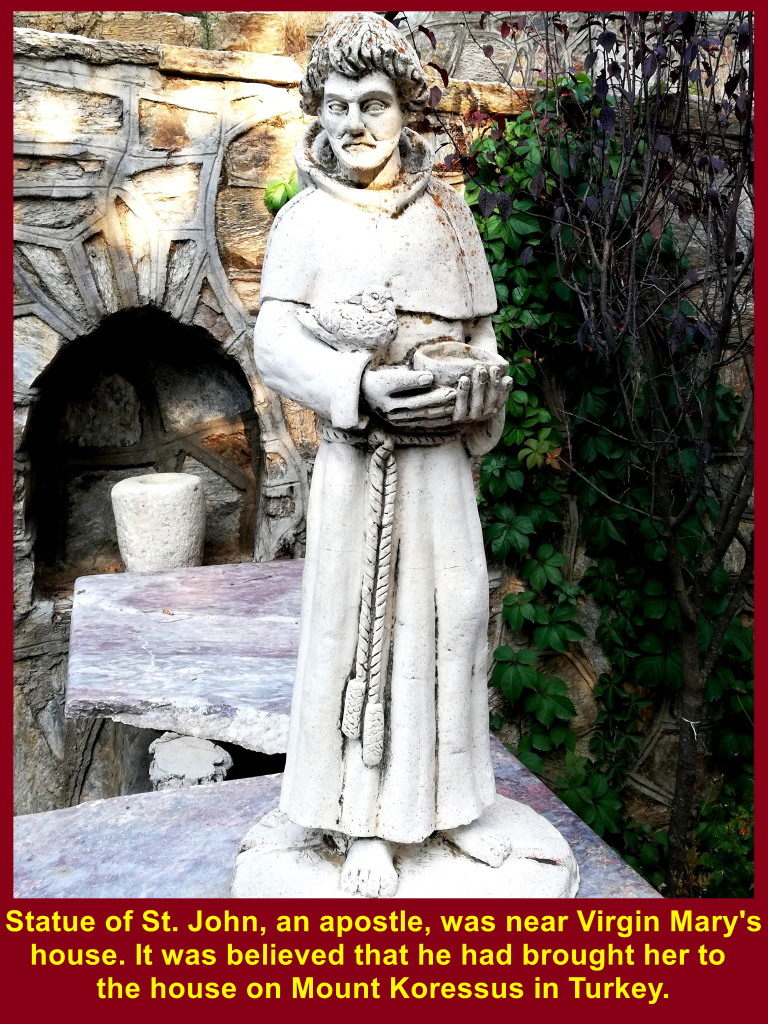
Miracle Spring Water
There was spring water from taps near Virgin Mary’s house, and Catholic pilgrims believed that it had power of healing and fertility.
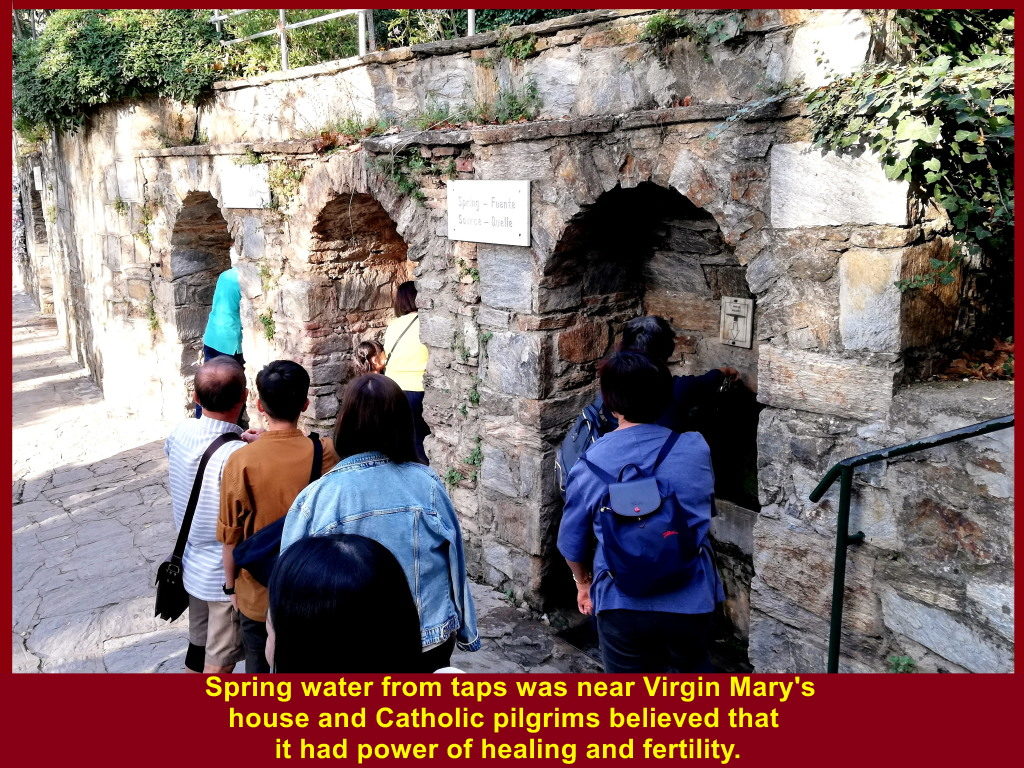
Wishing Wall
Adjacent to the spring water there was a wall stuck with countless number of papers with visitors’ wishes.
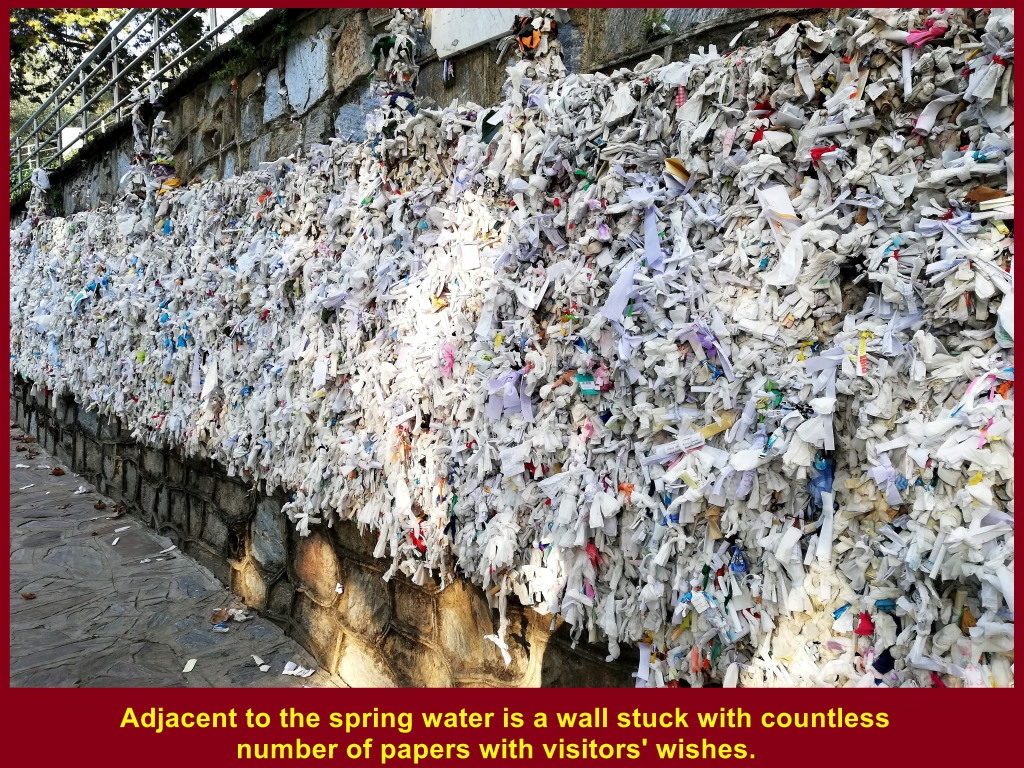
Tour Guide’s Wish
Our Turkish tour-guide, Cenmal, had written a wish on a piece of paper and stuck it on the wall behind him 18 months ago. He wished that Virgin Mary would help him to get a Lamborghini car in two years’ time. He had another 6 months to get his wish granted. We wished him good luck.
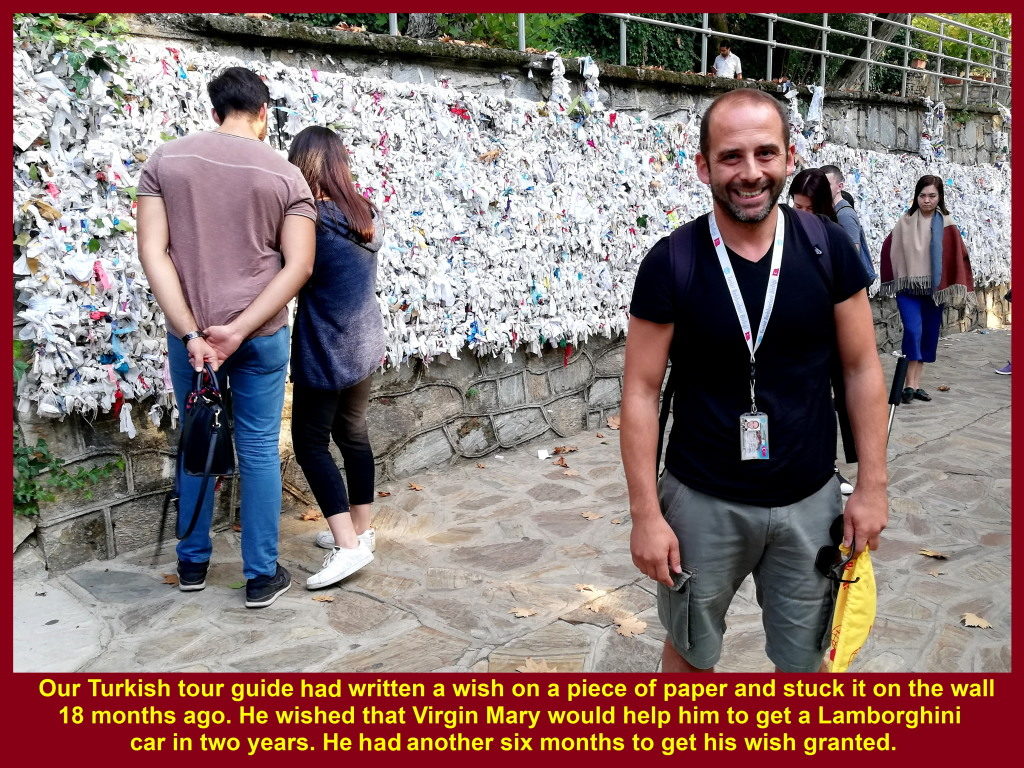
Charisma De Luxe Hotel
Finally, we left the House of Virgin Mary and travelled to Kusadasi where we stayed at a 5-star hotel, Charisma De Luxe Hotel, for a night on 15 Oct 2019.
The hotel had a beautiful view of Aegean Sea and a quarter-shaped swimming pool.
Beautiful Sunset
When we reached the hotel we were fortunate to see an awesome sunset over Aegean Sea on 15 Oct 2019.
Previous Page / Home / Next Page
Places visited during Turkey Tour(13-22 Oct 2019):
Trojan Horse/Ancient Troy Cities Asklepion Ephesus Hierapolis/Pamukkale Travertine Sultanhani Caravanserai Pasabag Valley Uchisar Valley/Kaymakli Underground City Gerome Valley/Turkish Night Show Hot Air Balloon/Lake Golu/Anitkabir Hagia Sophia/Topkapi Palace/Blue Mosque Bosphorus Boat Cruise Spice Bazaar/Grand Bazaar
Turkey Travel Part III: Ephesus
Day 4
Wednwsday, 16 Oct 2019
Kusadasi to Pamukkale
In the morning of Day 4, writer and tourmates left Kusadasi and travelled 190 km east to Pamukkale.
Time taken to travel from Kusadasi to Pamukkale is 2 hours and 40 minutes.
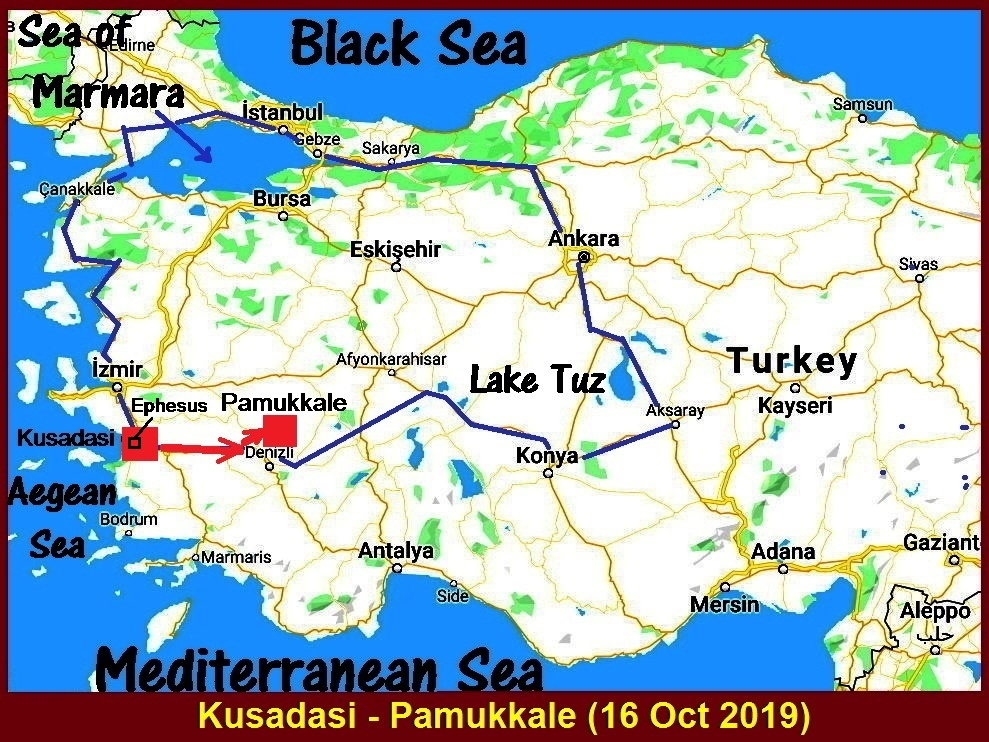
Writer’s Breakfast
Writer’s simple but nutritious breakfast at Charisma De Luxe Hotel on 16 Oct 2019
A Lamb-Leather Product Shop
On the way to Pamukkale, we stopped at a lamb-leather product shop near the hotel for a while.
At the shop, we were ushered in a room to watch a catwalk fashion show.
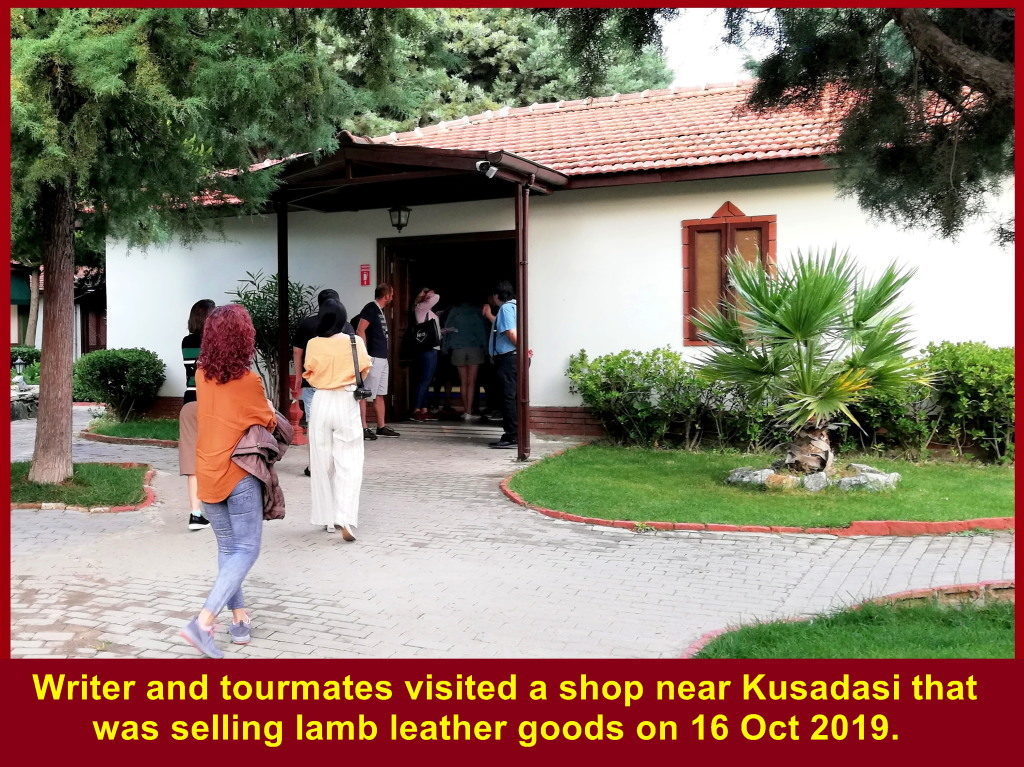
Catwalk Fashion Show
In the show, house-models walked down a catwalk showing off the shop’s lamb-leather jackets.
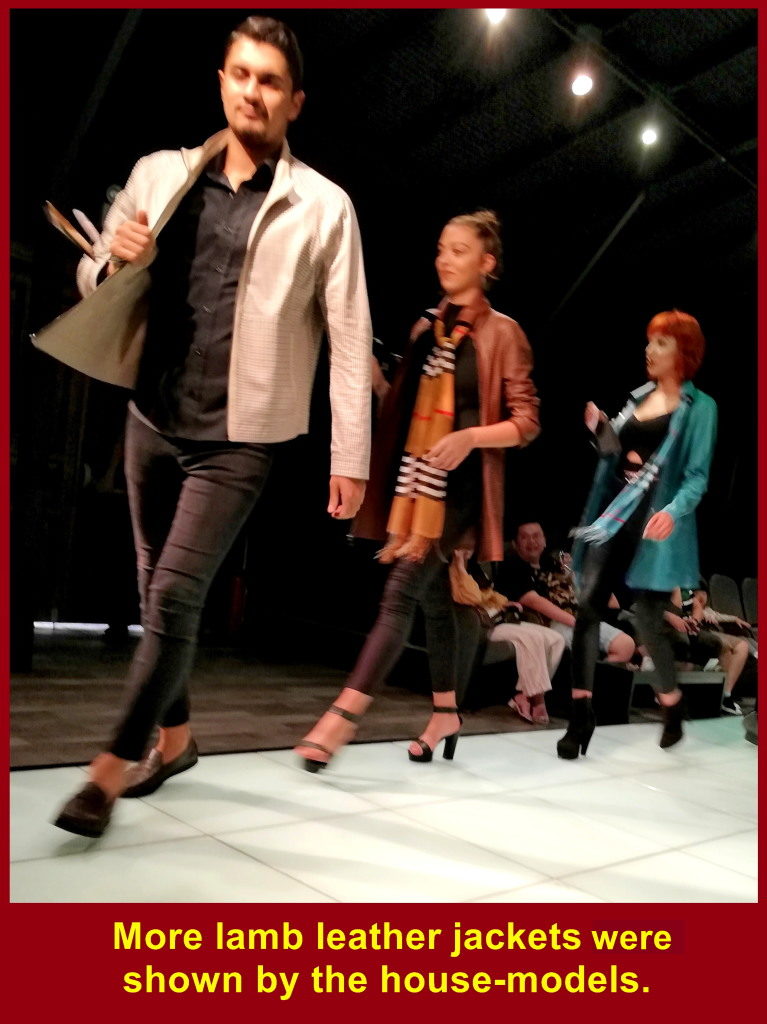
Catwalk Fashion Show by Tourmates
Then some of our tourmates were chosen to walk down the catwalk showing off the shop’s jackets.
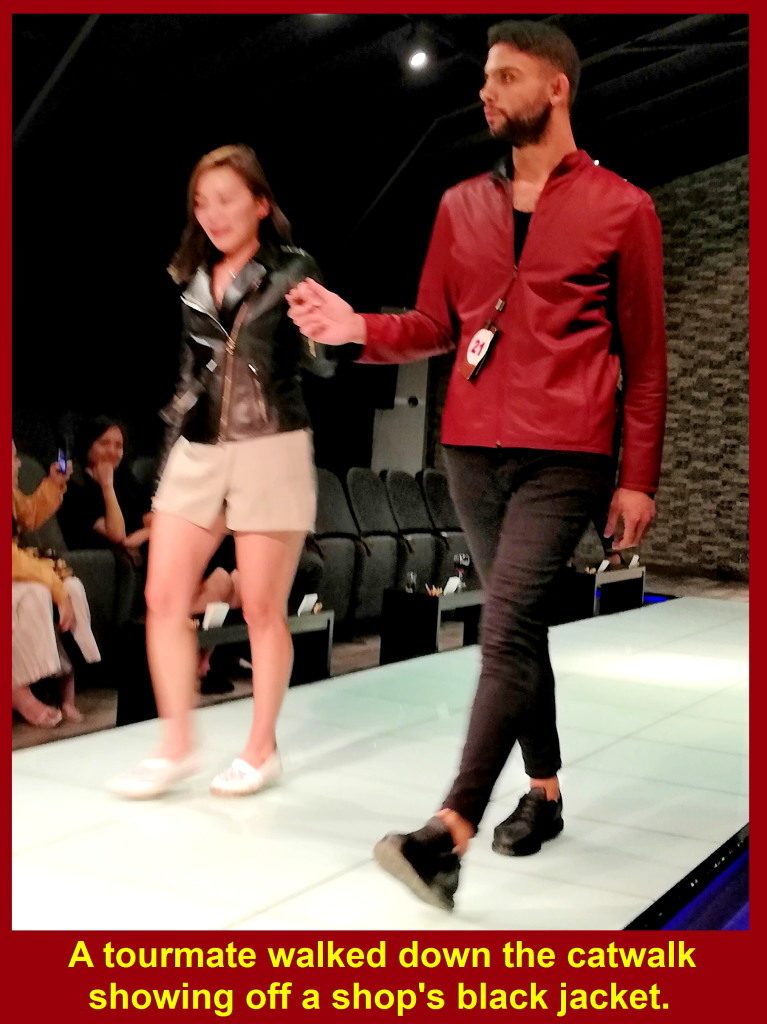
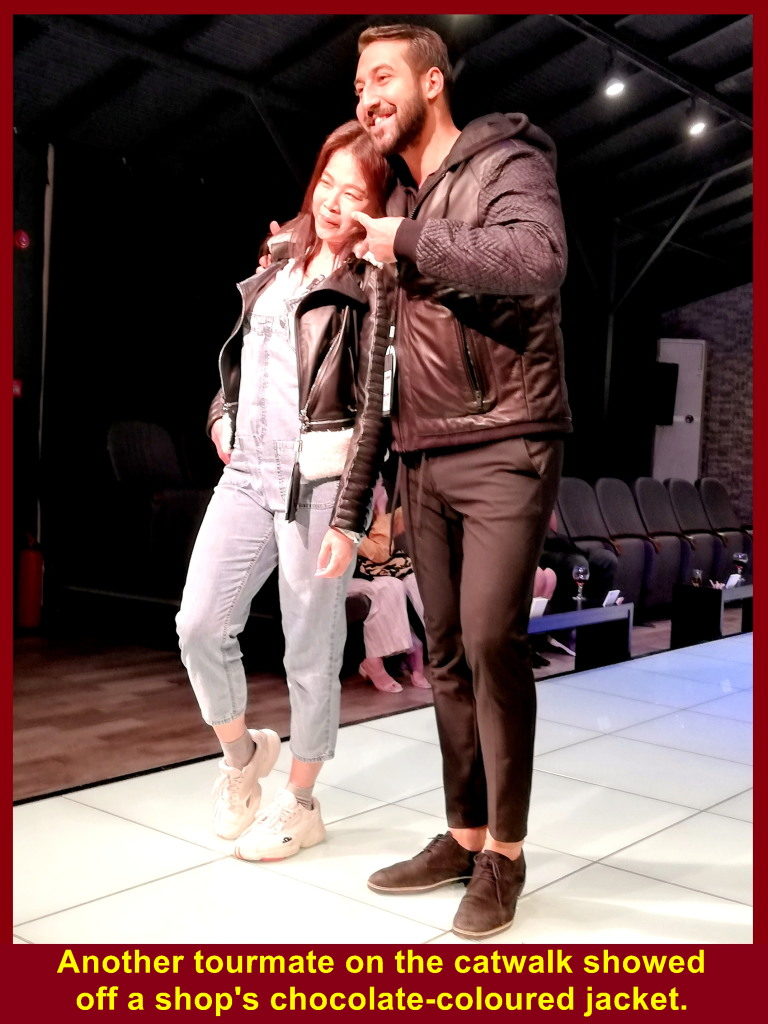

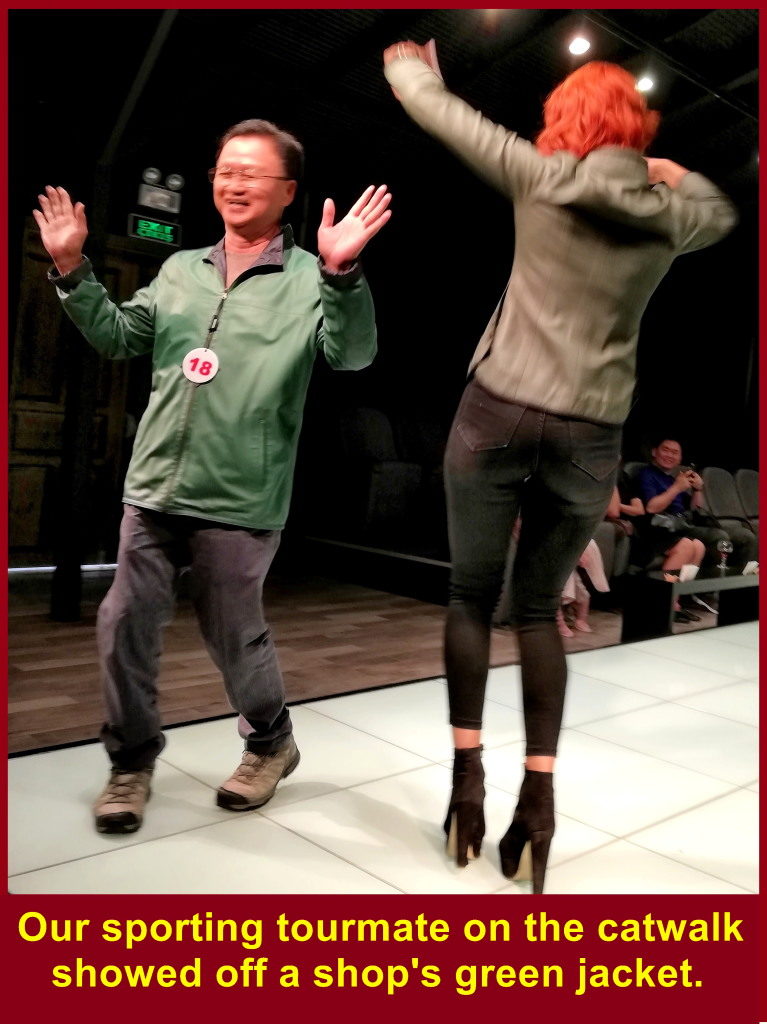
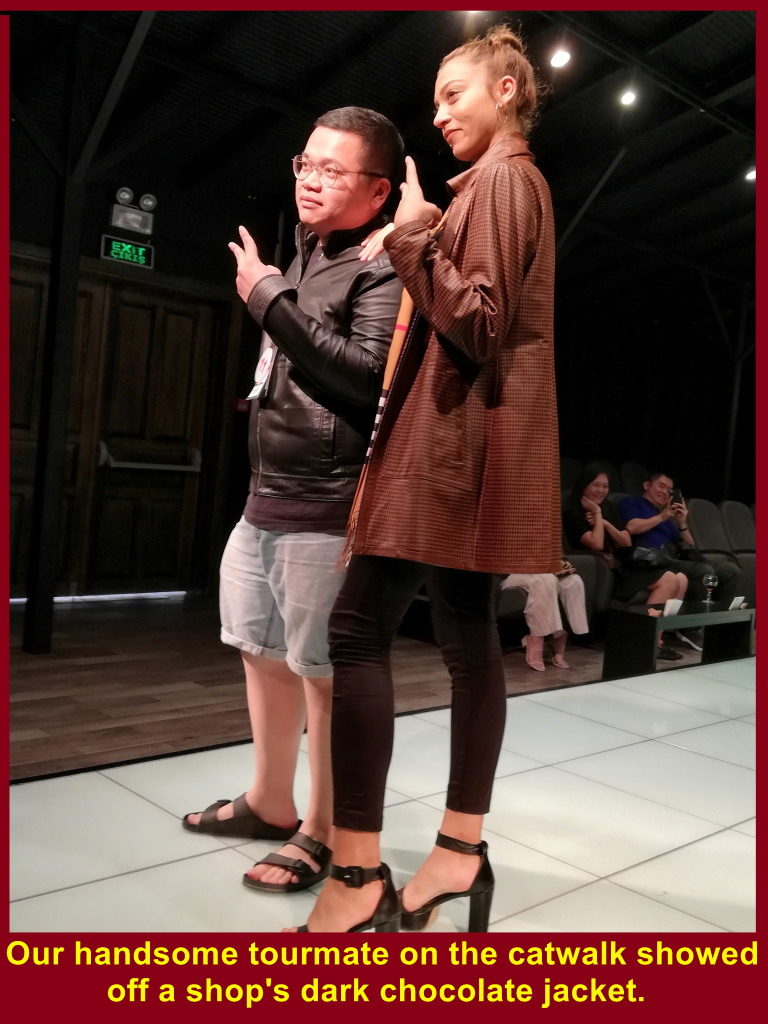
Saleman Talk
After the catwalk fashion show, we were ushered in another room where a salesman explained the quality and designs of the lamb leather jackets.
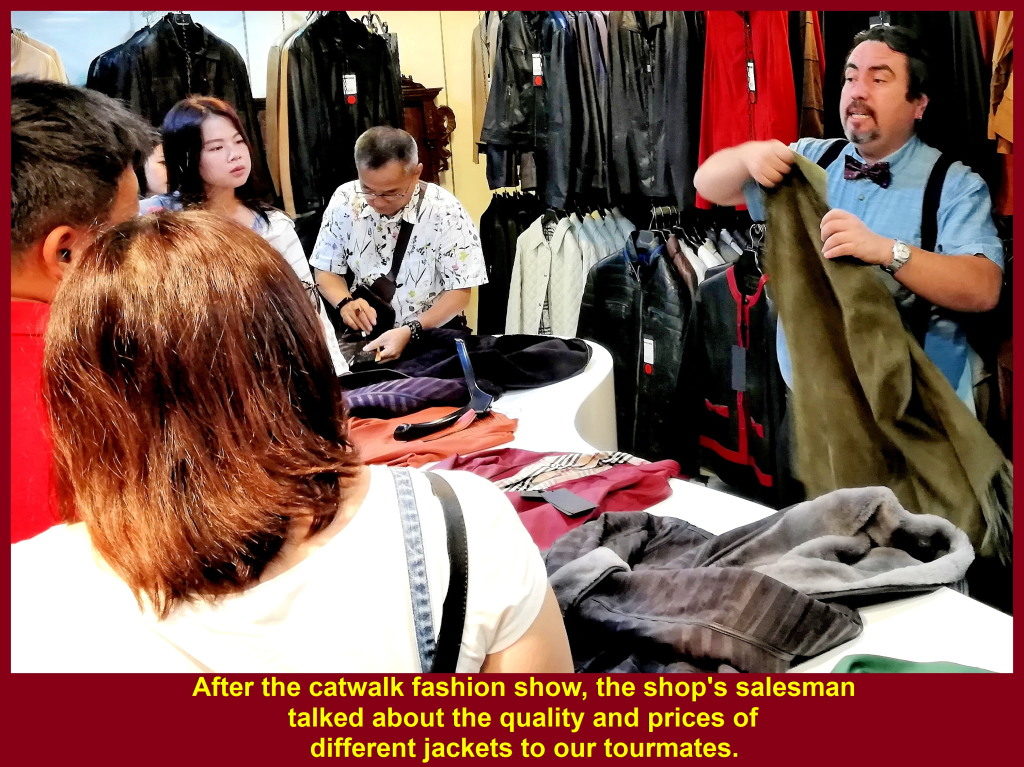
Showroom
After the explanation he asked us to choose and buy the jackets in a showroom.
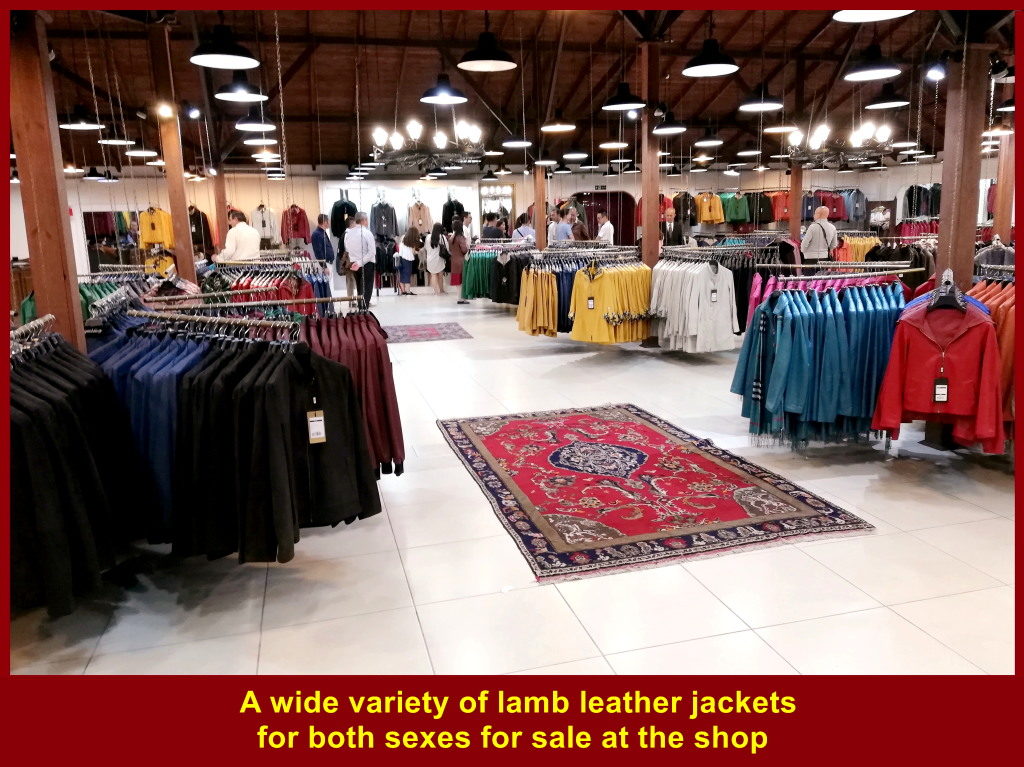

Few Bought the Jackets
A few tourmates bought the jackets.
Ancient Ephesus Archaeological Site
Then we travelled to an ancient city which was 19 km north of Kusadasi. Located near Selcuk in Izmir, it is known as Ancient Ephesus Archaeological Site.
Diagram of the Ancient Ephesus Archaeological Site
A diagram below shows the ancient Ephesus archaeological site.
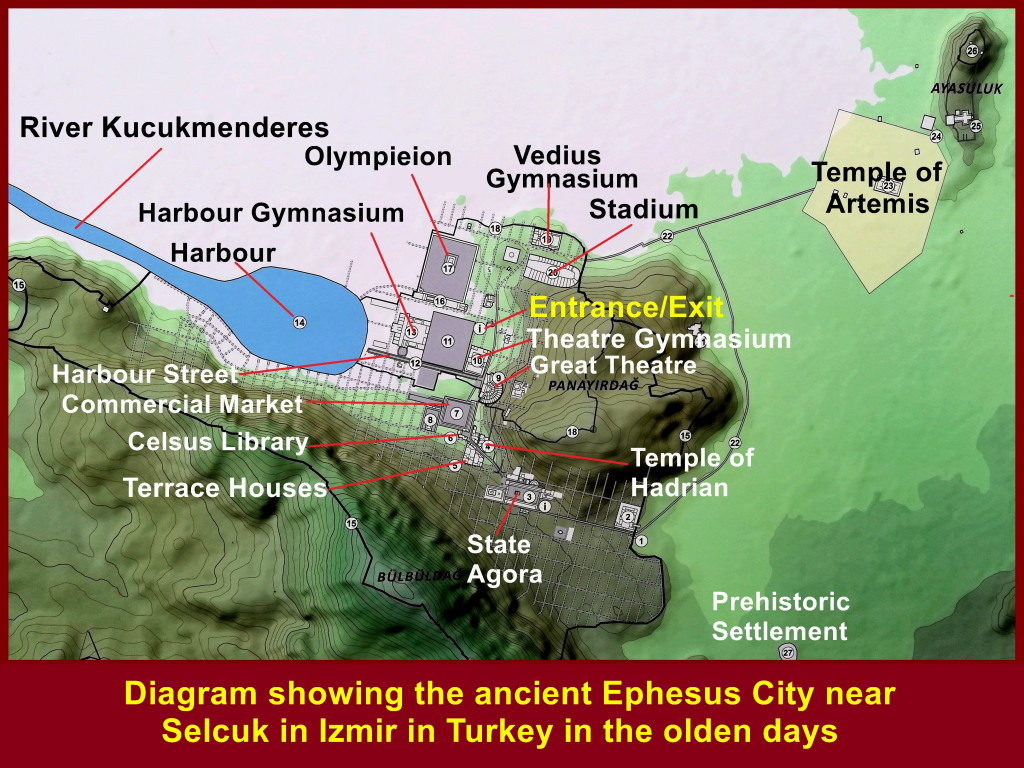
Deep Harbour
Ephesus was a Greek settlement and founded in the 10th. Century BC. It flourished in trade due to the deep River Kucukmenderes harbour. In 15th. Century AD it was abandoned as the river became shallow.
Youngest, Cutest Tourmate
As our tour-guide was talking about the history of ancient city of Ephesus, our youngest, cutest tourmate was listening with full concentration.
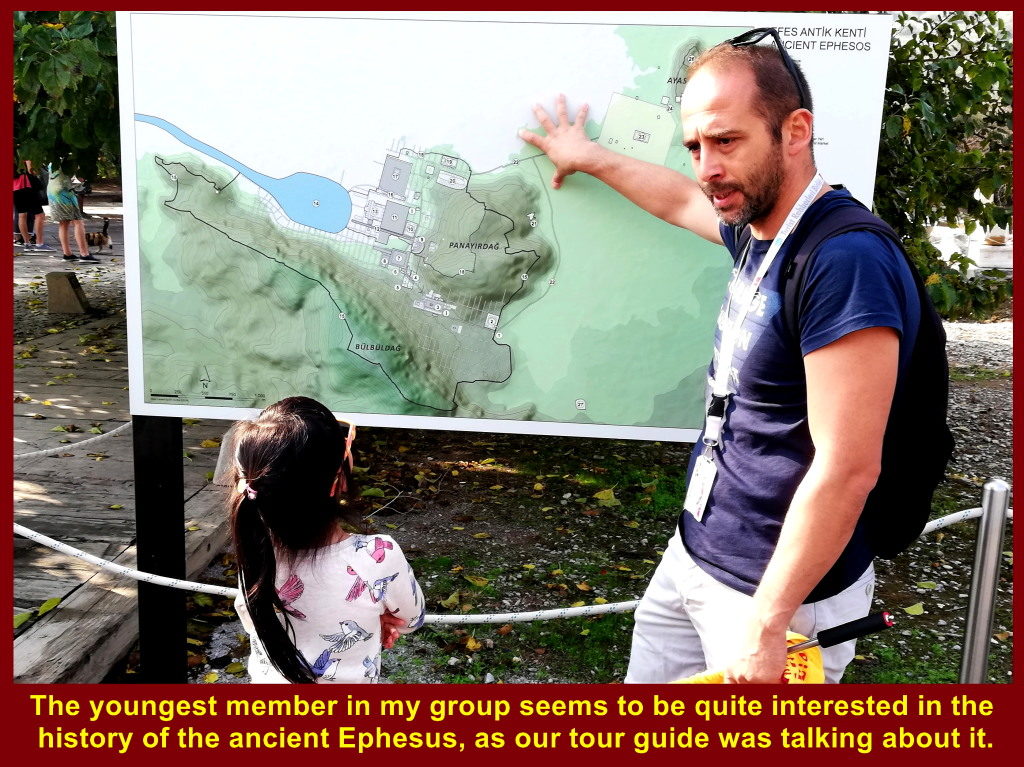
Entrance Fee
A fee was required to enter the ancient Ephesus archaeological site, a Roman City in 133 BC.
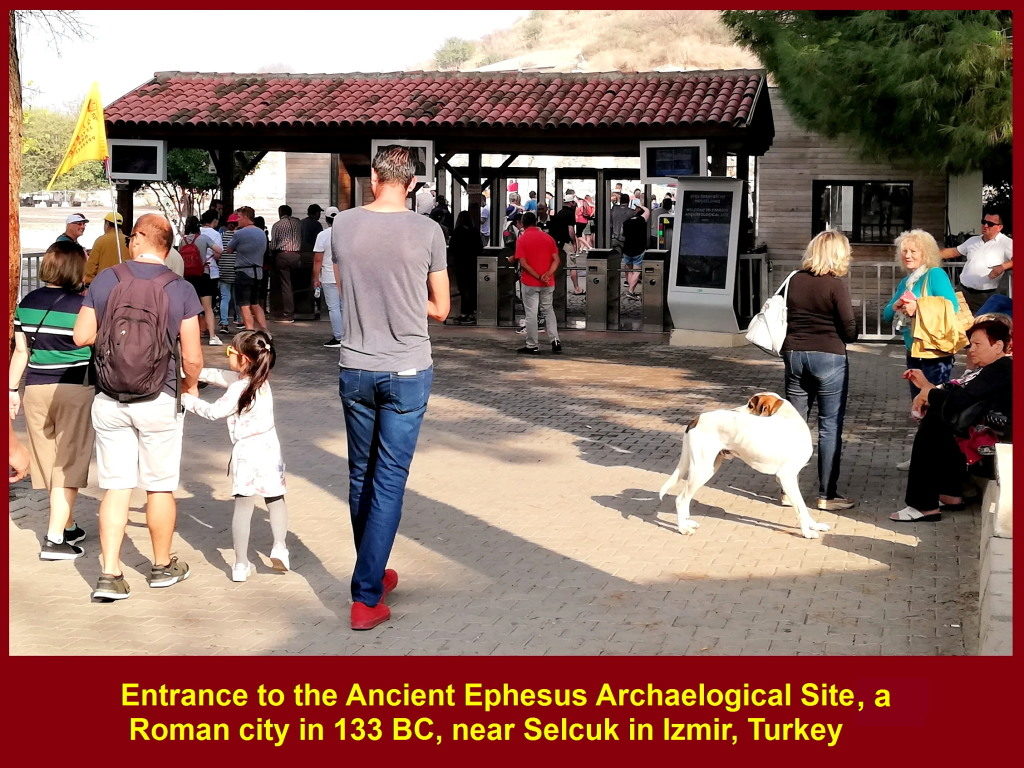
Ruins of Ancient City of Ephesus in Photos
Below are photos showing some of the ruins we saw in the ancient city of Ephesus on 16 Oct 2019.
(i) Ruined Varius Bath that was built in 200 AD.
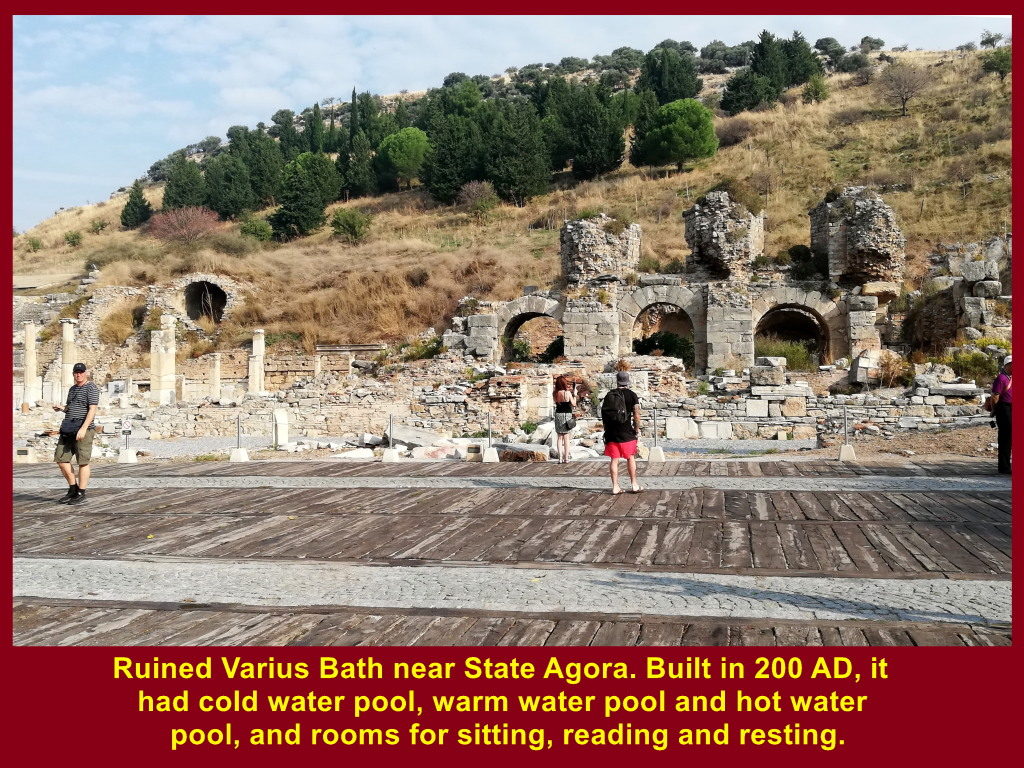
(ii) Part of the ruined site of the ancient city of Ephesus.
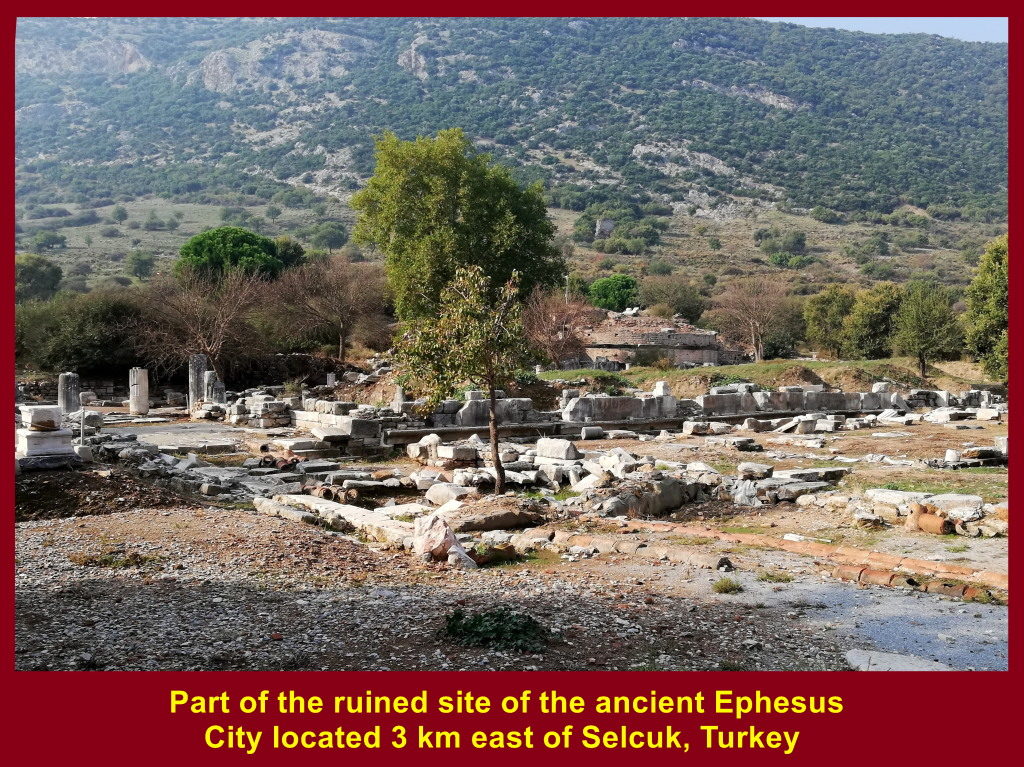
(iii) Bouleuterion that was built in 100 AD for council meetings, musical performances and contests.
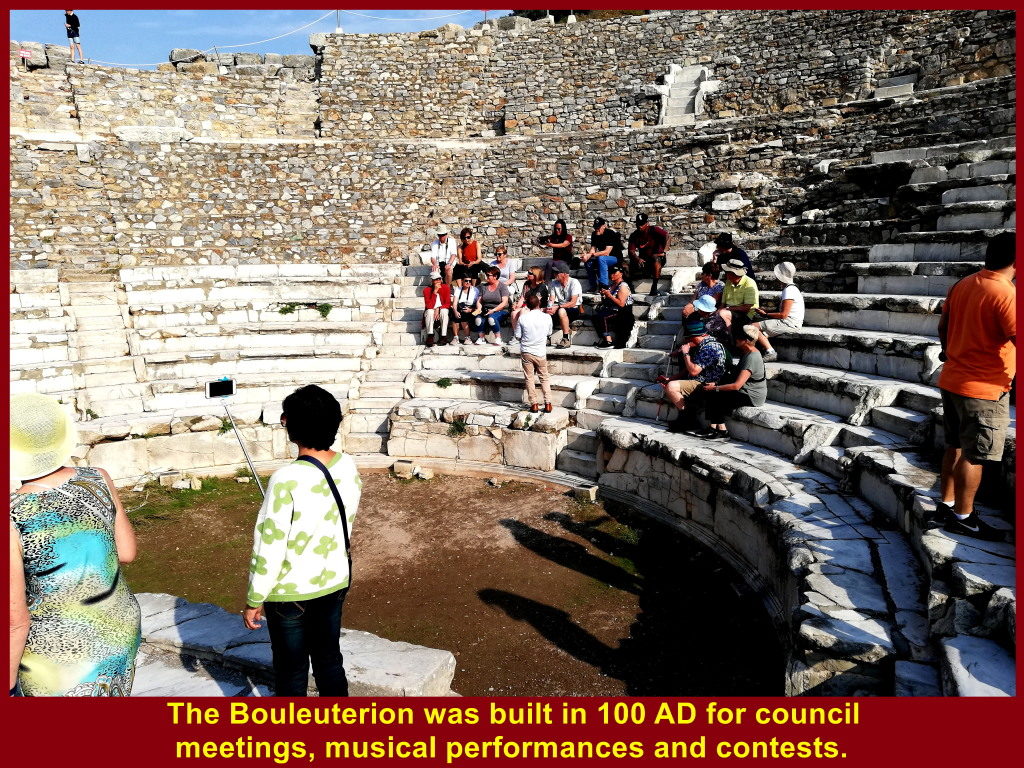
(iv) Curetes Street, the main street of the ancient city of Ephesus
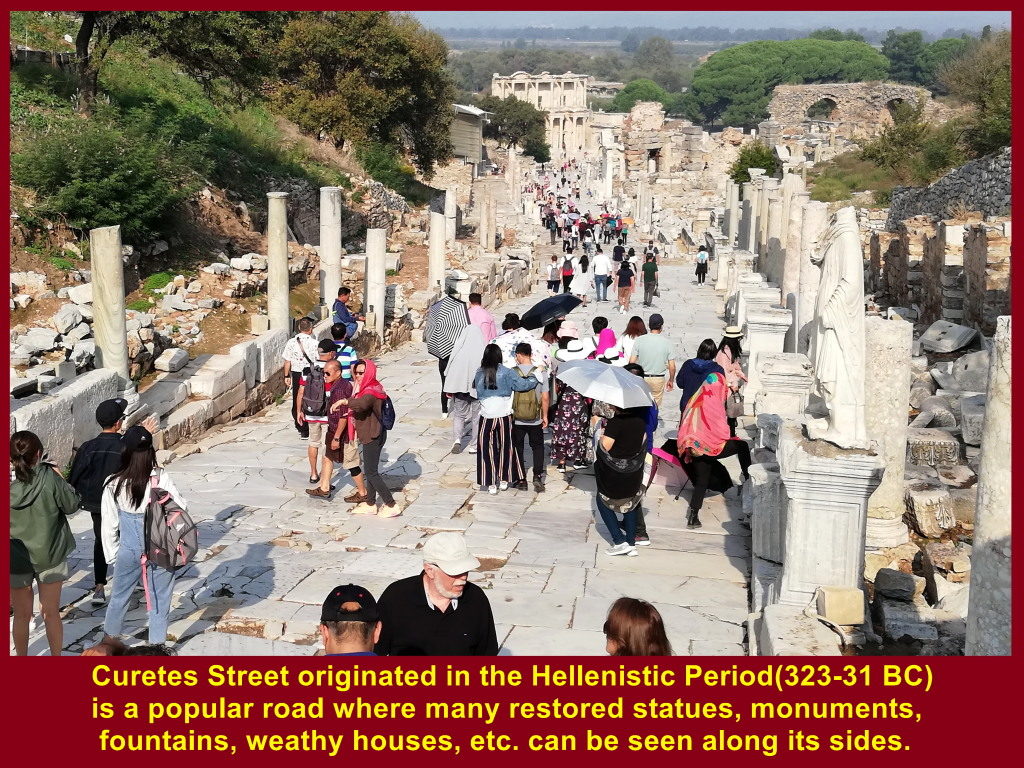
(v) Relief of the Goddess of Victory, Nike
(vi) Headless statue of a Roman figure on Curetes Street
(vii) A relief showing the symbol of medicine, a staff with two snakes entwining it
(viii) A relief of a man with a staff of Asclepius. Asclepius was a Greek mythological God of healing and medicine.
(ix) Fountain of Trajan was built in 114 AD in dedication to a Roman emperor, Trajan(53-117 AD).
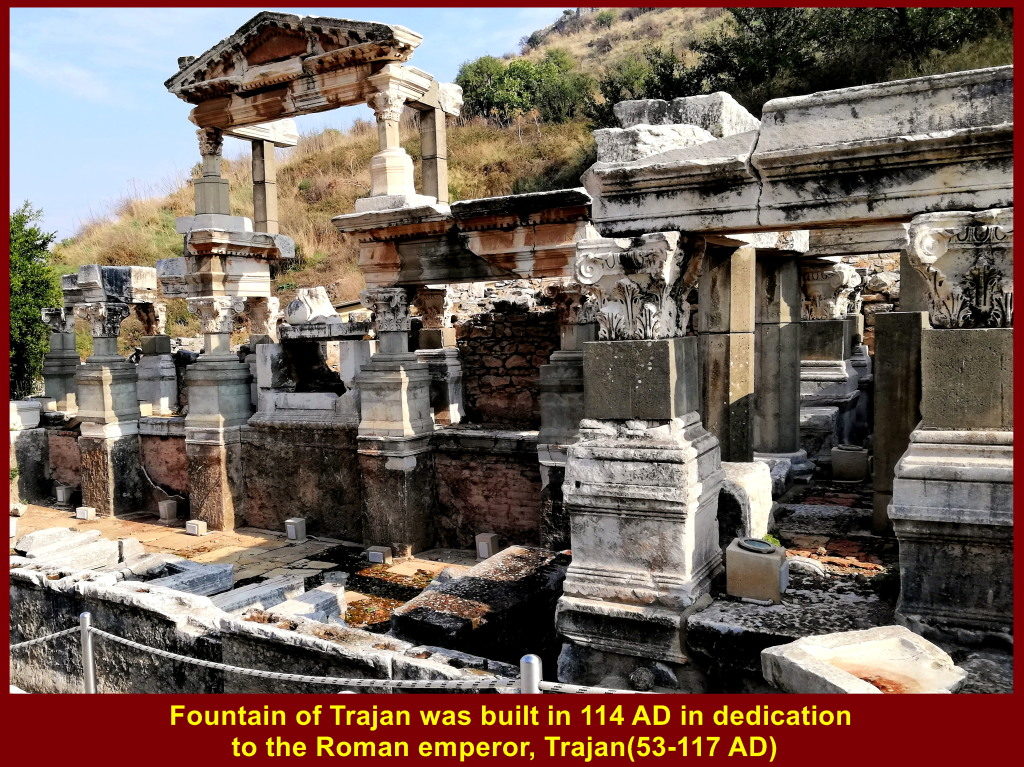
(x) Terraced houses of wealthy people on the main street, Curetes Street
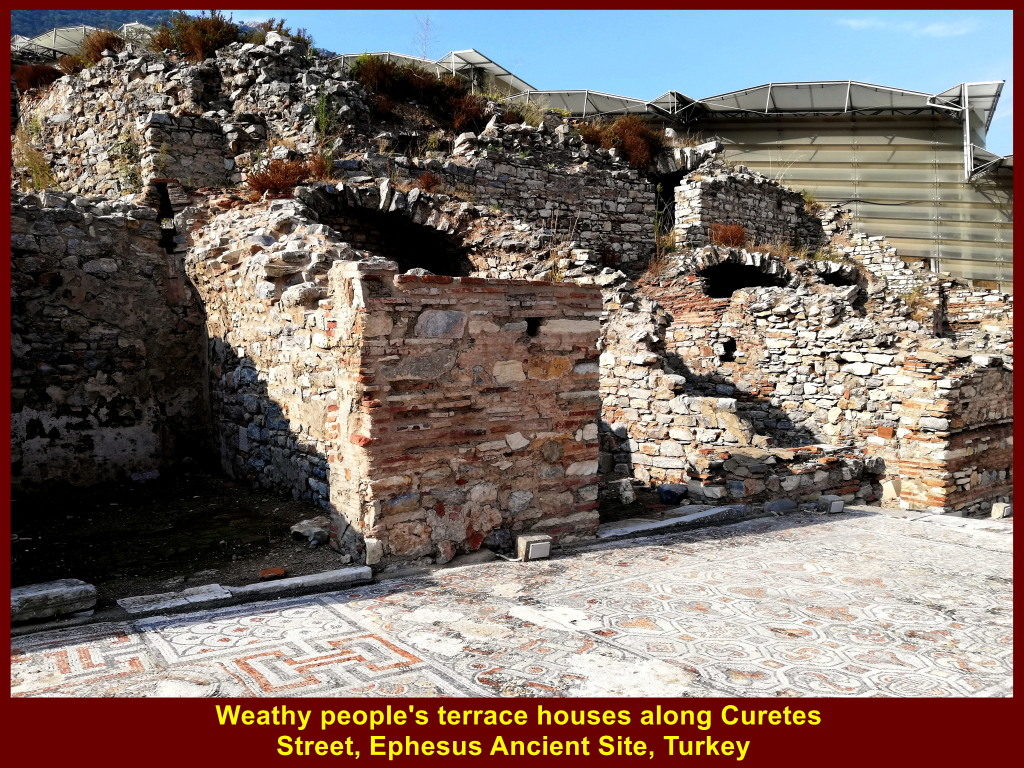
(xi) Public toilet on Curetes Street
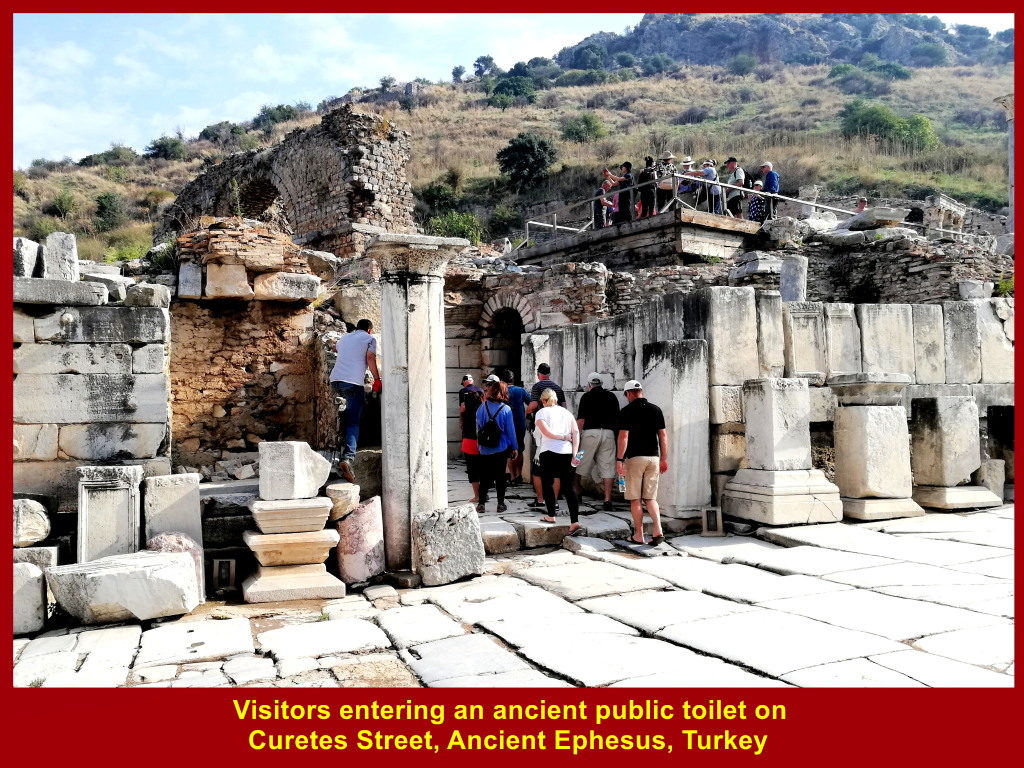
(xii) Inside the public toilet on Curetes Street
(xiii) Hadrian’s three storeyed gate built in 117 AD. Two upper storeys are now missing.
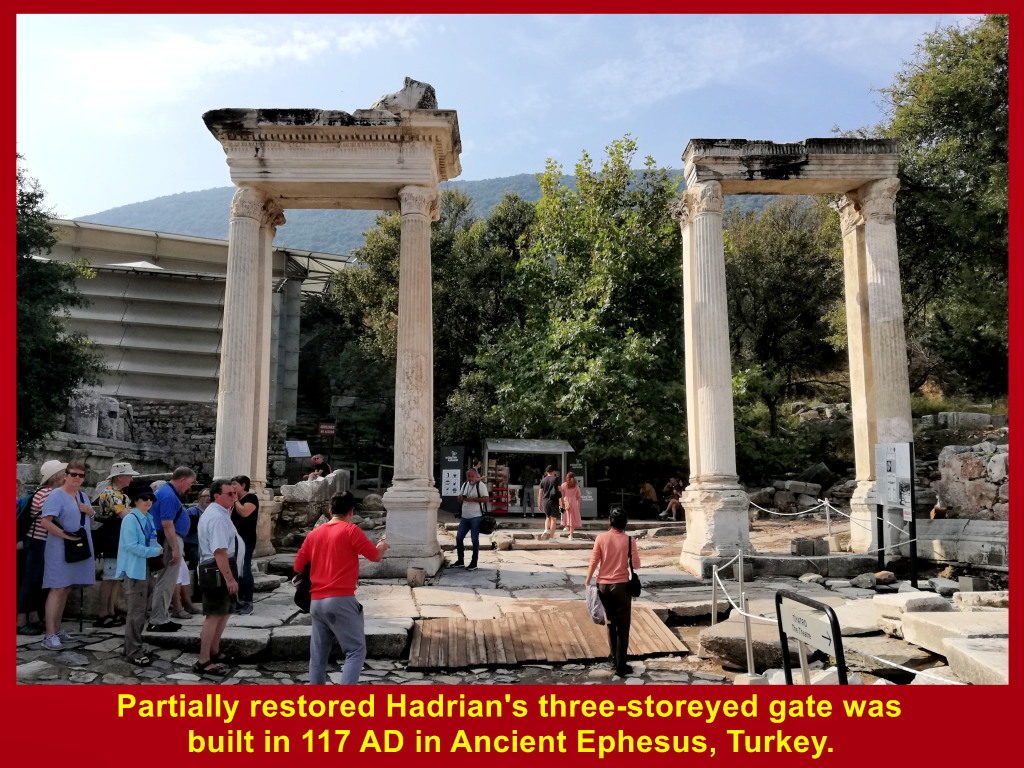
(xiv) Drawing of the actual Hadrian’s three-storeyed gate that was built in 117 AD
(xv) Temple of Hadrian built in dedication to a Roman emperor, Hadrian(76-138 AD)
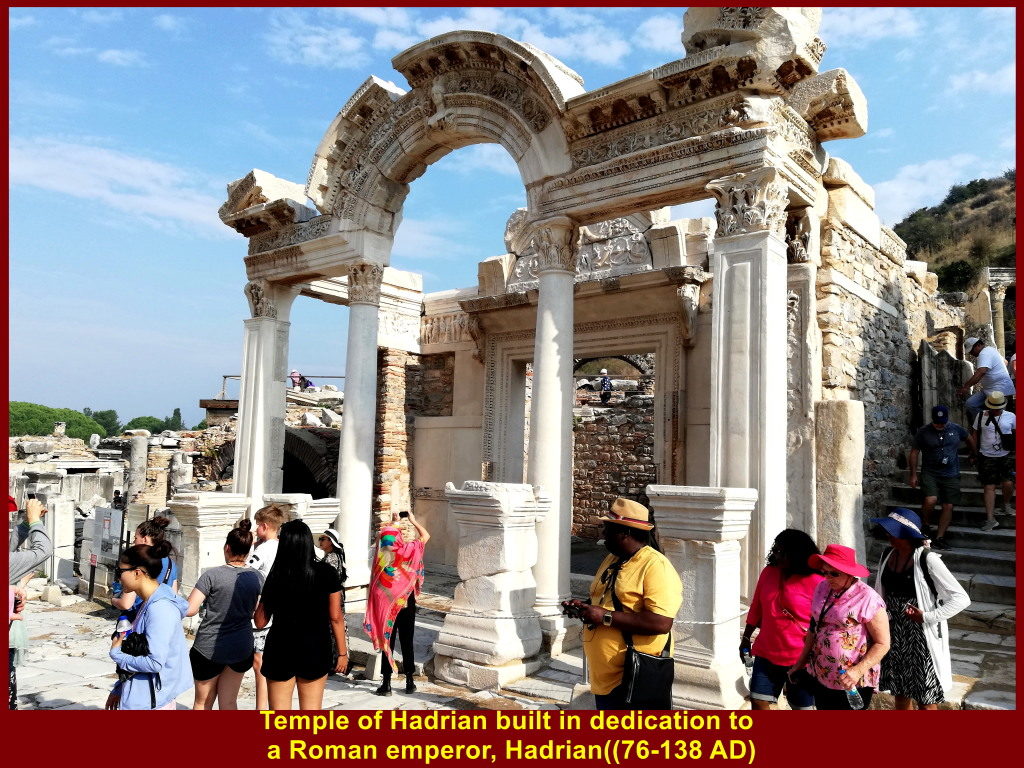
(xvi) Partially restored Library of Celsus was built in 114-117 AD by Celsus’ son in dedication to his father who was a senator.
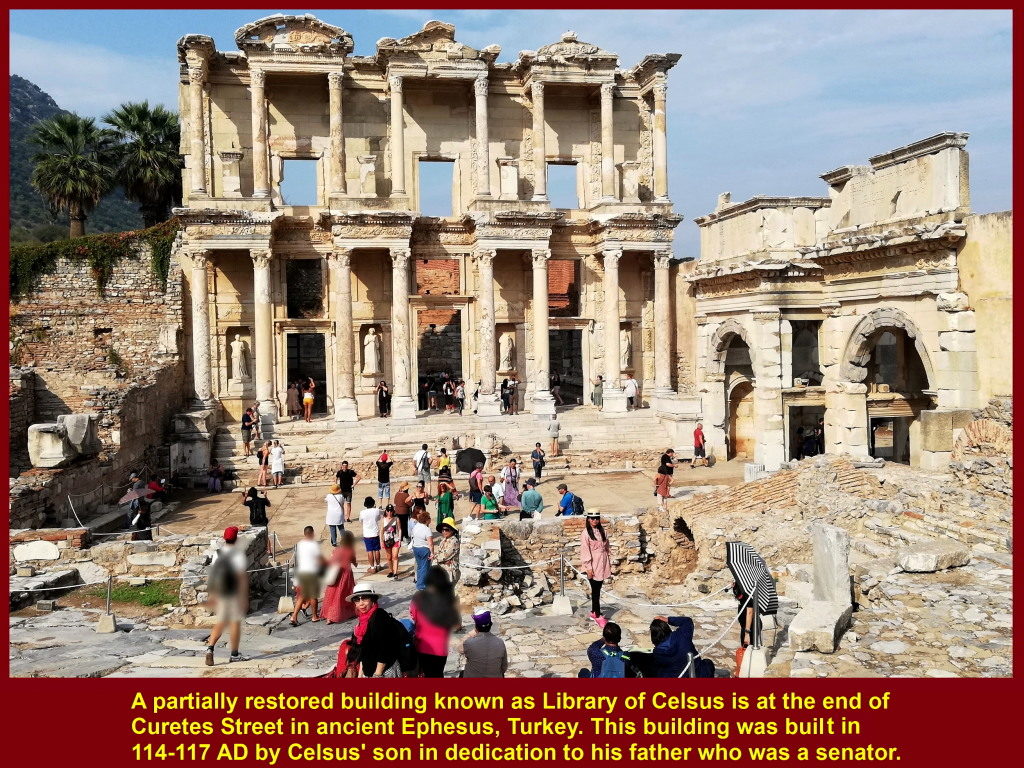
Photo of Writer and Wife
Writer and wife were in front of the Library of Celsus in the ancient city of Ephesus on 16 Oct 2019.
Group Photo
Writer and tourmates took a group photo in front of Library of Celsus in ancient city of Ephesus for remembrance on 16 Oct 2019.

Next Visit to Hierapolis and Pamukkale Travertine
Later, we all went to another ancient city known as Hierapolis in Pamukkale. We would visit a unique physical landscape known as Pamukkale Travertine near Hierapolis.
(continued on next page)
Previous Page / Home / Next Page
Places visited during Turkey Tour(13-22 Oct 2019):
Trojan Horse/Ancient Troy Cities Asklepion Ephesus Hierapolis/Pamukkale Travertine Sultanhani Caravanserai Pasabag Valley Uchisar Valley/Kaymakli Underground City Gerome Valley/Turkish Night Show Hot Air Balloon/Lake Golu/Anitkabir Hagia Sophia/Topkapi Palace/Blue Mosque Bosphorus Boat Cruise Spice Bazaar/Grand Bazaar
Turkey Travel Part IV: Hierapolis & Pamukkale Travertine
Filed under: Hierapolis, Pamukkale Travertine, Turkey Travel
(continued)
Day 4
Wednesday, 16 Oct 2019
Visiting Hierapolis
After visiting the archaeological site of ancient Ephesus City, we travelled to another archaeological site of an ancient city known as Hierapolis in Pamukkale in Turkey. It is 190 km east of Kusadasi and 600 km south of Istanbul.
Journey from Kusadasi to Pamukkale
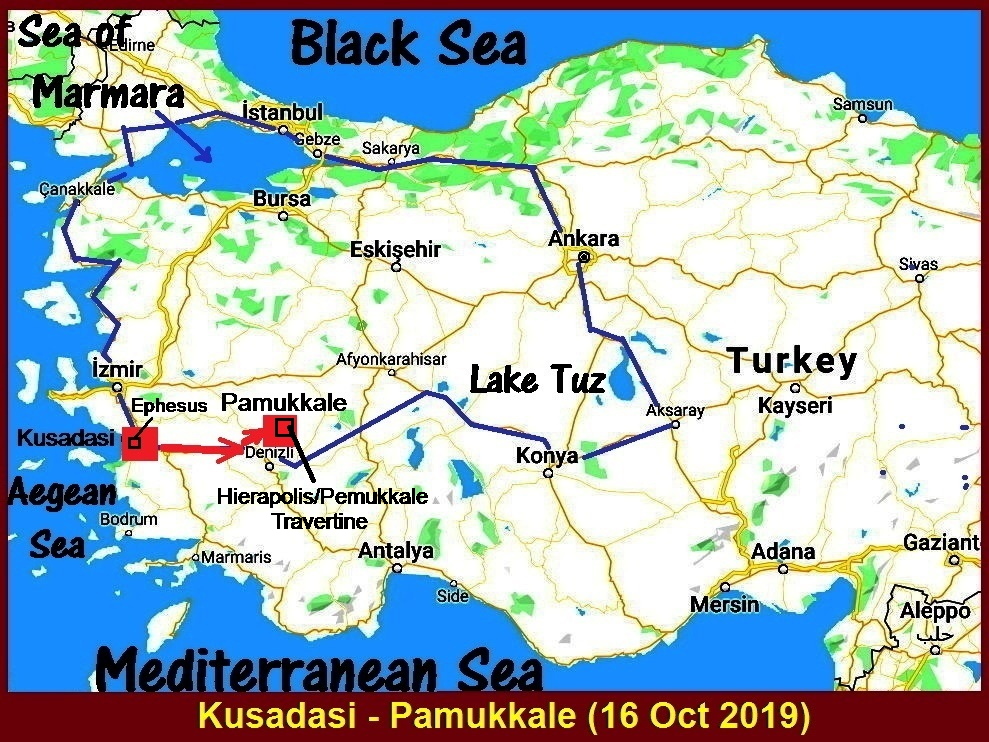
Entrance to Hierapolis
On arrival at the ancient city of Hierapolis, we entered the site with tickets. The city covered a large area but it is in ruin now. Most of it is covered with soil and excavation has been carried out to expose its buildings.
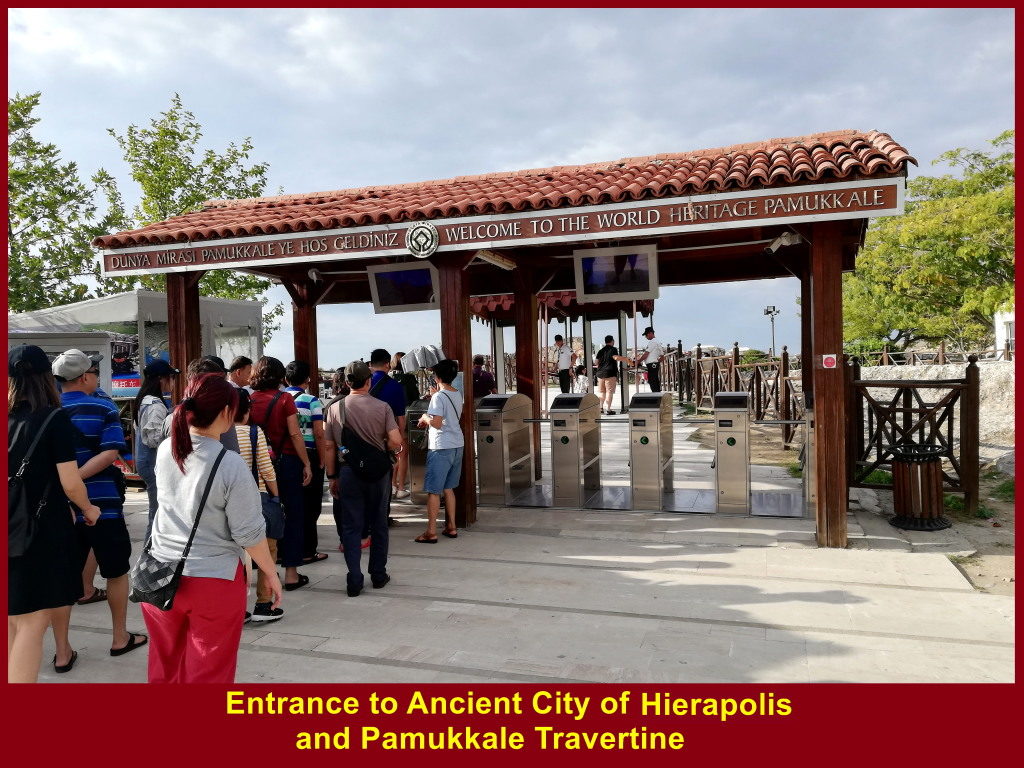
City of Hierapolis(200 BC-1400 AD)
The picture below shows the City of Hierapolis from 200 BC until 1400 AD.
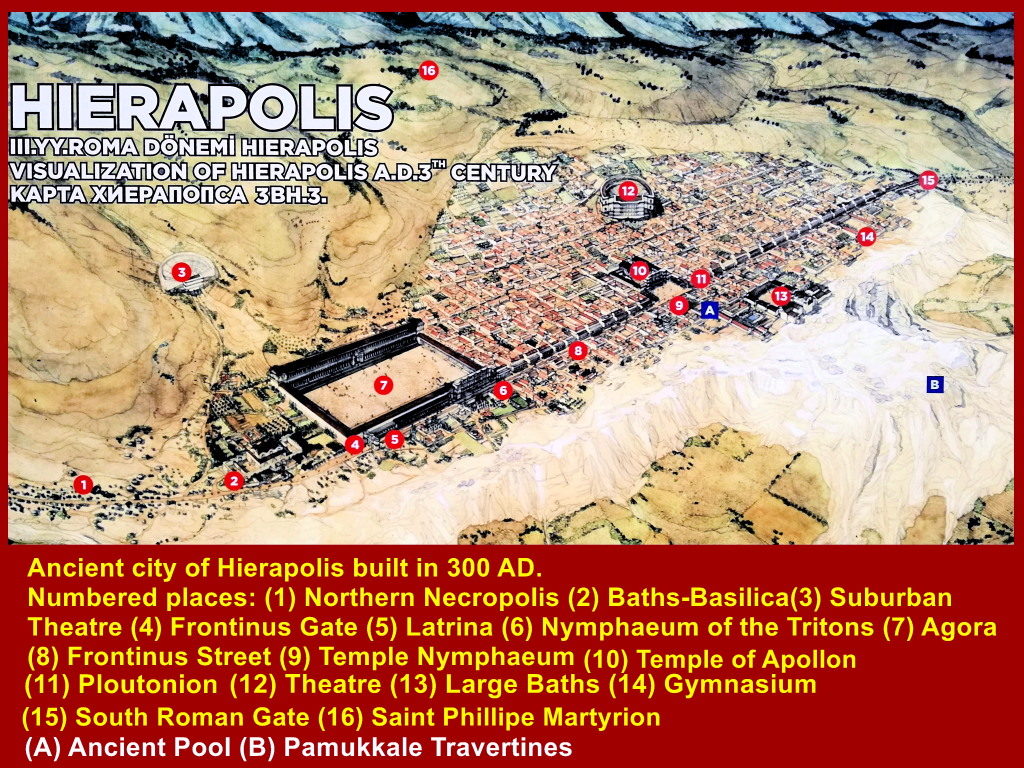
Hierapolis Within a Fortress
The ancient City of Hierapolis was within a fortress with a few gates. The photo below shows one of them.
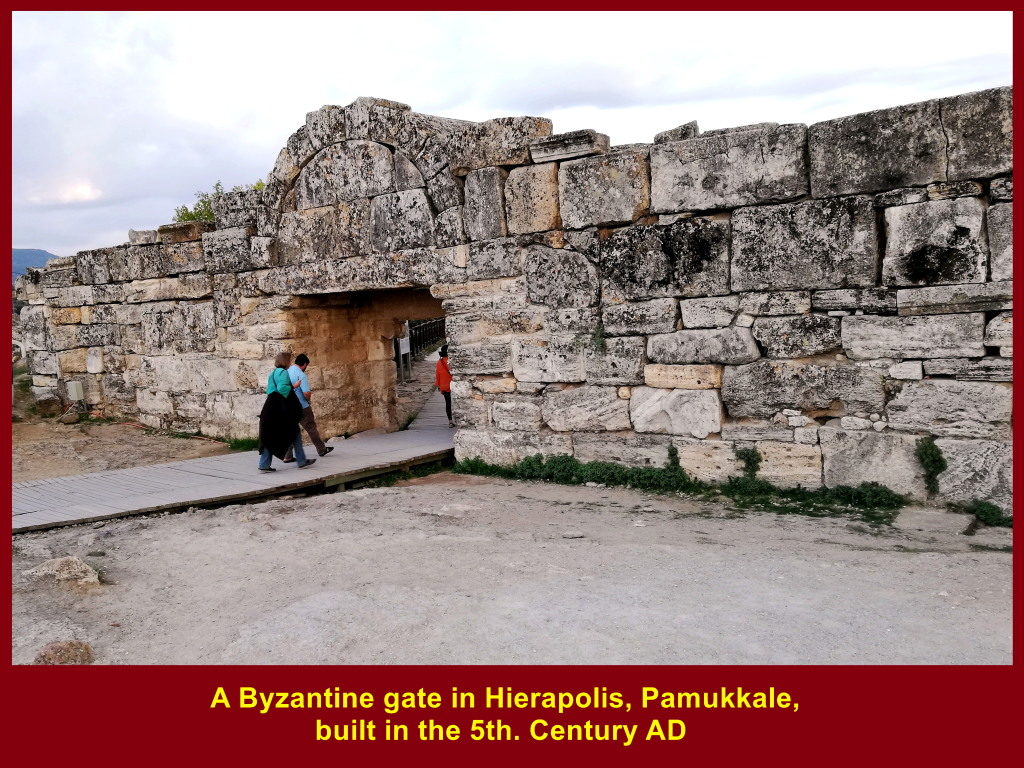
Ruins Over a Large Area
The ancient city had existed for 1600 years from 200 BC until 1400 AD. Its ruins spread over a large area and most of them are buried in the ground by soil from the surrounding high ground.
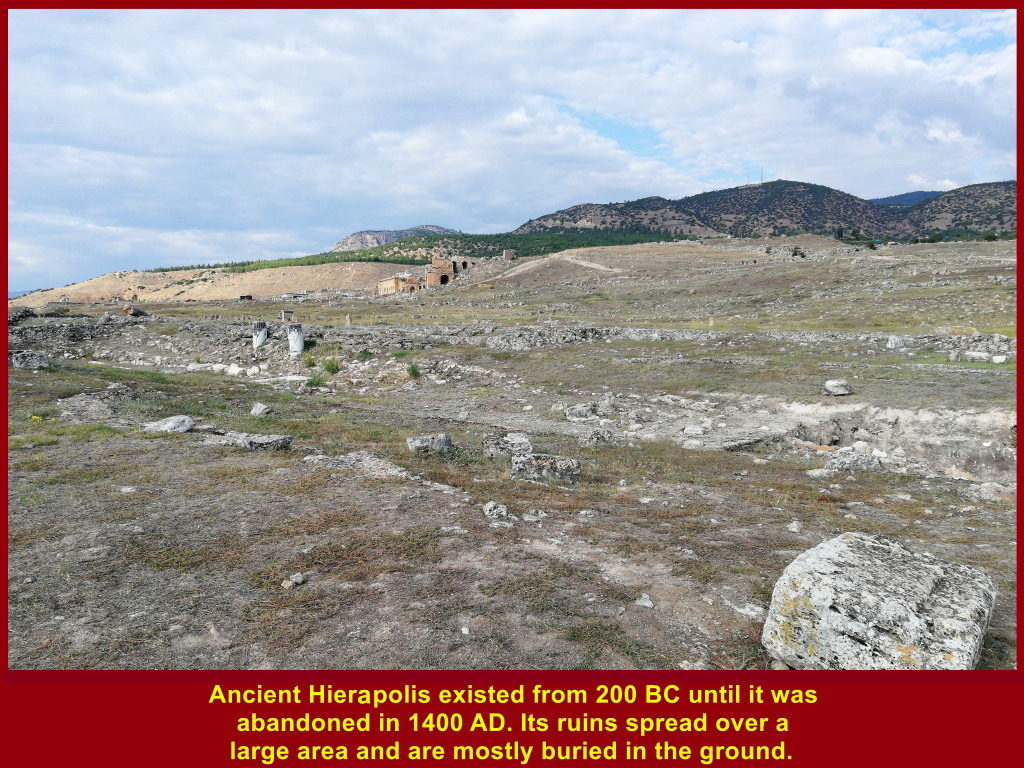
Ruins of Hierapolis in Photos
The photos below show some of the ruins in the ancient city of Hierapolis.
(i) The Theatre was built in the reign of a Roman Emperor, Hadrian(76-138 AD), in the ancient city of Hierapolis, Pamukkale, Turkey
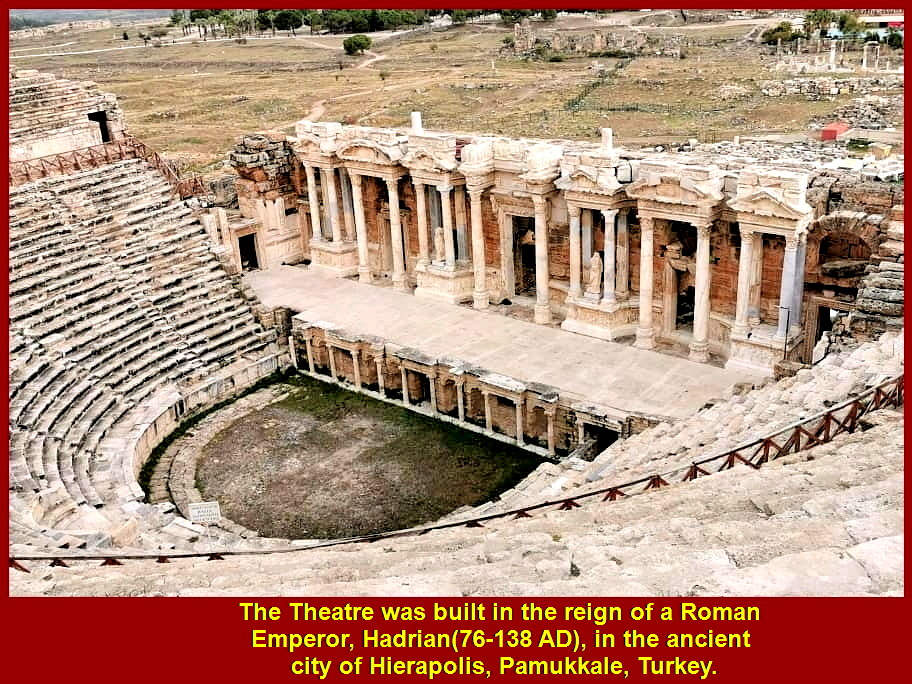
(ii) Part of the ruined city of Hirapolis
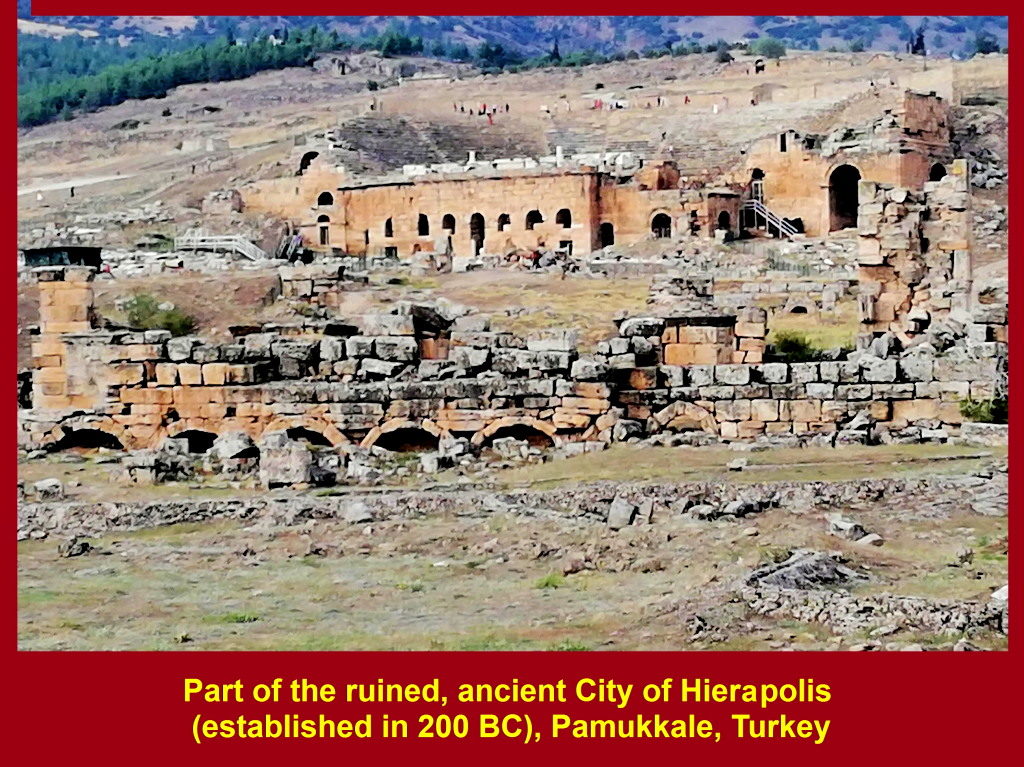
(iii) Part of the ruined Middle Age fortress on the plateau of Hierapolis City

(iv) An ancient building of Hierapolis is now a museum that houses the artefacts of the ancient city.
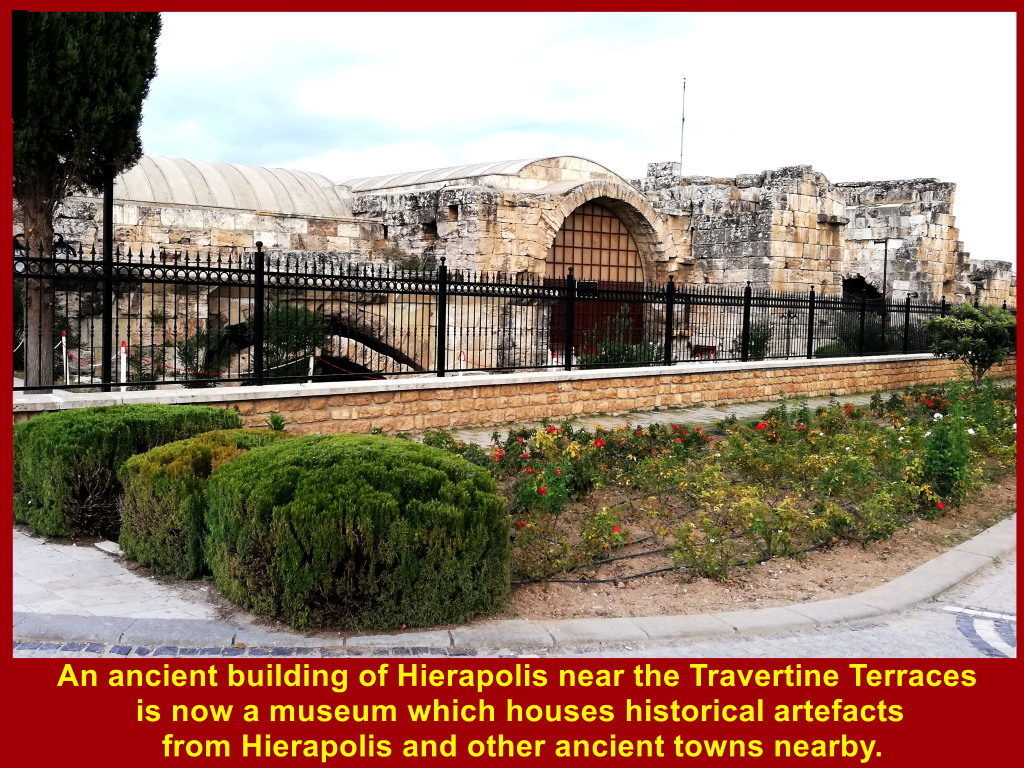
Abandoned Excavation
The photo below shows ruins that have been buried deep in the ground and excavation was abandoned long ago.
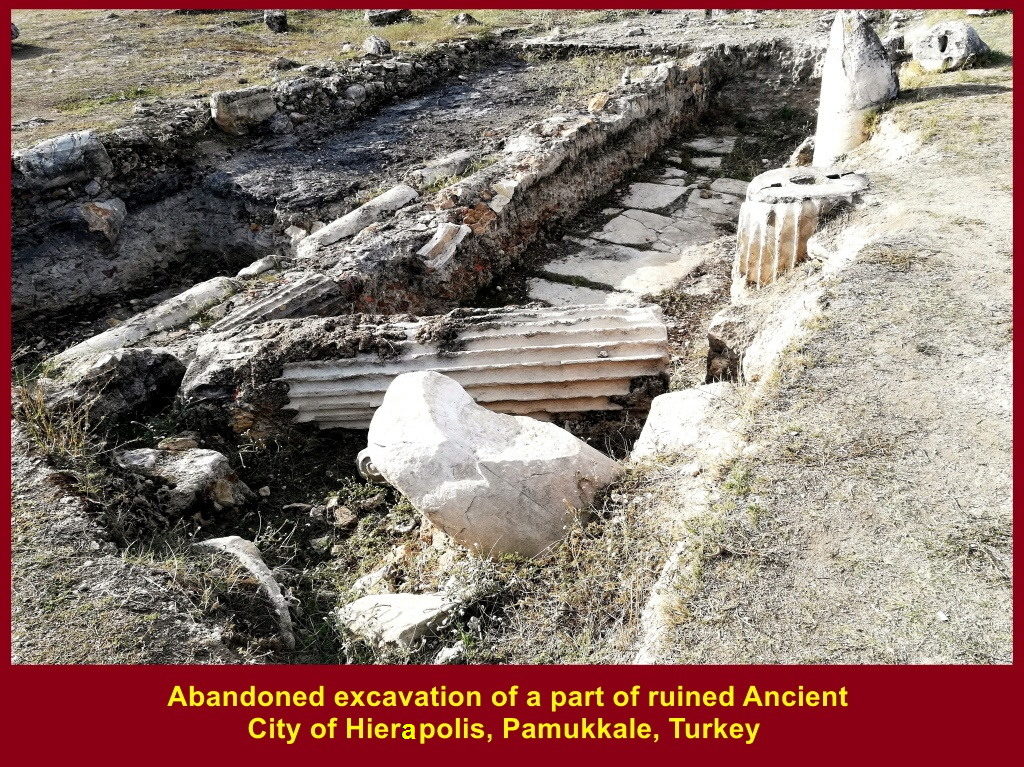
Pamukkale Travertine
Next to the ancient city of Hierapolis is the Pamukkale Travertine. Semicircular pools have been formed on the slope of a plateau. They are filled with a mixture of hot spring water and rainwater during wet seasons. Most of them are empty during dry seasons.
Semicircular Pools
The hot spring contains calcareous salts which then deposit as travertine on the slope of the plateau forming semicircular pools.
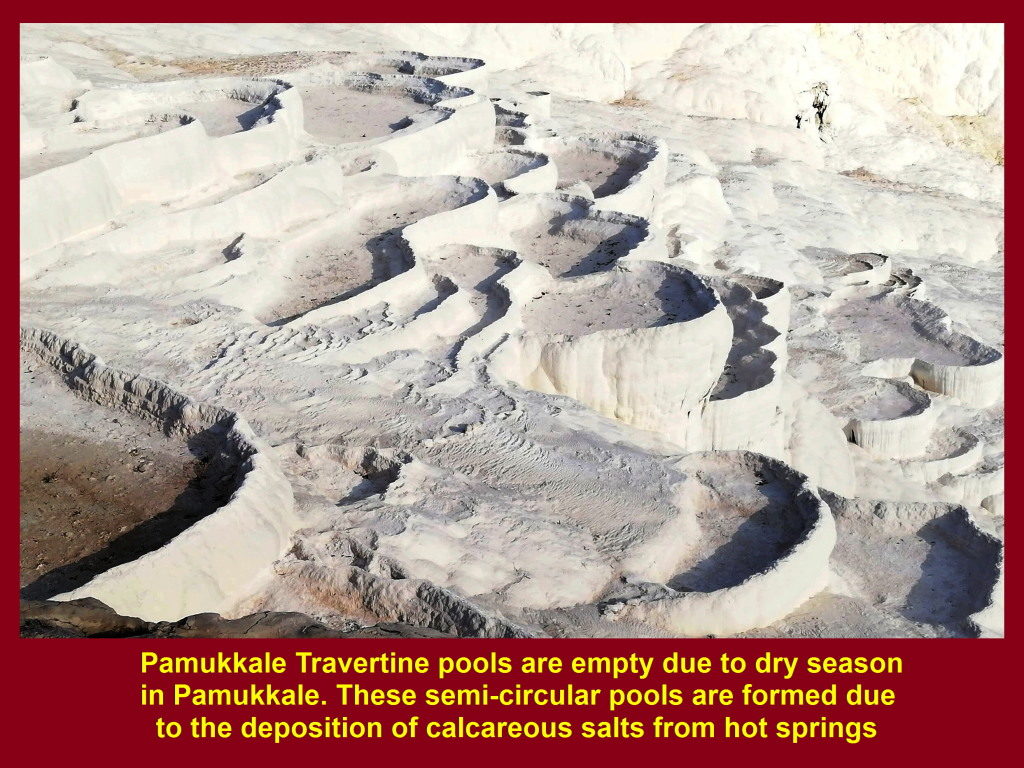
Large Pool
Water flows down the slope of the plateau and into a large pool below in Pamukkale Town.
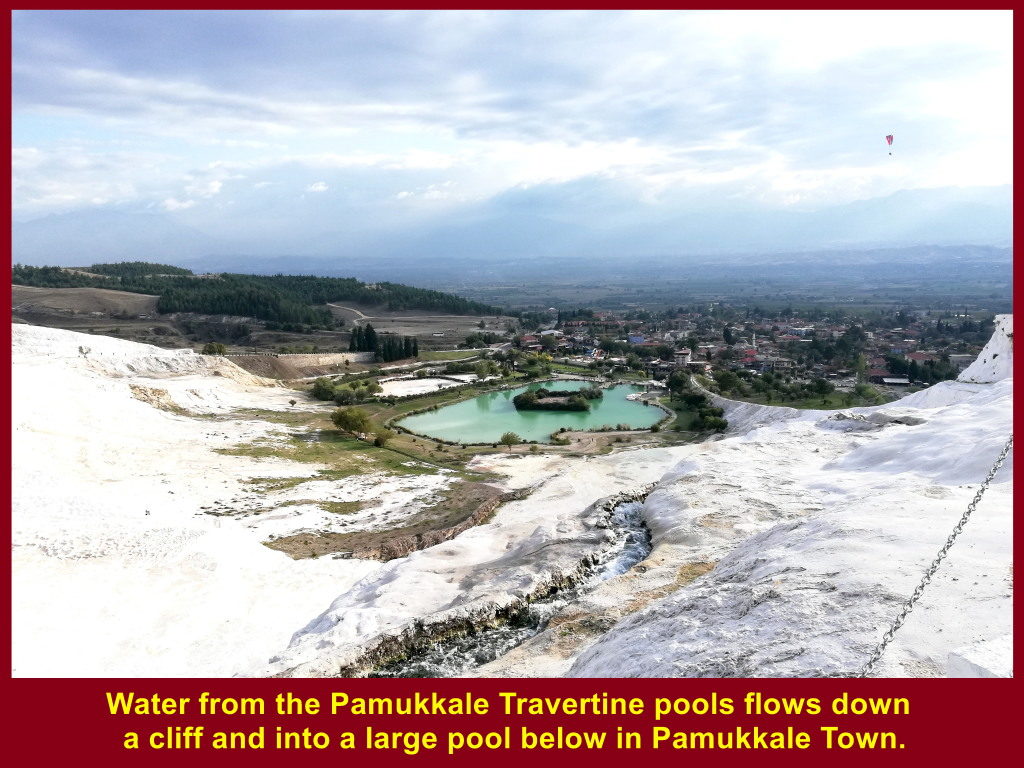
Feet Soaking in Pools
Visitors to Pamukkale Travertine had a good time soaking their feet in some pools that contained hot spring water on 16 Oct 2019.
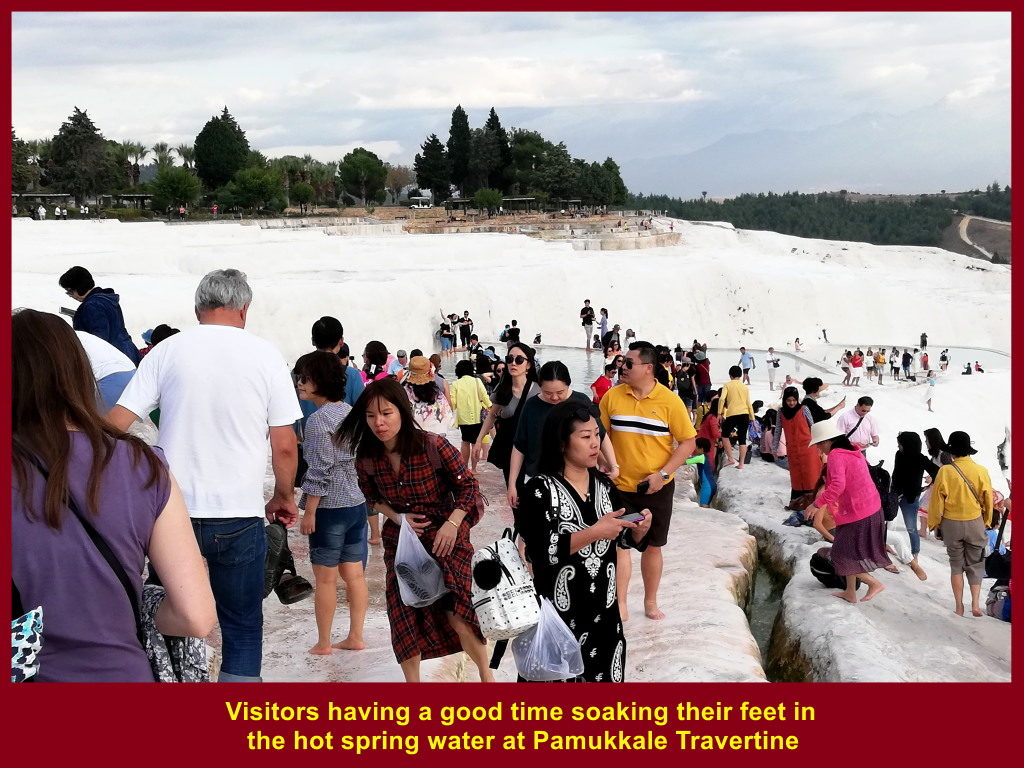
Visitors’ Shoes
They took off their shoes and left them on wooden steps before they went down to the pools that contained hot spring water.
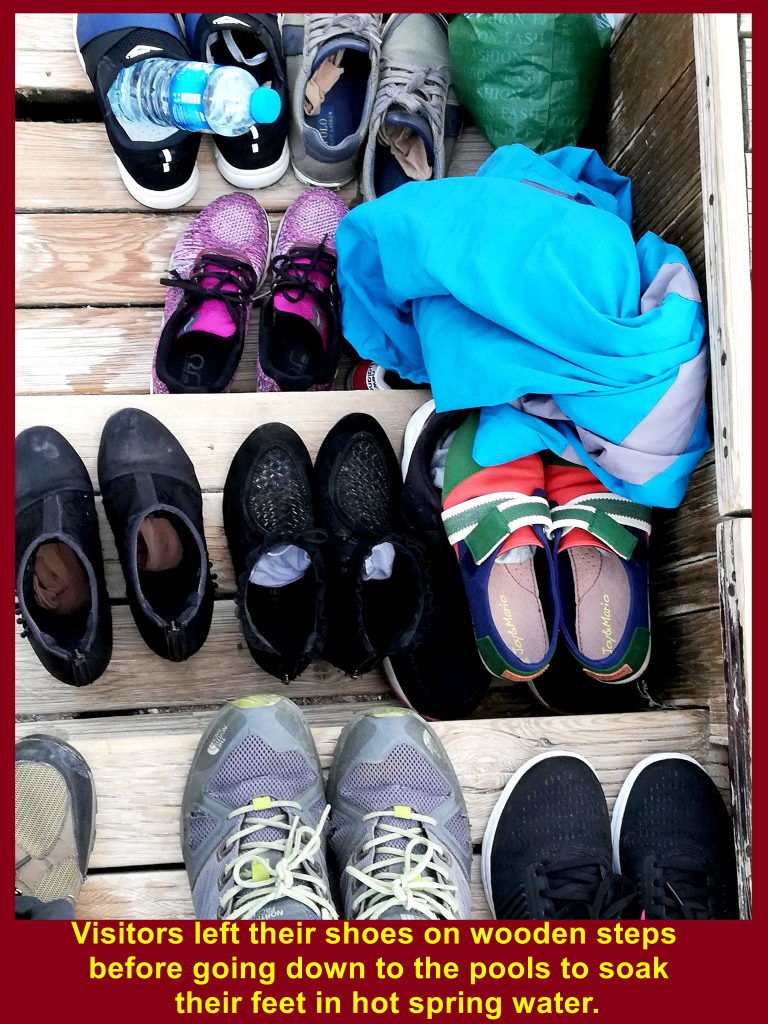
Writer and Wife Soaking Their Feet, Too
Writer and wife soaked their feet in a pool of spring water, too, but the water had turned cold on 16 Oct 2019.

Antique Pool or Cleopatra’s Pool
There is a thermal pool containing mineral-rich hot spring water near Pamukkale Travertine. It is known as Antique Pool or Cleopartra’s Pool. The water is believed to have healing properties for many ailments.
Entrance to Antique Pool near Pamukkale Travertine
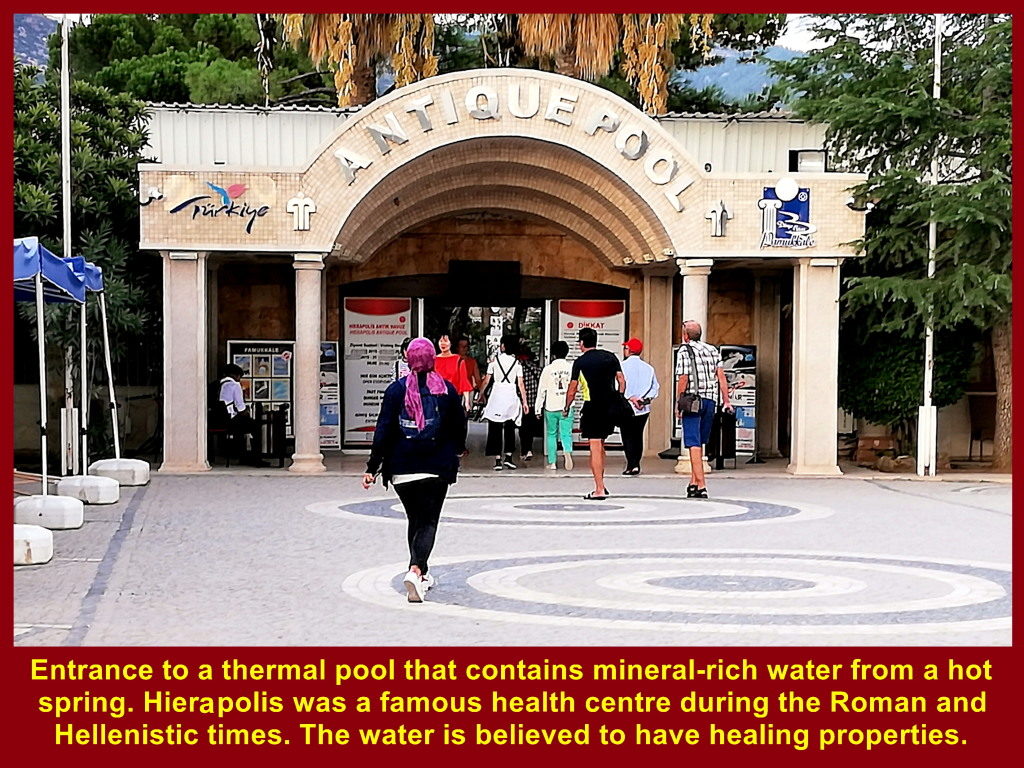
Visitors in the Pool
Visitors were enjoying themselves in the pool of hot spring water hoping that their health problems would be solved on 16 Oct 2019.
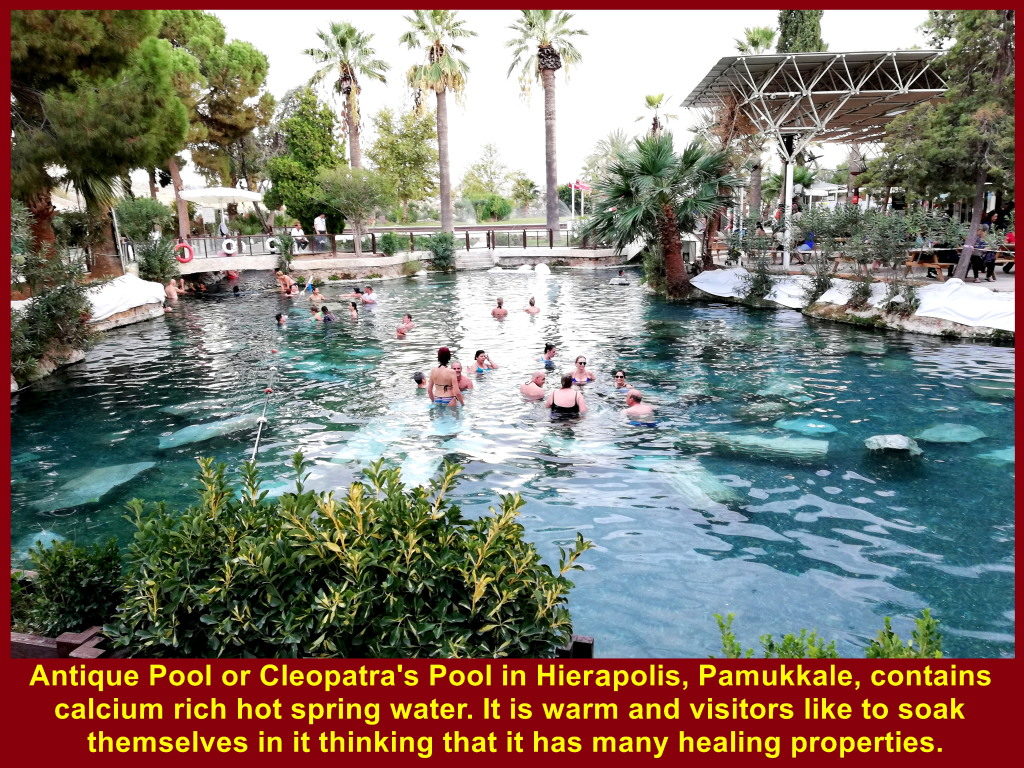
Pam Thermal Hotel
At about 6 in the evening, we left Pamukkale Travertine and went for dinner at a hotel, Pam Thermal Hotel, in Pamukkale Town. Later, we stayed a night at the hotel on 16 Oct 2019.
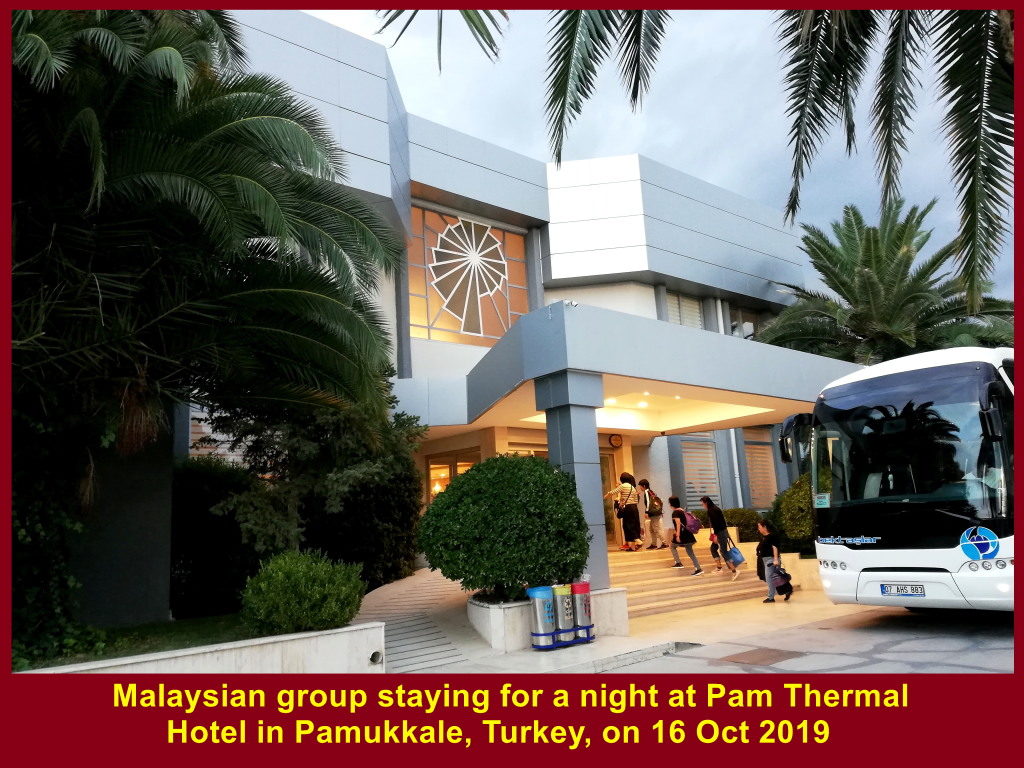
Cold and Hot Spring Water Pools
This hotel has a cold and hot spring water pools at the back for guests to enjoy.
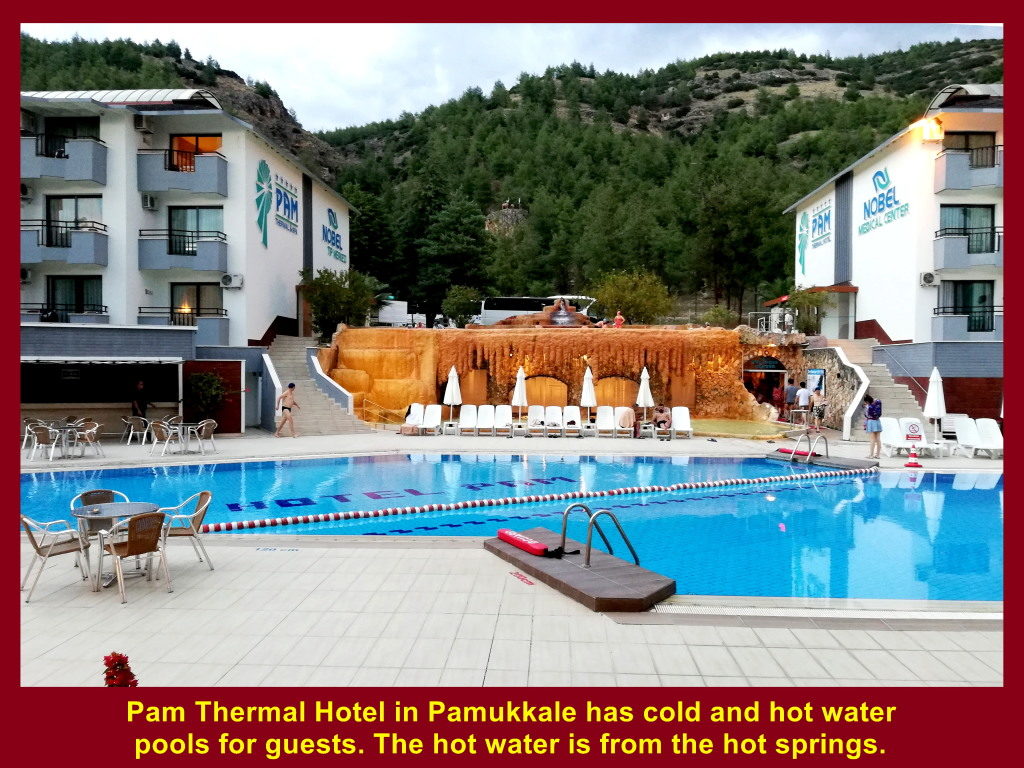
Previous Page / Home / Next Page
Places visited during Turkey Tour(13-22 Oct 2019):
Trojan Horse/Ancient Troy Cities Asklepion Ephesus Hierapolis/Pamukkale Travertine Sultanhani Caravanserai Pasabag Valley Uchisar Valley/Kaymakli Underground City Gerome Valley/Turkish Night Show Hot Air Balloon/Lake Golu/Anitkabir Hagia Sophia/Topkapi Palace/Blue Mosque Bosphorus Boat Cruise Spice Bazaar/Grand Bazaar
Turkey Travel Part V: Sultanhani Caravanserai
Day 5
Thursday, 17 Oct 2019
Journey to Cappadocia or Kapadokya
In the morning on 17 Oct 2019, we left Pam Thermal Hotel in Pamukkale and made a long journey to Cappadocia or Kapadokya which is 506 km east of Pamukkale..
Journey from Pamukkale to Cappadocia by road will take about 8 hours.
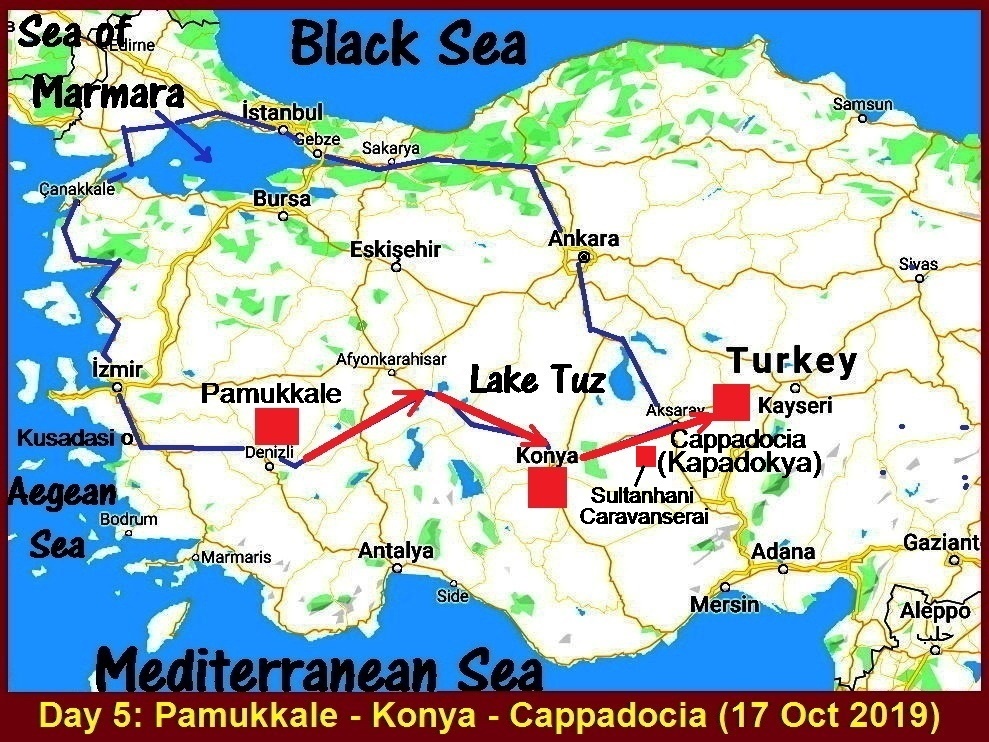
Textile Shop
On the way, we stopped at a textile shop nearby to see cotton-products, like shirts, jackets, towels, pillow-cases, etc.
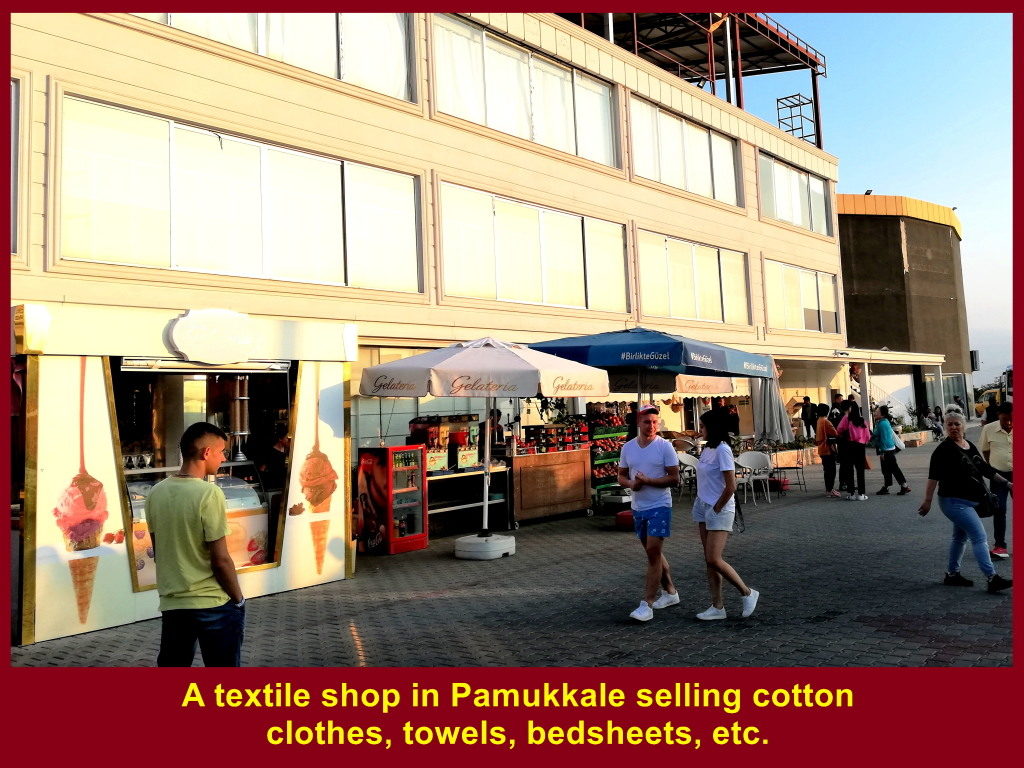
Shirts
Long sleeved shirts made of cotton were for sale at the shop.

Warm Vests
Warm vests made of cotton were for sale at the shop.

Shirts of all Sizes
Cotton shirts were for sale at the shop

Pillows and Comforters
Cotton pillows and comforters were for sale at the shop

Women in Cotton Field
A picture in the shop shows women picking cotton in a field.

Yarn or Thread
Cotton is first spun into yarn or thread, and then made into products of cotton for sale.
Continuing the Journey to Cappadocia
After an hour at the cotton-product shop, we left and continued our journey to Cappadocia or Kapadokya at 9.00 a.m.
Morning Tea
At 10 a.m. we stopped at a cafe, Anatolia, for refreshment. It was located between Pamukkale and Aksehir in Turkey.
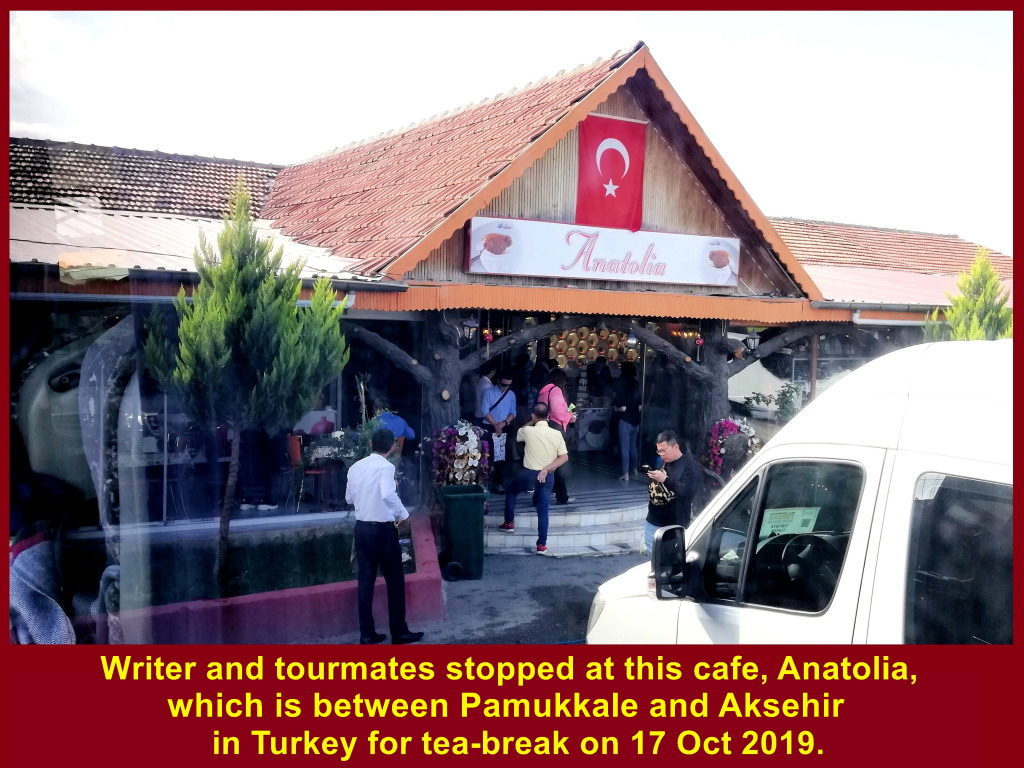
Pomegranate Juice
A hawker at the cafe was selling fresh pomegranate juice. He handed a glass of the drink to my wife who had asked for it. She paid him 10 TL for the reddish drink.
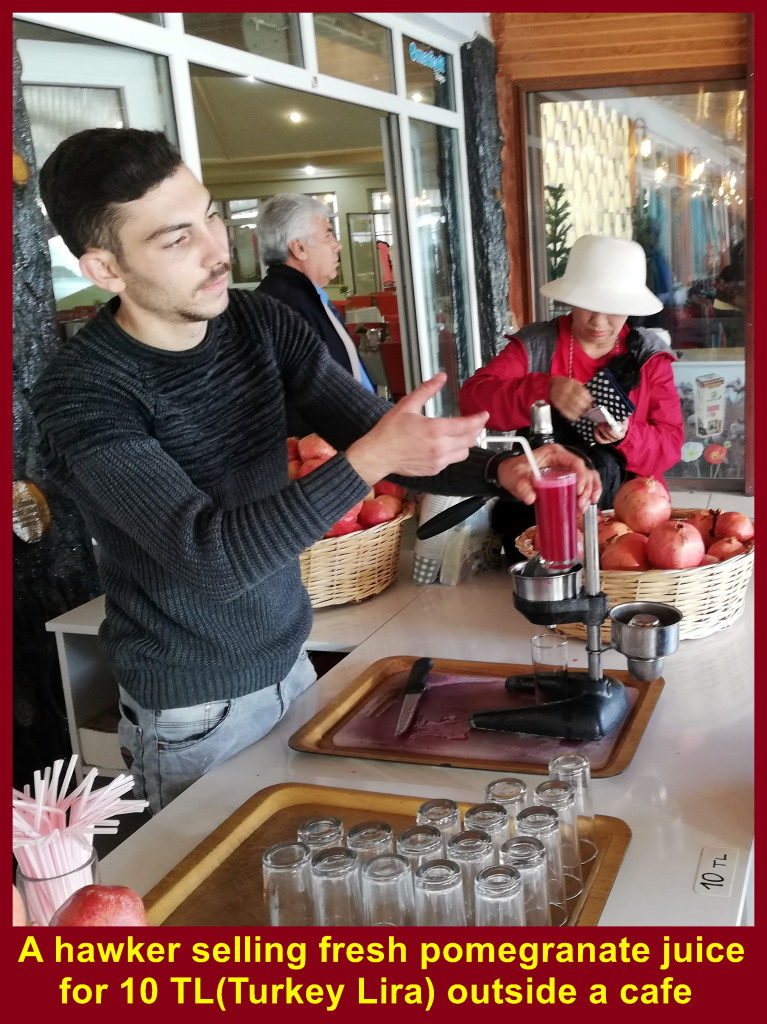
Pomegranate Fruits
Pomegranate fruits grow very well in many areas of Turkey and are used for making sauce and juice for sale, and eaten as dessert, too.
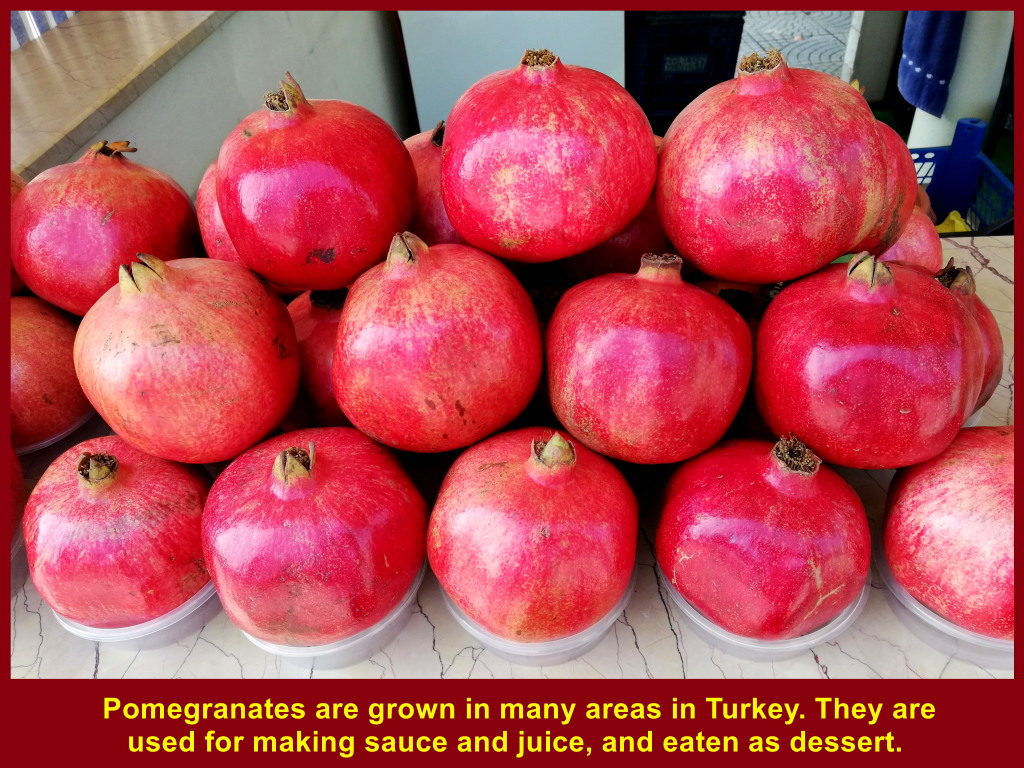
Cream with Poppy Seeds
Another hawker at the cafe was making cream with poppy seeds.
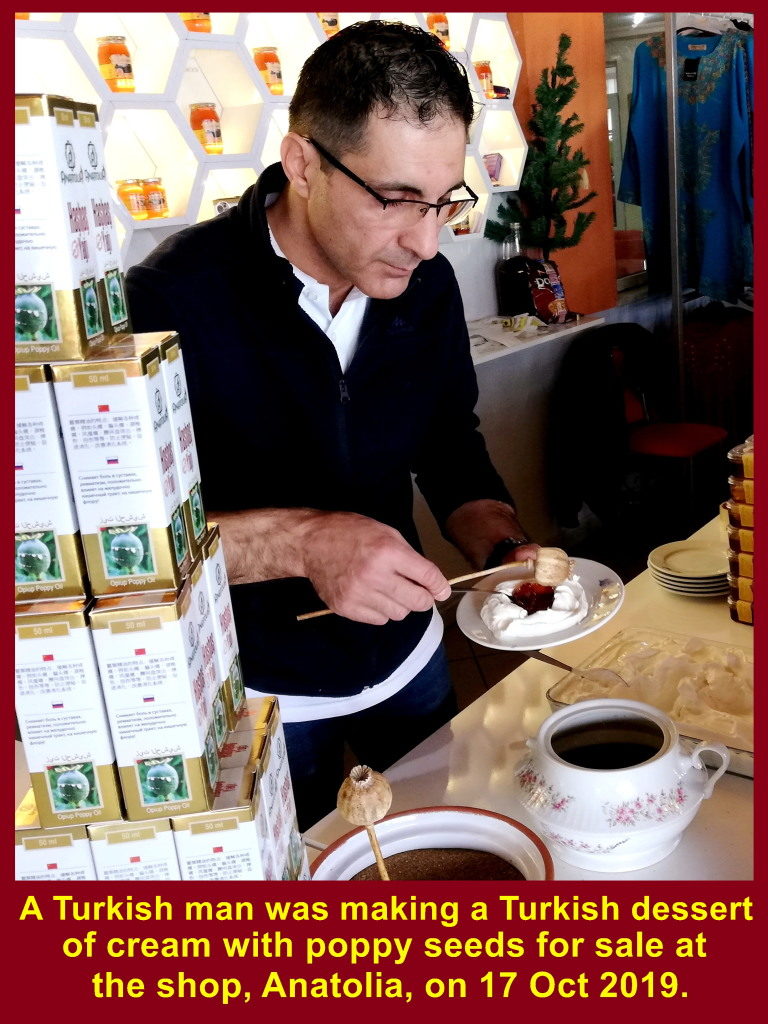
He was selling the cream for 10 TL a plate.
Having refreshed ourselves at Anatolia Cafe, we continued our journey to Cappadocia or Kapadokya.
Lunch Time
At 12.30 p.m. we stopped at Ozkan Restaurant in Aksehir near Konya to have lunch.
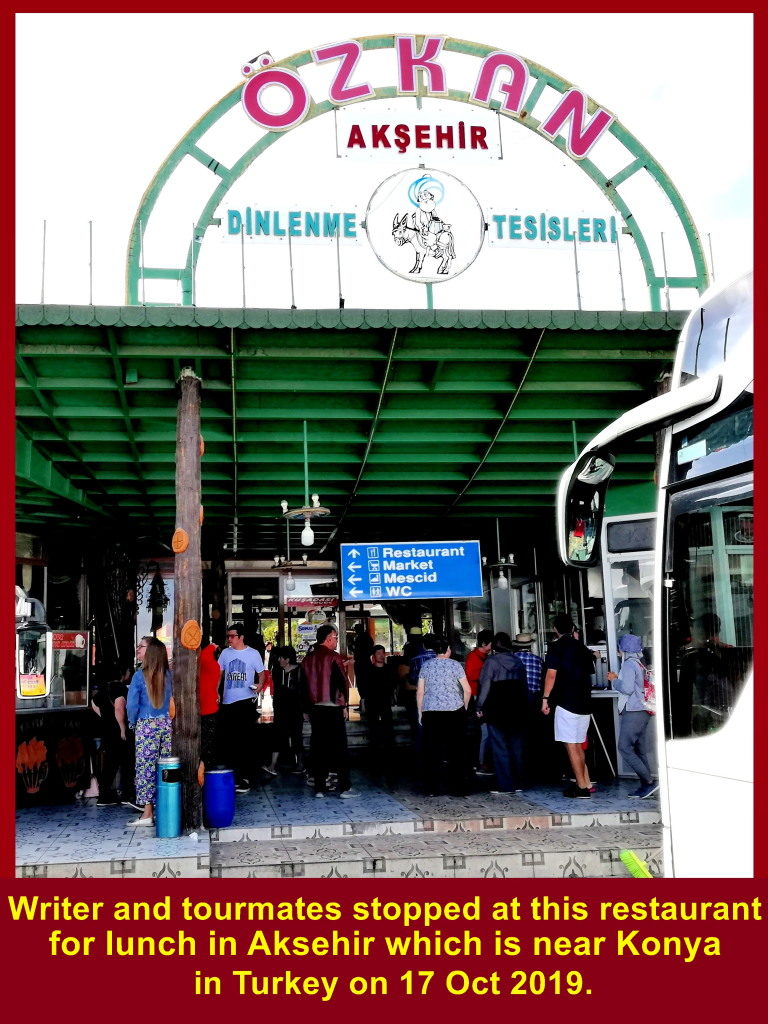
Writer’s Lunch
Writer’s lunch at Ozkan Restaurant in Aksehir near Konya
Soon we left the restaurant in Aksehir and were on our way again to Cappadocia or Kapadokya.
Sultanhani Caravanserai
At 4 p.m. we stopped at a place to see a monumental building. It is located between Konya and Aksaray. Built in 1229, it is a caravanserai, roadside inn, built for travellers on long journey to rest in the olden days.
Known as Sultanhani Caravanserai, it looks like a strong fortress with high and thick walls to prevent attacks from bandits in the olden days. It was under restoration when we visited the building.
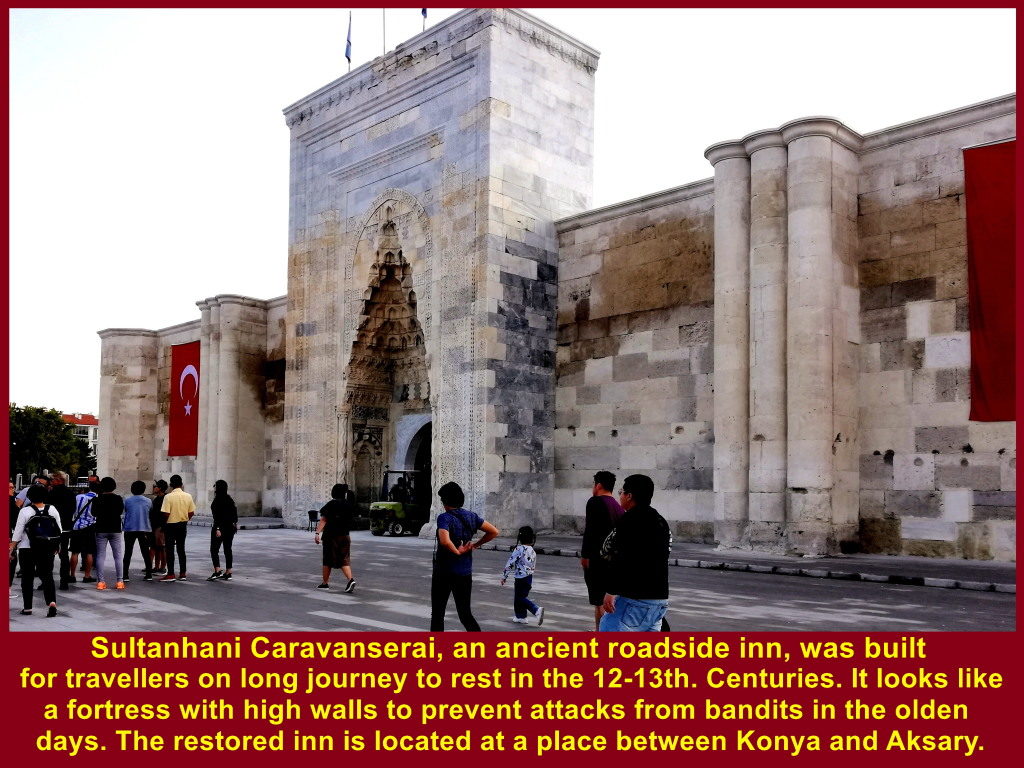
Main Gate
The main gate of Sultanhani Caravanserai looked beautiful and majestic.

Courtyard
The building has a courtyard surrounded by rooms, kitchens and stables, and a small mosque in the centre for travellers to pray in the olden days.
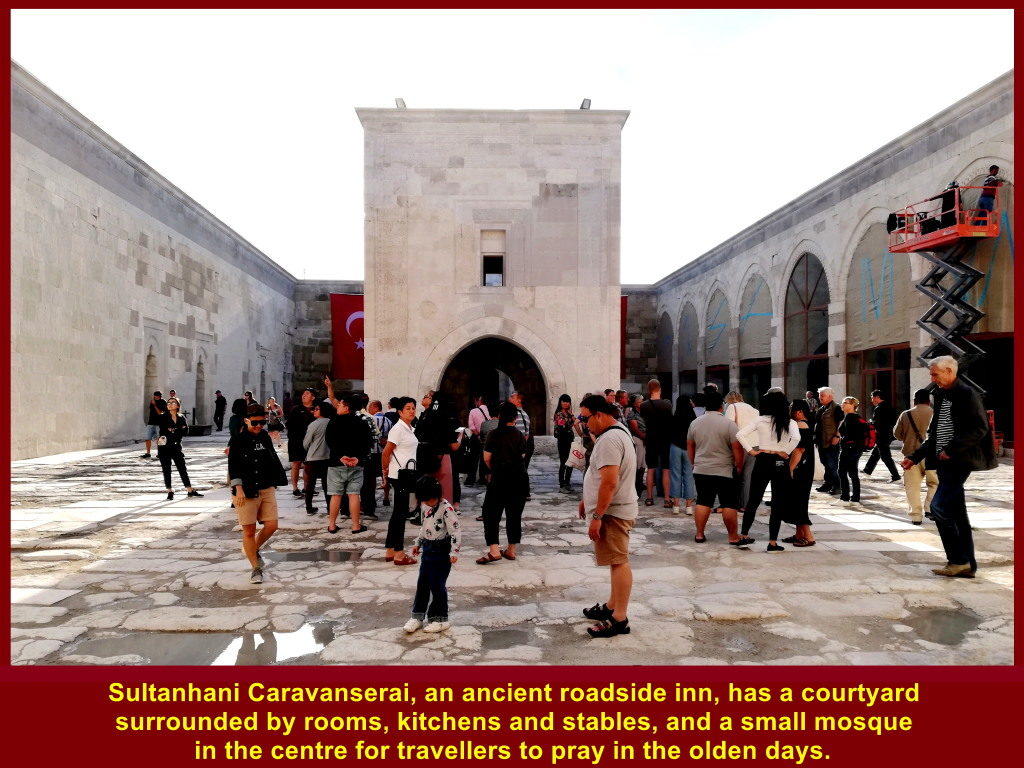
Back Gate
A gate at the back of the courtyard is an entrance into a large hall with massive vaults supporting a large, heavy roof.
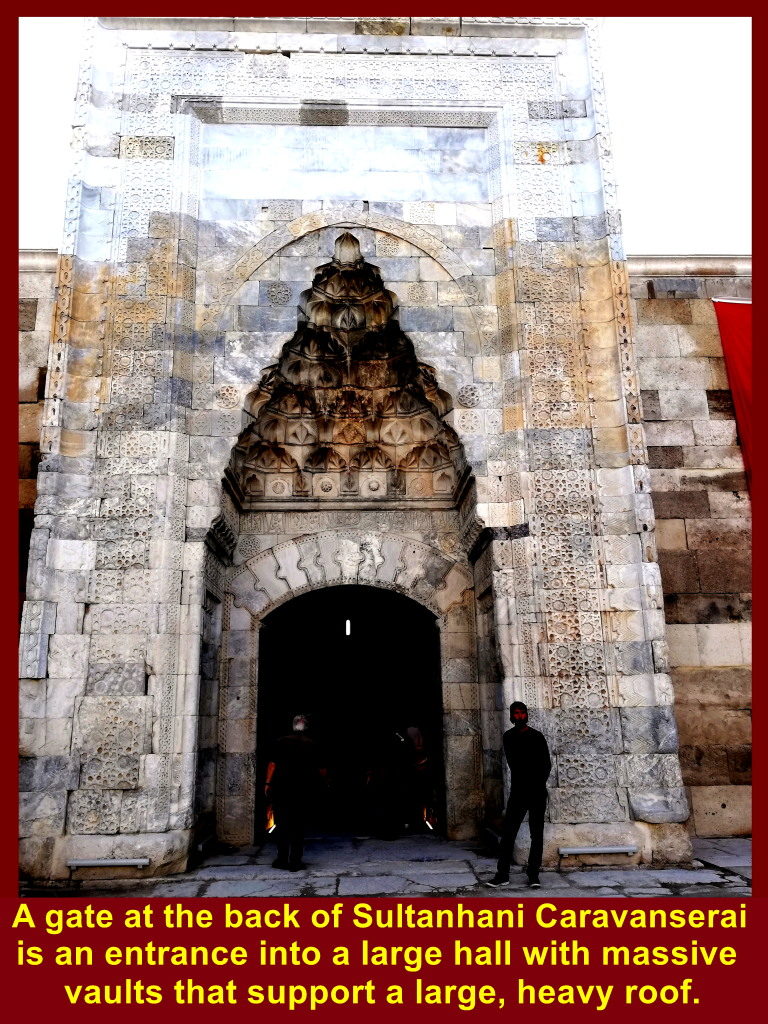
Large Hall
A large hall at the back of Sultanhani Caravanserai has massive vaults supporting a large and heavy roof.
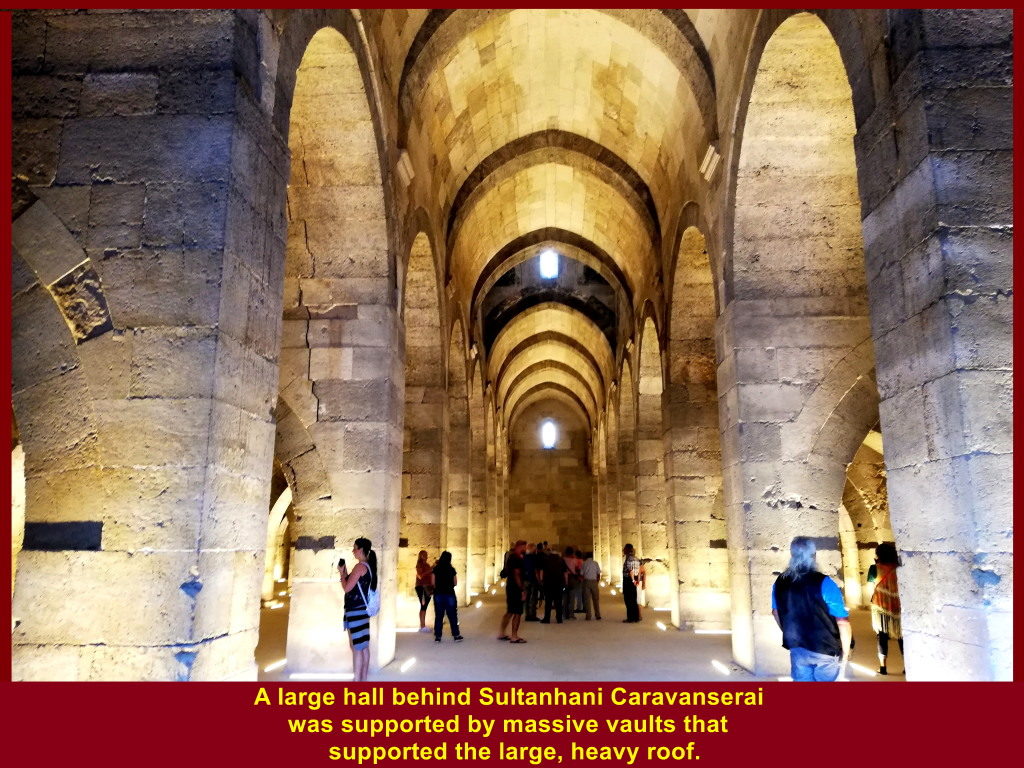
A 5 p.m. we left Sultanhani Caravanserai and were on our way again to Cappadocia. Two hours later, we reached a hotel, Dilek Kaya Hotel, in Ortahisar, Cappadocia, at 6.30 p.m,
Dilek Kaya Hotel
It is located near many places of interest, like underground cities, places of landscapes of rocks that shape like rocks and “Fairy Chimneys”, etc.
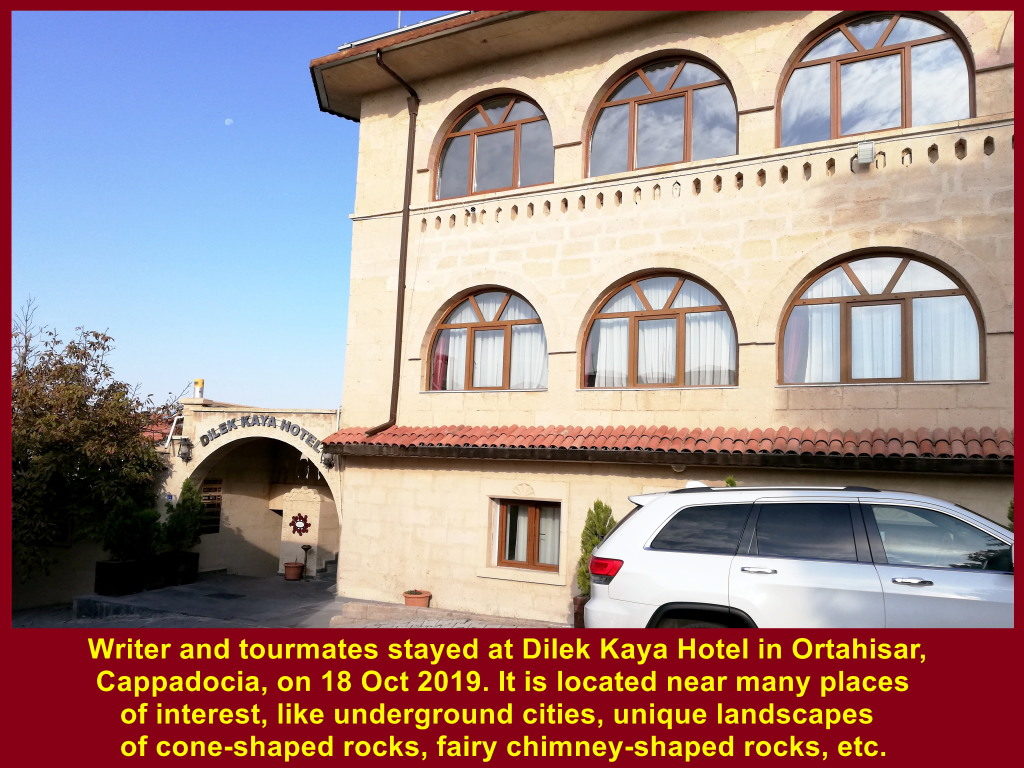
Hotel Guest-Rooms
Writer and tourmates stayed for two days in guest-rooms in Dilek Kaya Hotel, Ortahisar, Cappadocia.
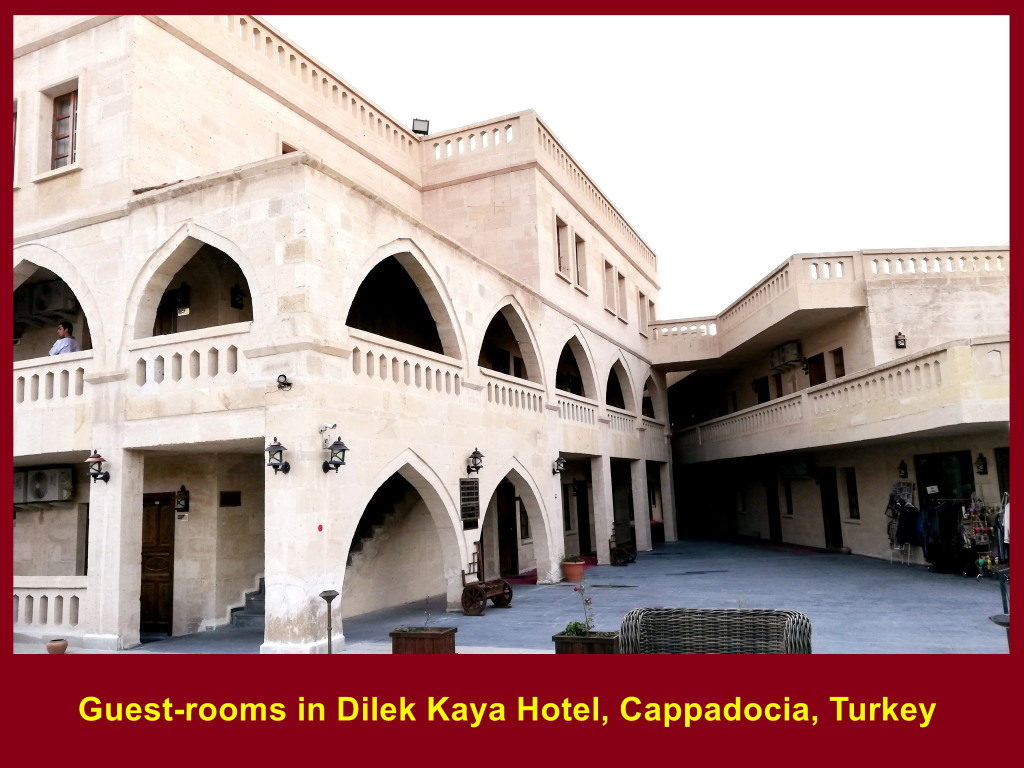
Places visited during Turkey Tour(13-22 Oct 2019):
Trojan Horse/Ancient Troy Cities Asklepion Ephesus Hierapolis/Pamukkale Travertine Sultanhani Caravanserai Pasabag Valley Uchisar Valley/Kaymakli Underground City Gerome Valley/Turkish Night Show Hot Air Balloon/Lake Golu/Anitkabir Hagia Sophia/Topkapi Palace/Blue Mosque Bosphorus Boat Cruise Spice Bazaar/Grand Bazaar
Turkey Travel Part VI: Pasabag Valley
Day 6
Friday, 18 Oct 2019
Cappadocia or Kapadokya
Writer and tourmates stayed in Cappadocia or Kapadokya for two days from 18-19 Oct 2019 as there were many places of interest in the vicinity to visit.
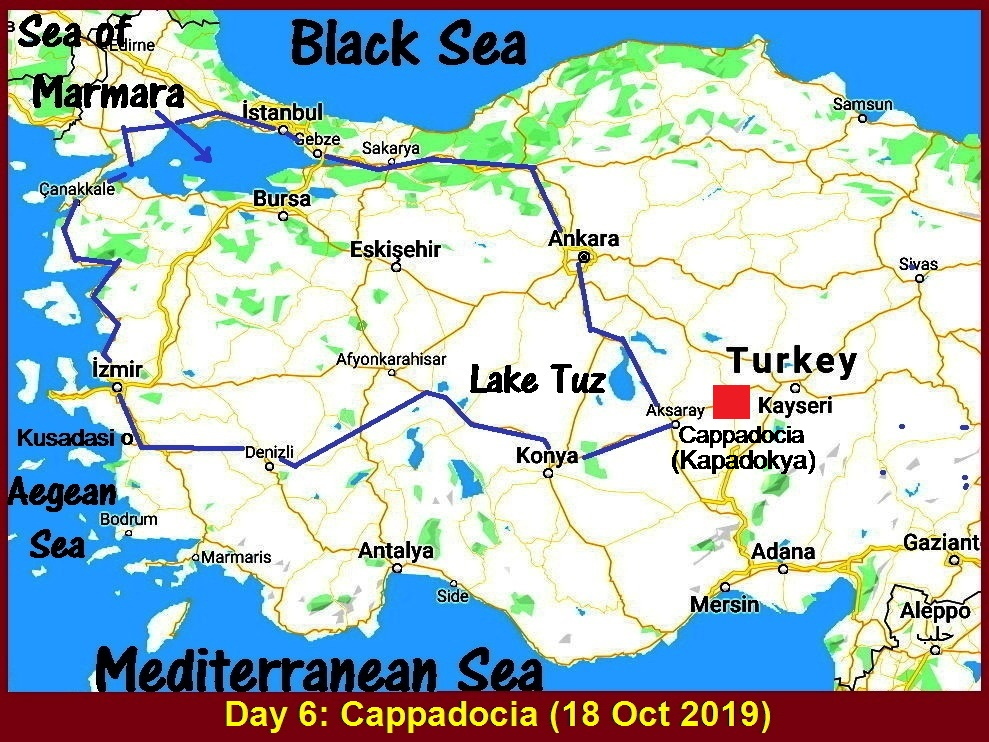
Large Rock with a Door
In the bright morning of 18 Oct 2019, I was surprised to see a large rock that had a door located behind the hotel, Dilek Kaya Hotel, in Ortahisar, Cappadocia. Somebody might have lived in the rock before. We were going to see more abandoned rock-settlements in other places in Cappadocia.
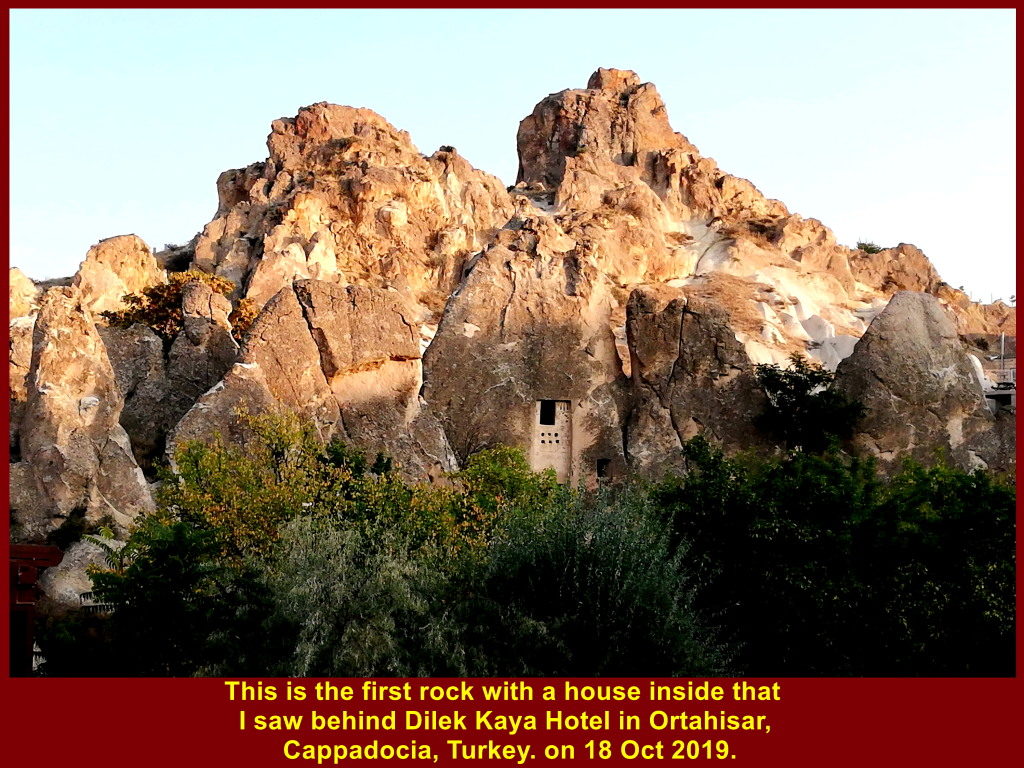
Visiting Places in Cappadocia
After breakfast, we left the hotel, Dilek Kaya Hotel, and went to visit a few places of interest in Cappadocia on 18 Oct 2019.
Pasabag Valley
The first place we visited on that day was Pasabag Valley or Monks’ Valley. It is a place where rocks that look like “Fairy Chimney” are located. With a little bit of imagination, we are fascinated that some of them look like camels, seals, human beings, mushrooms or other living things.
Map showing four areas in Cappadocia, Turkey, we would visit on 18 Oct 2019: Pasabag Valley, Uchisar Valley, Kaymakli Underground City and Goreme Valley

Writer and wife visited Pasabag Valley of Monks’ Valley on 18 Oct 2019.
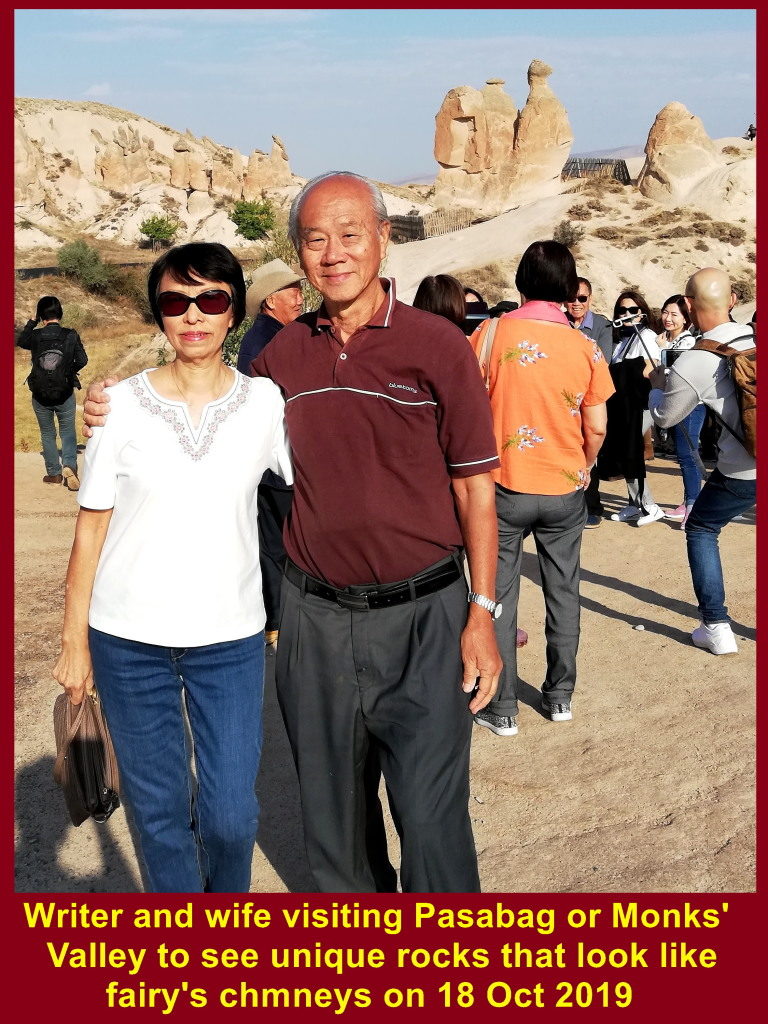
Christian Settlement
In the olden days, Pasabag Valley was a place where Christian monks lived as hermits and local people gave them food all the time.
The monks were living in holes they dug into the rocks, as shown in the photo below.
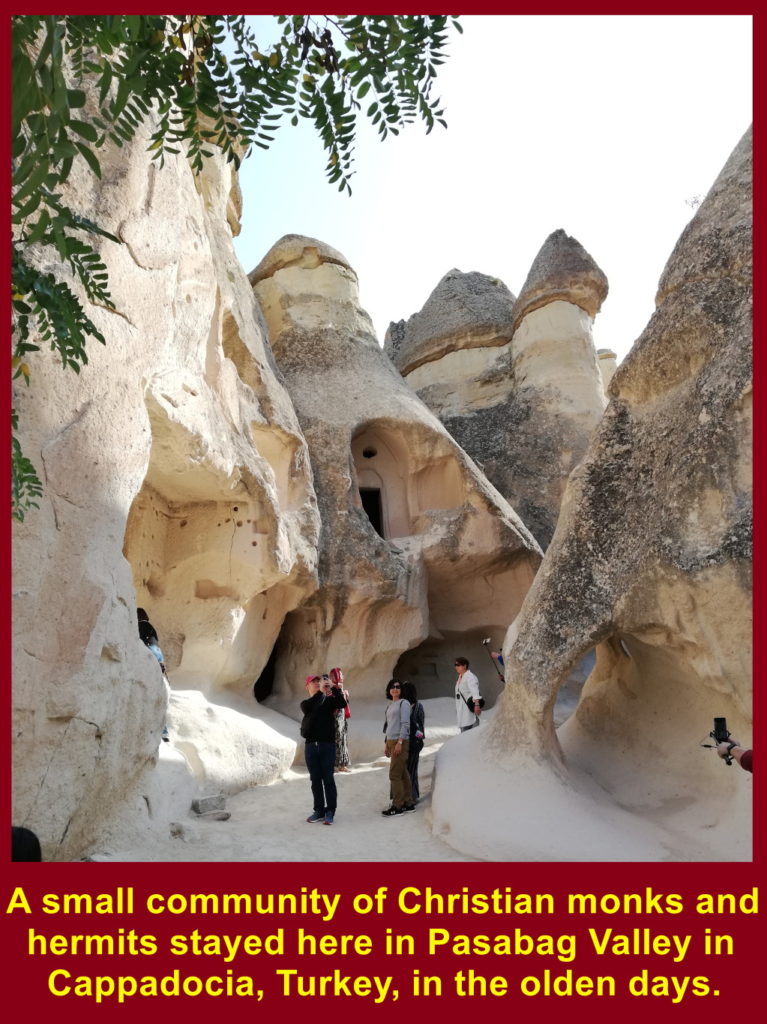
Writer and wife together with tourmates visited an abandoned dwelling of Christian monks and hermits on 18 Oct 2019.
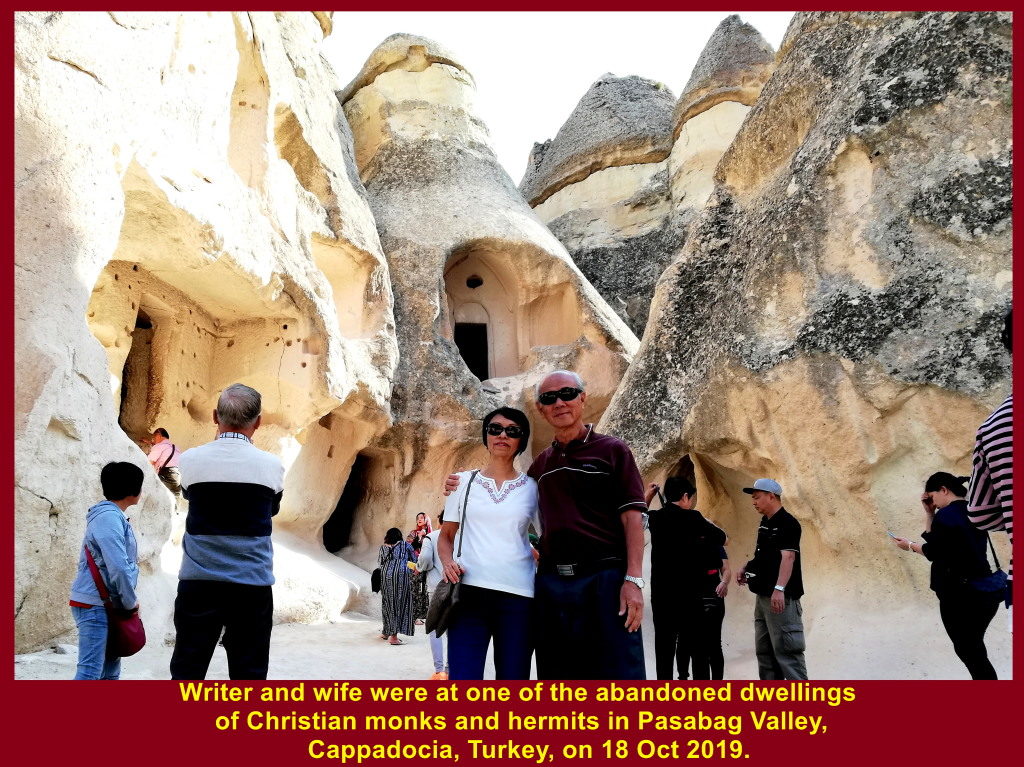
Rocks that look like cones and “Fairy Chimney” are many in Pasabag Valley.
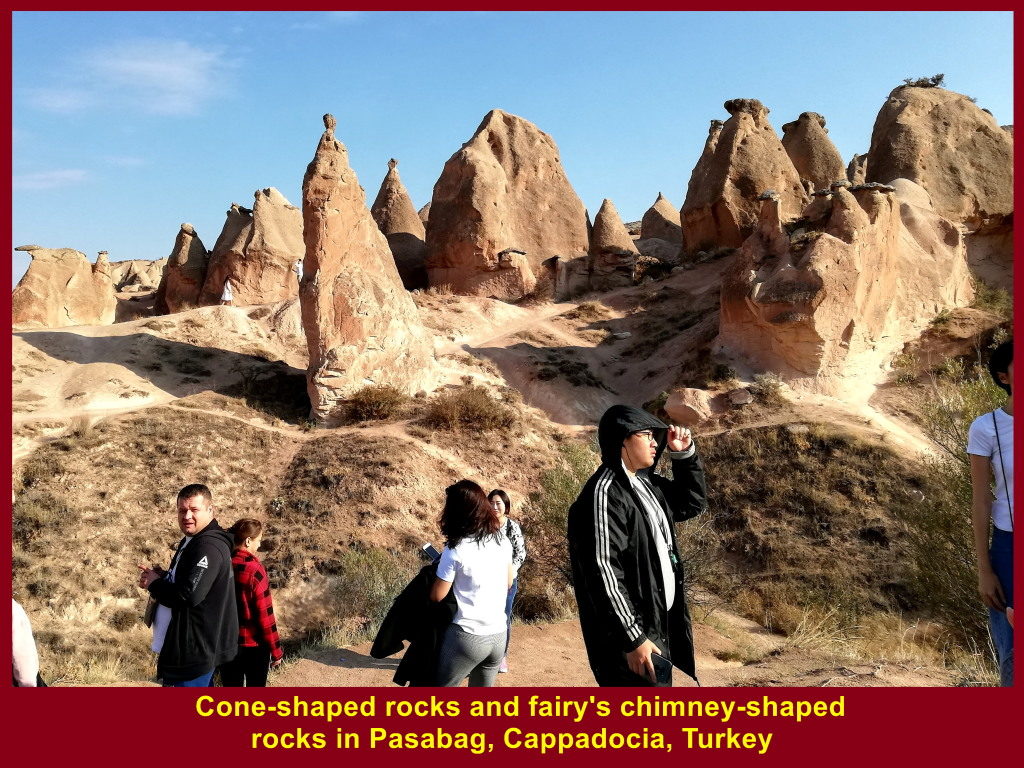
Rocks in Pasabag Valley
(i) We were quite fascinated by a large rock that looked like a camel in Pasabag Valley, Cappadocia.
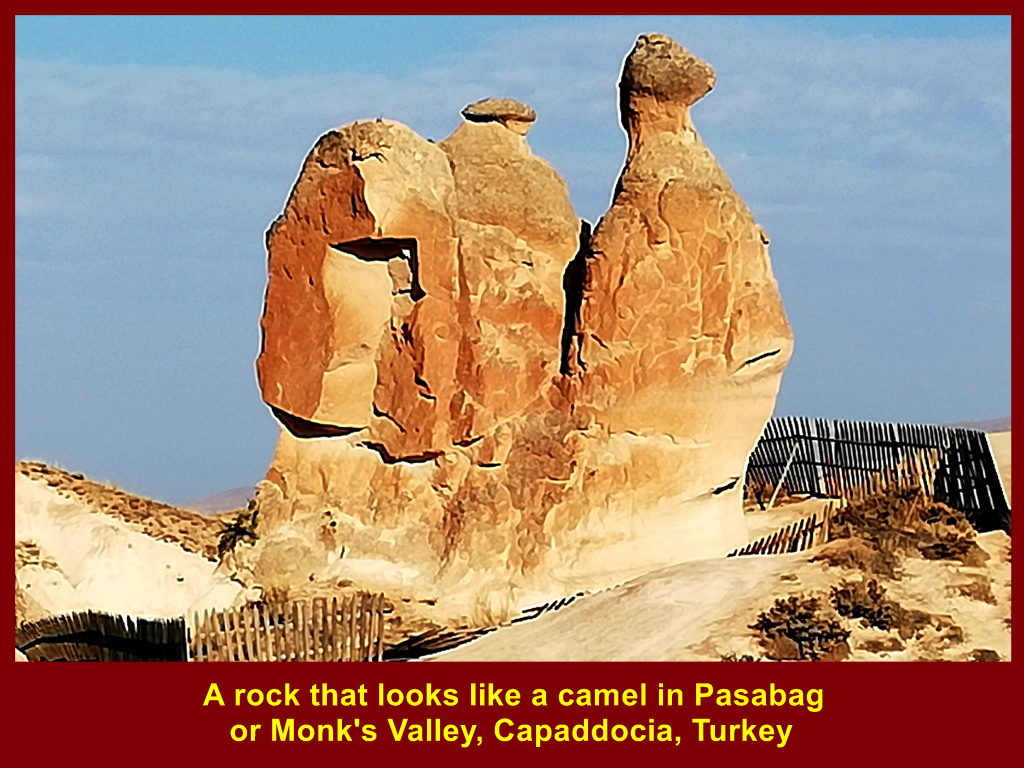
(ii) We also saw rocks that looked like a family of seals in Pasabag Valley.
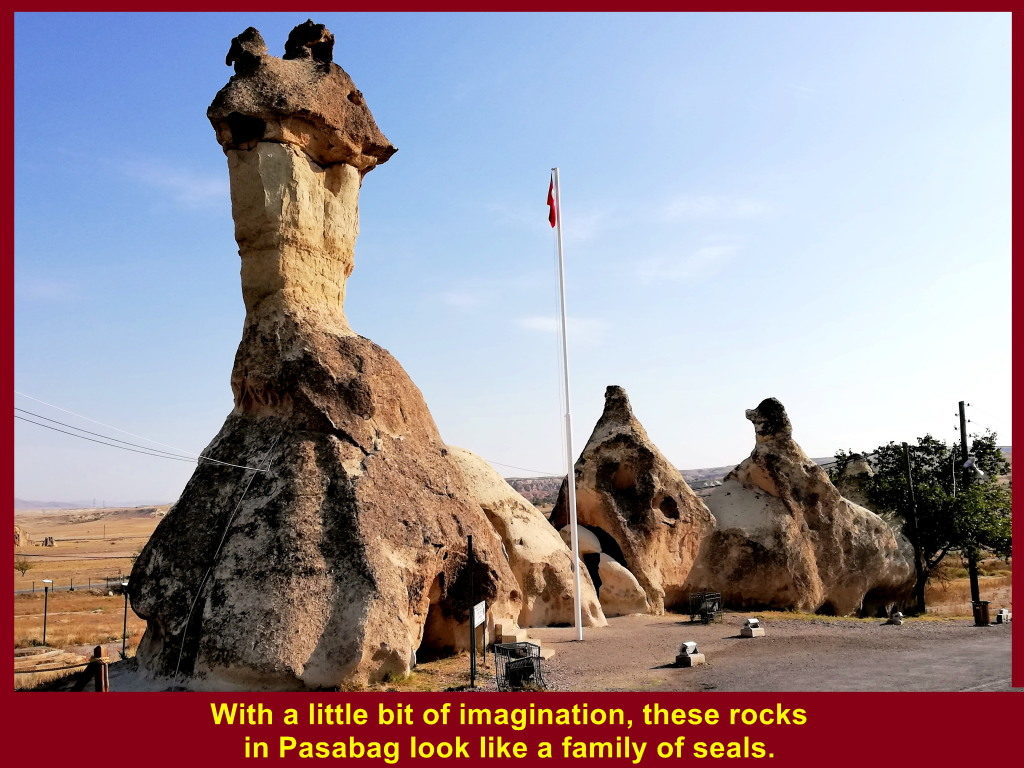
(iii) Rocks that looked like a family of king, queen and prince were also noticed.
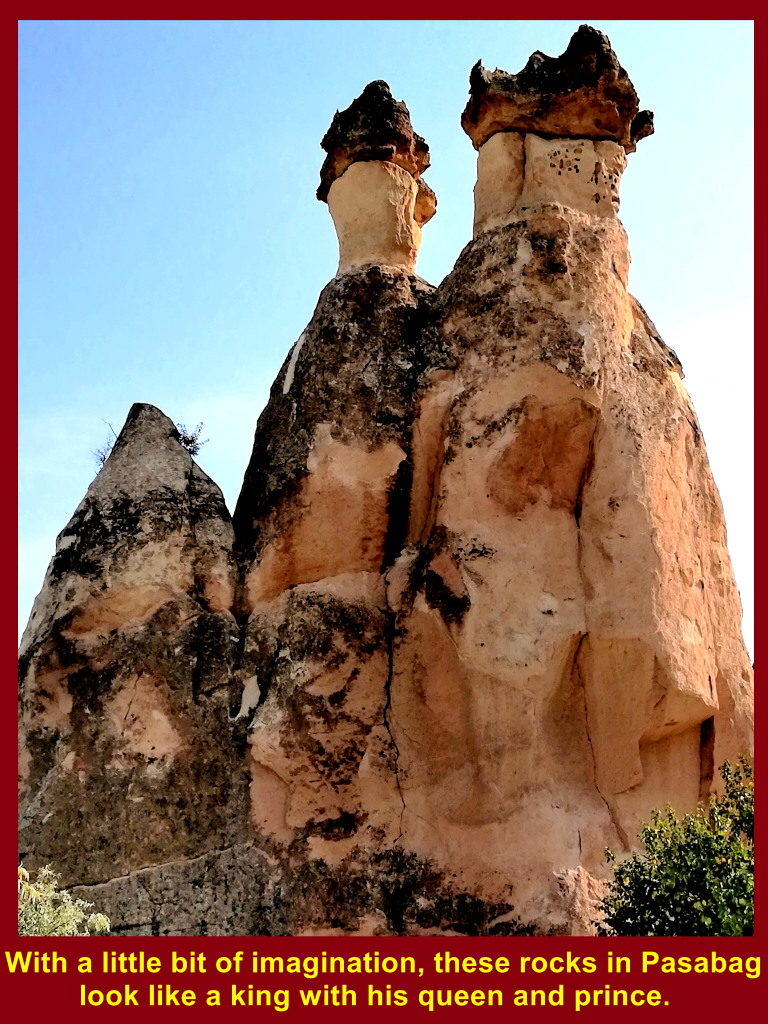
(iv) Rocks that looked like the three famous US comedy actors, “The Three Stooges”, surprised me.
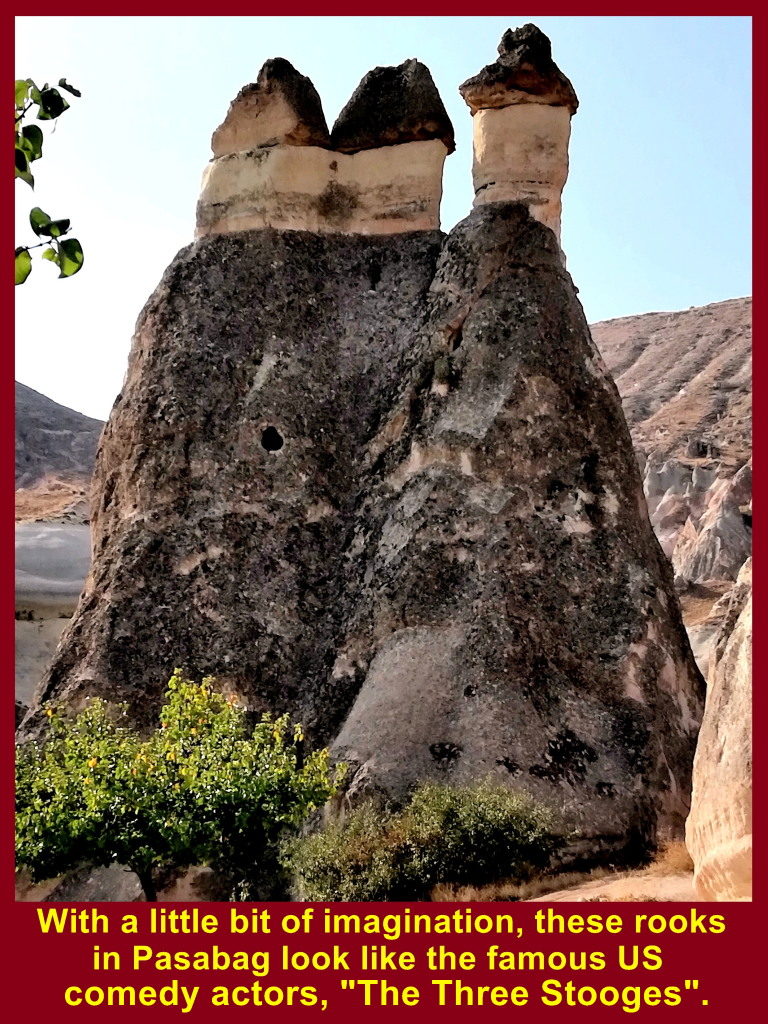
(v) There was a single rock that looked like a thin, tall man wearing a cone-shaped hat.

(vi) “The Three Sisters” in the photo below reminded me of “The Three Sisters” I saw in the Blue Mountains in Australia in 2004.
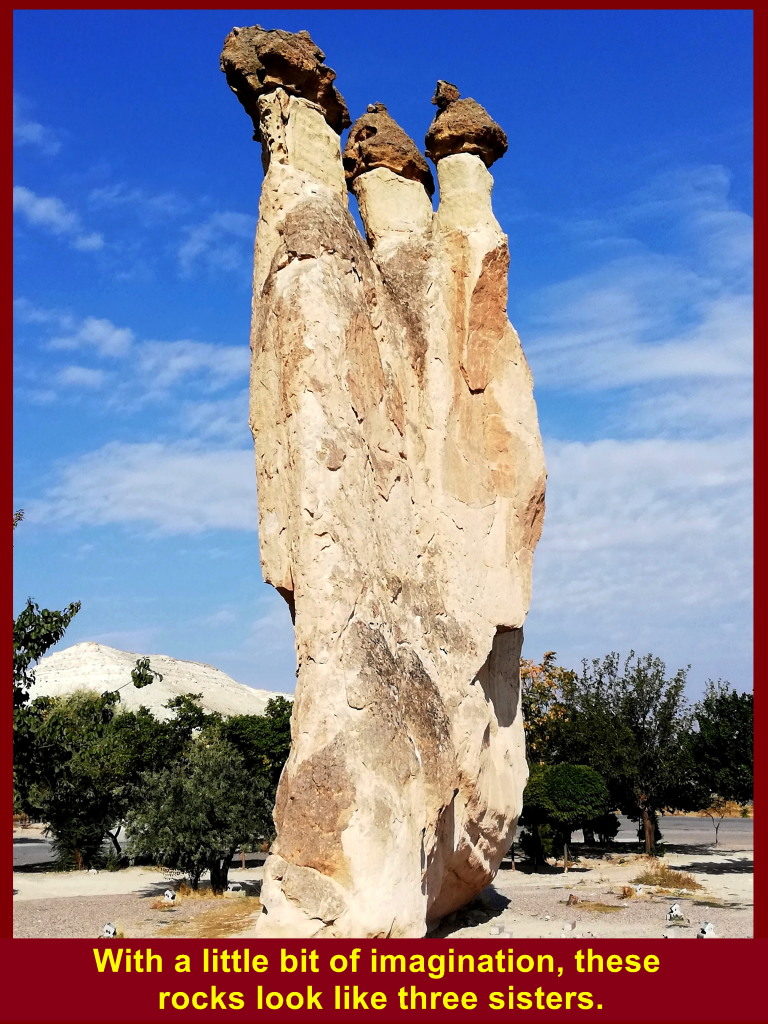
(vii) Rocks that looked like a cluster of fat mushrooms in Pasabag Valley.
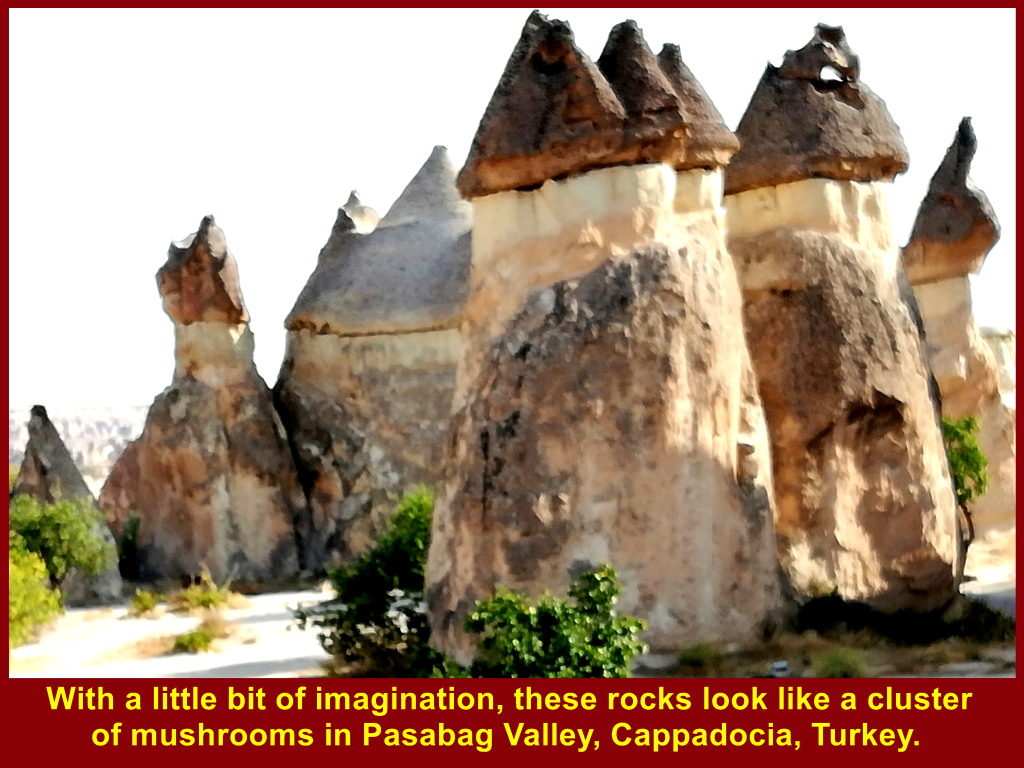
Jewellery Shop
Having seen enough of the rocks of many forms and shapes in Pasabag or Monks’ Valley, we went to a Cappadocia jewellery shop.
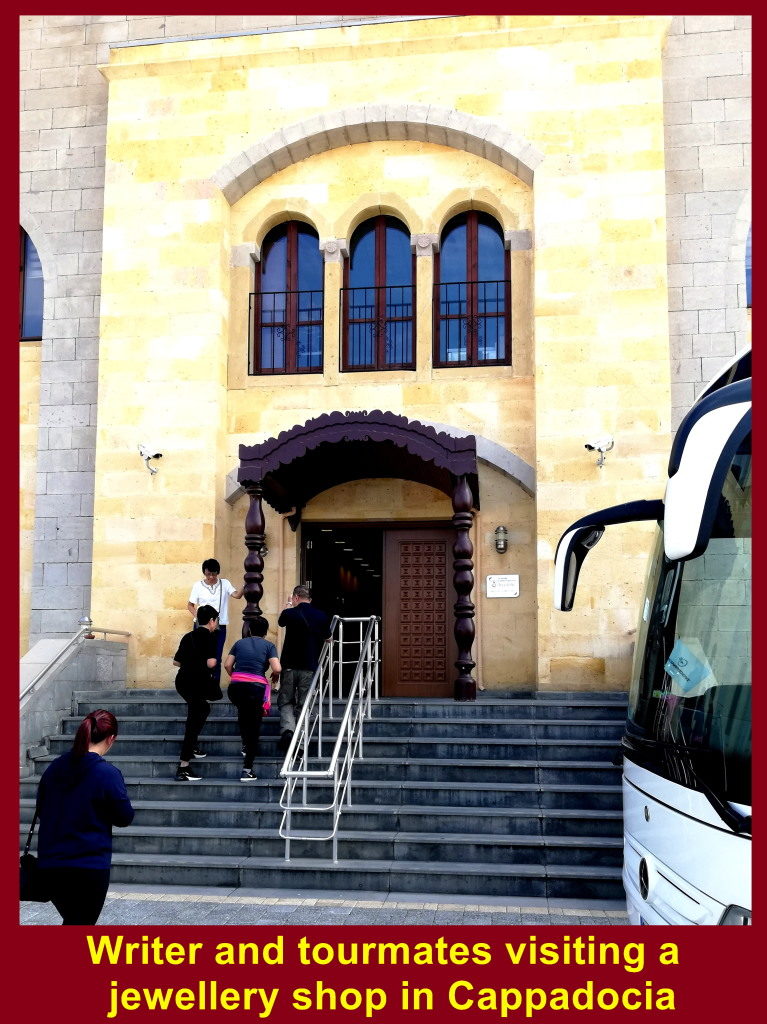
We saw pendants and rings with turquoise for sale at the shop.
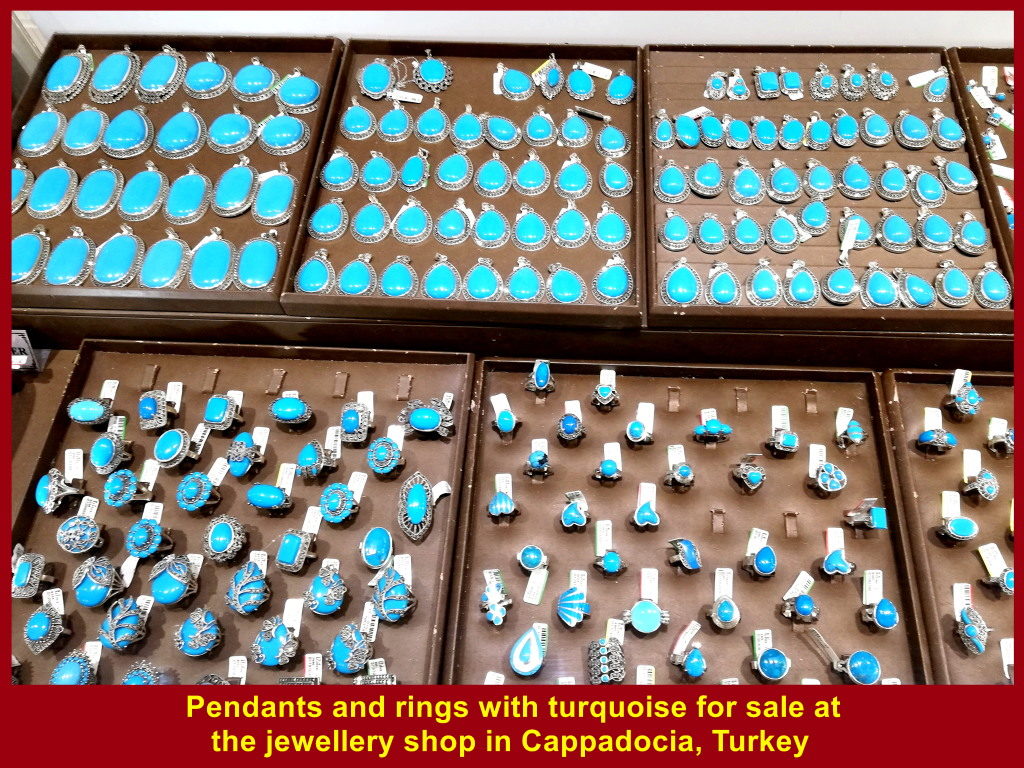
Besides, jewellery with different kinds of gemstones were for sale at the shop.
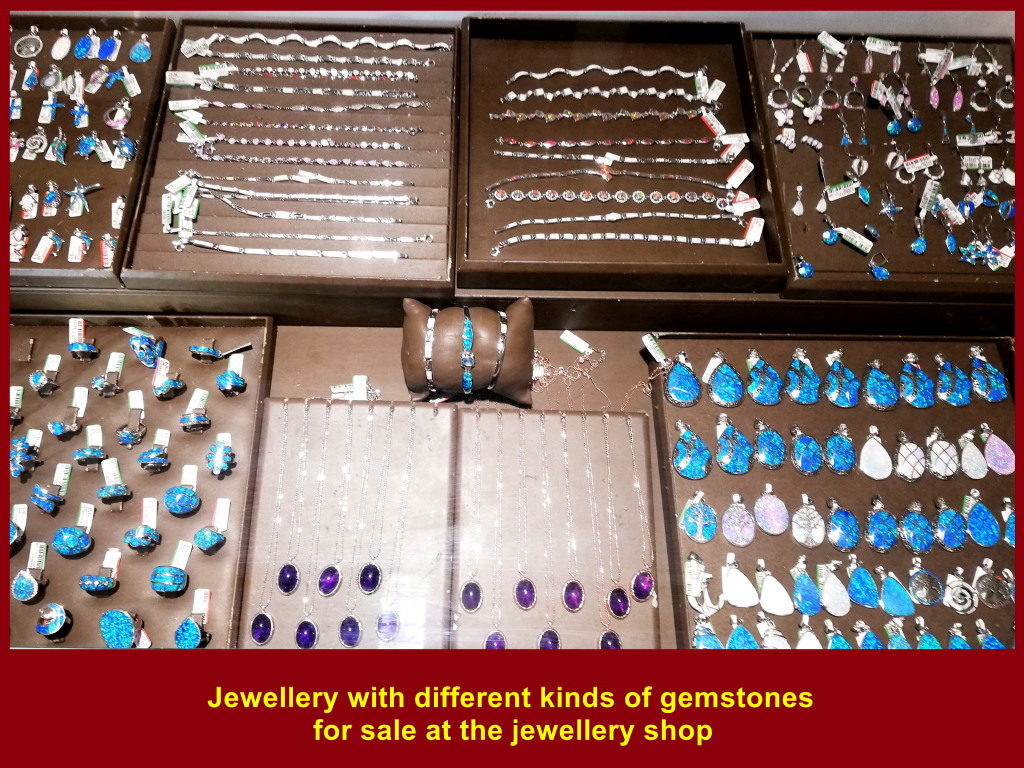
More jewellery with different coloured gemstones were for sale at the shop, too.
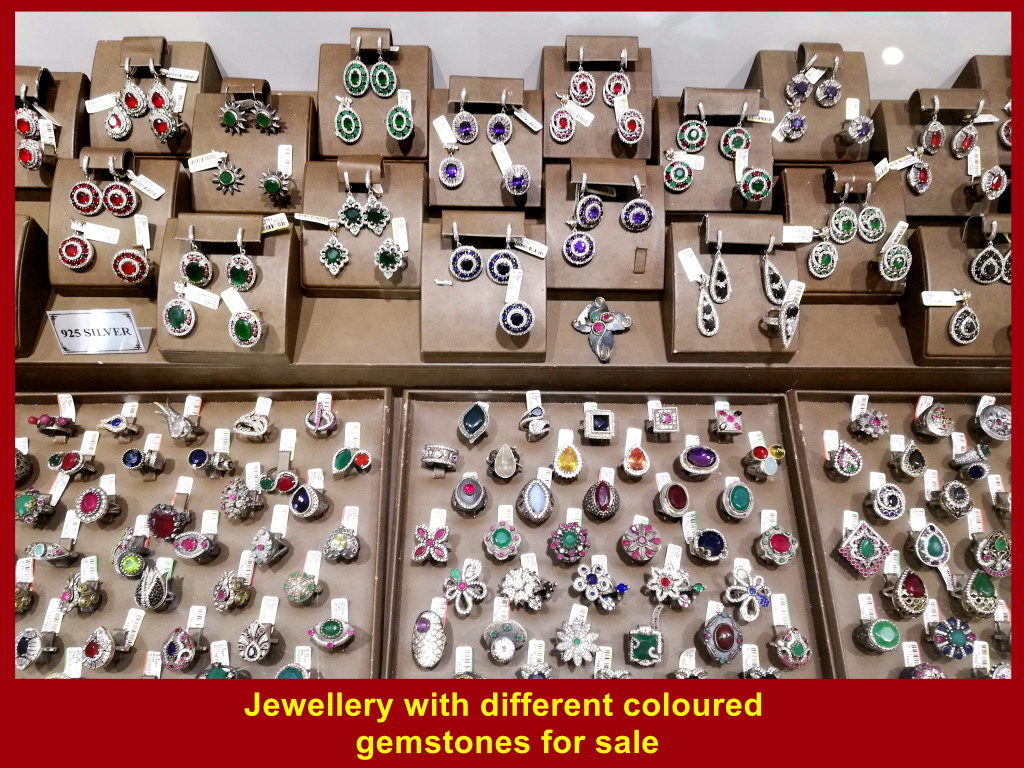
There was a display of uncut gemstones of different kinds at the shop.
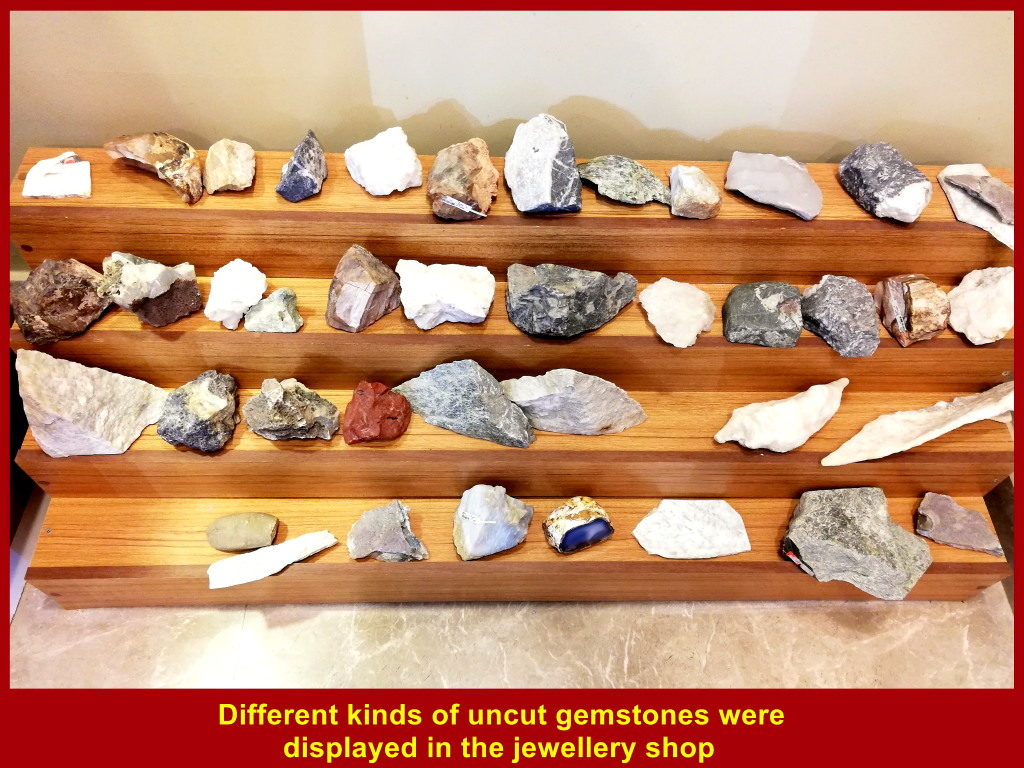
Carpet House
After visiting the jewellery shop we went to a factory, Carpet House, that was selling hand-made carpets.
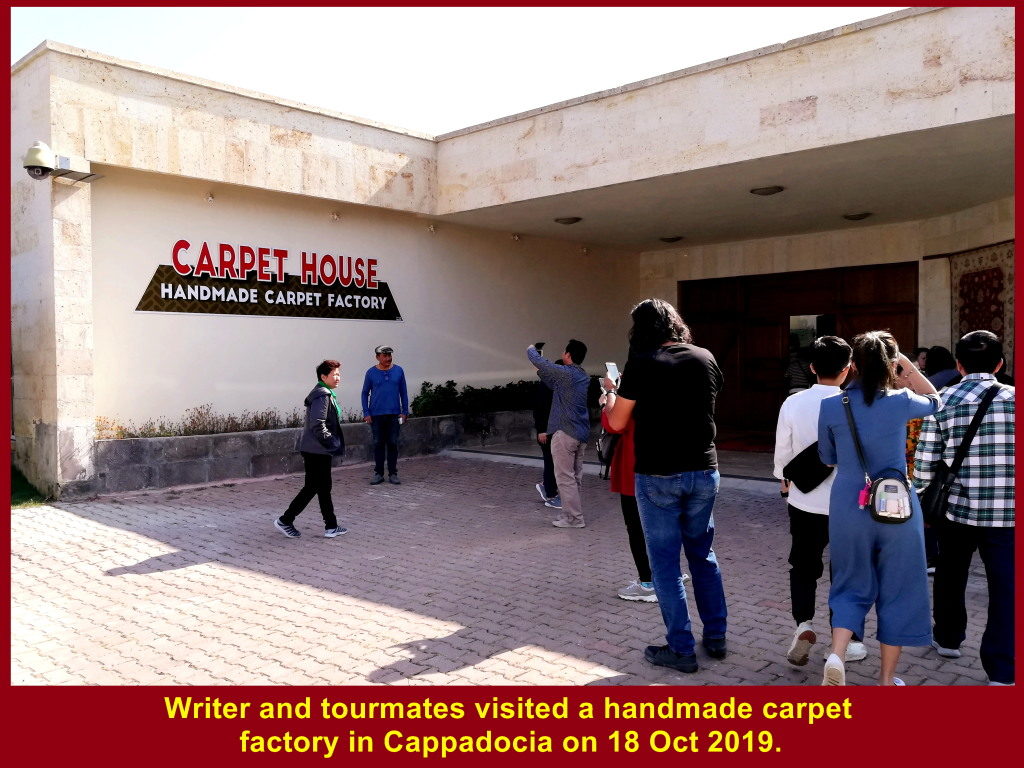
Carpets of different sizes and designs were displayed on the floor for us to see and buy.
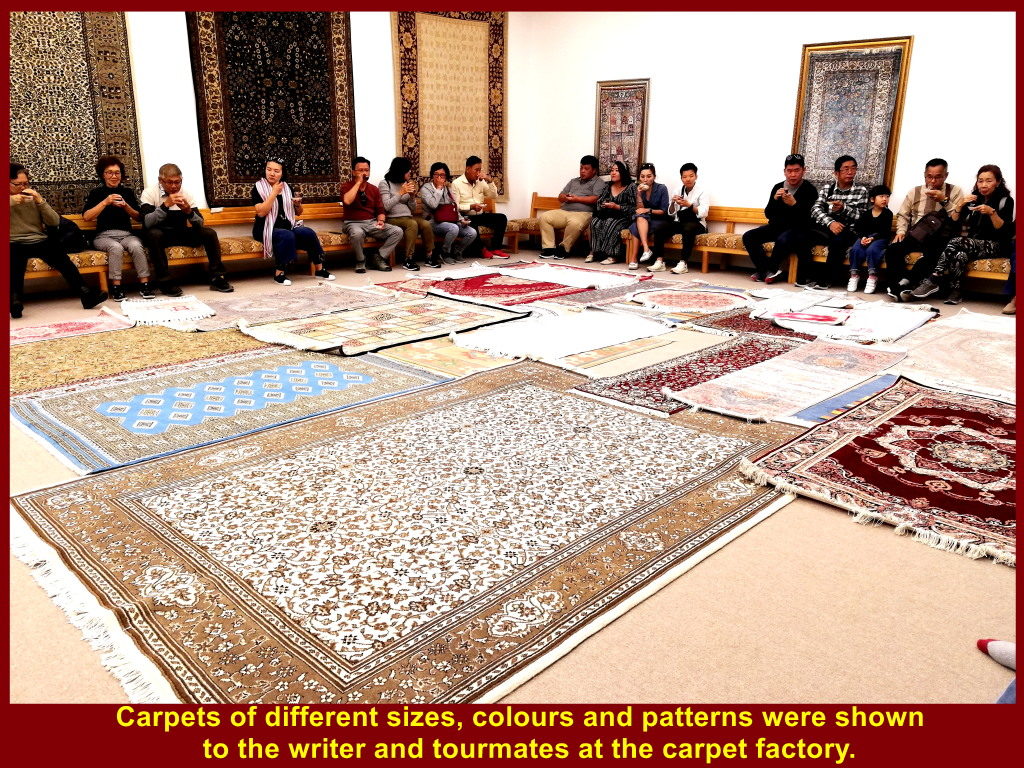
There were many hand-made carpets for sale at the carpet factory.
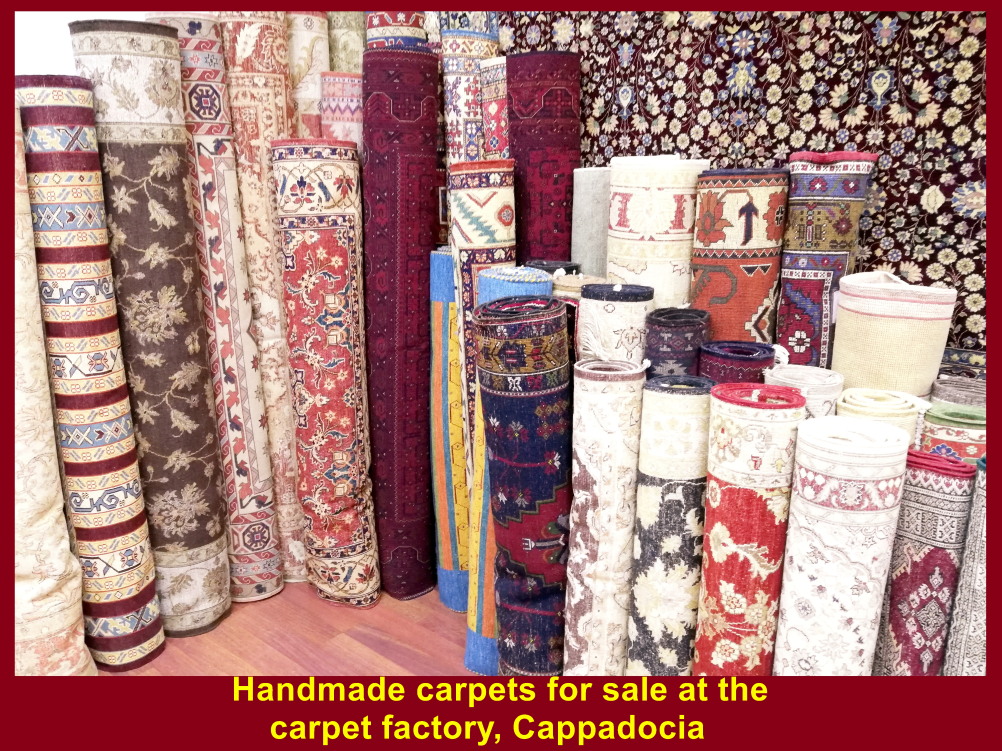
A carpet showing a colourful and complicated design was displayed on a wall at the factory.
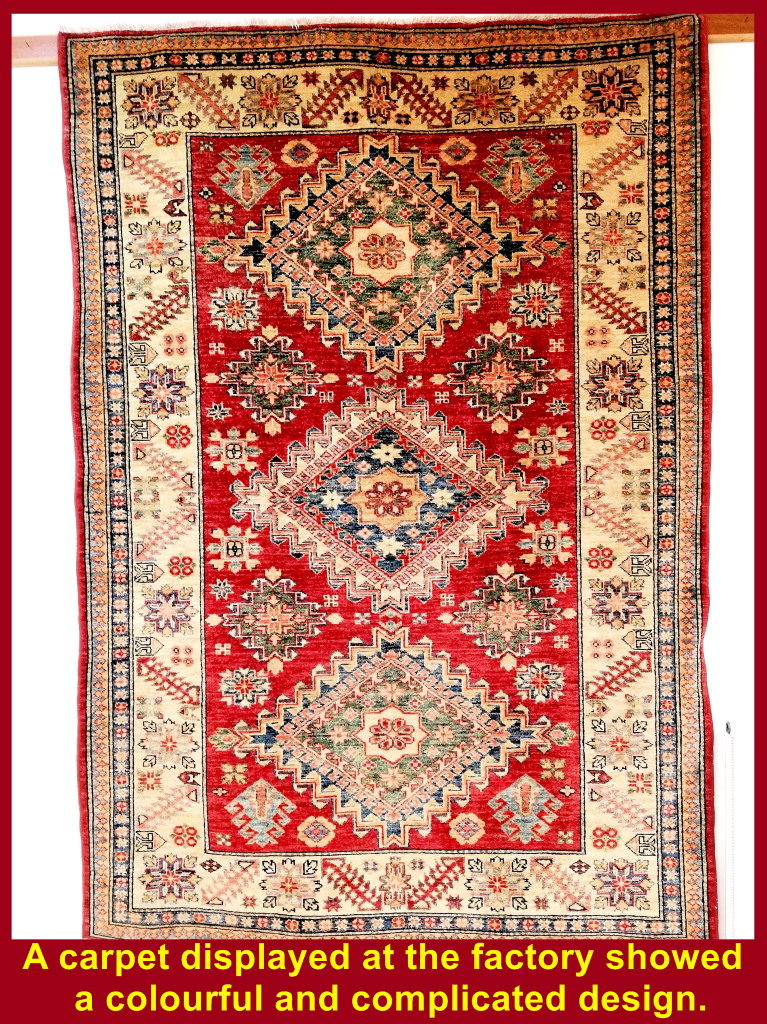
A Turkish woman was showing the writer and tourmates the way she was making a carpet.
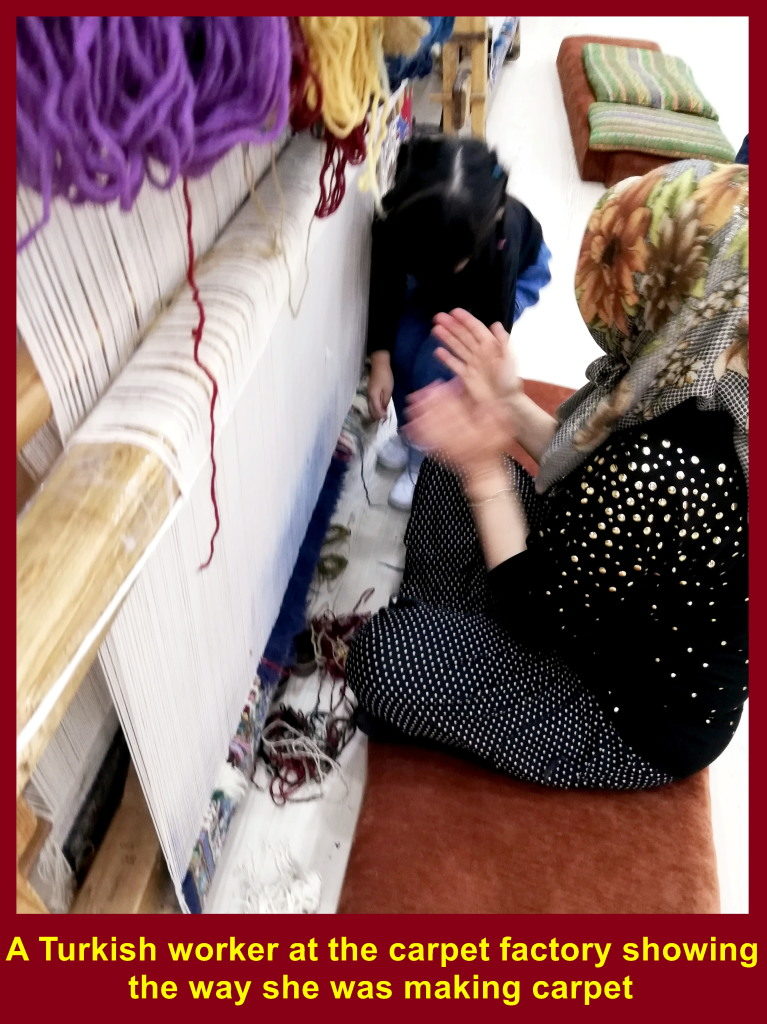
A beautiful hand-made carpet showing a horse drinking water in a stream in a forest was displayed on a wall.
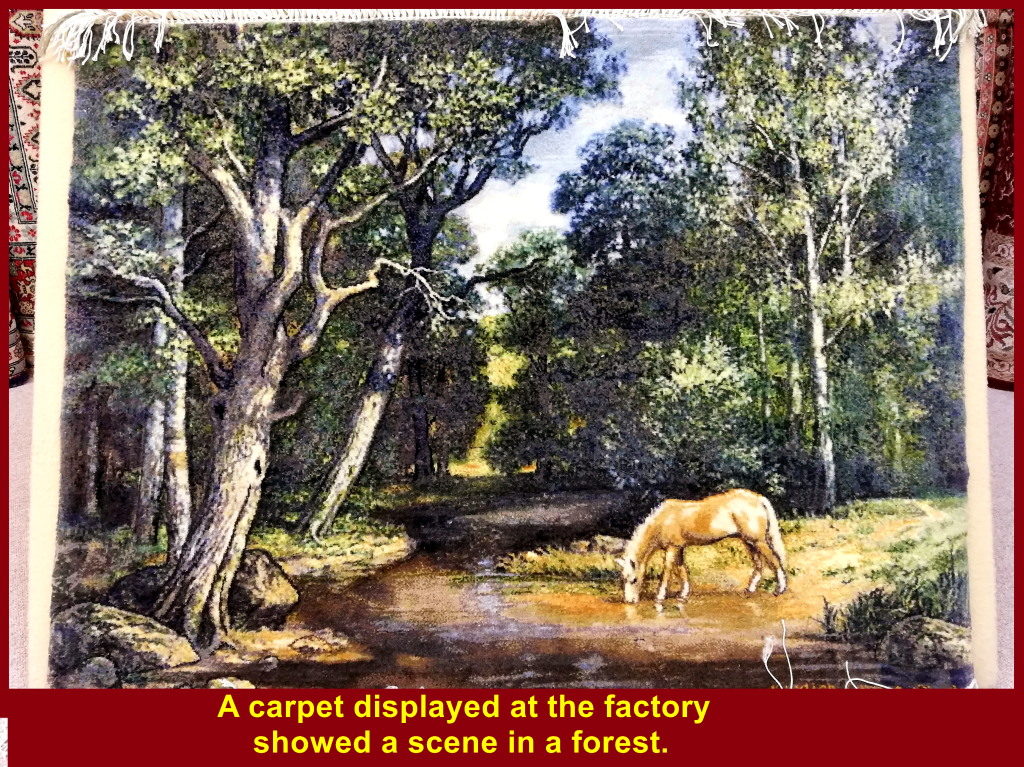
Charlie Chaplin and Friends
We were surprised to see a hand-made carpet that looked like a photo. It shows the famous mute actor, Charlie Chaplin, with his girlfriend, Edna Purviance, and dog called Mut. They acted together in a 1918 movie, “A Dog’s Life”.
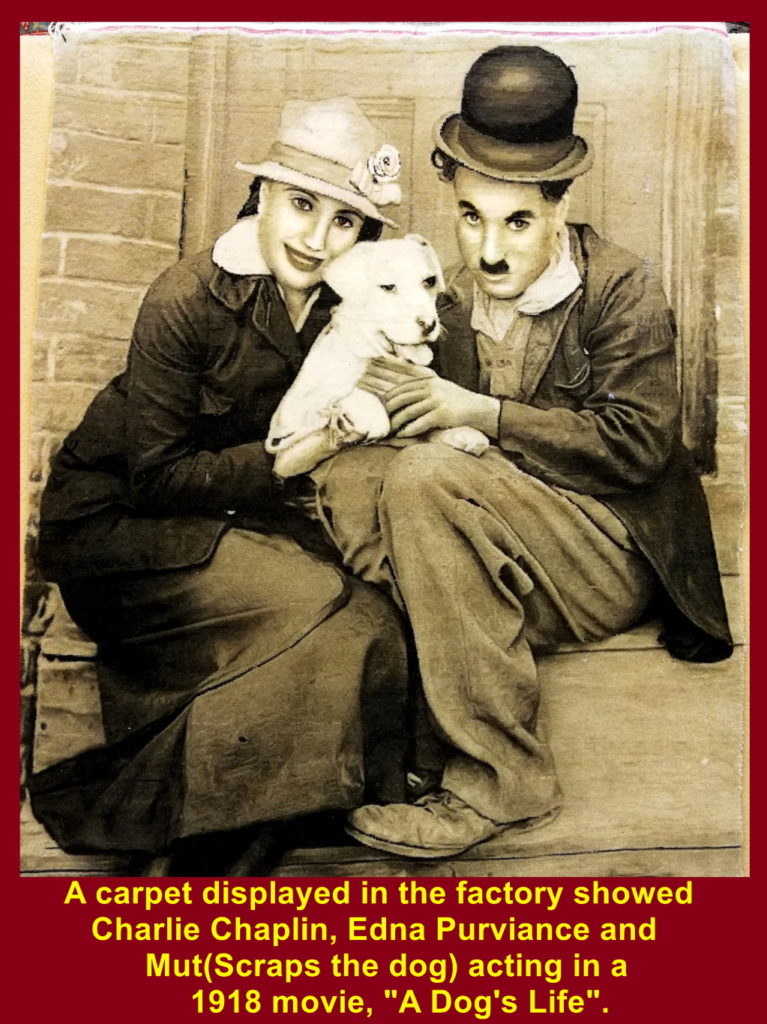
Lunch-Time
At 12.15 p.m. we left the carpet factory for lunch at a restaurant of Uchisar Kaya Hotel in Uchisar on 18 Oct 2019.
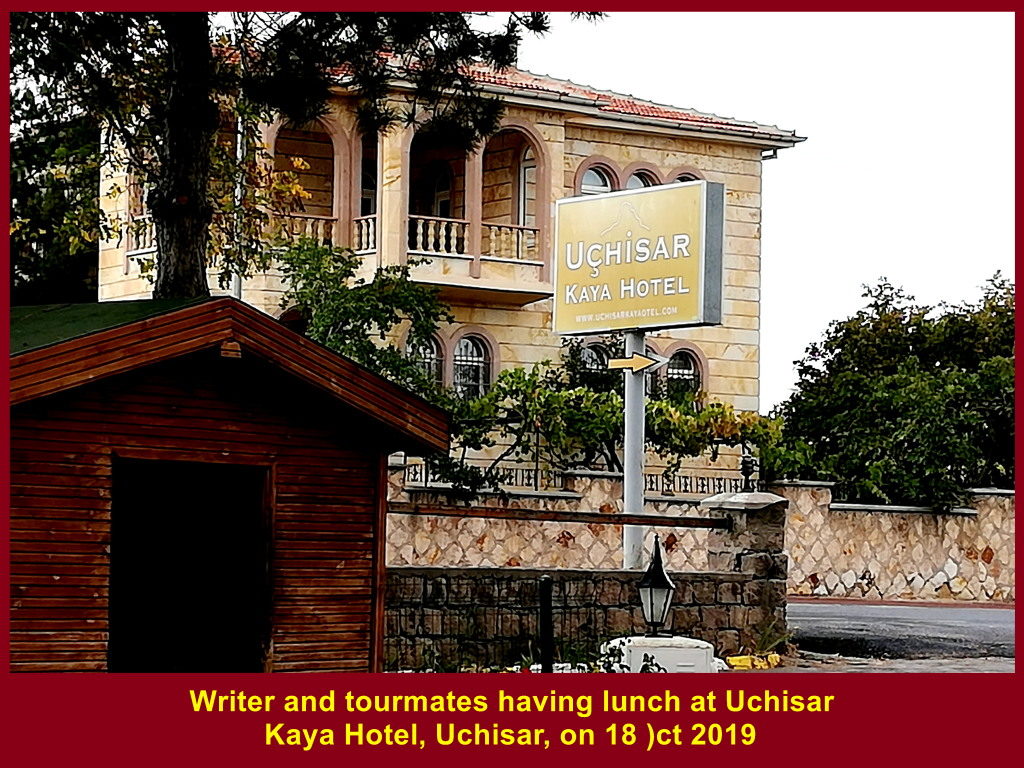
Writer’s lunch at Uchisar Kaya Hotel restaurant on 18 Oct 2019
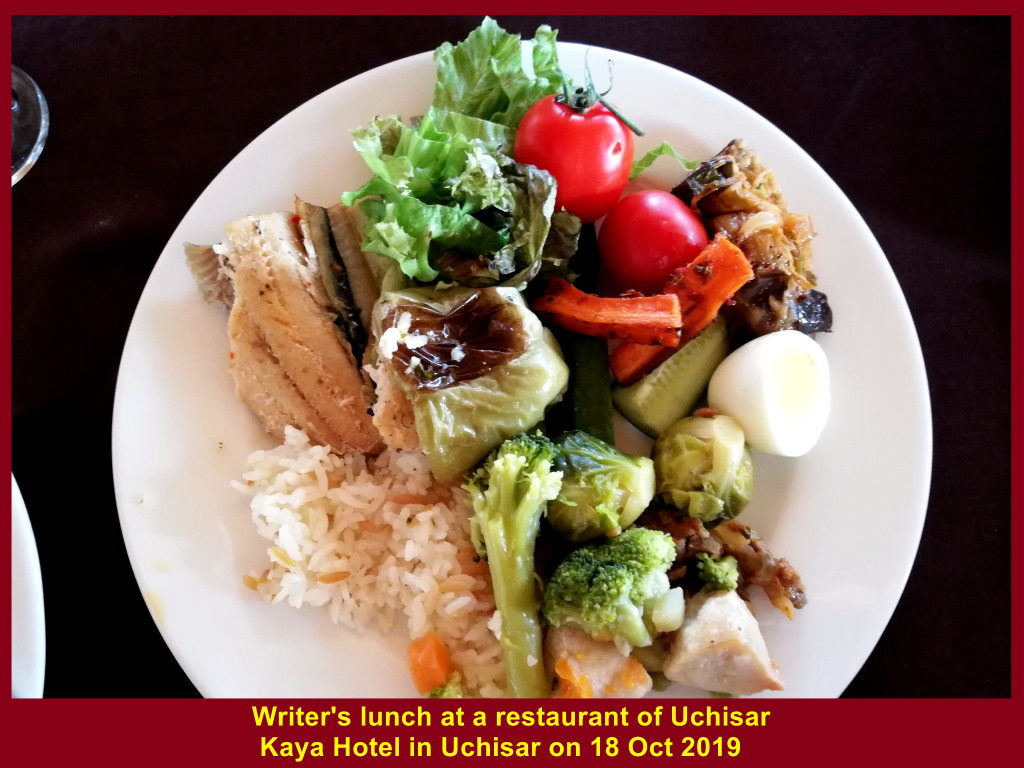
(continued next page)
Previous Page / Home / Next Page
Places visited during Turkey Tour(13-22 Oct 2019):
Trojan Horse/Ancient Troy Cities Asklepion Ephesus Hierapolis/Pamukkale Travertine Sultanhani Caravanserai Pasabag Valley Uchisar Valley/Kaymakli Underground City Gerome Valley/Turkish Night Show Hot Air Balloon/Lake Golu/Anitkabir Hagia Sophia/Topkapi Palace/Blue Mosque Bosphorus Boat Cruise Spice Bazaar/Grand Bazaar
Turkey Travel Part VII Uchisar Valley & Kaymakli Underground City
Filed under: Turkey Travel, Uchisar Valley, Kaymakli Underground City
Day 6
Friday, 18 Oct 2019
(Continued from previous page)
Visiting Uchisar Valley and Kaymakli Underground City
As we had visited Pasabag Valley that was described on the previous page, we went to Uchisar Village and Kaymakli Underground City then.
Map below shows the four places in Cappadocia we visited on 18 Oct 2019: Pasabag Valley, Uchisar Valley, Kaymakli Underground City and Goreme Valley.
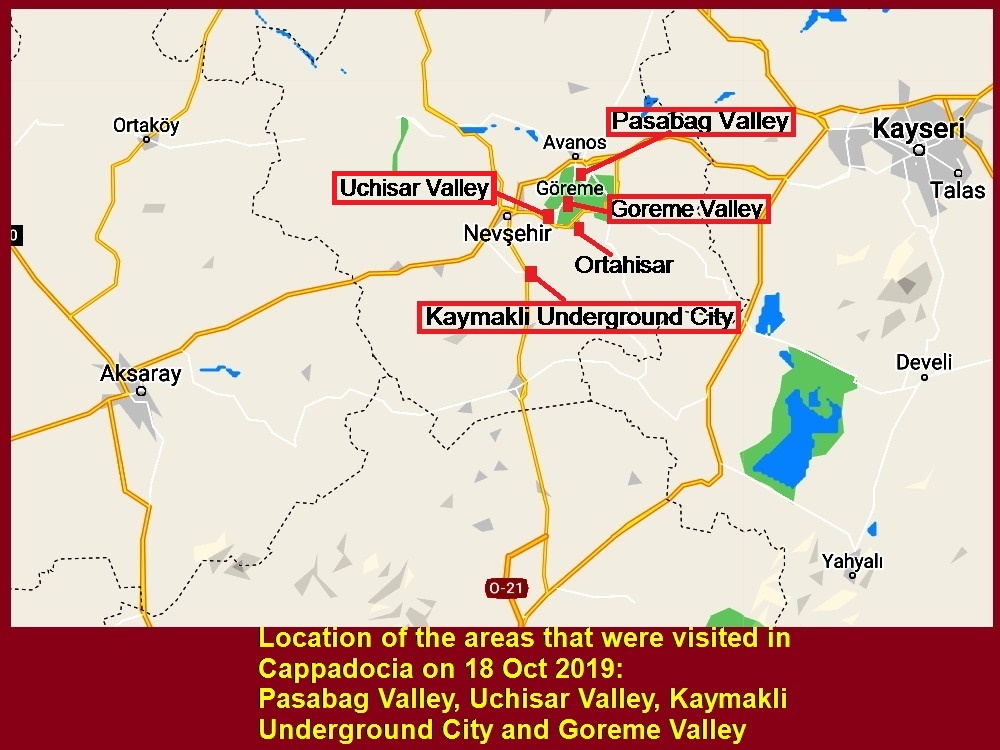
Uchisar Kaya Hotel
At 12.30 p.m. we arrived at a restaurant of Uchisar Kaya Hotel and had a simple lunch.
Writer’s simple lunch at Uchisar Kaya Hotel, Uchisar, Cappadocia, Turkey

Uchisar Valley
After lunch we looked at a valley behind the hotel. Known as Uchisar Valley, the view of the valley is breathtaking. There are holes that have been dug into rocks and people lived in them like their homes in the olden days.
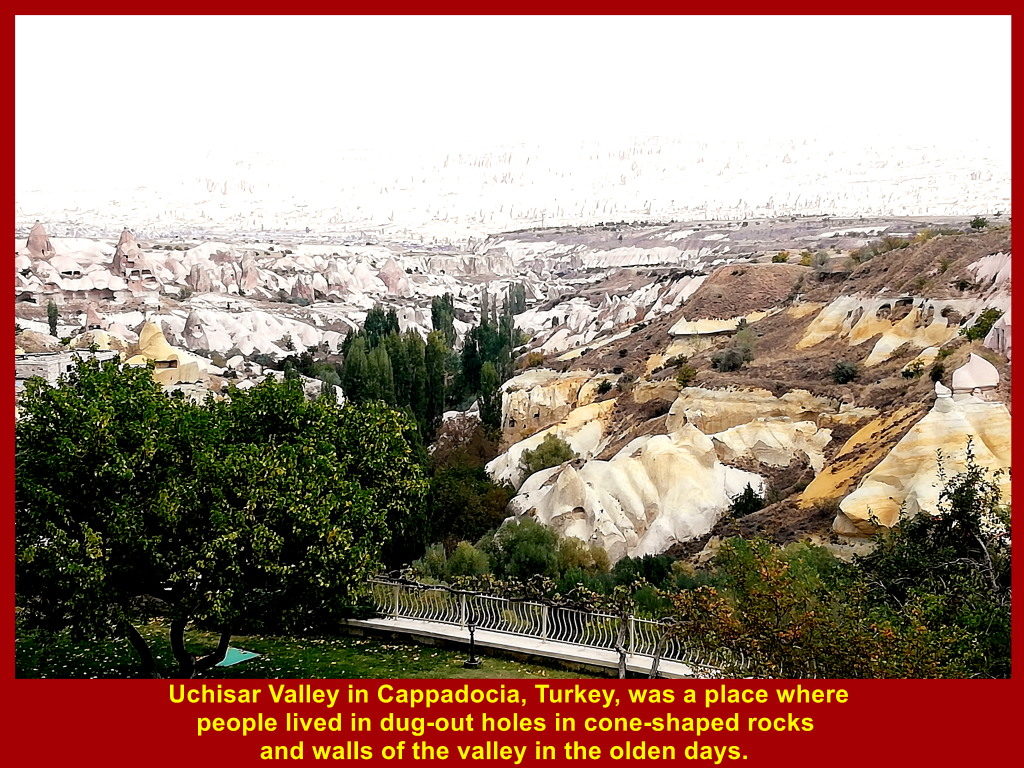
Valley of the Dovecotes or Pigeon Valley
Further up the valley there are holes dug into the walls of the valley. It is known as Valley of the Dovecotes or Pigeon Valley. They are meant for pigeons to stay, literally. The birds provided eggs and fertiliser for the hole-dwellers in the olden days.
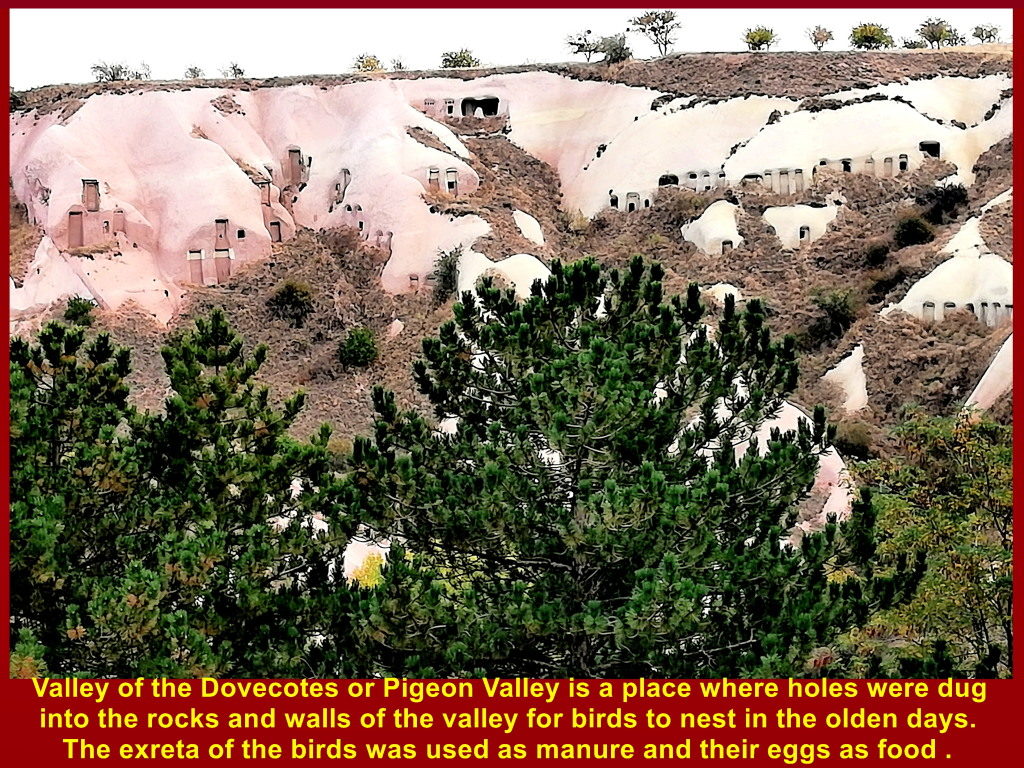
Hotels in Holes of Rocks
Nowadays, there are some holes which are still occupied by people in the Uchisar Valley. A few of them become hotels.
Rock-dwellers on the slope of Uchisar Valley in Cappadocia, Turkey
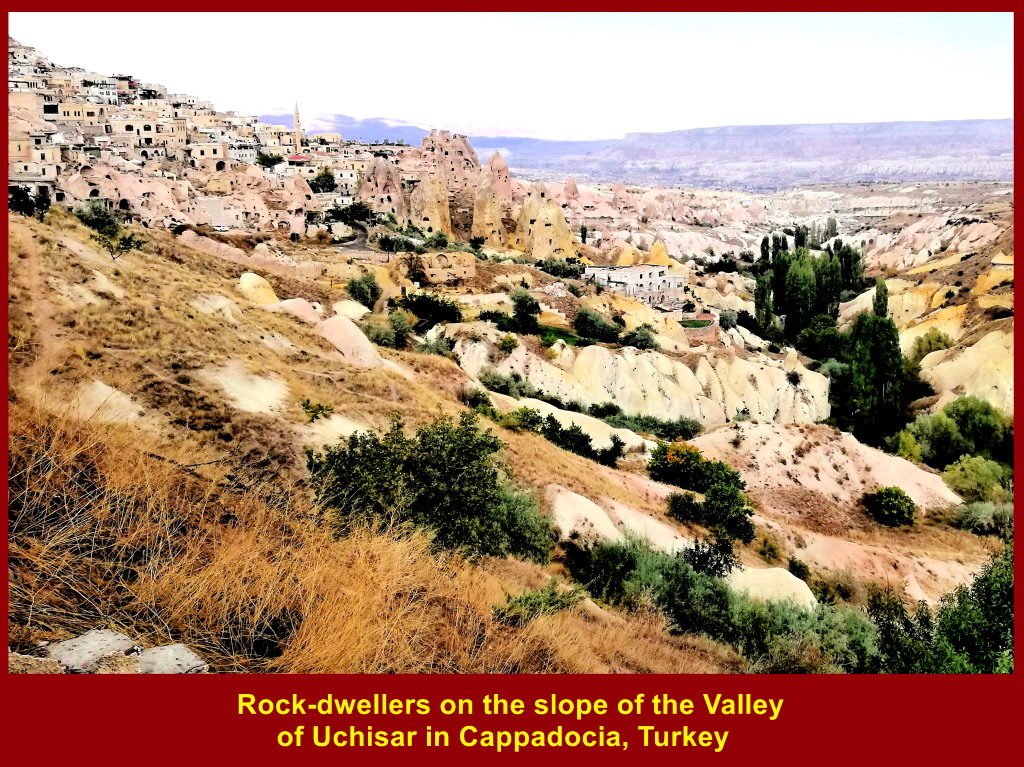
A hotel in Uchisar Valley for visitors to stay and explore the beautiful landscape as shown in the photo below
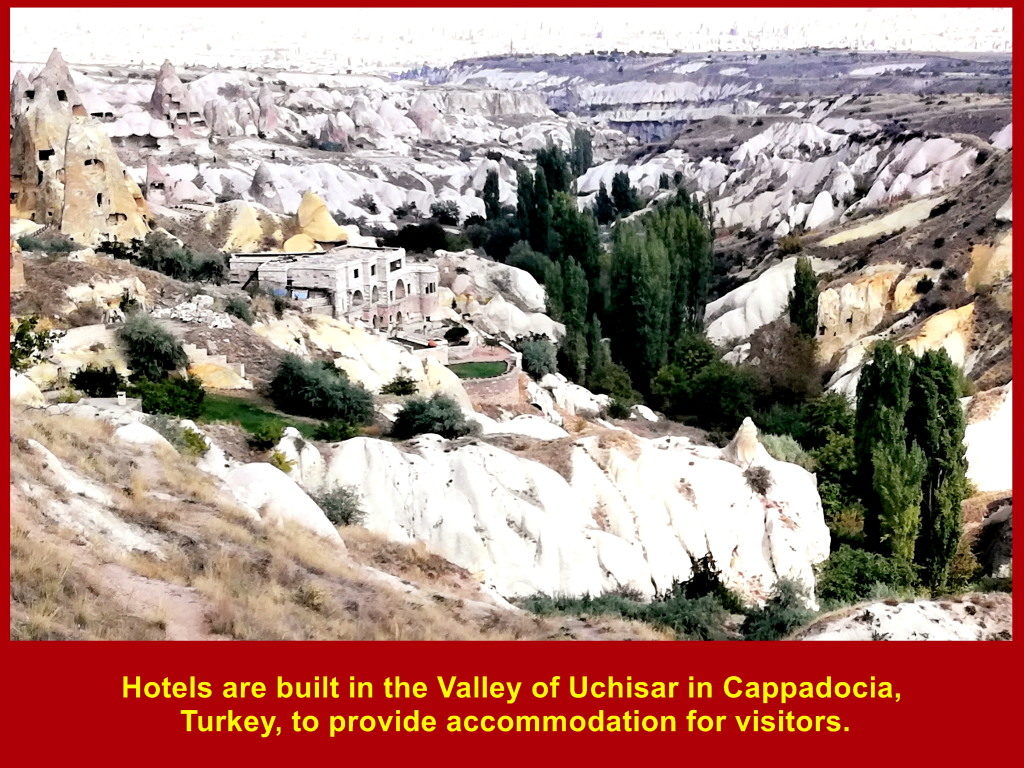
Uchisar Castle
A high, unusual hill in Uchisar Valley known as Uchisar Castle had hundreds of people living inside in the olden days.
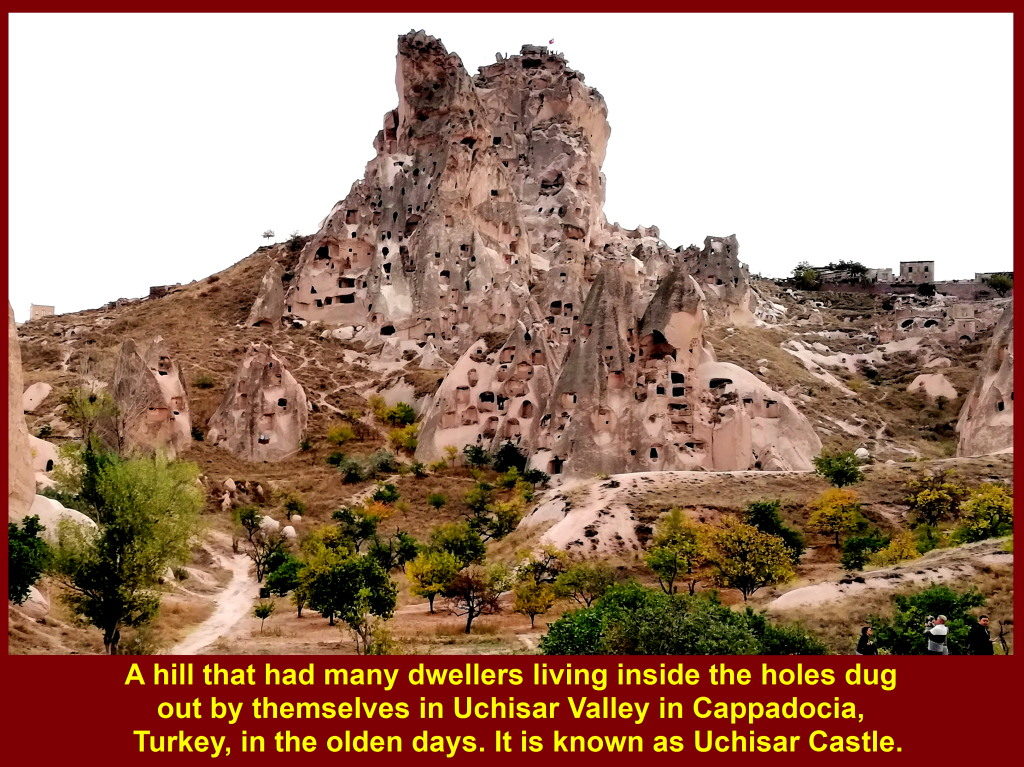
Underground Cities in Kaymakli
After spending an hour at the Uchisar restaurant and looking at the awesome landscape of Uchisar Valley, we left and travelled to Kaymakli where there are many abandoned underground cities. Researchers have estimated the number to be over 150.
Inhabitants built and lived in the underground cities to hide themselves from attackers in the olden days.
Kaymakli Underground City
We visited one of them and it is known as Kaymakli Underground City in Cappadocia on 18 Oct 2019.
There is an entrance to Kaymakli Underground City where visitors pay a fee to enter.
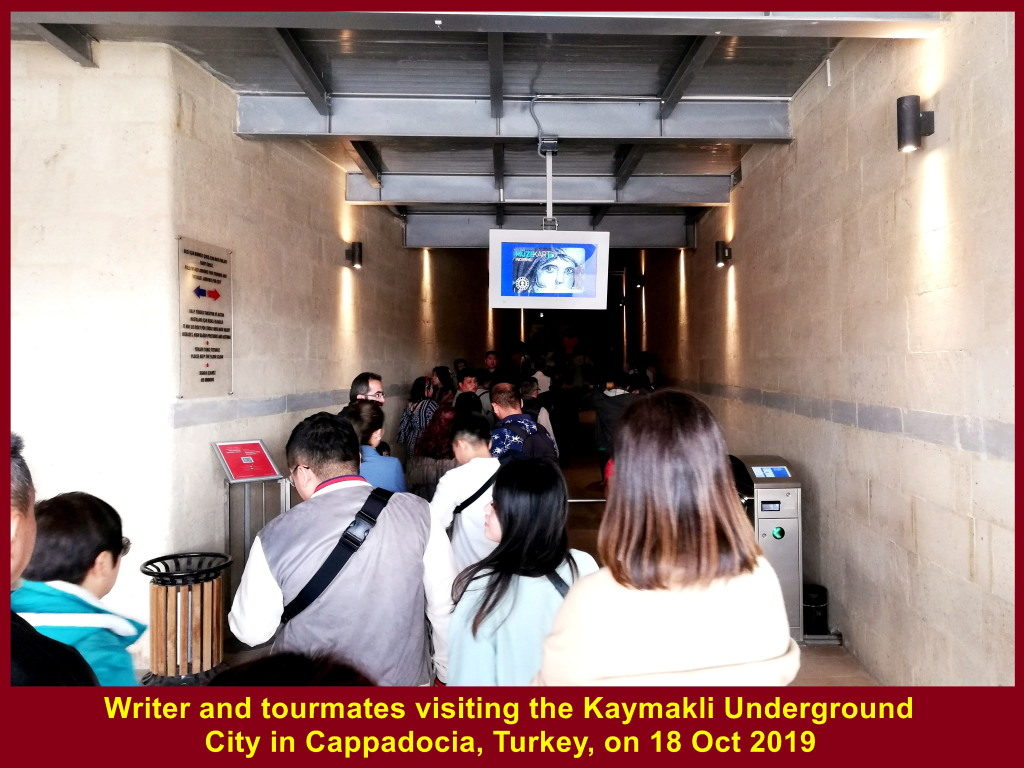
Below are photos showing some of the underground legacies left behind by the inhabitants of the olden days.
(i) The passages or tunnels in the underground city are narrow. Some of them are low.
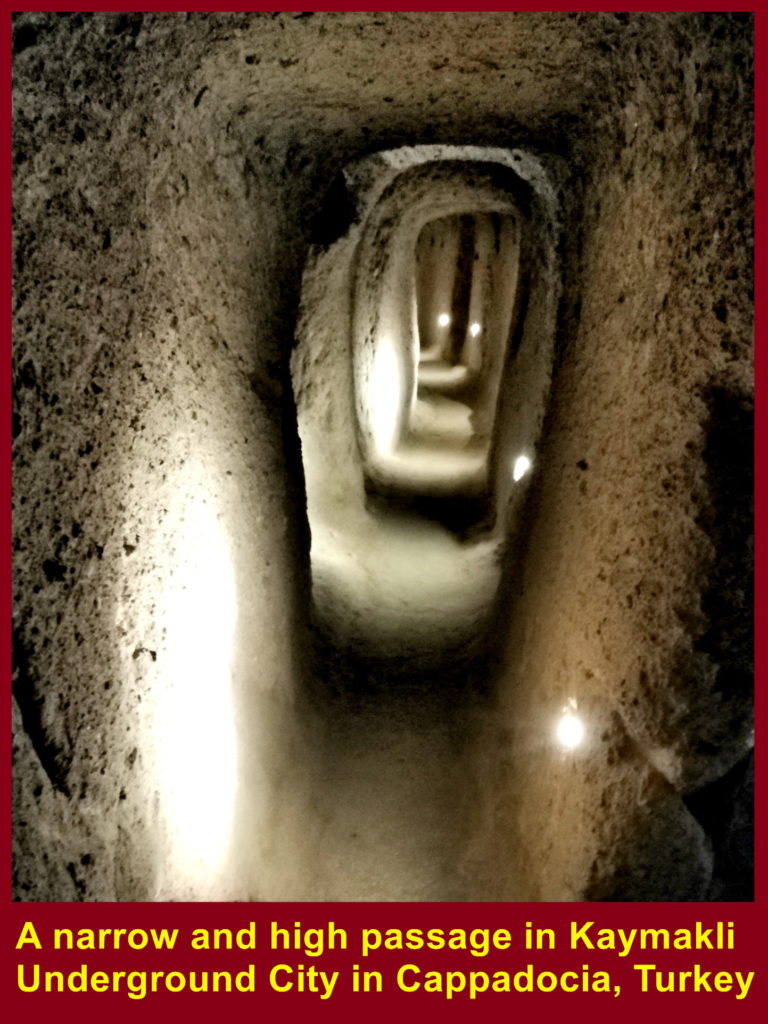
(ii) To go through this small and low passage, a visitor has to bend his knees and walk, otherwise their heads will get a few bumps.
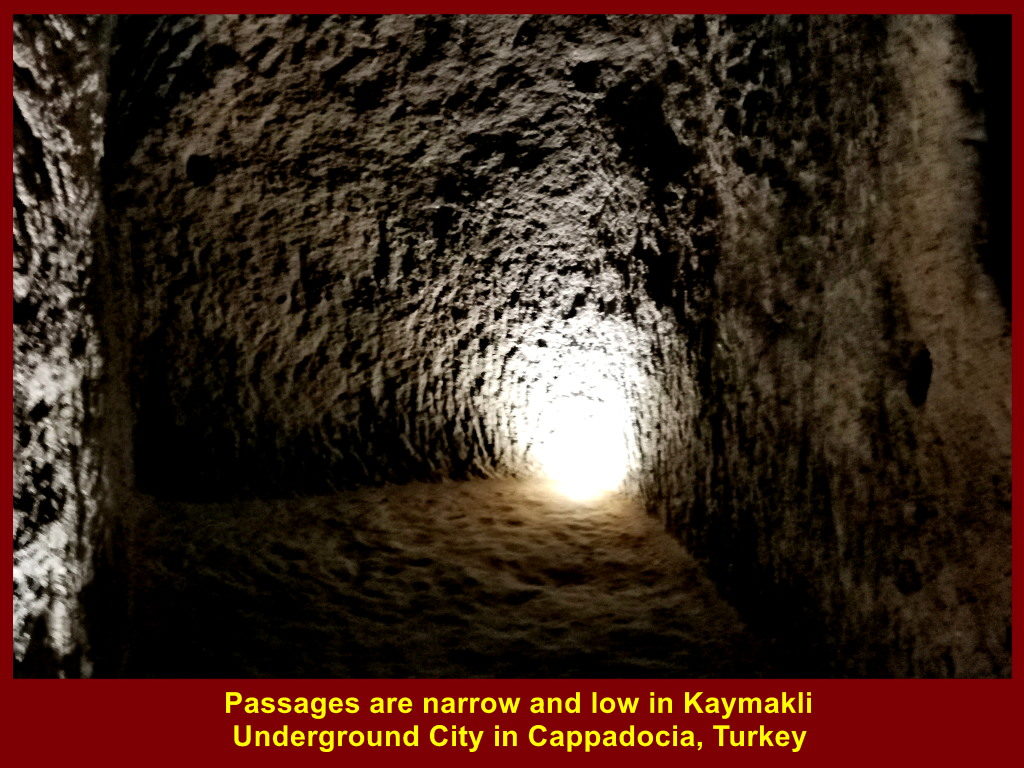
(iii) Writer and tourmates walked done the narrow steps to the lower level very slowly and cautiously.
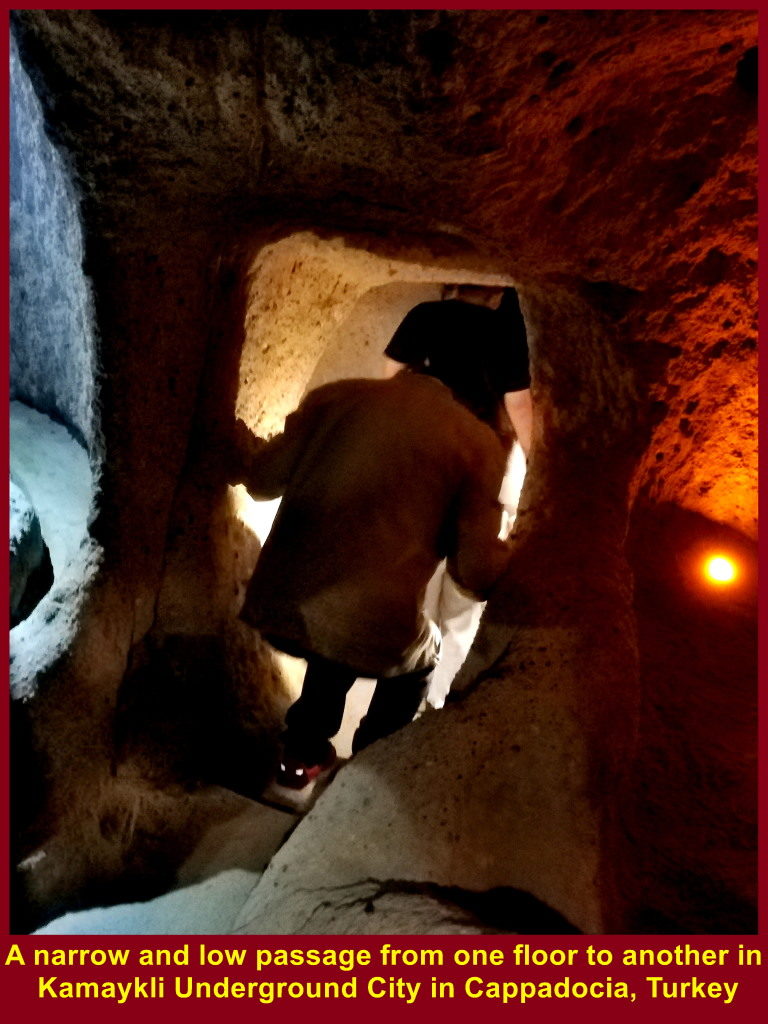
(iv) Judging by the narrow passages and steps in the underground cities, I guess the inhabitants were small and slim in the olden days.
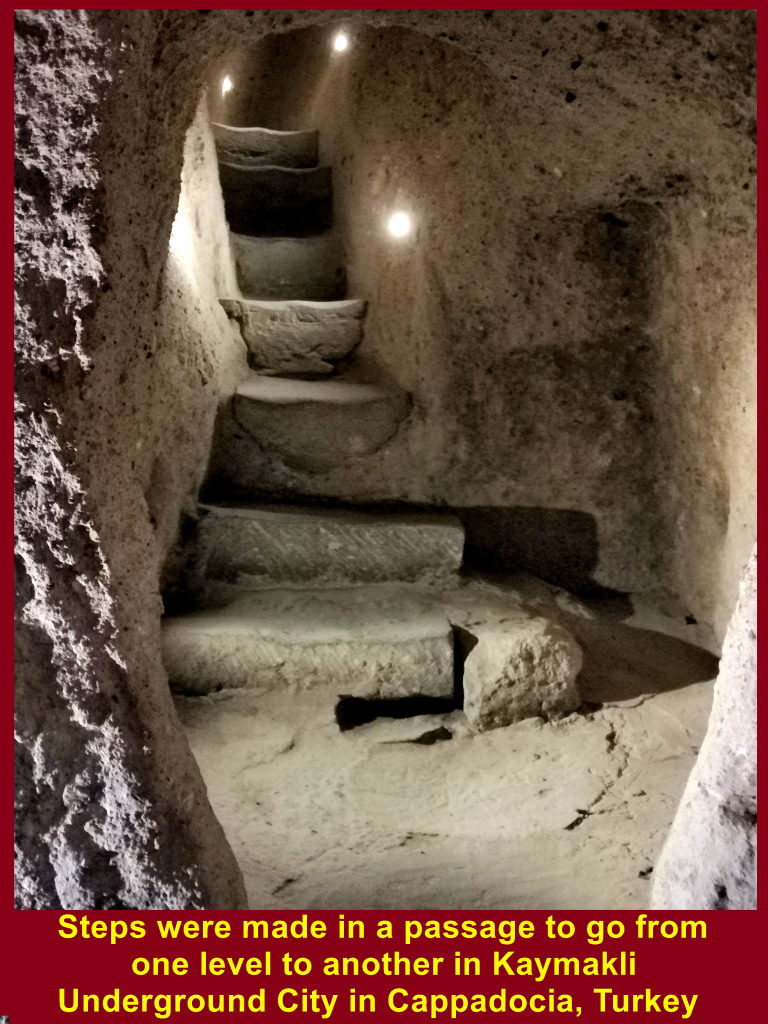
(v) A small hole in a wall was used for communication from room to room in the olden days.
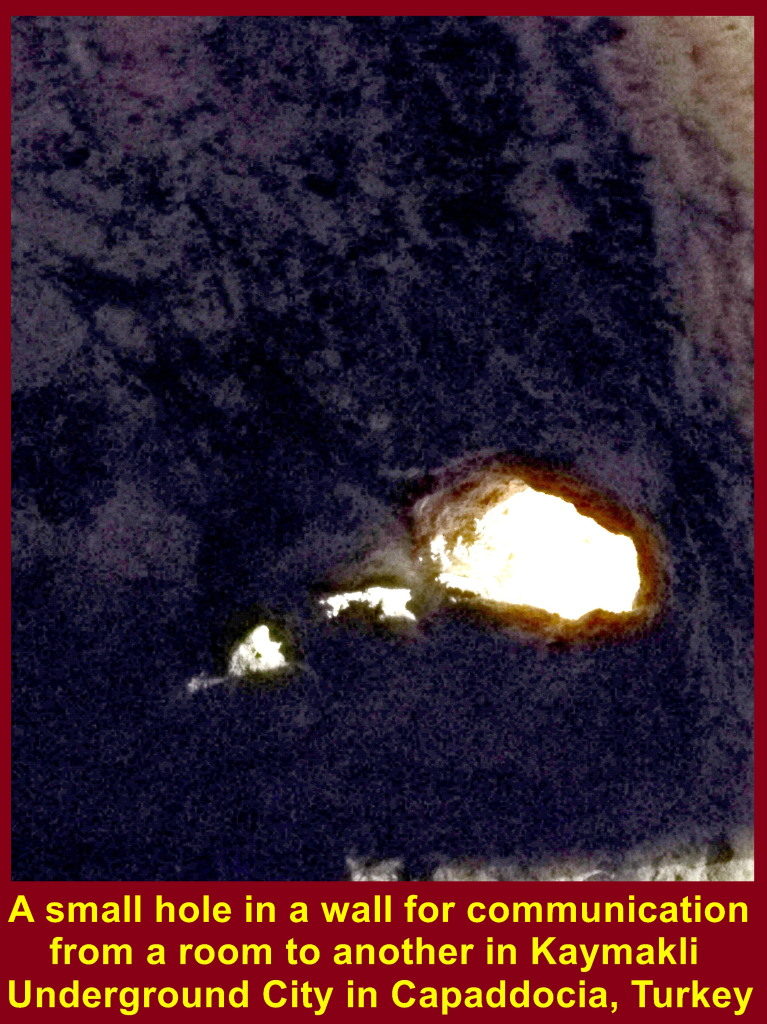
(vi) Holes made through floors were for communication from floor to floor.
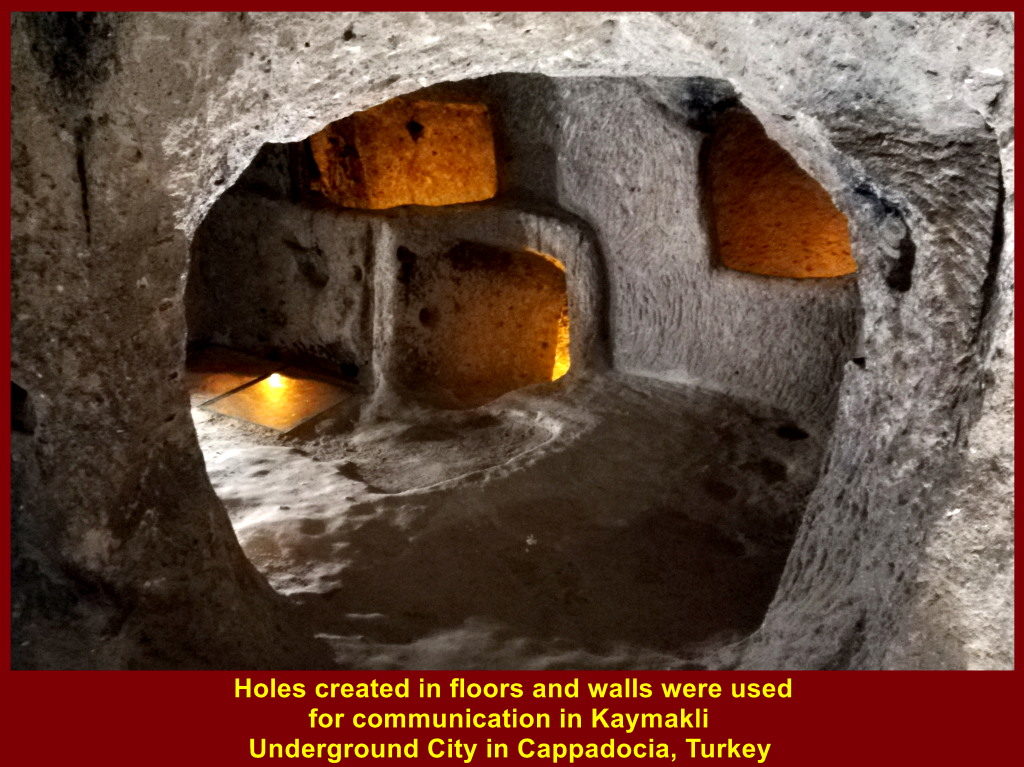
(vii) A narrow door between rooms
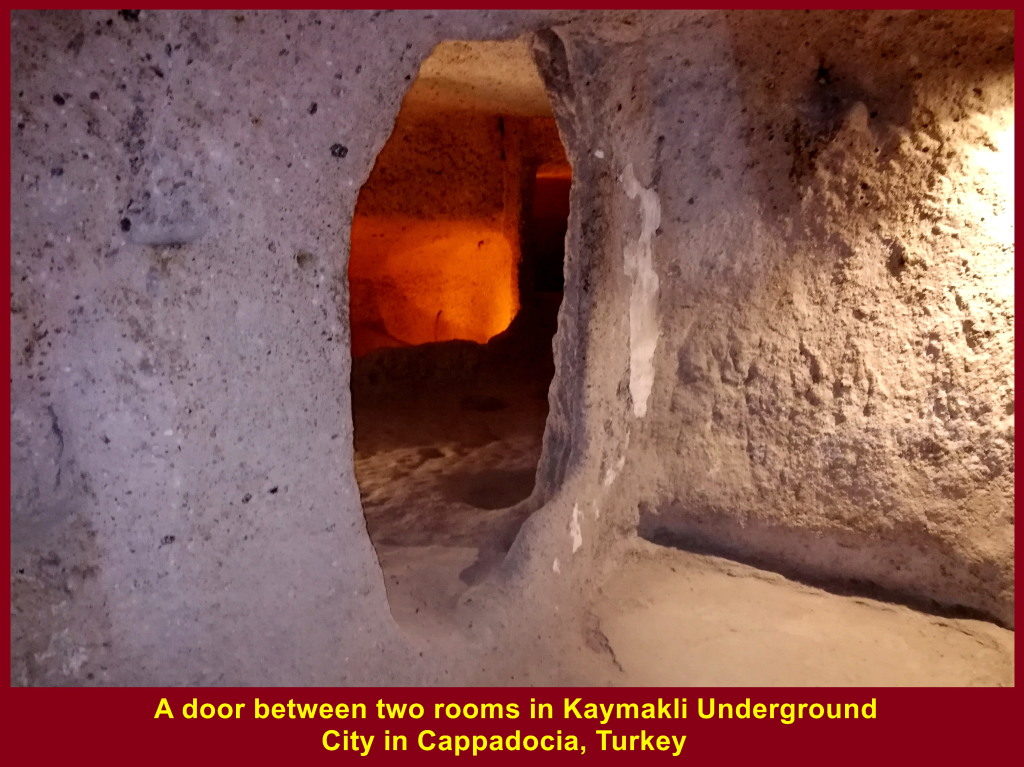
(viii) A stable for domesticated animals on the first floor of the underground city
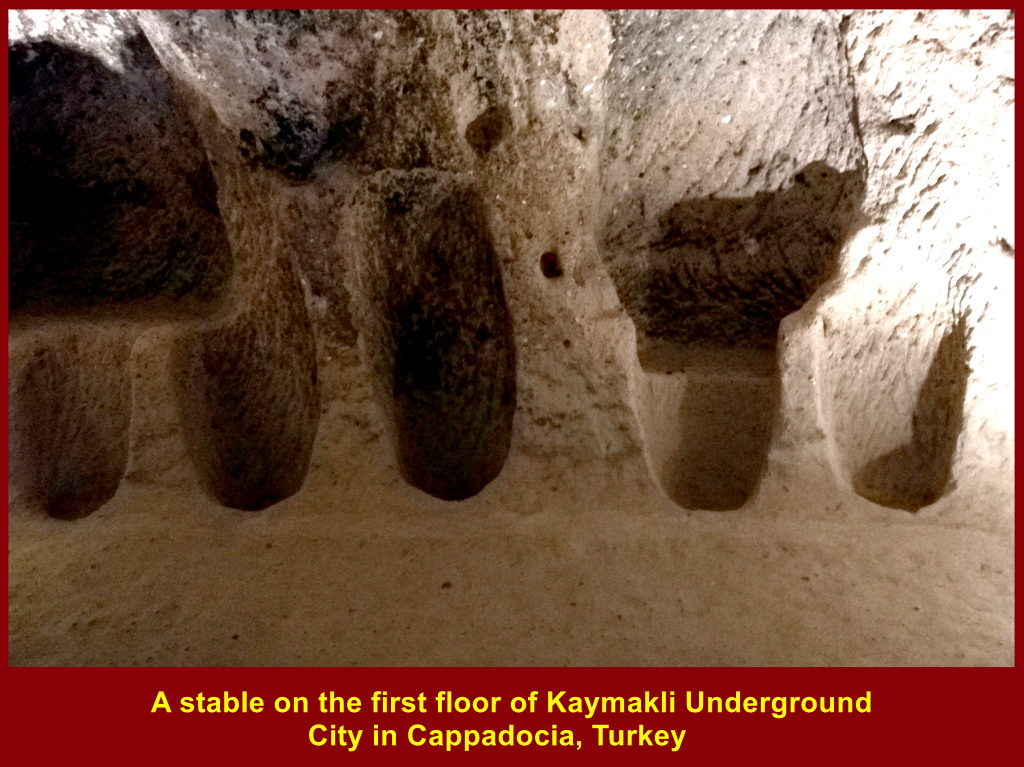
(ix) A church and a graveyard which was next to it are on the second floor.
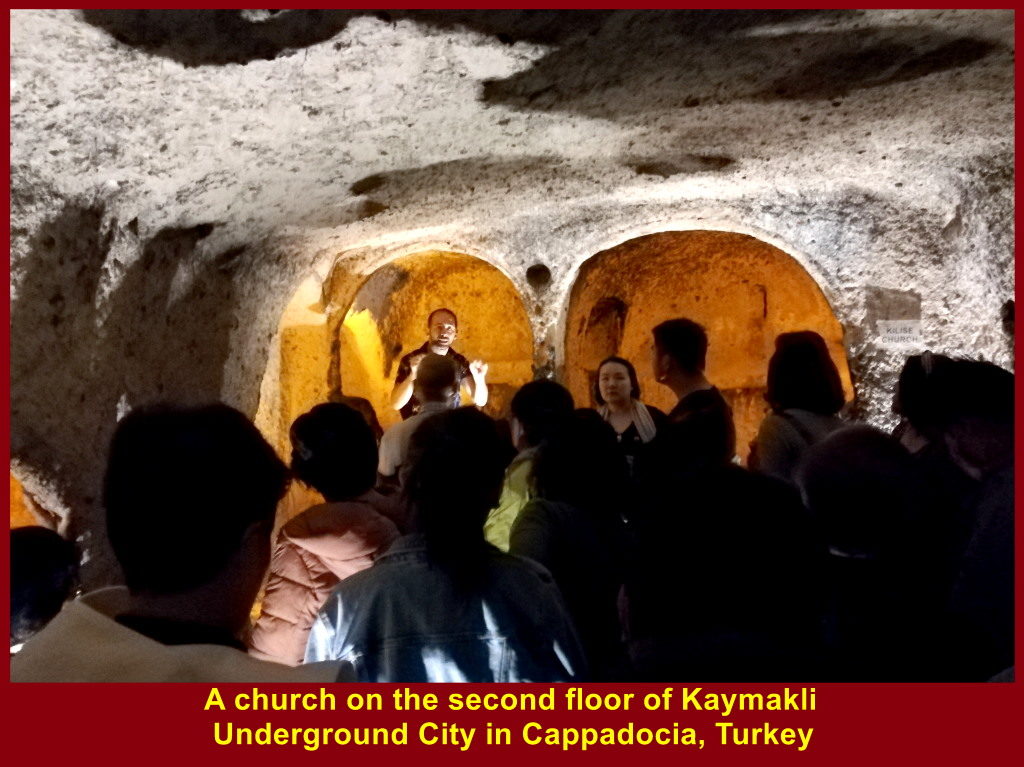
(x) A room on the 3rd floor that was used for winery, kitchen, food storage or other purposes in the underground city
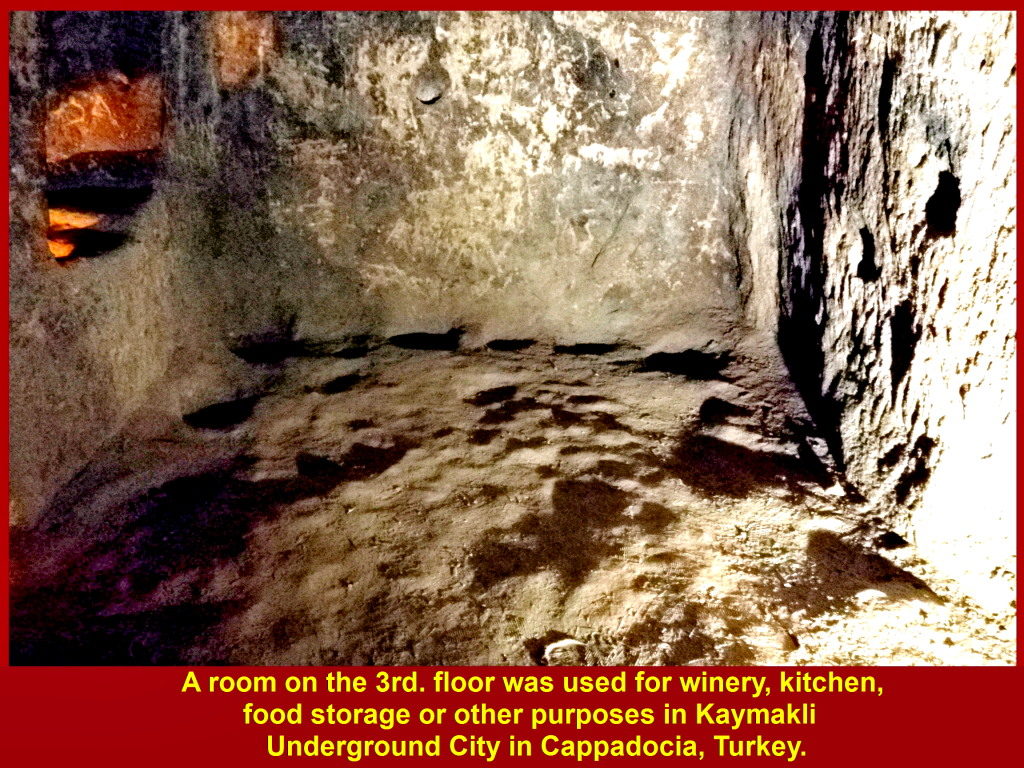
(xii) A storage space for wine or other foodstuff on the third floor in the underground city
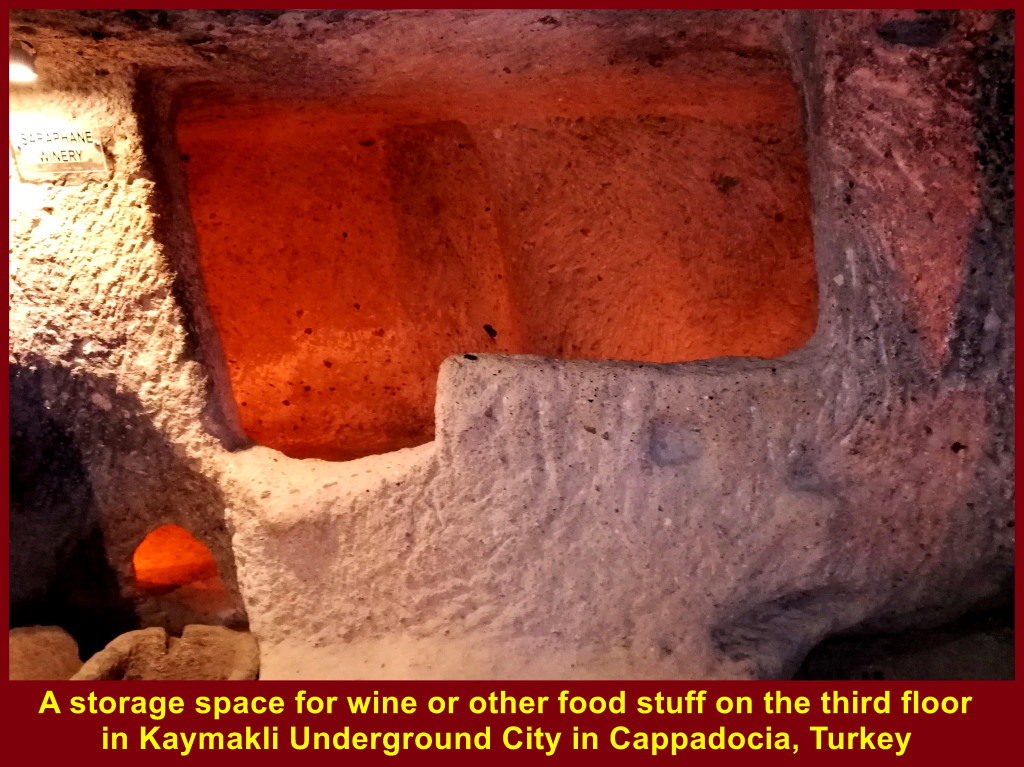
(xiii) A stone with holes on the 3rd. floor was used for processing copper in the olden days.
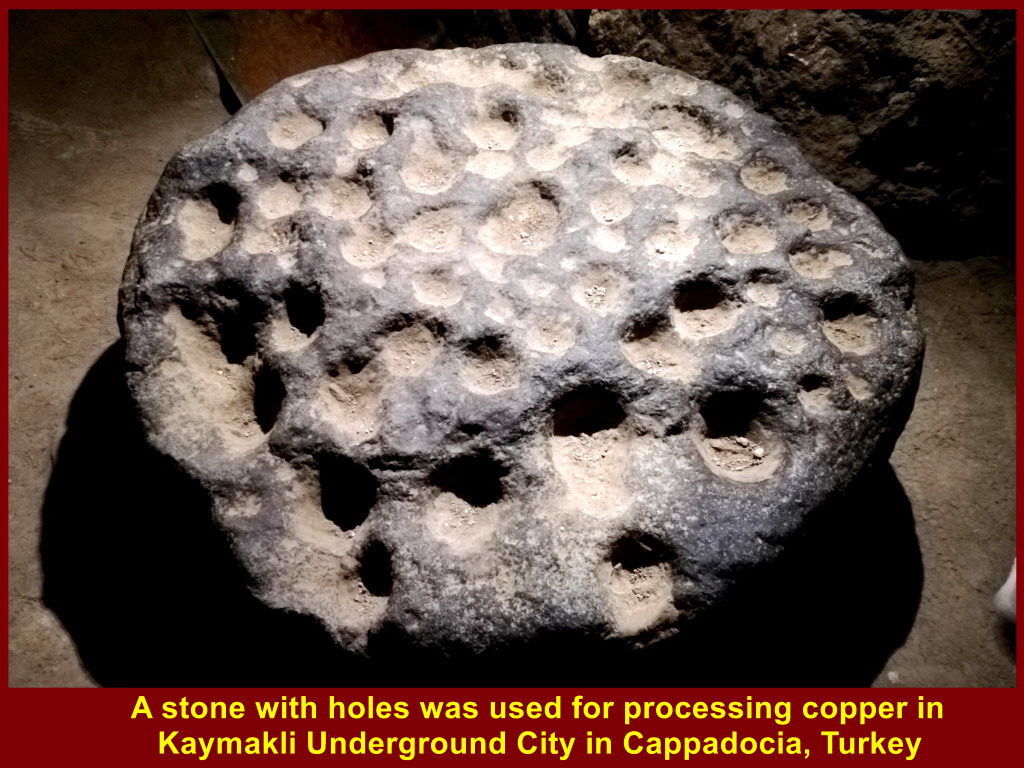
(xiv) A millstone for grinding grains on the first floor
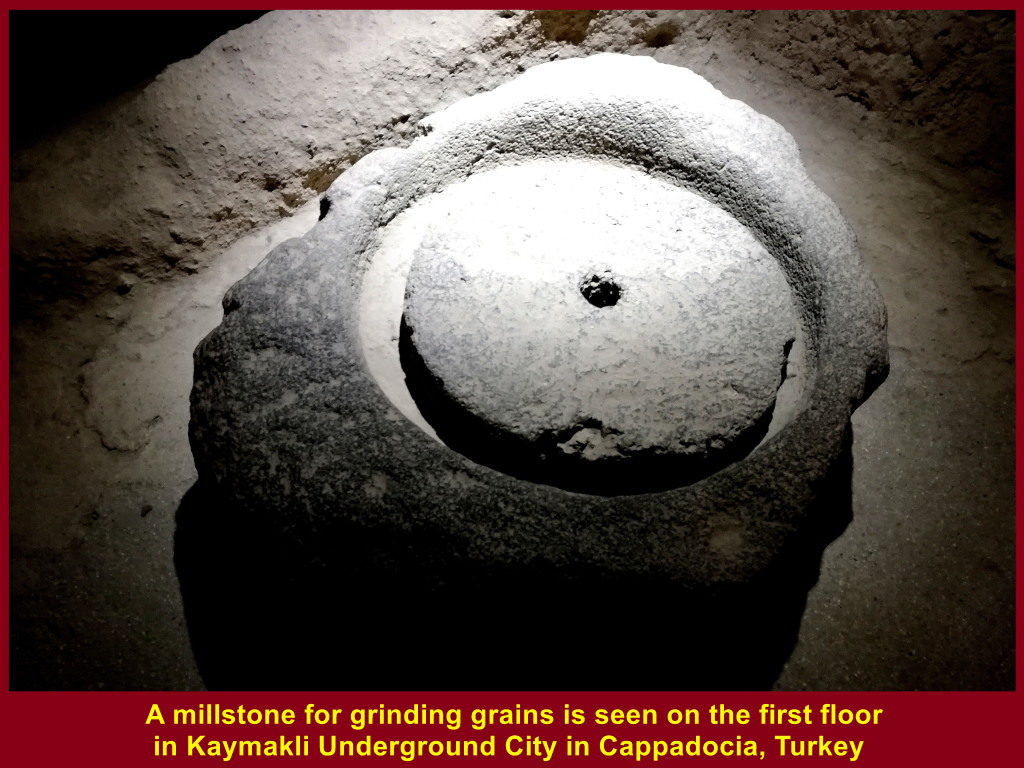
8 underground floors
The Kaymakli Underground City has 8 underground floors but only four of them are open to public.
Judging by the size of the city, I guess there were several thousands of people living in it in the olden days.
Gerome Valley
Then we went to another valley known as Gerome Valley which is next to Uchisar Valley.
Previous Page / Home / Next Page
Places visited during Turkey Tour(13-22 Oct 2019):
Trojan Horse/Ancient Troy Cities Asklepion Ephesus Hierapolis/Pamukkale Travertine Sultanhani Caravanserai Pasabag Valley Uchisar Valley/Kaymakli Underground City Gerome Valley/Turkish Night Show Hot Air Balloon/Lake Golu/Anitkabir Hagia Sophia/Topkapi Palace/Blue Mosque Bosphorus Boat Cruise Spice Bazaar/Grand Bazaar
Turkey Travel Part VIII: Gerome Valley & Turkish Night Show
Filed under: Gerome Valley, Turkish Night Show, Turkey Travel
(Continued)
Day 6
Friday, 18 Oct 2019
Visiting Gerome Valley
As we had visited Uchisar Valley and Kaymakli Underground City that were described on the previous page, we went to Gerome Valley then. Later, we relaxed and enjoyed watching a Turkish night show at a restaurant, Evranos Restaurant, in Cappadocia in the evening.
Map below shows four places we visited on 18 Oct 2019: Pasabag Valley, Uchisar Valley, Kaymakli Underground City and Gerome Valley on 18 Oct 2019.

Gerome Valley Visit
After lunch in Uchisar, we went to another valley, Gerome Valley, nearby. It is similar to Uchisar Valley in physical features i.e. both have cone-shaped rocks.
Gerome Valley, a Christian Settlement
Gerome Valley was a place where Christians in the Byzantine Period(330-1453 AD) lived. They lived in holes cut into large cone-shaped rocks and established churches, chapels and monasteries in them.
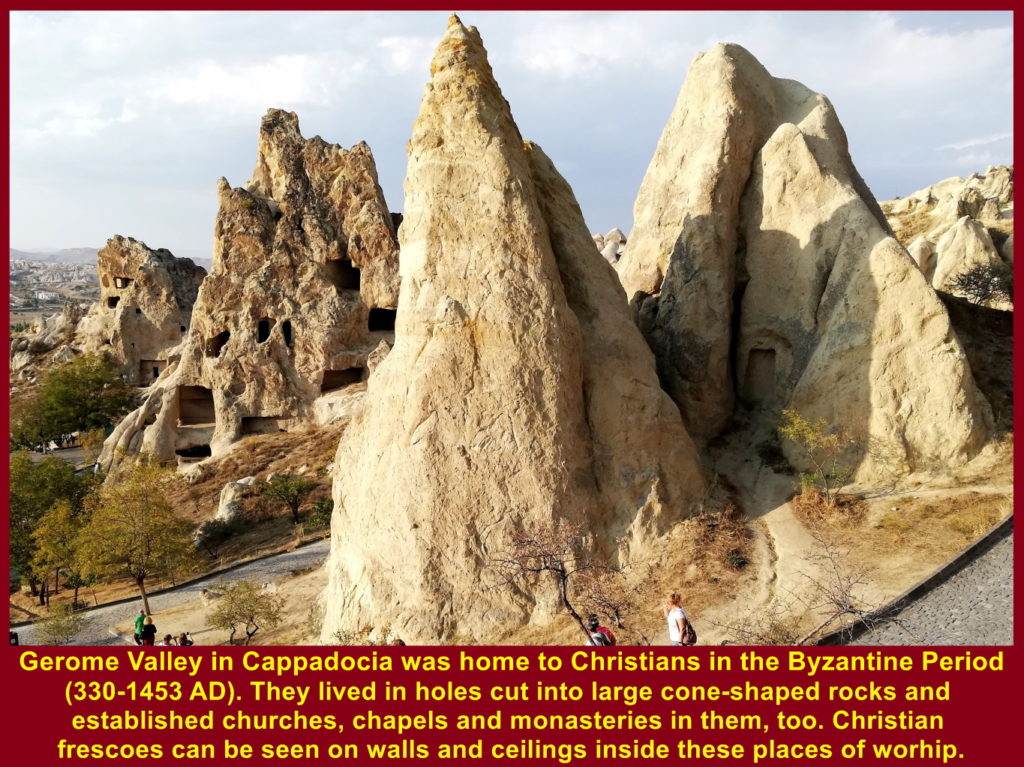
Writer and wife visited Gerome Valley on 18 Oct 2019. In the background of the photo below is a high hill known as Uchisar Castle.
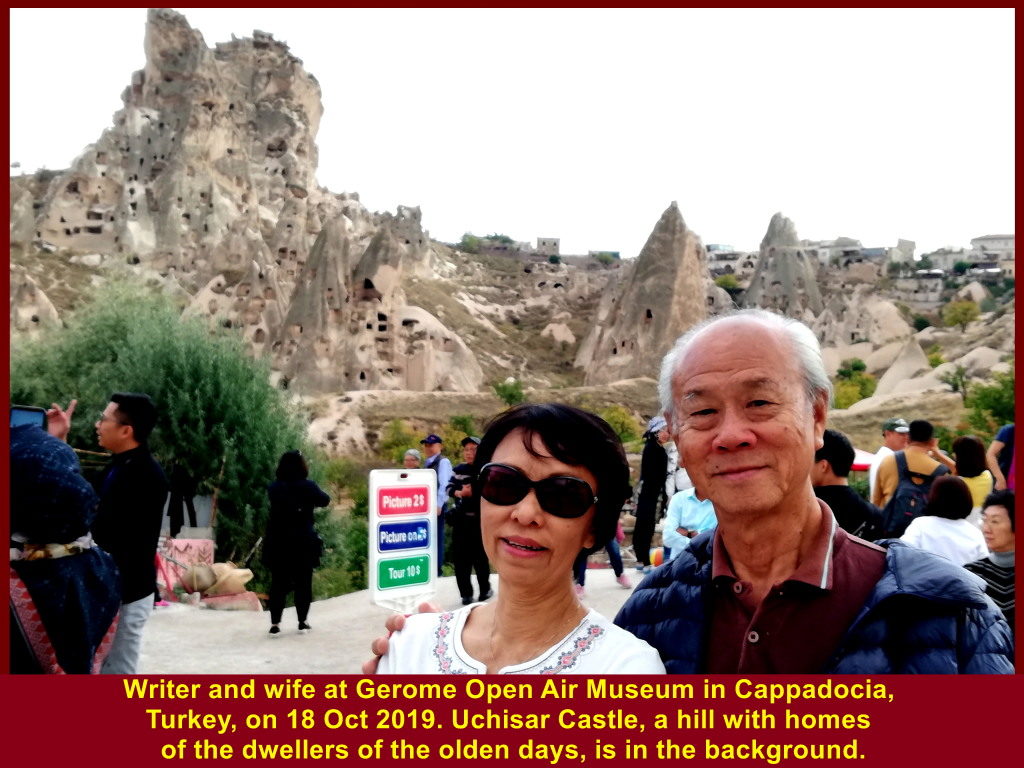
In the Gerome Valley, there is a row of abandoned churches, chapels and monasteries.
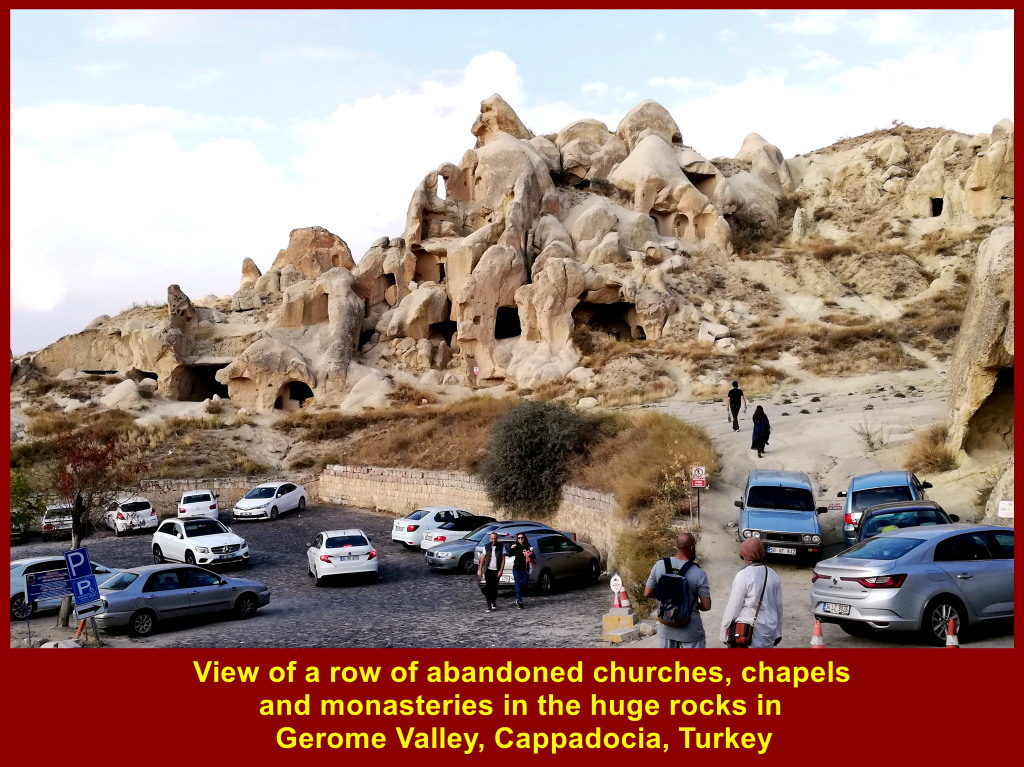
The photos below show some churches in Gerome Valley.
(i) A 7-storey “Nunnery” that housed a dining hall, kitchen and rooms on the first floor, ruined chapel on the second floor, church on the third, etc.
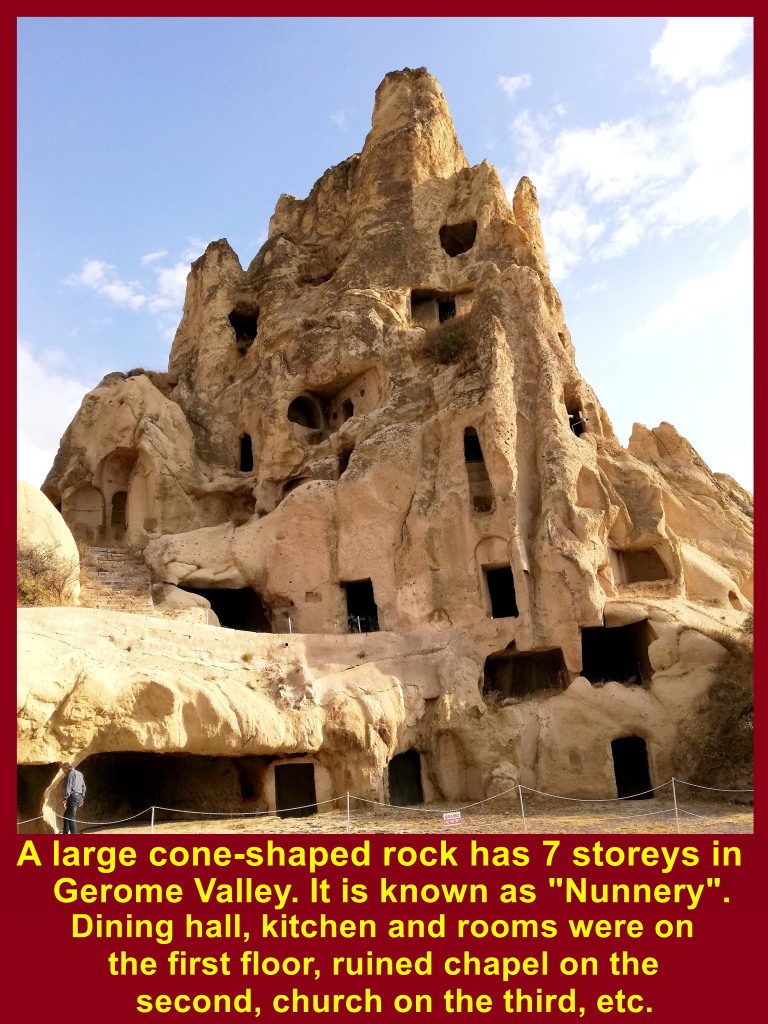
(ii) This large rock housed three rooms next to each other: Larder, Kitchen and Refectory in Gerome Valley.
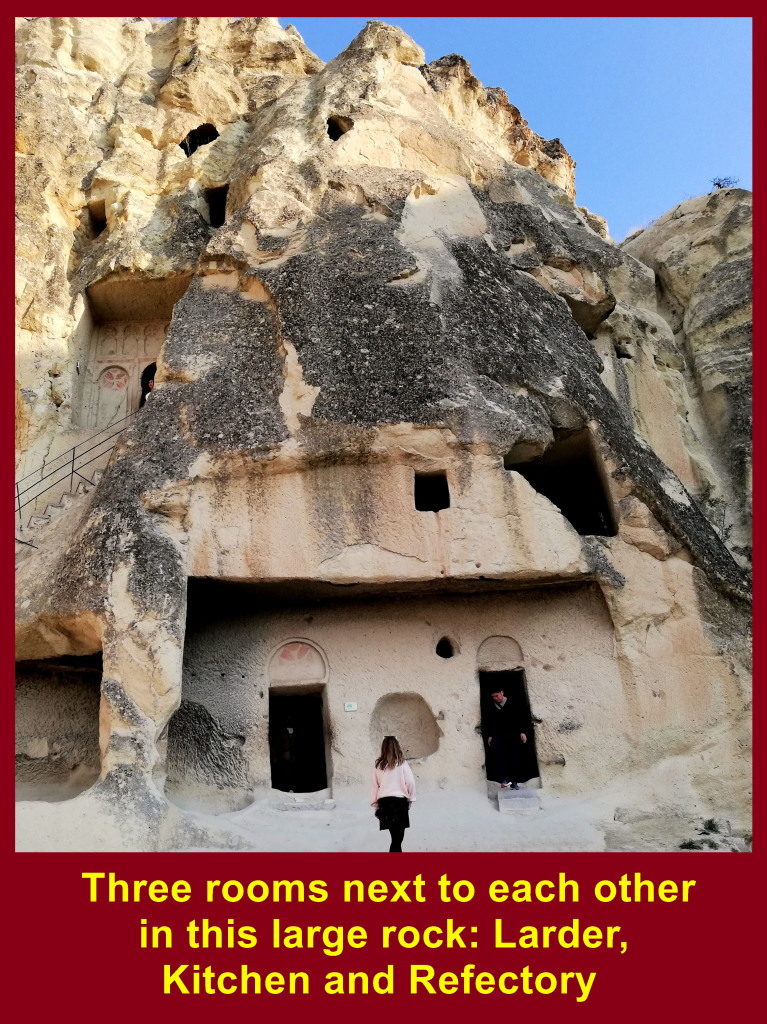
(iii) Karanilik Church in Gerome Valley
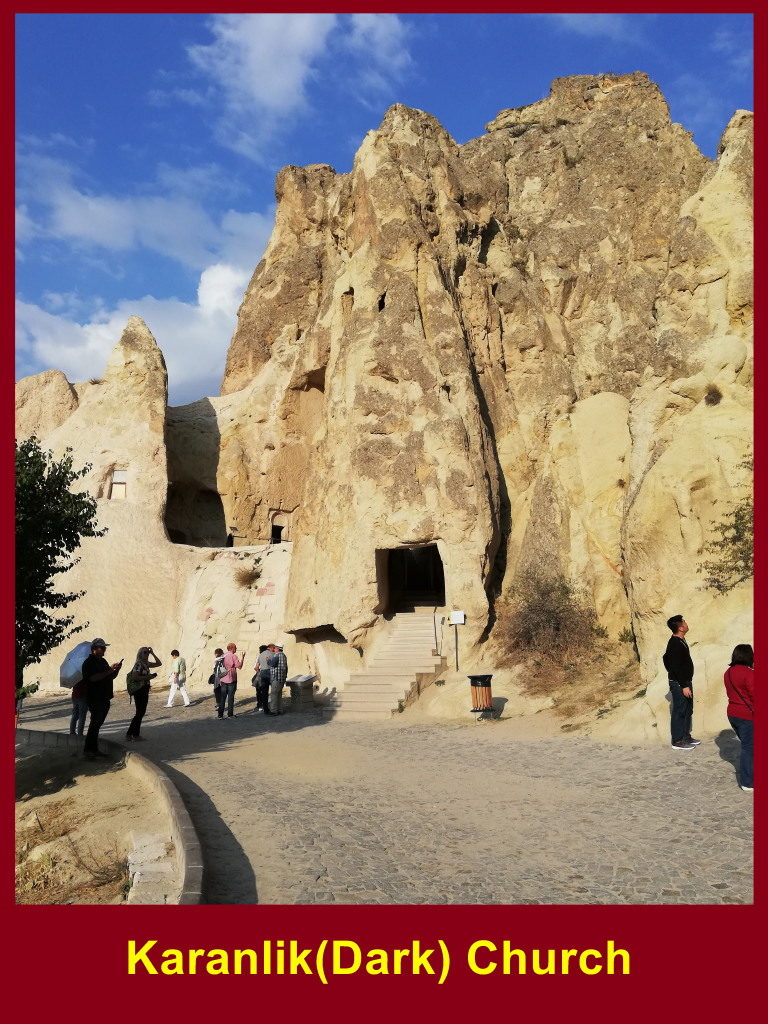
(iv) Yilani(Dark) Church of St. Onuphrius in Gerome Valley
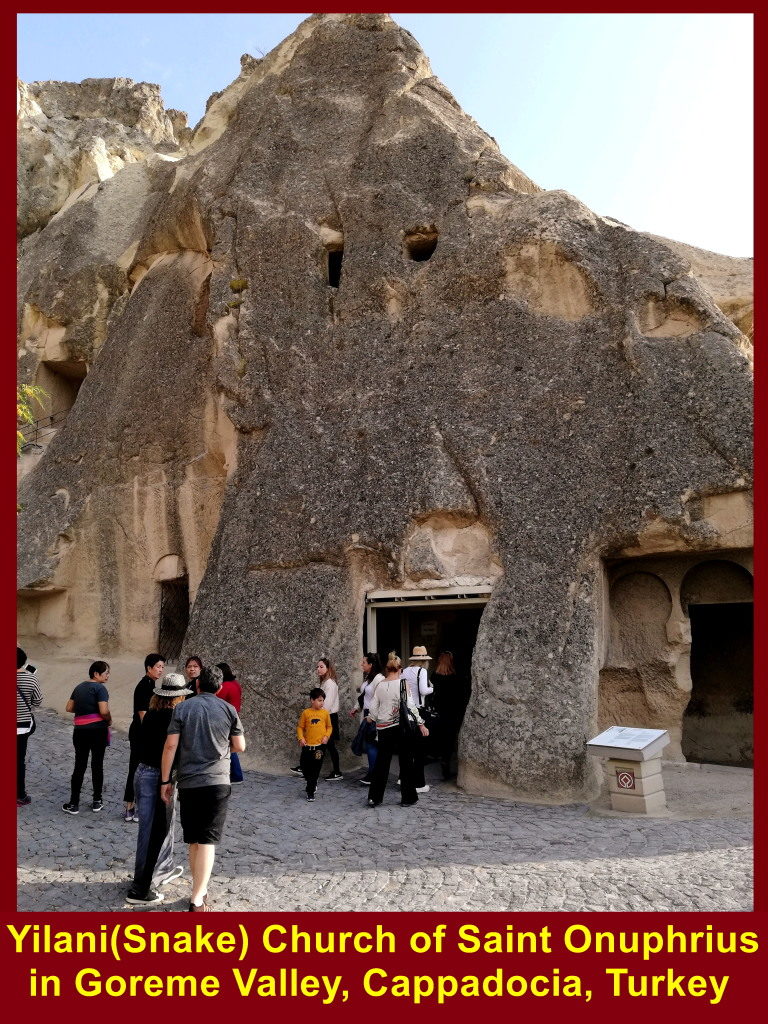
(v) Church of Tokali(Buckle) in Gerome Valley

(vi) A staircase outside a church in Gerome Valley
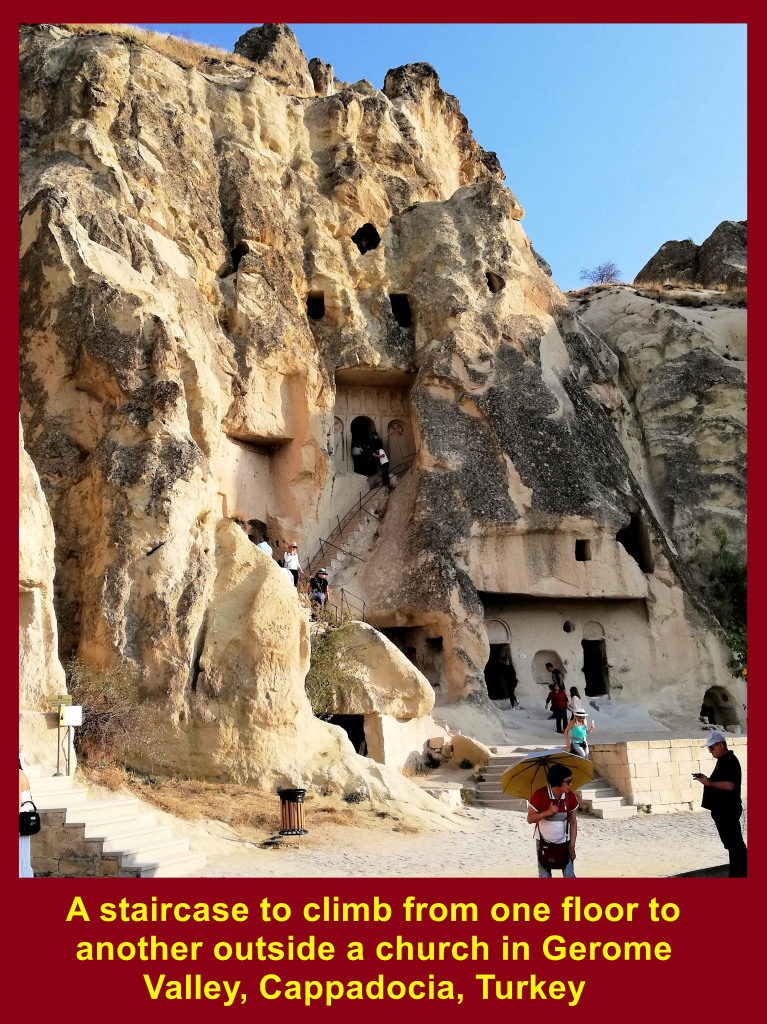
(vii) Close-up view of a staircase outside the church in Gerome Valley
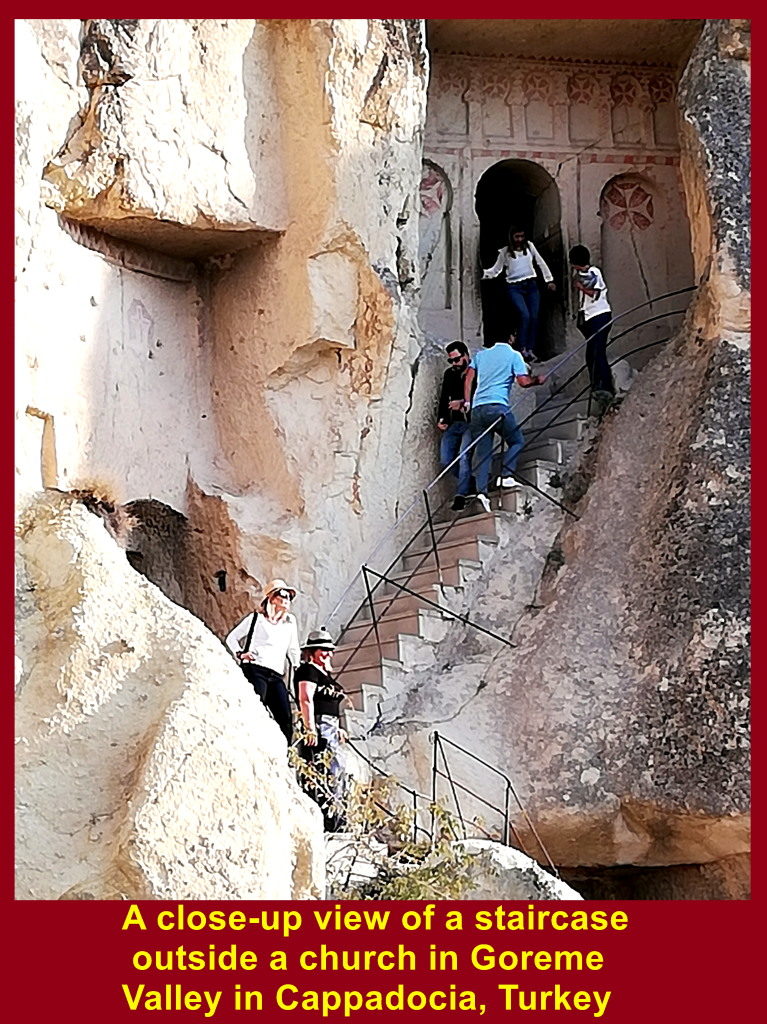
(viii) A chapel in a church in Gerome Valley
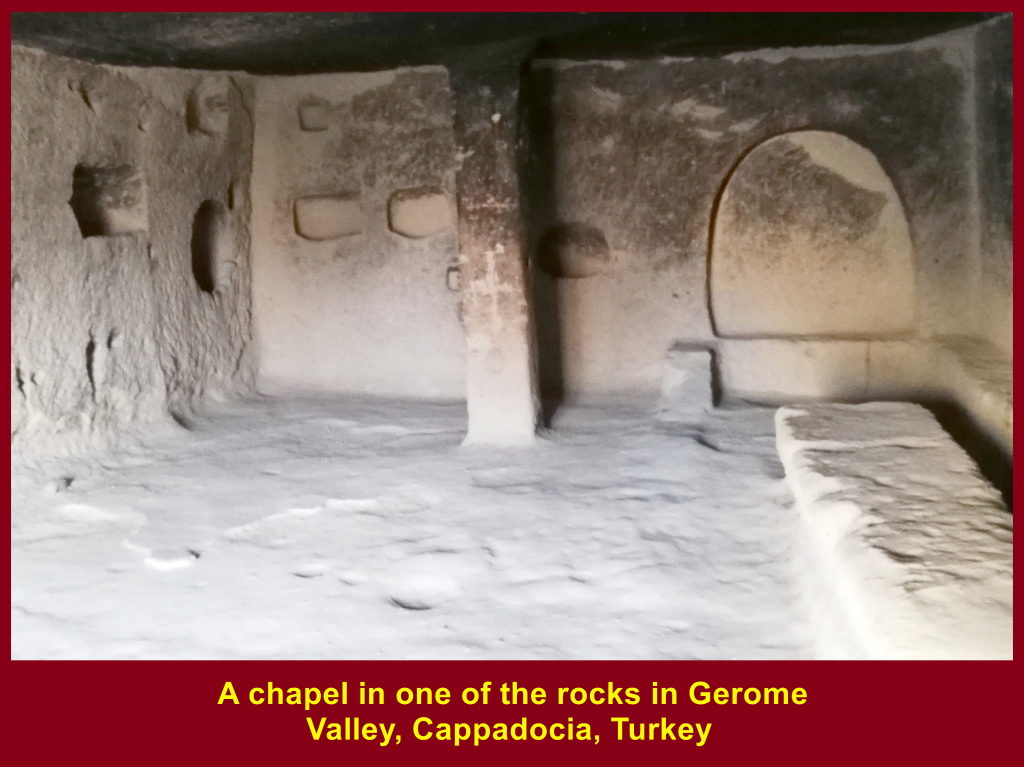
(ix) Most of the churches in Goreme Valley had frescos of Christian figures on the walls and ceilings. The photo below shows some of them found inside the churches.
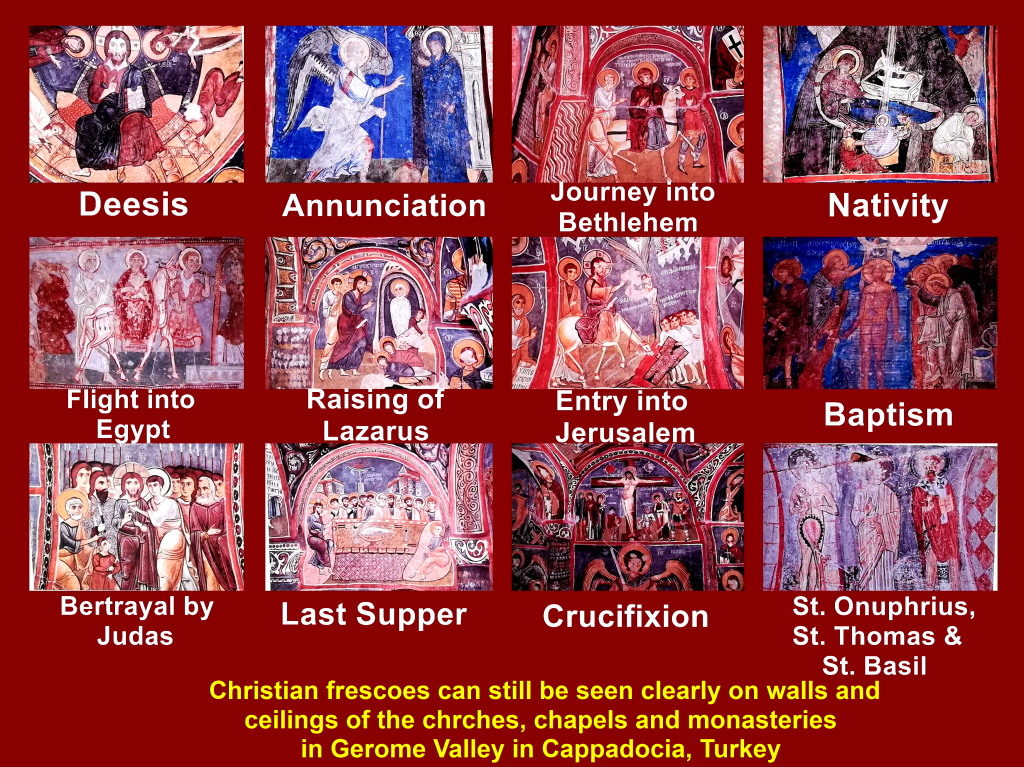
(ix) A dweller’s home in a rock in Gerome Valley in the olden days
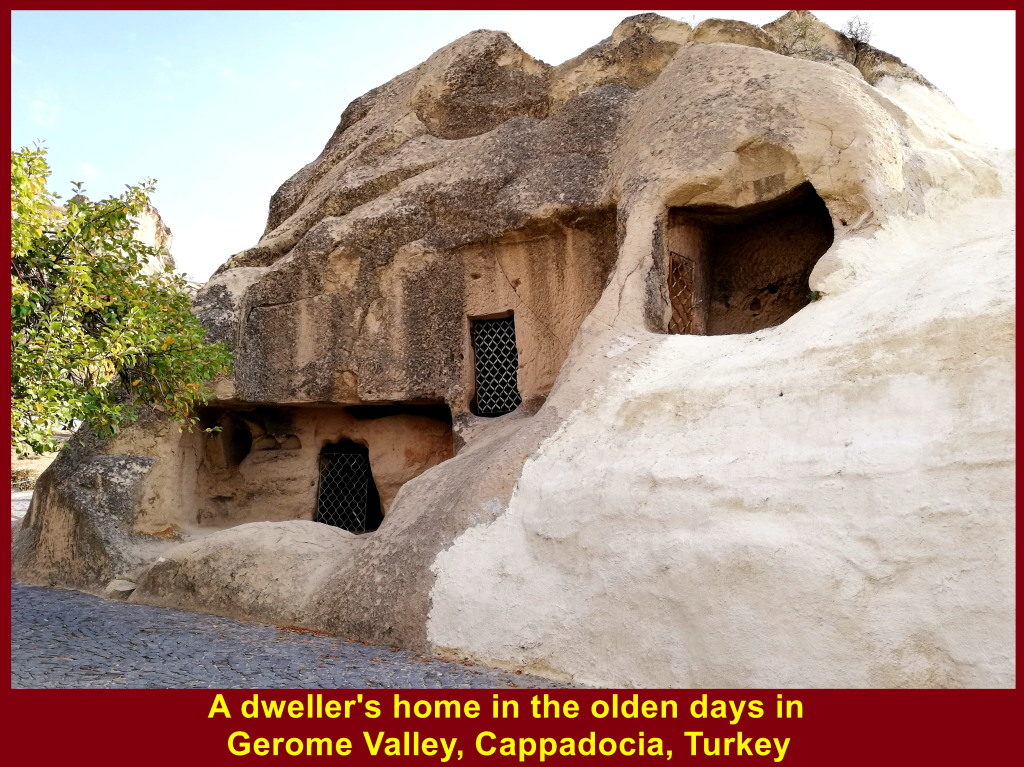
Evranos Restaurant
In the evening writer and tourmates went to a restaurant, Evranos Restaurant, in Cappadocia, Turkey, to dine and watch a Turkish Night show.
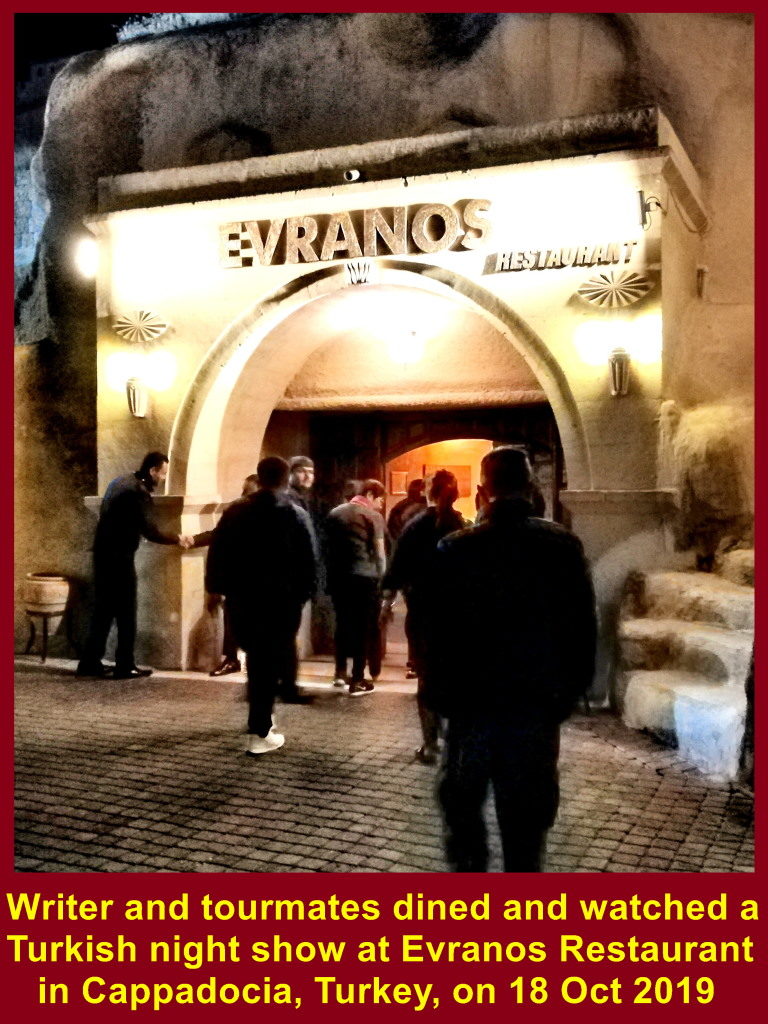
Turkish Night Show
Writer and tourmates were waiting, patiently, for the Turkish show to start at Evranos Restaurant in Cappadocia, Turkey, on 18 Oct 2019.
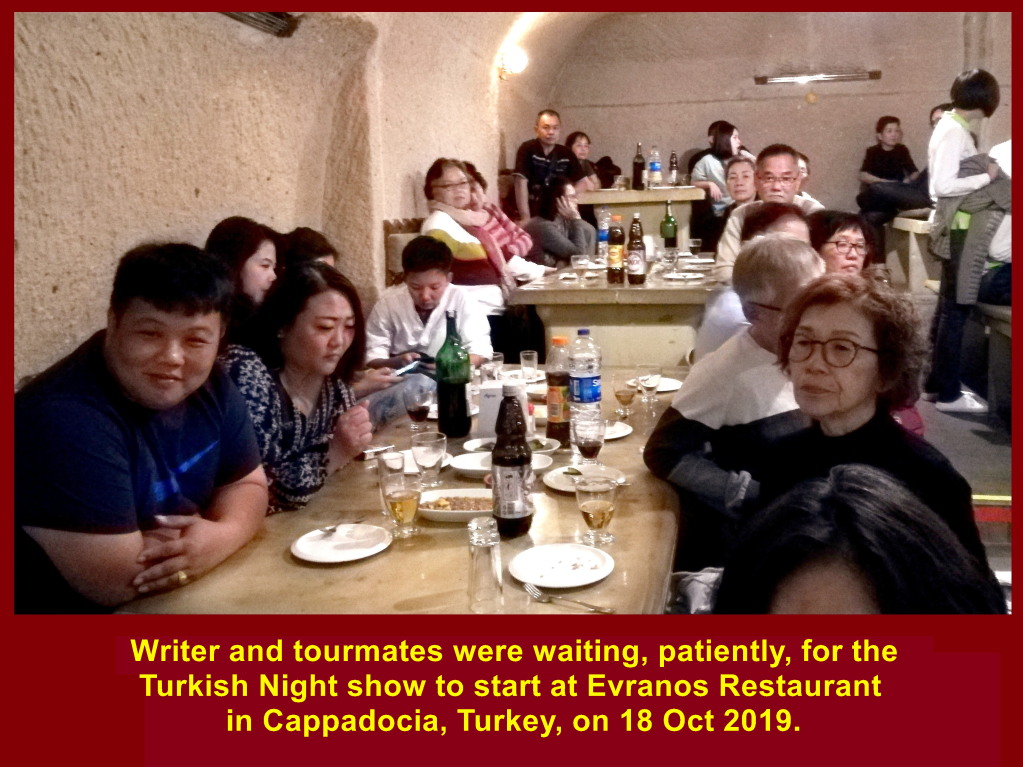
Foreign guests were also waiting, patiently, for the Turkish Night show to start at Evranos Restaurant in Cappadocia, Turkey, on 18 Oct 2019.
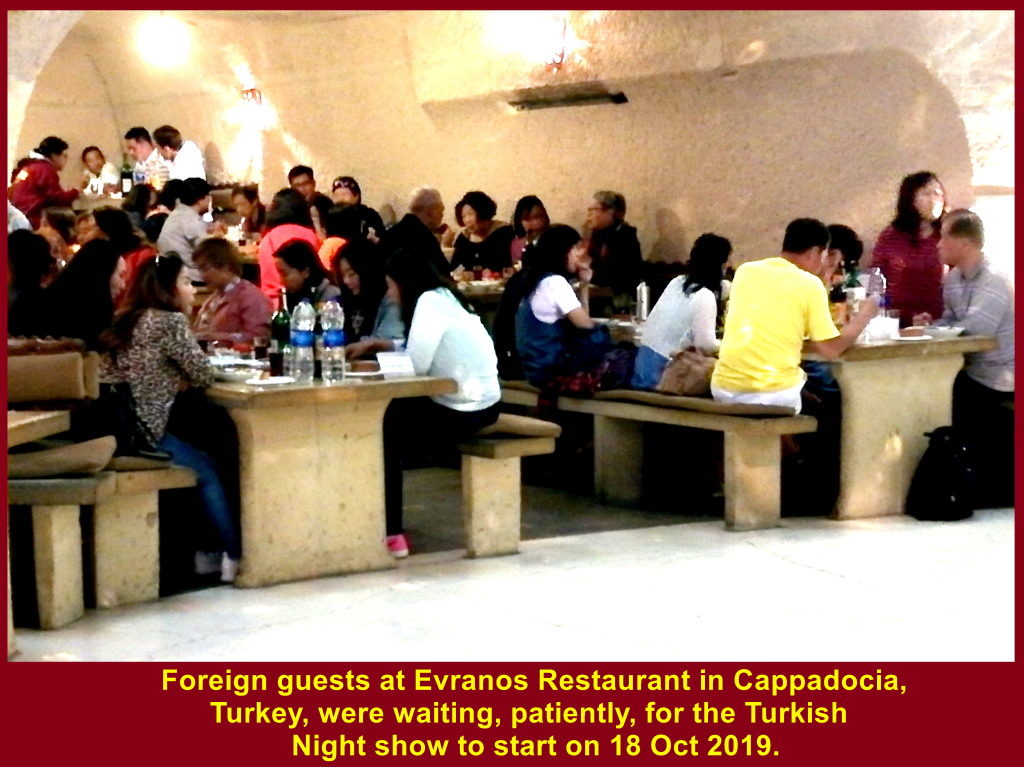
Three elderly Turkish musicians of the restaurant were playing musics before the show began.
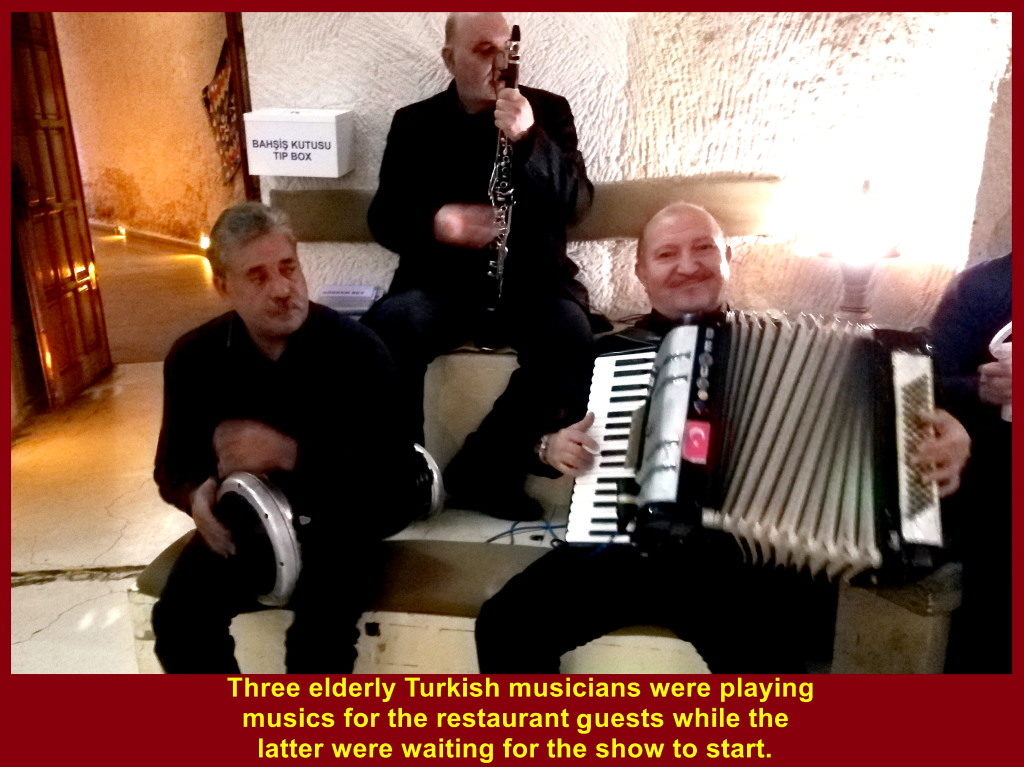
At 8.20 p.m. the show started. Several men dressed in traditional costumes appeared on the floor and did a traditional dance.
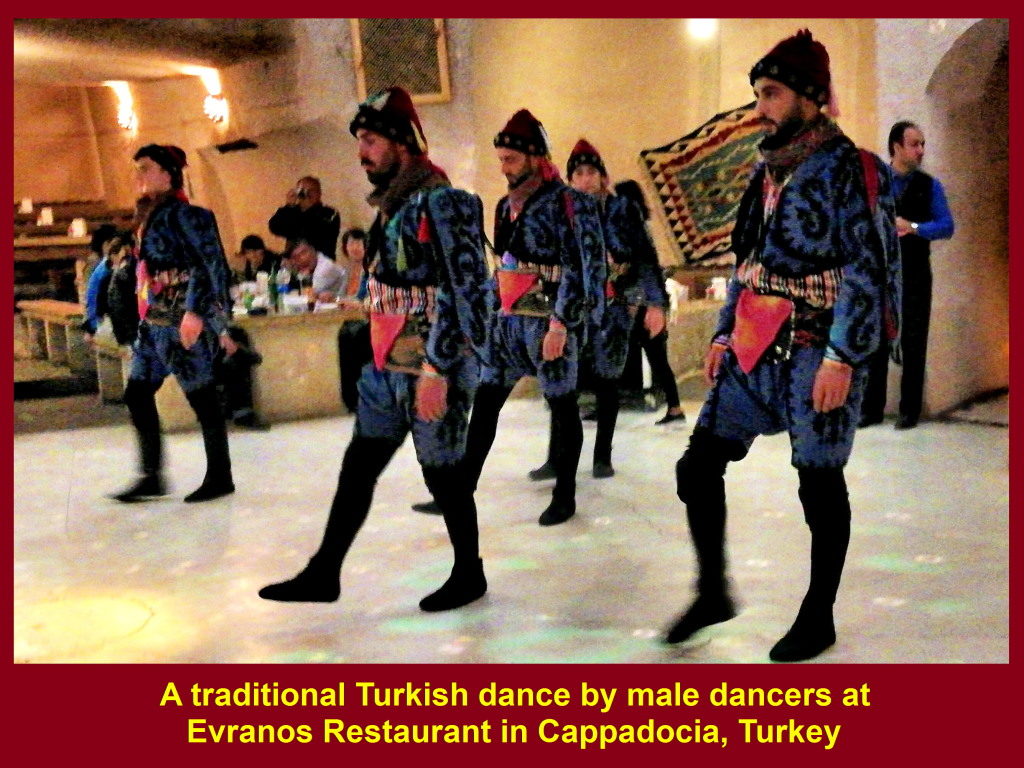
Then a few ladies appeared and danced, gracefully.
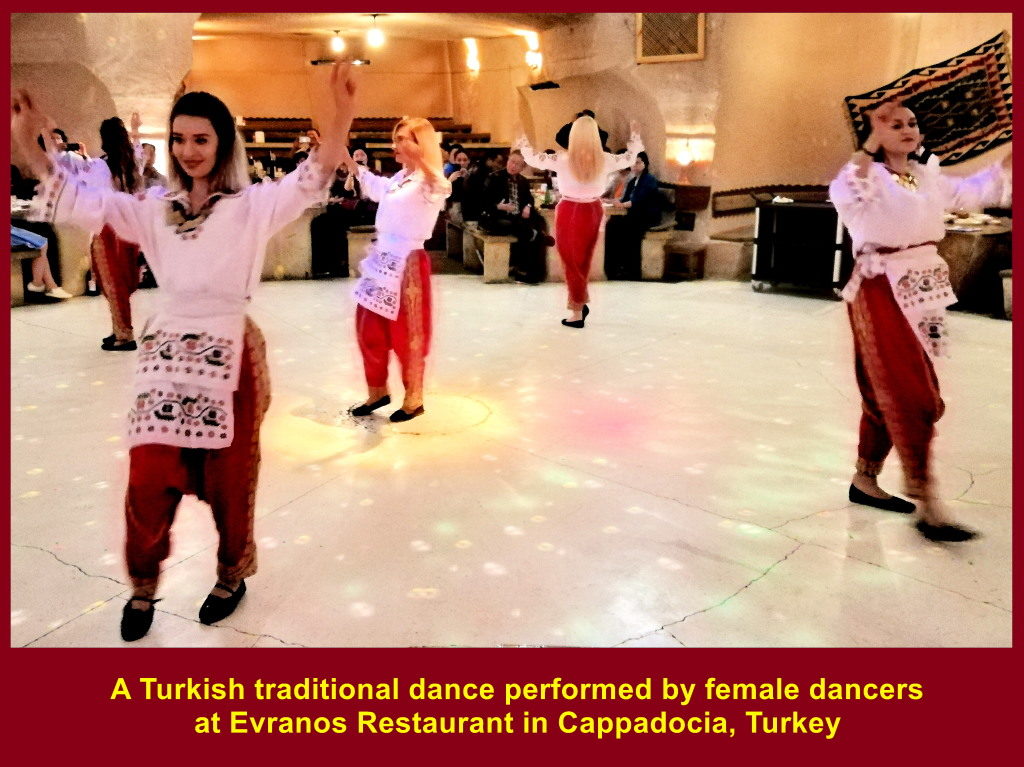
After the dance performed by the ladies, a Turkish traditional wedding ceremony was performed.
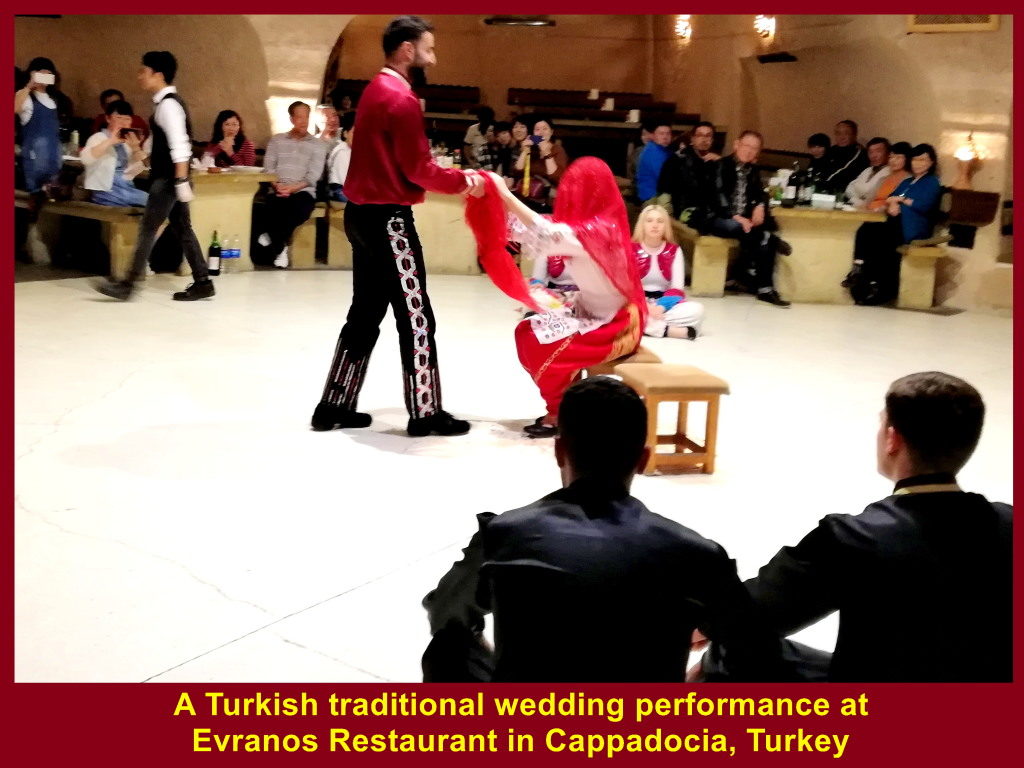
When the wedding ceremony was over, the performers invited some guests to the floor to dance their traditional way.
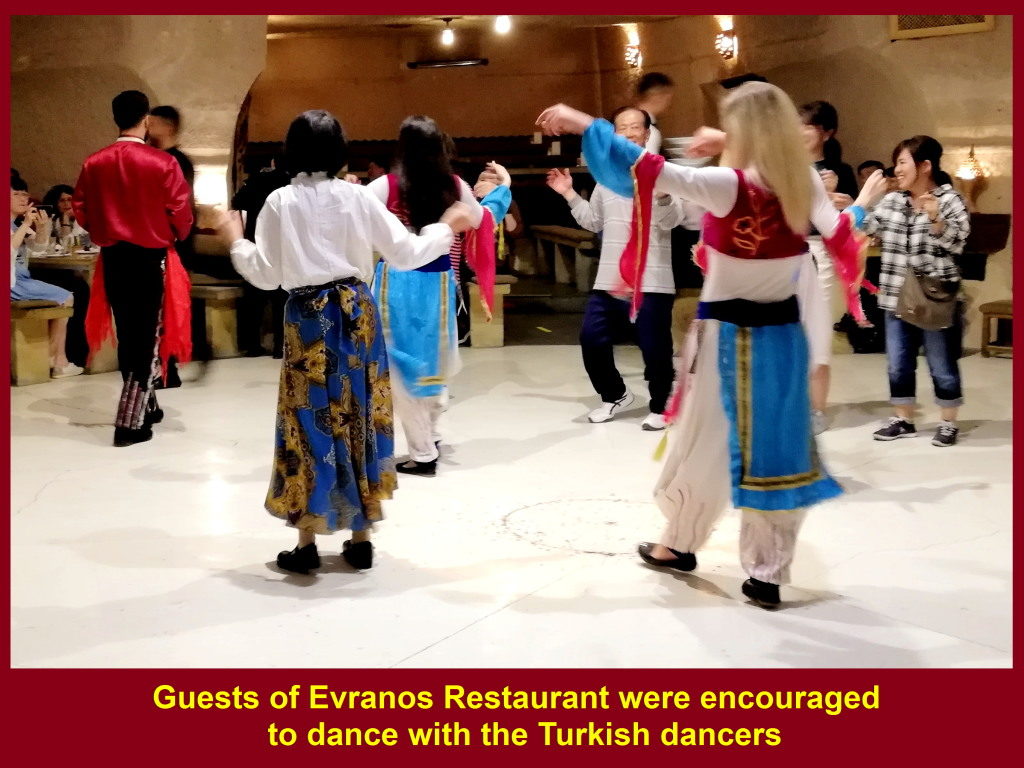
Finally, the highlight of the show was the belly dance. It was performed by a fair, pretty Turkish lady. She began dancing with two “white wings and then other dances.
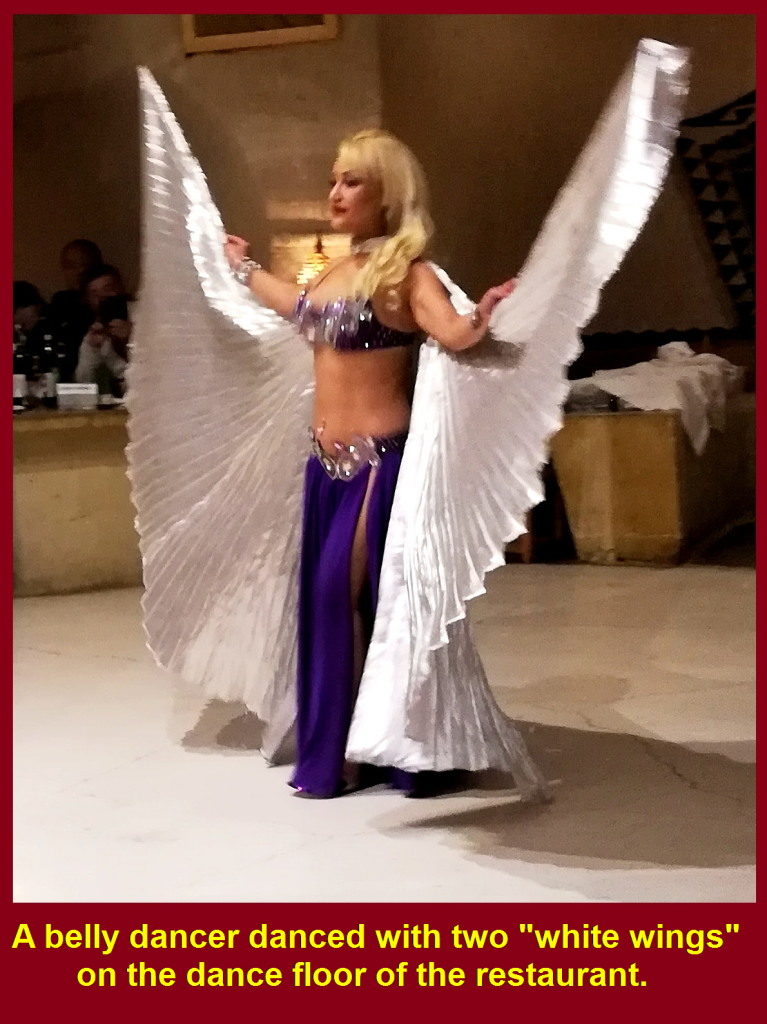
Occasionally, she did some sensual movements in her dance to the delight of the guests.
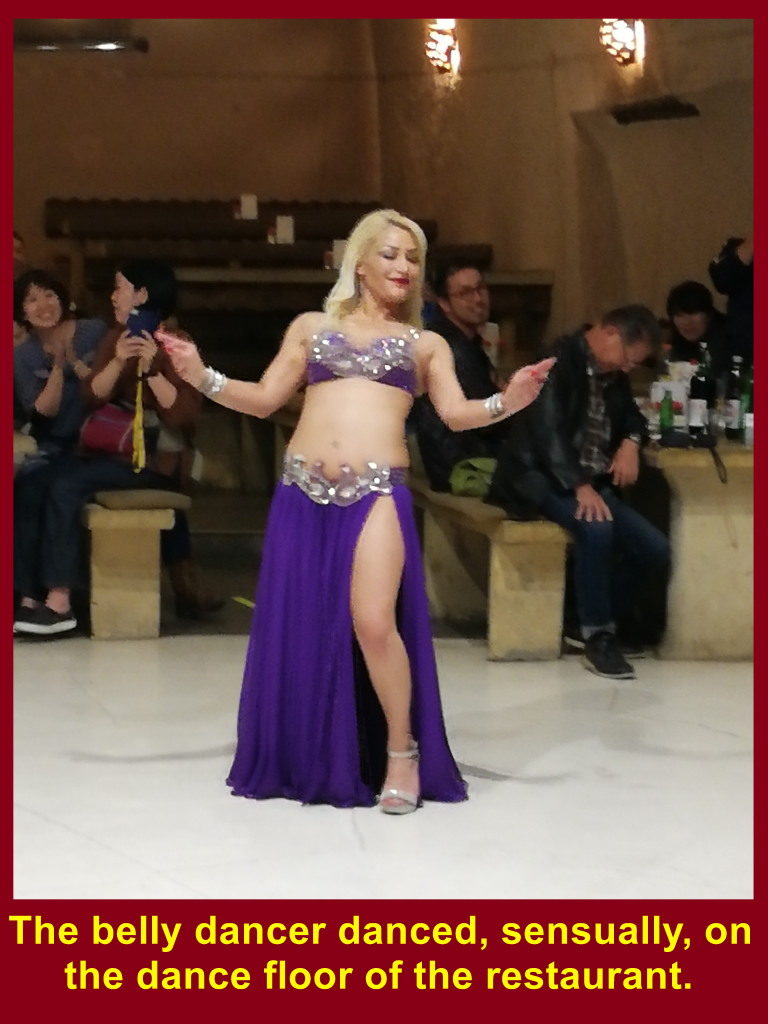
After dancing, the lady went round looking for a male guest.
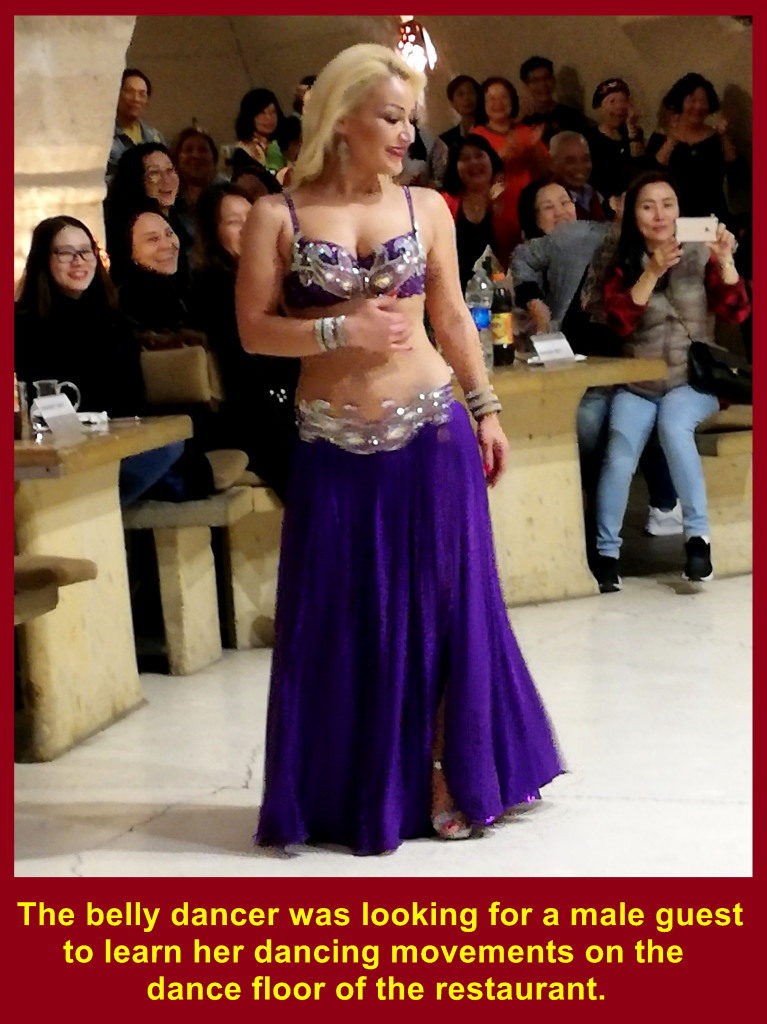
When she spotted one, she invited him to the floor and asked him to follow her basic belly dance movements. His movements were stiff.
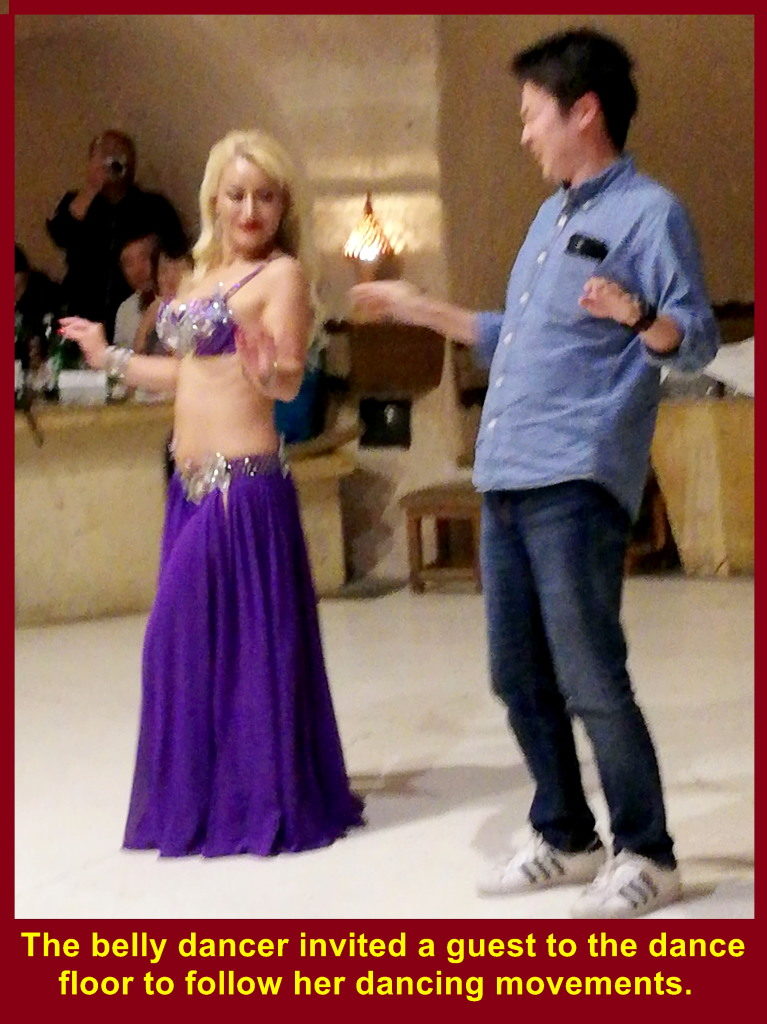
Later, she invited another male guest and asked him to follow her sensual body movements. He made us laughed at his clumsiness, but we liked him as he was very sporting.
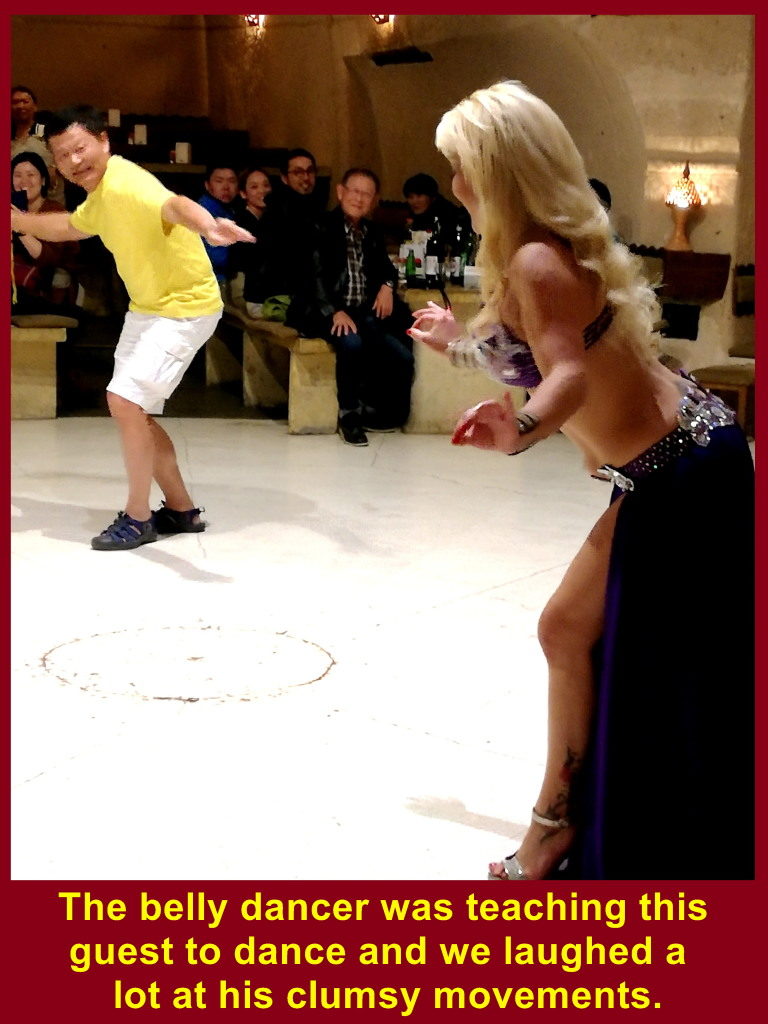
Back to Dilek Kaya Hotel
After an hour of enjoyment at Evranos Restaurant in Cappadocia, Turkey, we went back to our hotel, Dilek Kaya Hotel, nearby and stayed there for another night.
Previous Page / Home / Next Page
Places visited during Turkey Tour(13-22 Oct 2019):
Trojan Horse/Ancient Troy Cities Asklepion Ephesus Hierapolis/Pamukkale Travertine Sultanhani Caravanserai Pasabag Valley Uchisar Valley/Kaymakli Underground City Gerome Valley/Turkish Night Show Hot Air Balloon/Lake Golu/Anitkabir Hagia Sophia/Topkapi Palace/Blue Mosque Bosphorus Boat Cruise Spice Bazaar/Grand Bazaar
Turkey Travel Part IX: Hot Air Balloon, Lake Tuz & Anitkabir
Filed under: Hot Air Balloon, Lake Golu, Anitkabir, Turkey Travel
(Continued from previous page)
Day 7
Saturday, 19 Oct 2019
Hot Air Balloon Ride
Early in the morning, 22 of our tourmates went to a place, Goreme, near our hotel, Dilek Kaya Hotel, to ride a hot air balloon in Cappadocia, Turkey.
Writer and wife did not go with them as they had the same ride in Luxor, Egypt, in 2017.
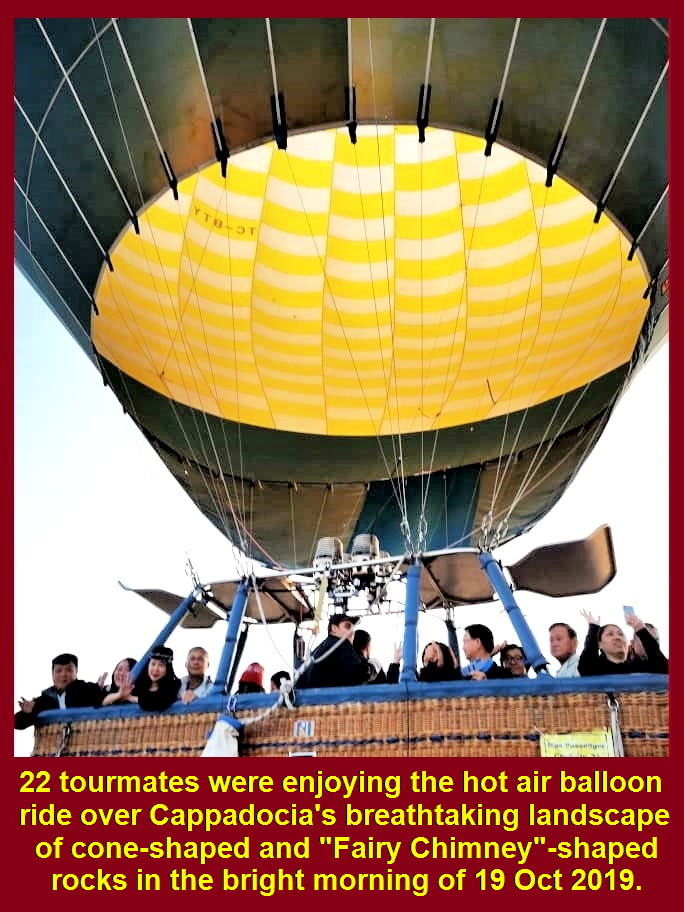
The following photos below show the hot air balloon activities in Cappadocia in the morning of 19 Oct 2019.
(i) One balloon had lifted off and the other would soon follow.
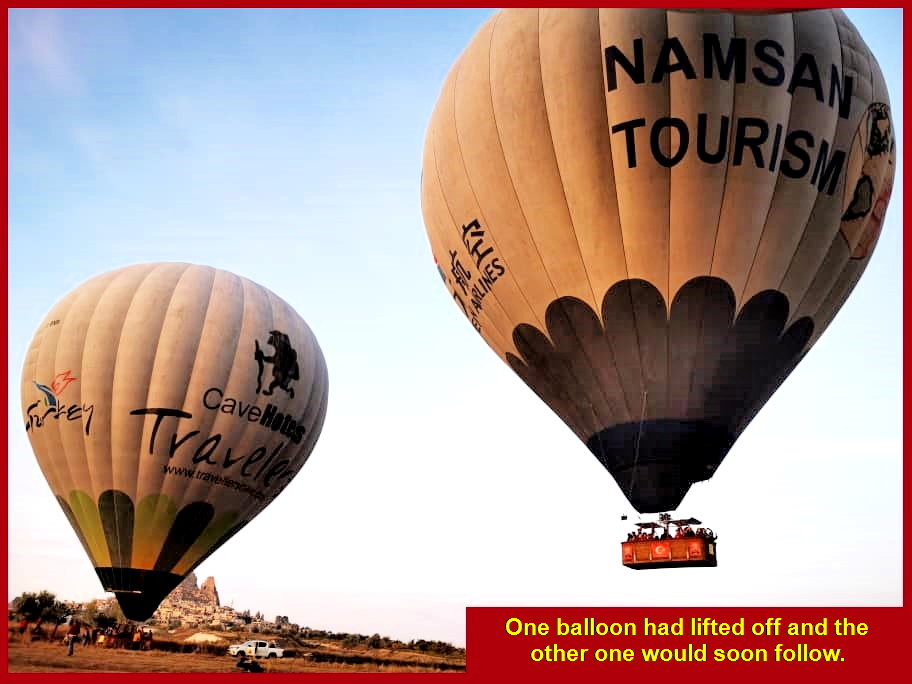
(ii) Many balloons were already in the sky when the sun appeared in the east.
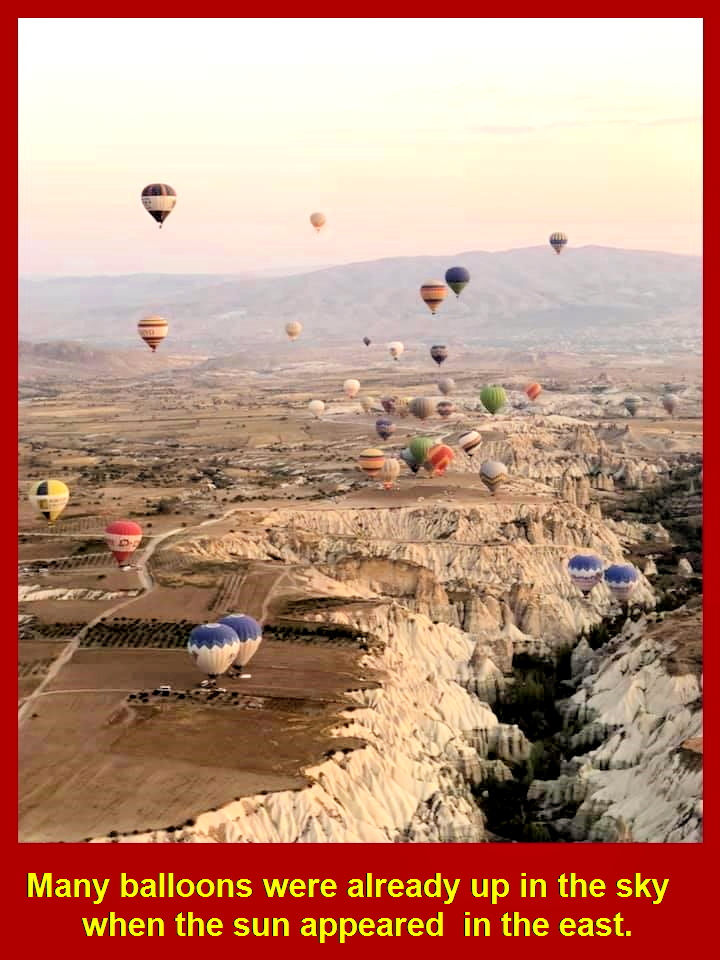
(iii) Lots of balloons in the sky in the bright morning of 19 Oct 2019 in Cappadocia.

(iv) Riders of the balloons were enjoying the breathtaking view of the land below them in Cappadocia in the bright morning of 19 Oct 2019.
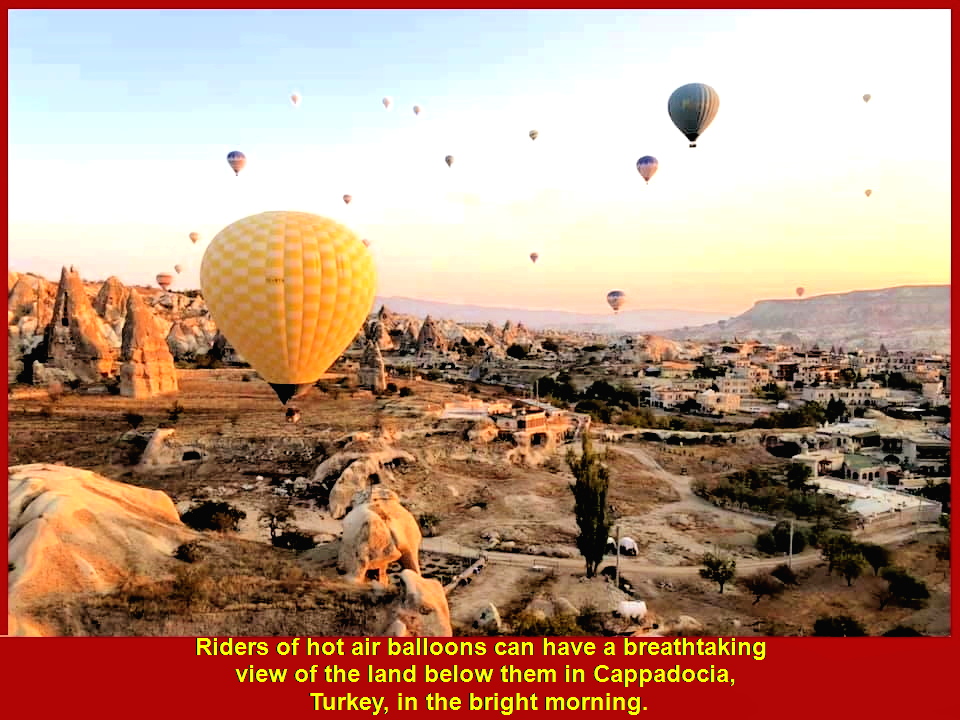
(v) Writer who stayed at the hotel, Dilek Kaya Hotel, Cappadocia, spotted two hot air balloons floating in the air at 7.40 a.m. on 19 Oct 2019.
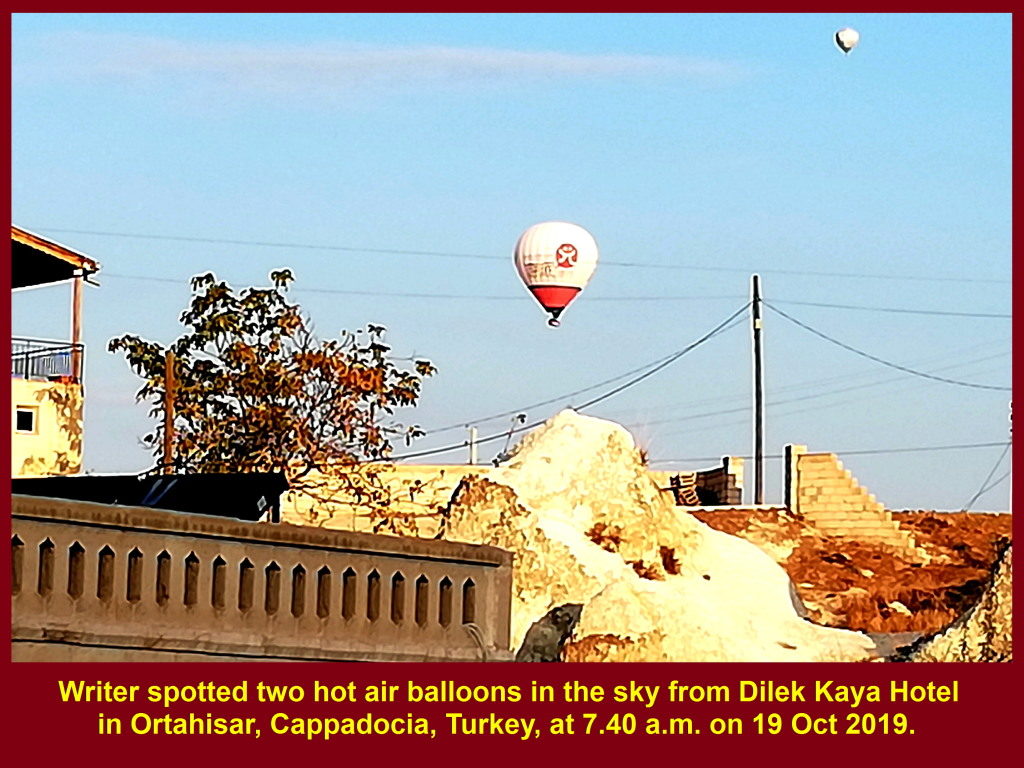
Departure for Ankara from Cappadocia
At 10 a.m. we left Dilek Kaya Hotel in Cappadocia and continued our Turkey tour to Ankara, the capital of Turkey, that had a population of 5.5 millions in 2018.
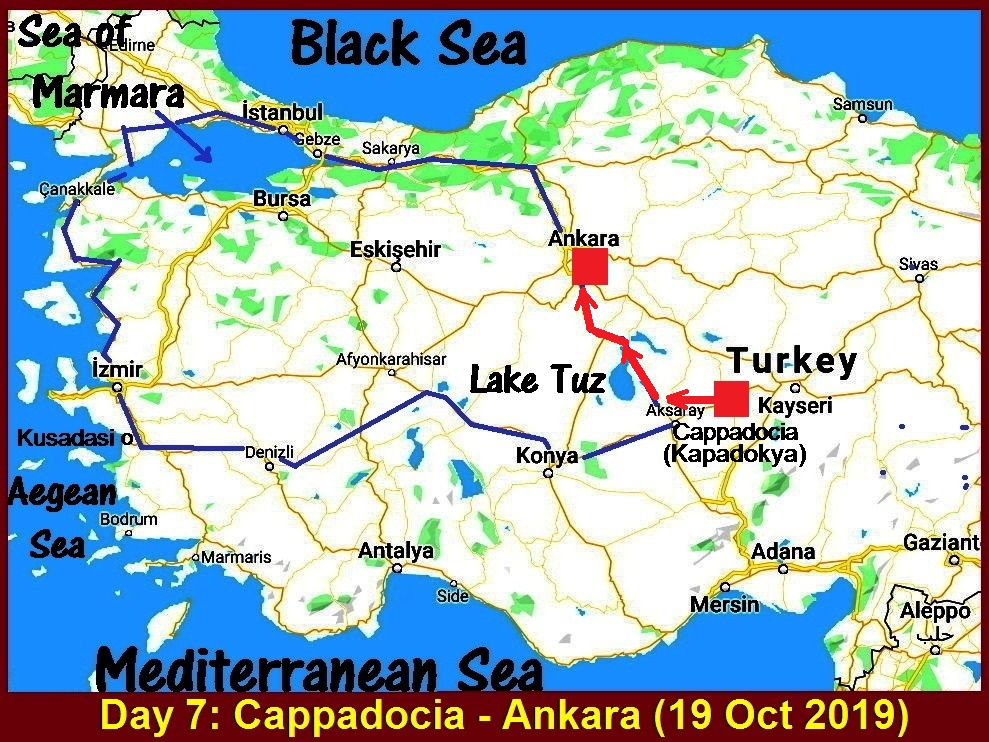
Lake Tuz
After travelling for more than an hour, we stopped by a large lake, Lake Tuz, which is the second largest in Turkey. It is located 150 km south-east of Ankara.
Breeding Ground for Flamingos
The picture below shows Lake Tuz(Tuz Golu). It is a breeding ground for tens of thousands of flamingos in the middle of every year.
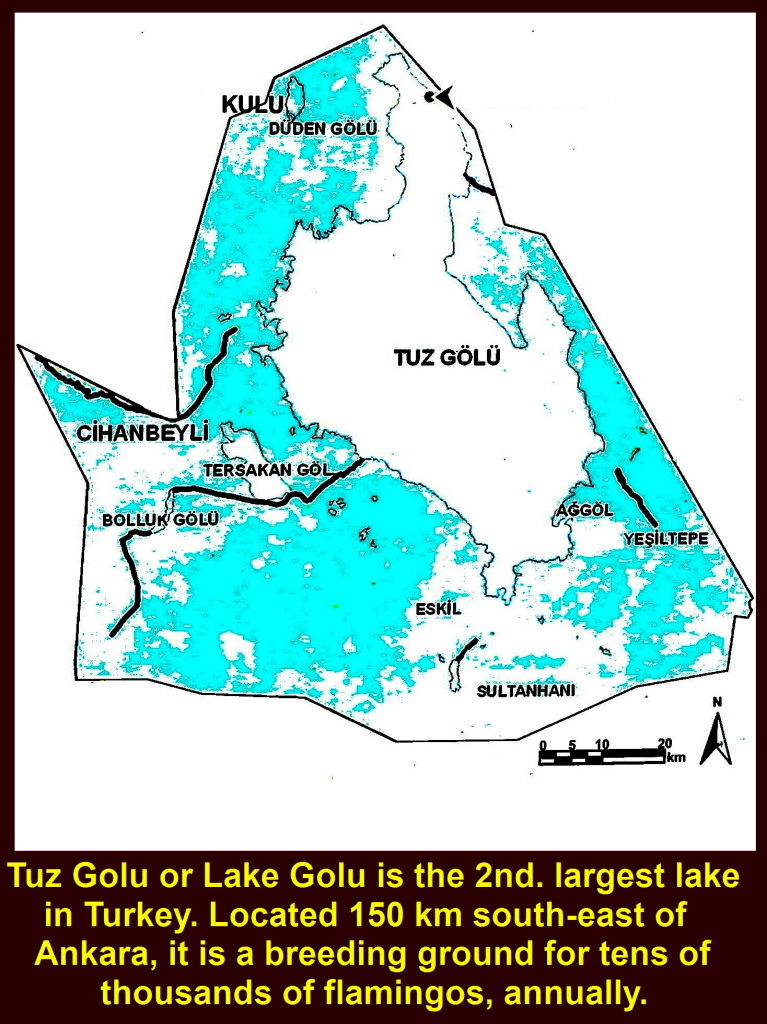
Writer and tourmates visited Lake Tuz(Tuz Golu) on 19 Oct 2019.
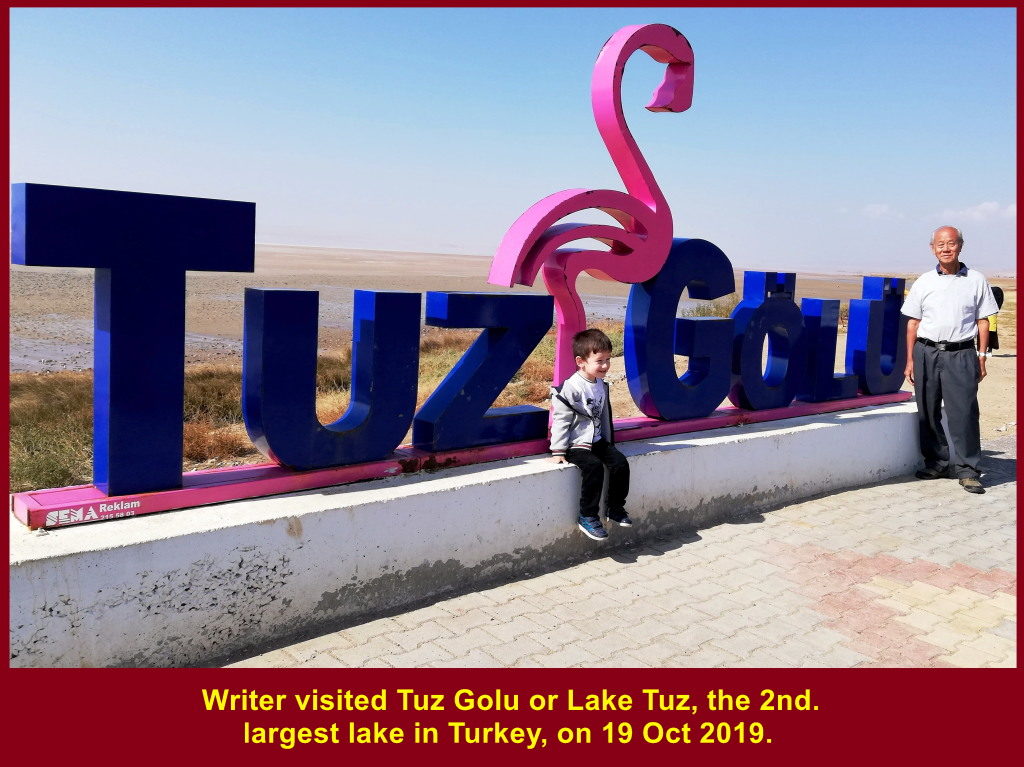
Salty Shore
The shore of Lake Tuz is salty. We were not lucky to see any flamingo around when we were there on 19 Oct 2019. Flamingos are migratory birds and they fly to the lake to breed in summer.
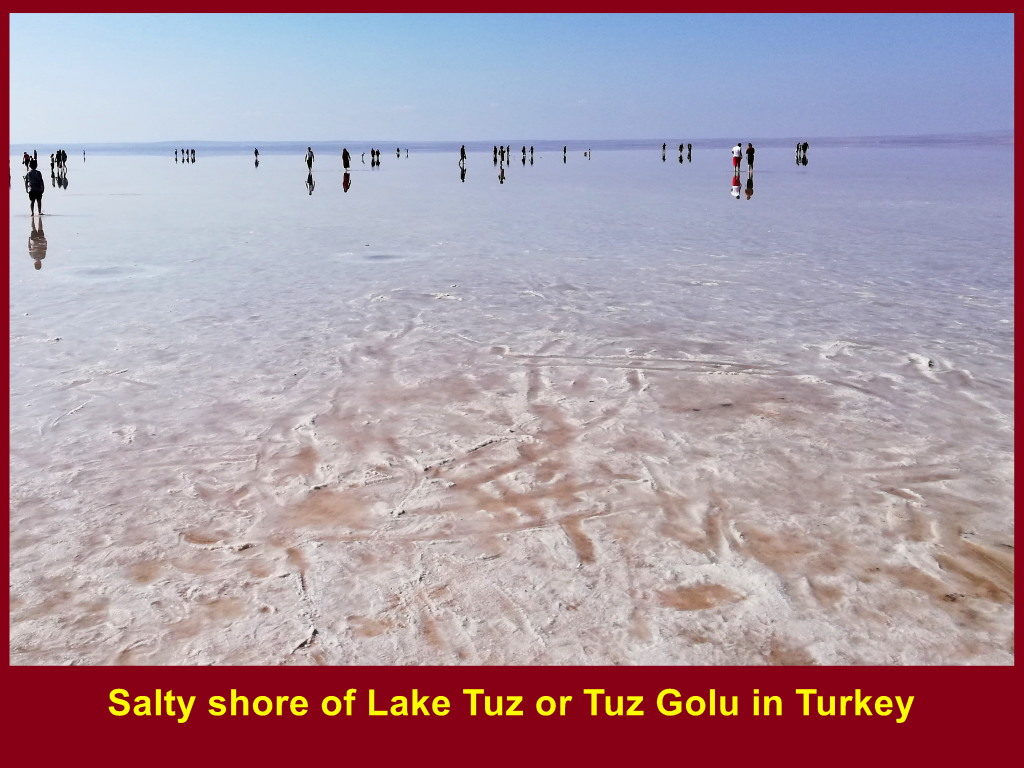
Flamingos
This picture shows a flamingo with white feather on its body and red feathers on its wings. It has two long pink legs and black curved beak. Birds of this kind migrate to Lake Tuz, annually.
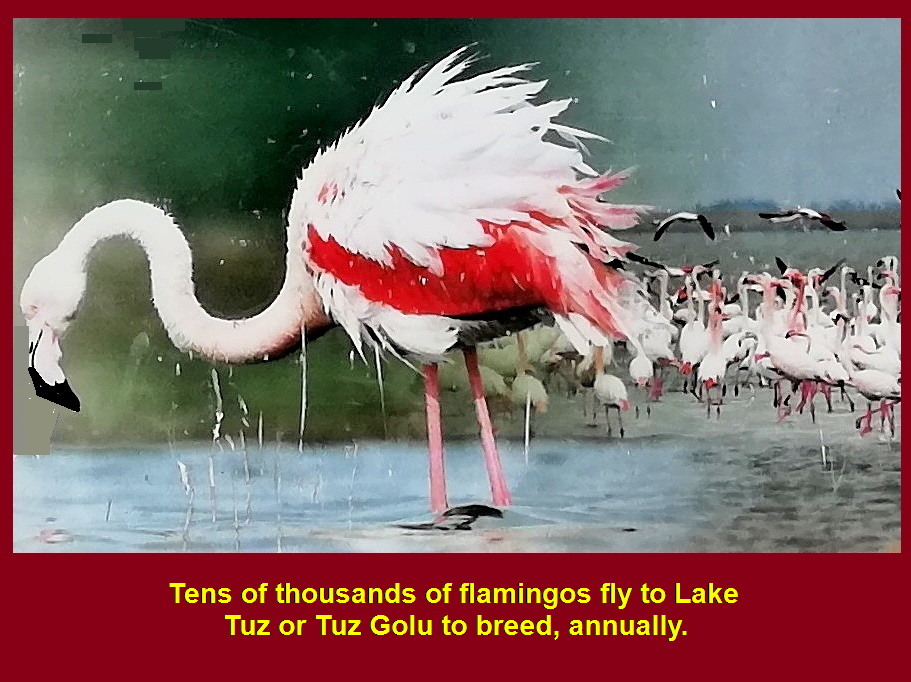
Journey to Ankara
At 12.30 p.m. we left the salt-lake, Lake Tuz, and went straight to Ankara.
Two hours later, we arrived at Ankara, the capital of Turkey.
Anitkabir, Mausoleum of Mustafa Kemal Ataturk.
In Ankara, the first place we visited was Anitkabir, the Mausoleum of the founder and first President of Republic of Turkey, Mustafa Kemal Ataturk.
Below is a picture of the Anitkabir, the Mausoleum of Mustafa Kemal Ataturk.
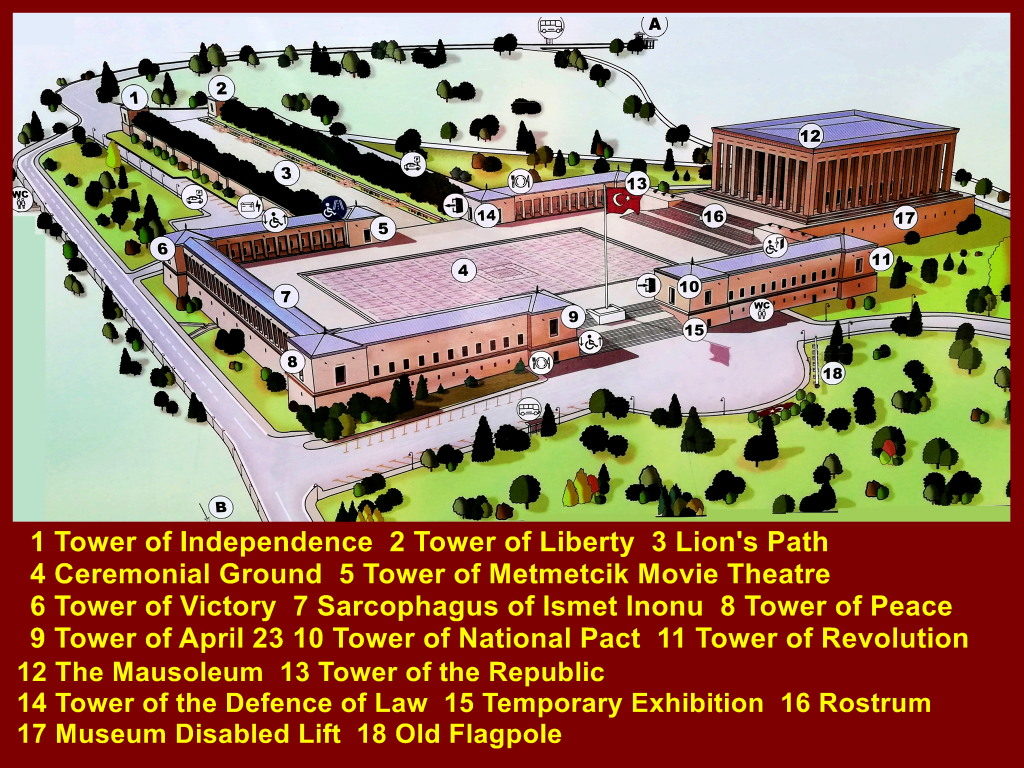
Entrance to Anitkabir, the Mausoleum of Mustafa Kemal Ataturk, in Ankara
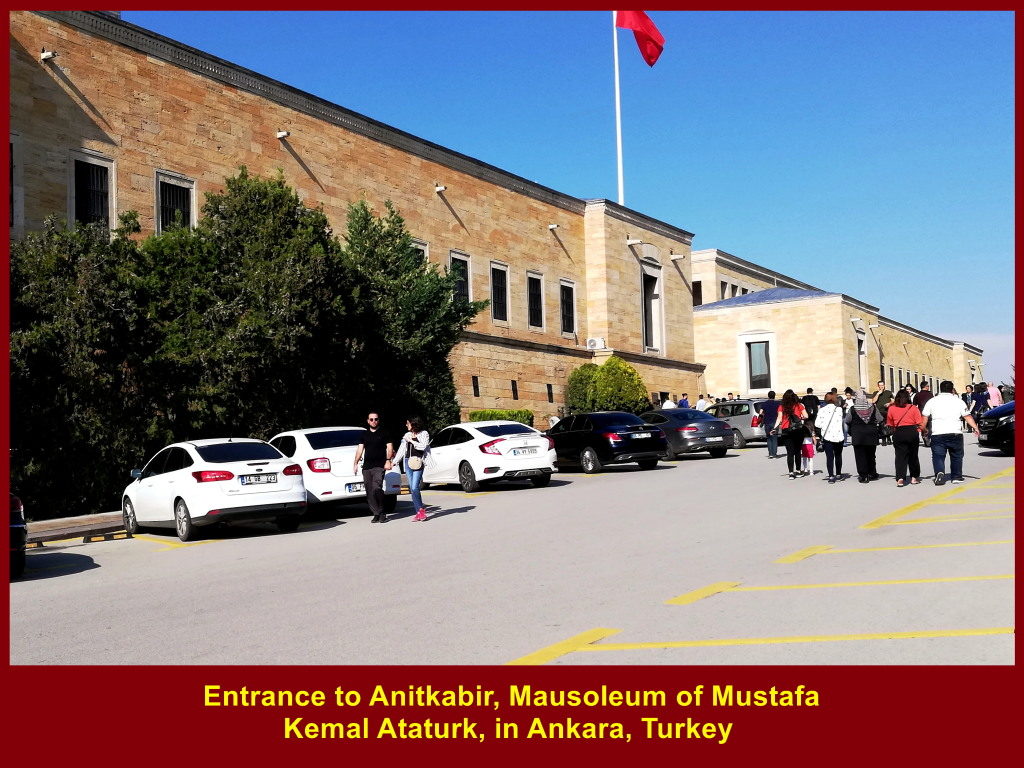
Writer and wife were in the courtyard of Anitkabir, the Mausoleum of Mustafa Kemal Ataturk, on 19 Oct 2019. It was opened in 1953 in memory of the Turkish hero.
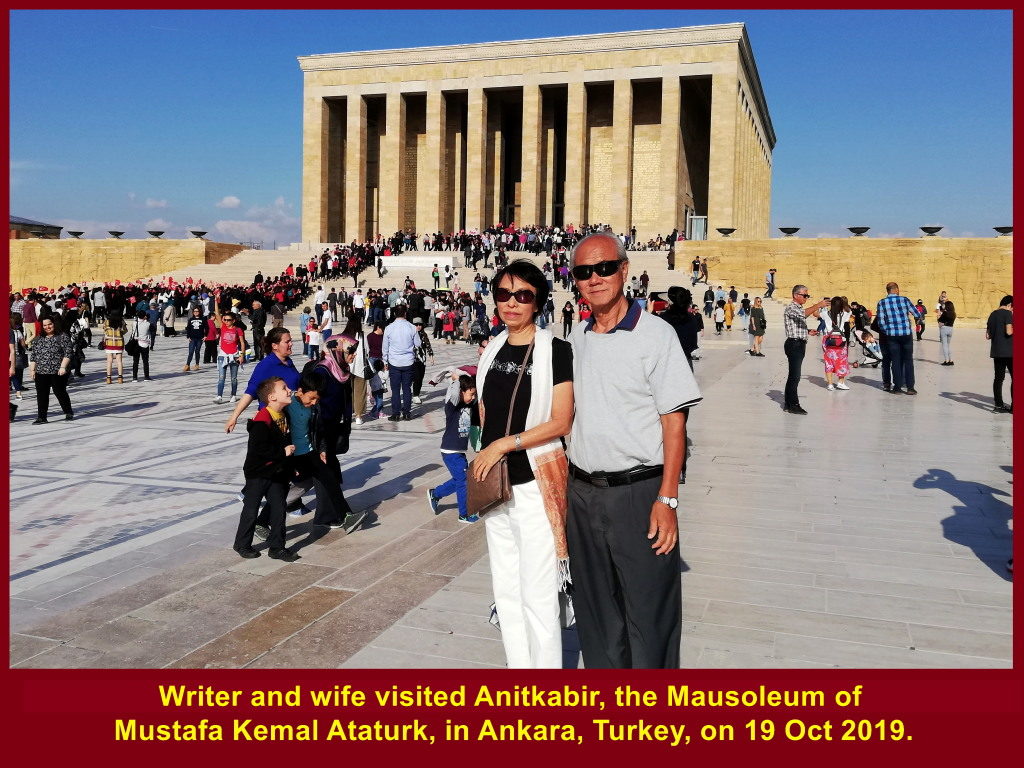
Founder and First President of Republic Turkey
Mustafa Kemal Ataturk(1881-1938) was the founder and first President of Republic Turkey in 1923. He made many reforms to make his country a strong, secular and modern state.
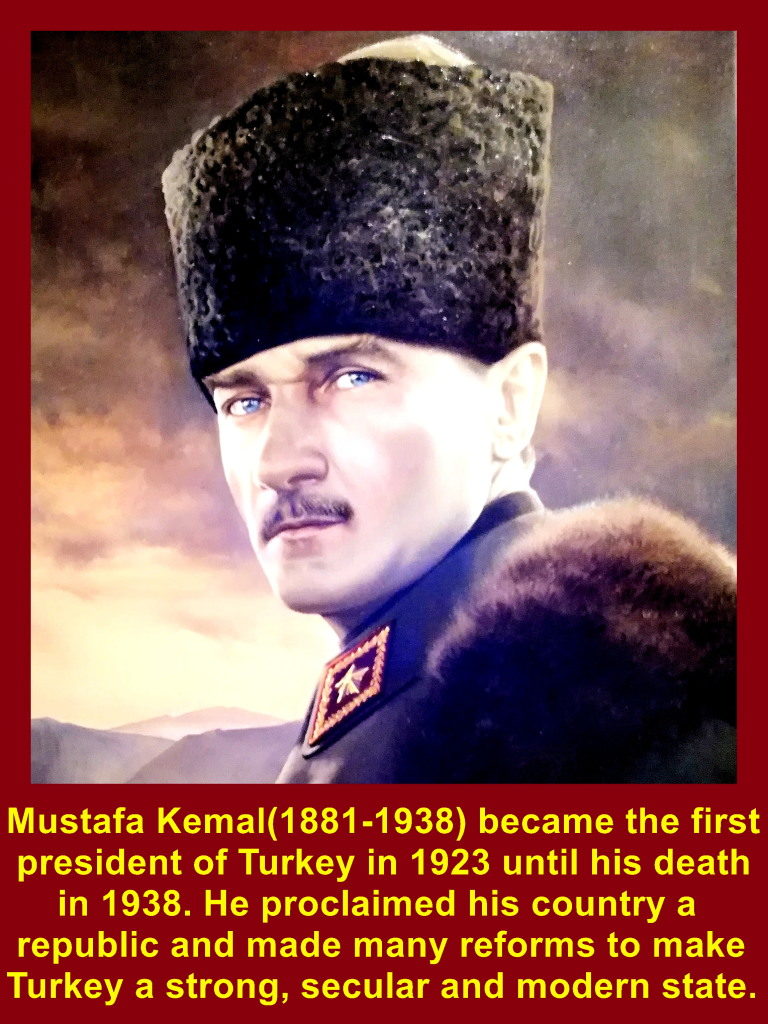
Symbolic Sarcophagus of Mustafa Kemal Ataturk
The symbolic sarcophagus of Mustafa Kemal Ataturk’s tomb in the Hall of Honour in Anitkabir in Ankara. His tomb is right under the sarcophagus on the ground floor.
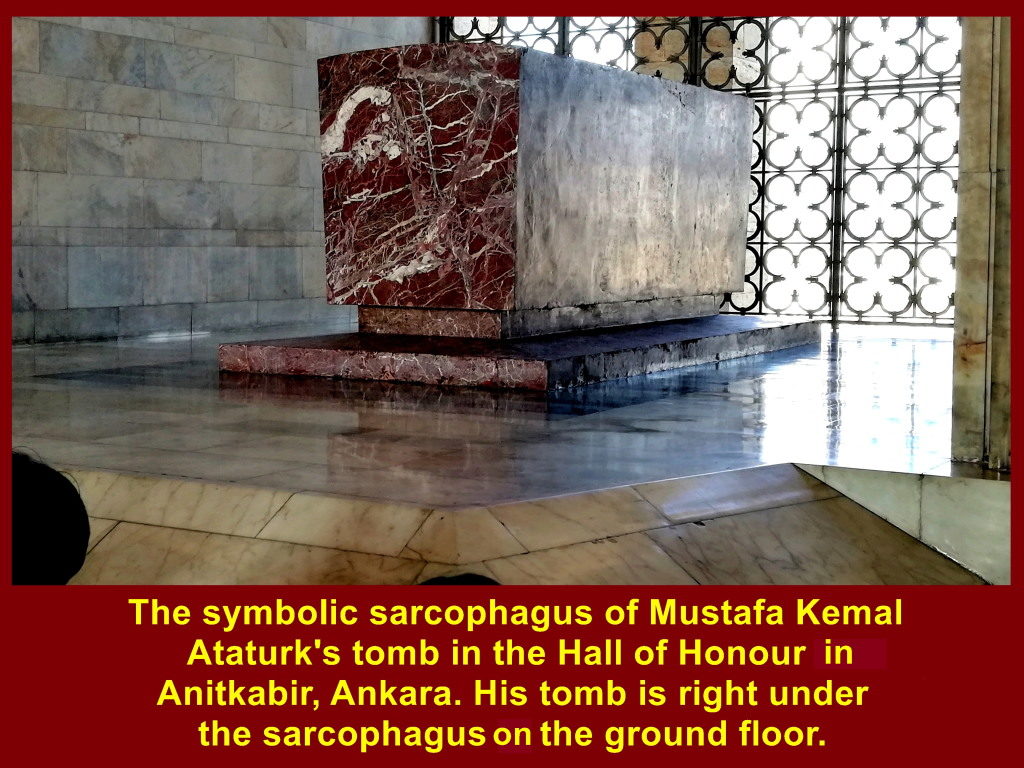
Mustafa Kemal Ataturk had fought in the 1st. World War(1914-1918).
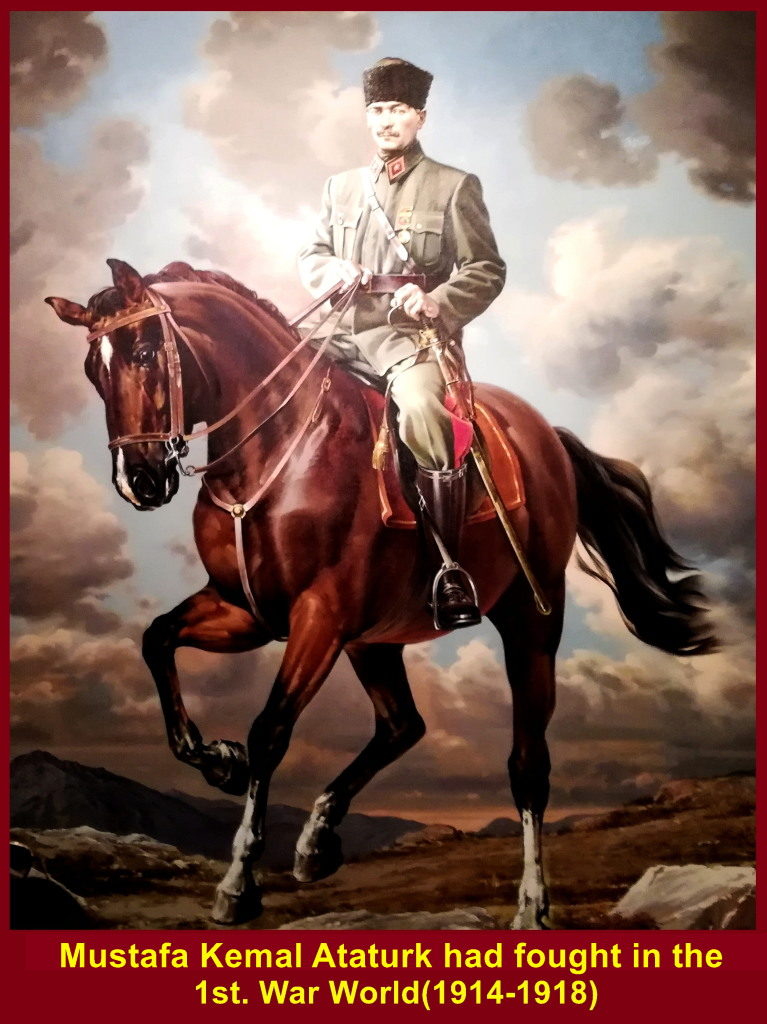
Western Front
Mustafa Kemal Pasha(Commander-in-Chief) and his men were sent off to the Western Front to fight against the Allied Powers in the Battle of Gallipoli(1915-16). The allied Powers wanted to control the sea route(Strait of Dardanelles) between Europe and Russia. The Turkish won the battle.
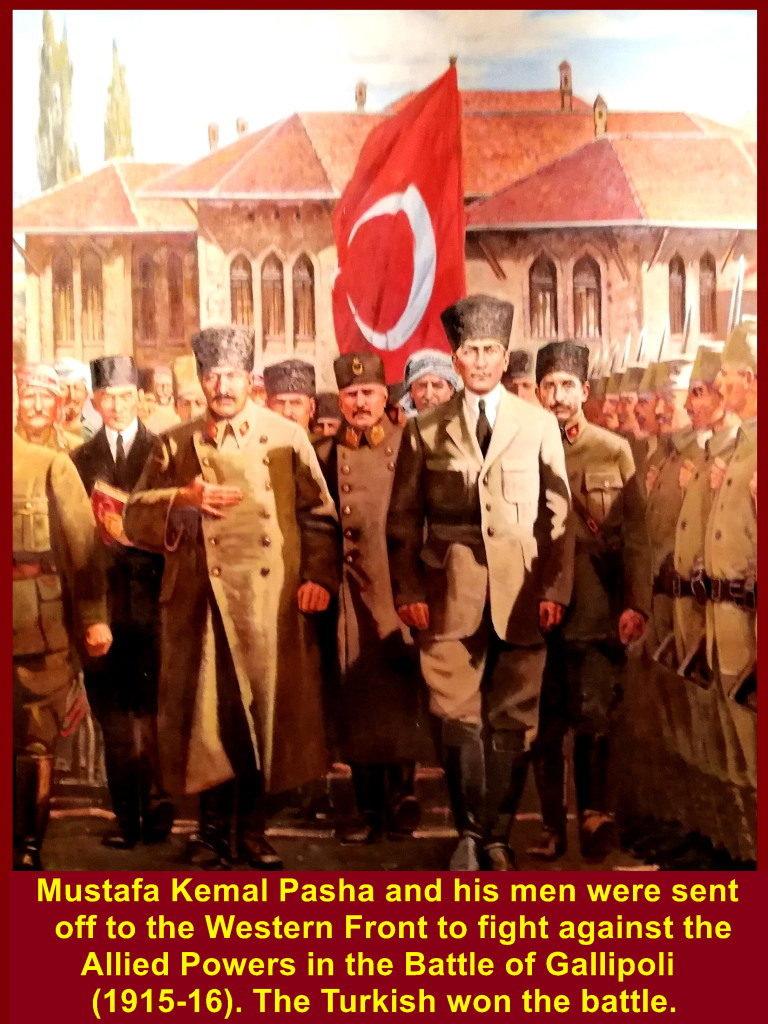
Military Manoeuvre in Ilgin
Commander-in-Chief Ghazi Mustafa Kemal Pasha and Commander of Western Front, Imet Pasha, at the big military manoeuvre in Ilgin on 1 April 1922.
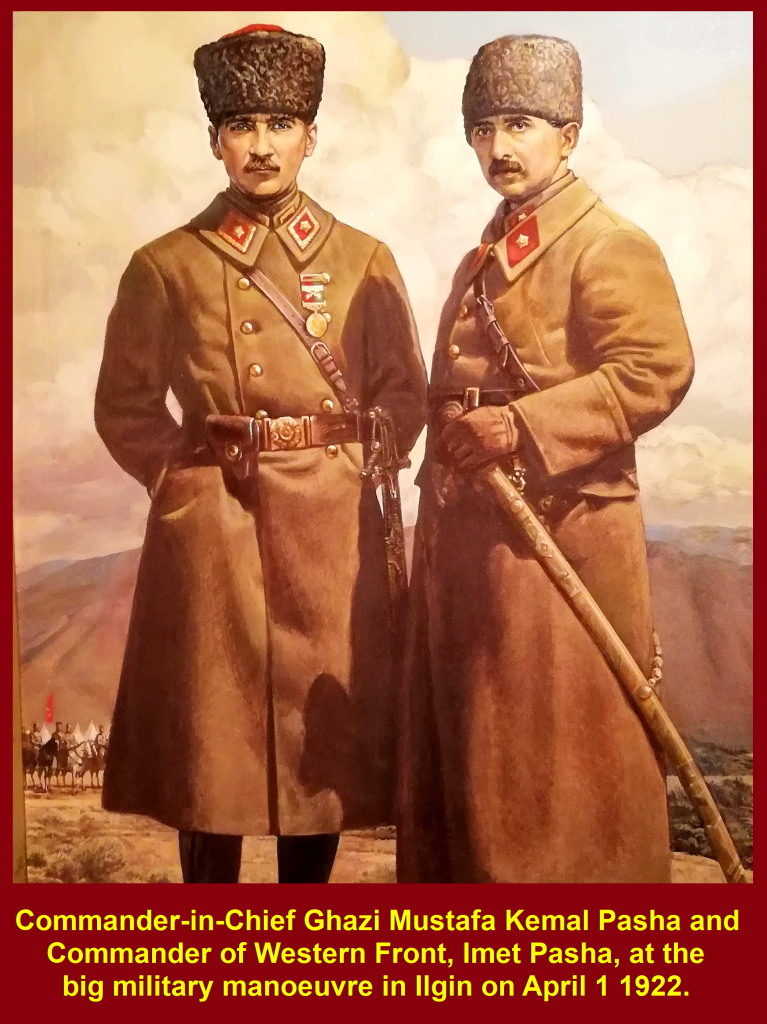
The Great Battle in 1922
Commander-in-Chief Marshal Ghazi, Mustafa Kemal Pasha, were discussing the Great Attack(1922) with the Commander of the Turkish Army and Western Front Commander.
In 1919 the Greek forces captured Smyrna(now Izmir). In 1922 the Great Battle between the Greek and Turkish forces were launched in Smyrna. Turrkish forces counter-attacked and recaptured the town from the Greek.
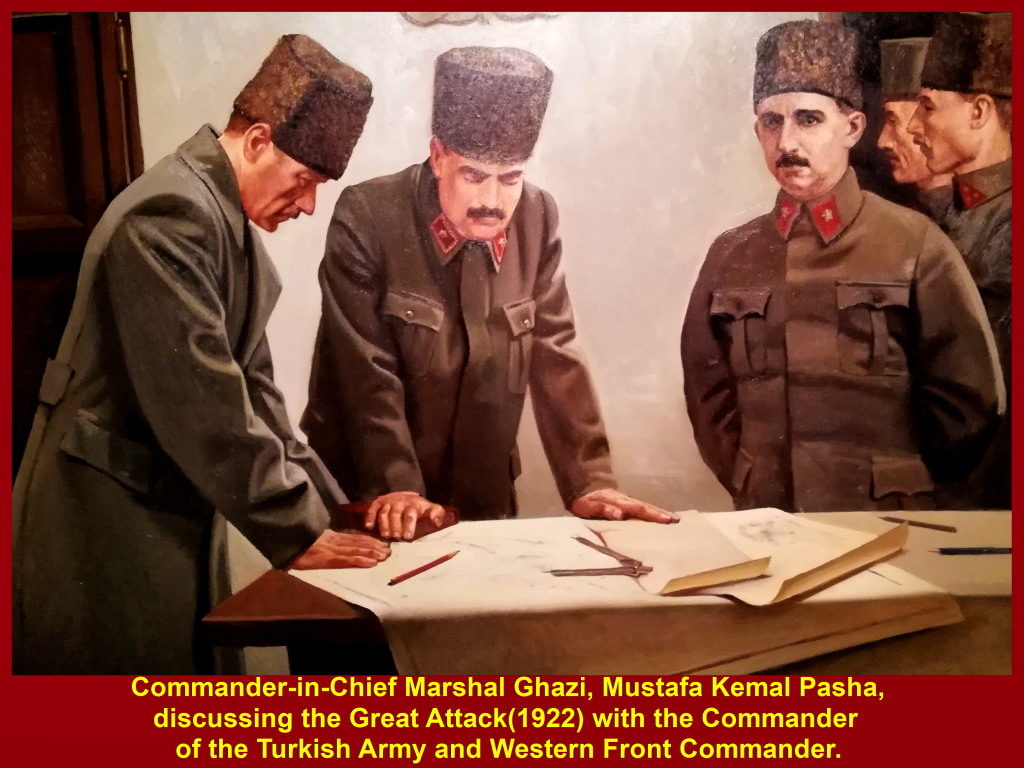
Battle of Gallipoli(1915-16)
Below are some pictures painted on the walls in Anitkabir. They depict the Battle of Gallipoli(1915-16).
(i) Turkish armies firing cannons at British and French in the Battle of Gallipoli in 1915.
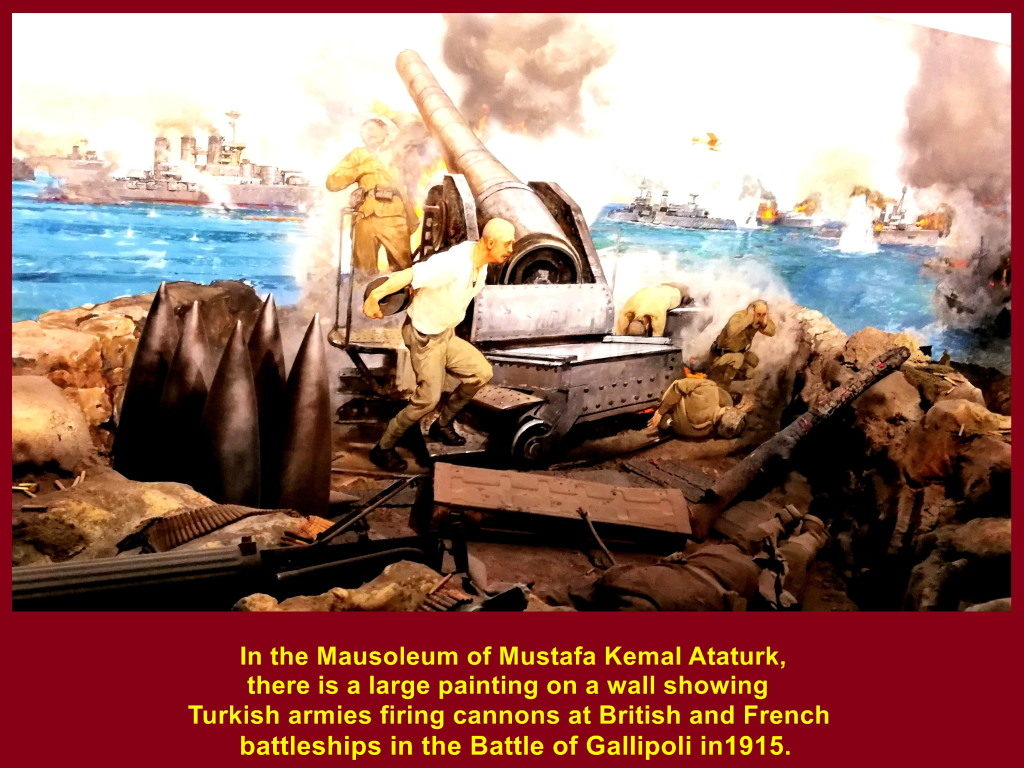
(ii) The Turkish armies fighting against the Allied Powers(Britain, France and Russia) in the Battle of Gallipoli(1915-16)
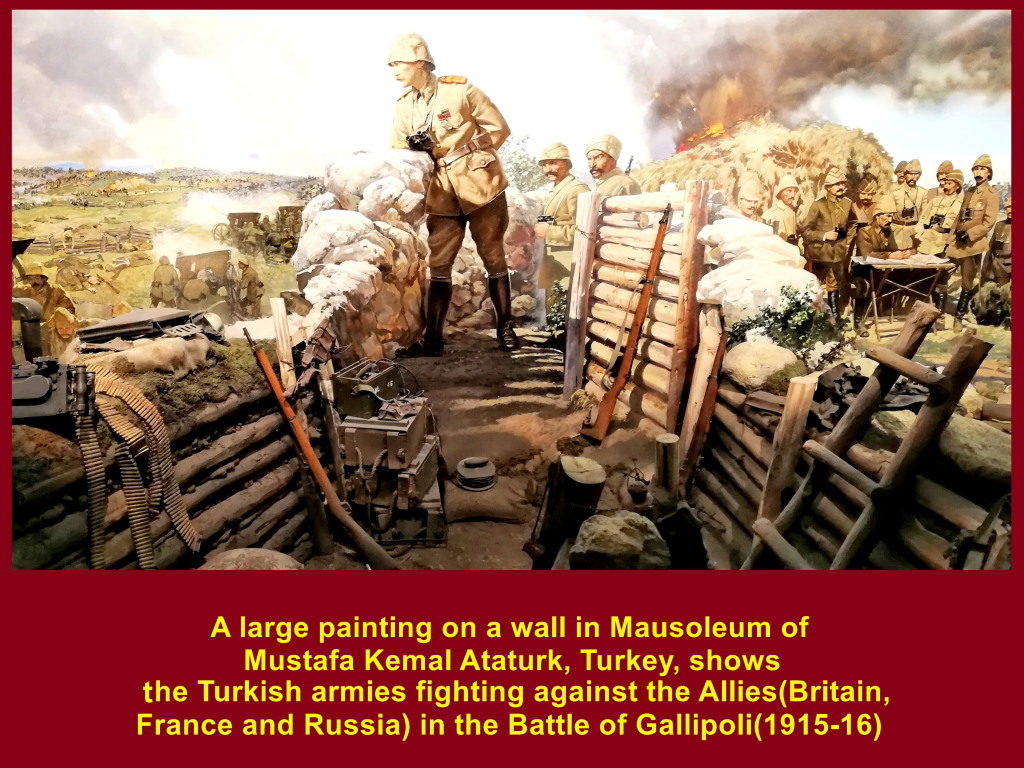
(iii) Nurses were taking care of wounded Turkish soldiers in the Battle of Gallipoli(1915-16)
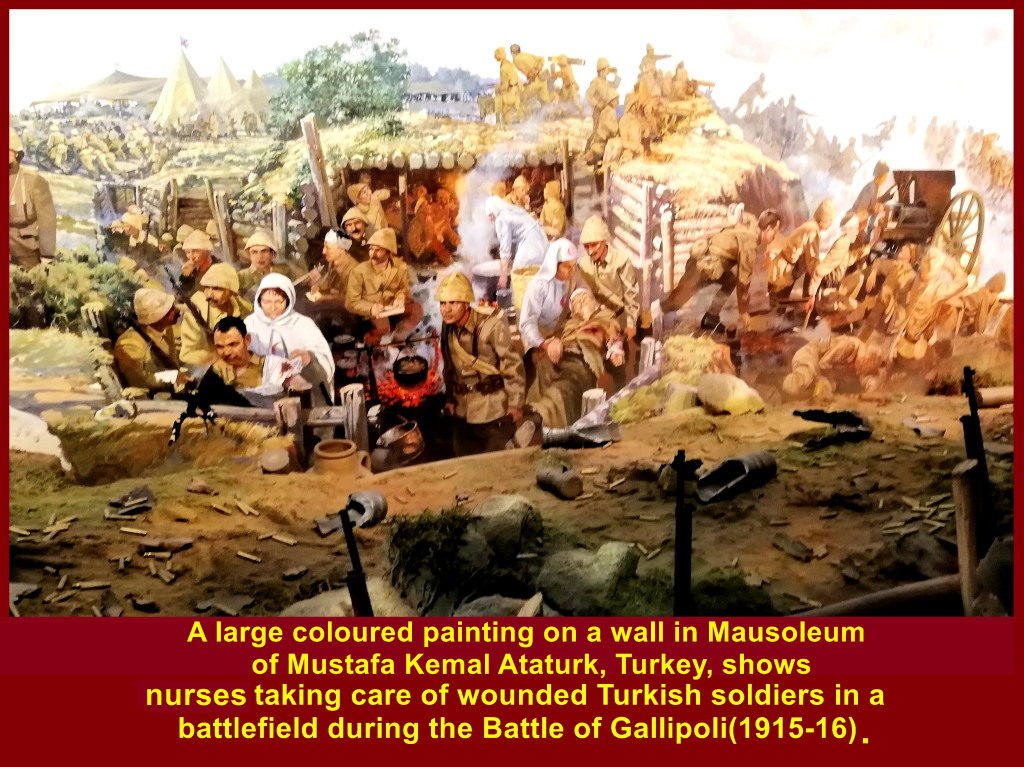
(iv) The Greek armies were invading villages, towns and cities beginning in Anatolia(Turkey) in 1919,
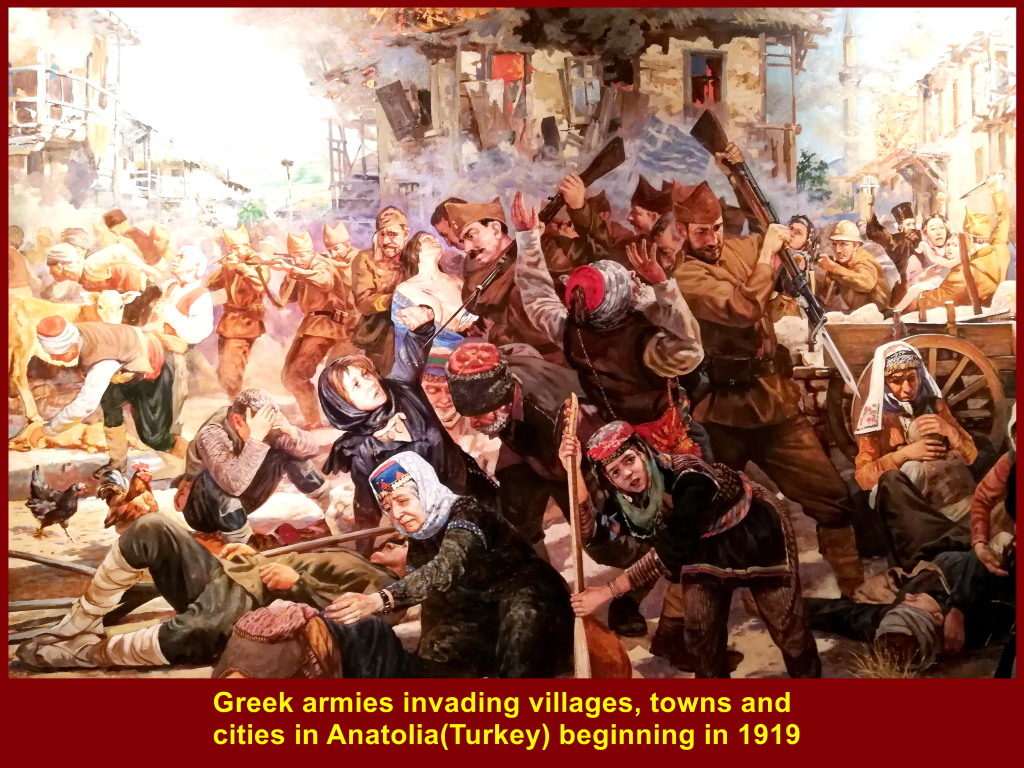
(v) In 1915, the British and French navies attacked the Turkish forces in the Strait of Dardanelles in the Battle of Gallipoli(1915-16) hoping to take control of the waterway between Europe and Russia.
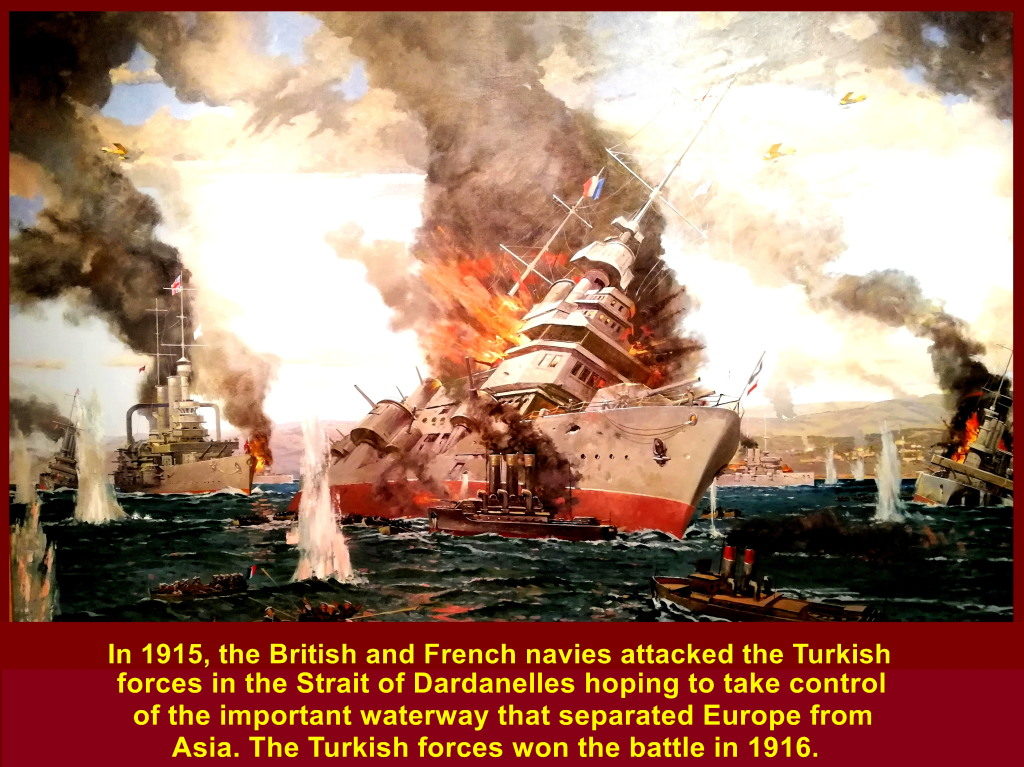
(vi) Turkish soldiers were relaxing during a truce in the Battle of Gallipoli(1915-16) between the Ottoman Empire(Turkey) and the Allies(Britain, France and Russia).
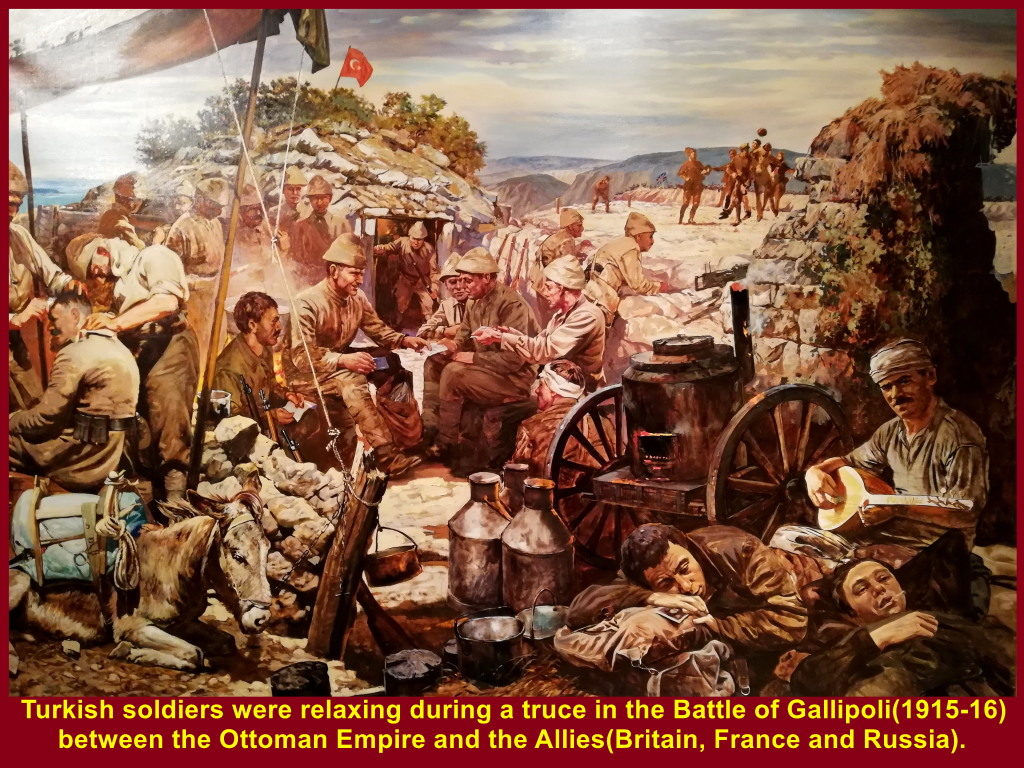
(vii) A Turkish army led by Commander-in-Chief, Ghazi Mustafa Kemal Pasha, and the people of Smyrna(now Izmir) were celebrating victory over the Greek forces in 1922.
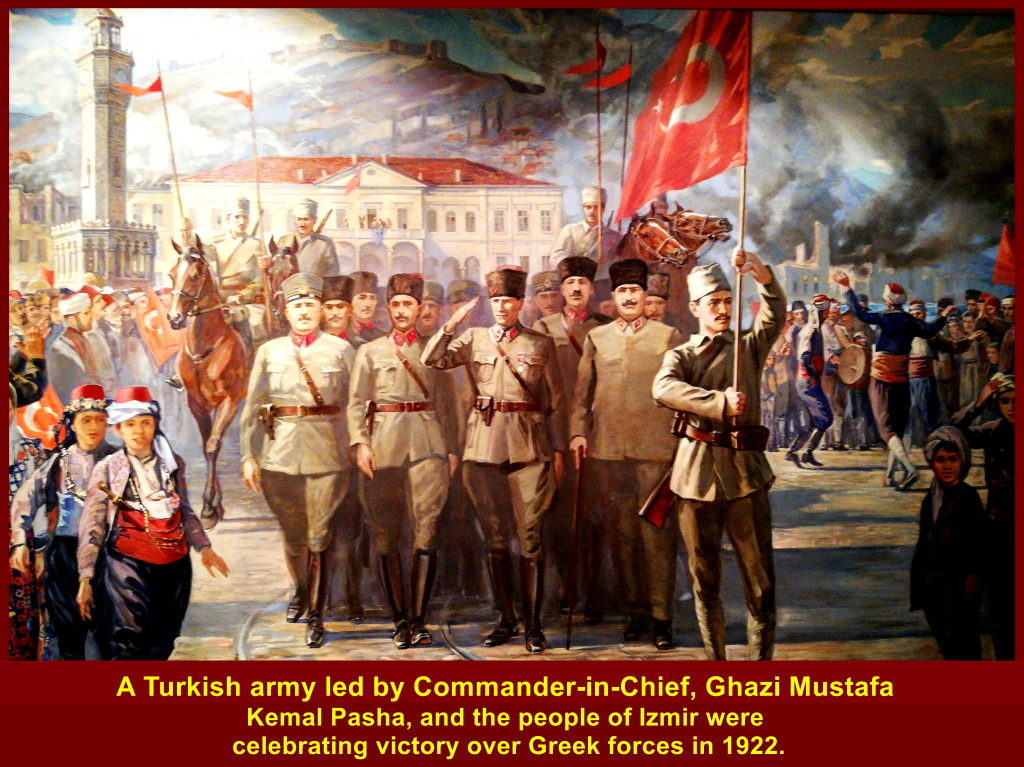
Copper-Tuning Art Pieces
Besides the large paintings about wars against the Allied Powers in the Battle of Gallipoli and the battle against Greece in 1922 in Anitkabir, Ankara, there were copper-tuning art pieces about events leading to the establishment of Republic of Turkey in 1928 and thereafter.
(i) Turkish National Forces founded in 1920
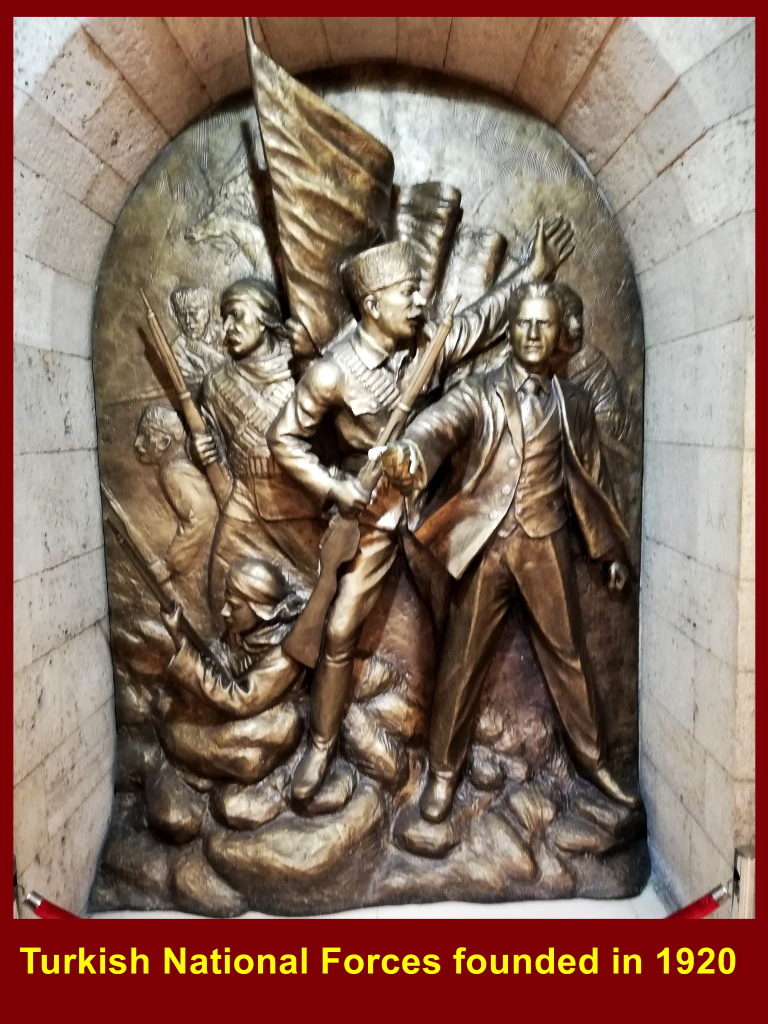
(ii) Inauguration of the Grand National Assembly(1920) and internal revolts
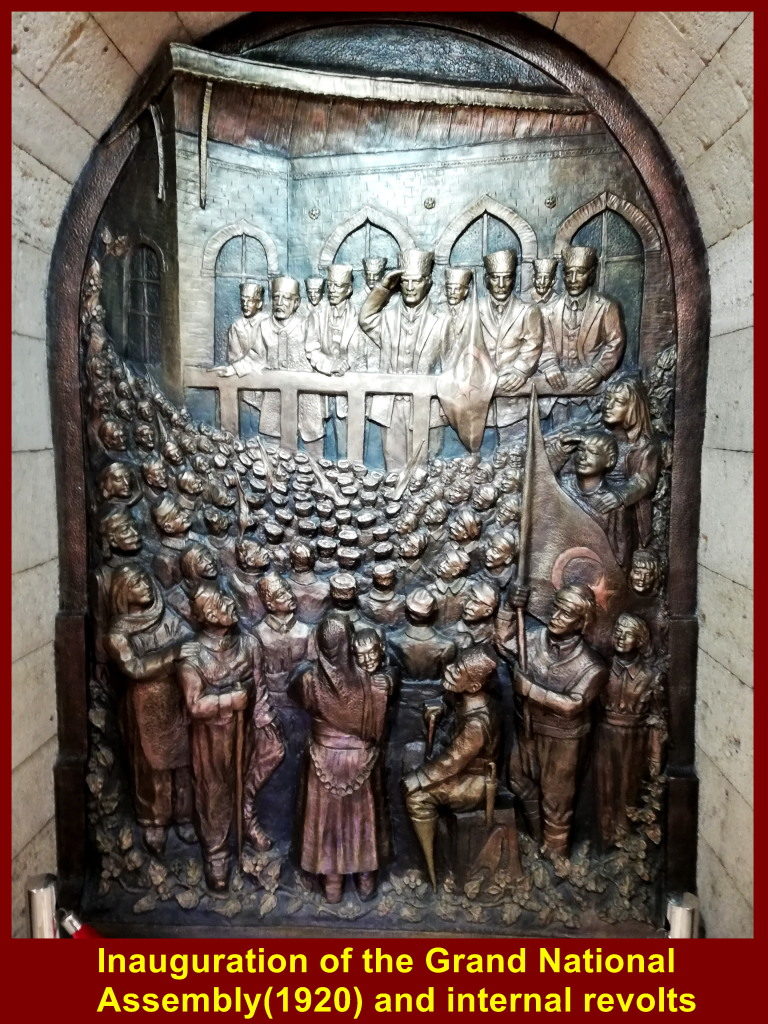
(iii) National struggle in Antep, Maras, Urfa and Thrace
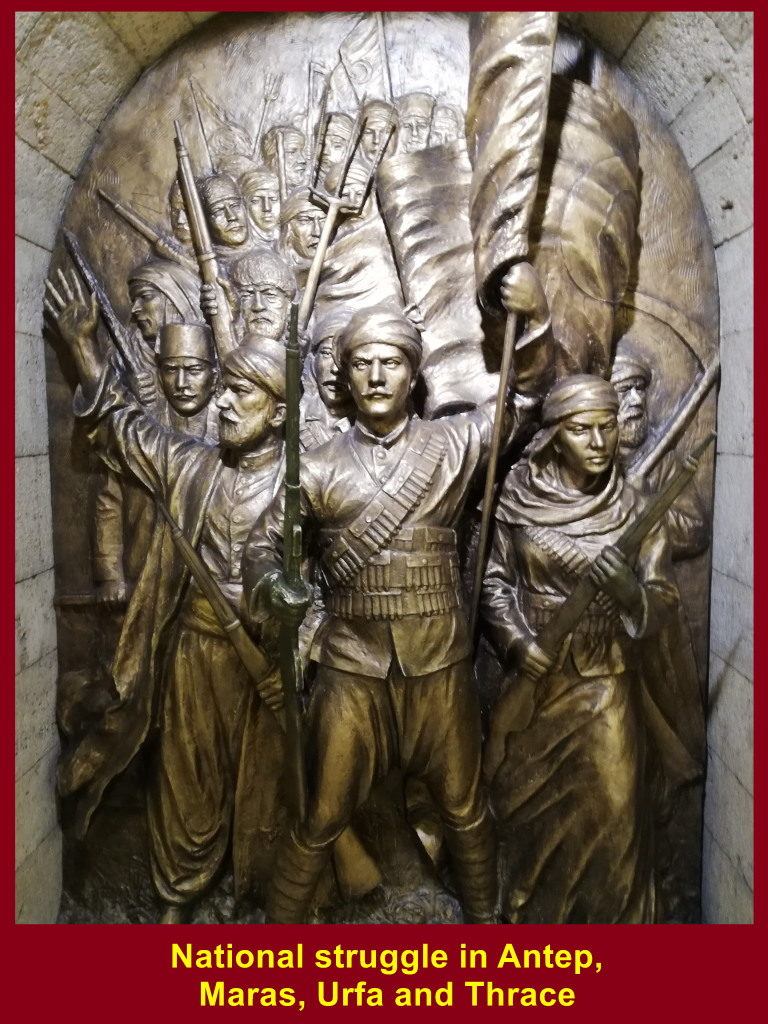
(iv) Vistories, Mudaya Armistice, Treaty of Lausanne and political revolutions
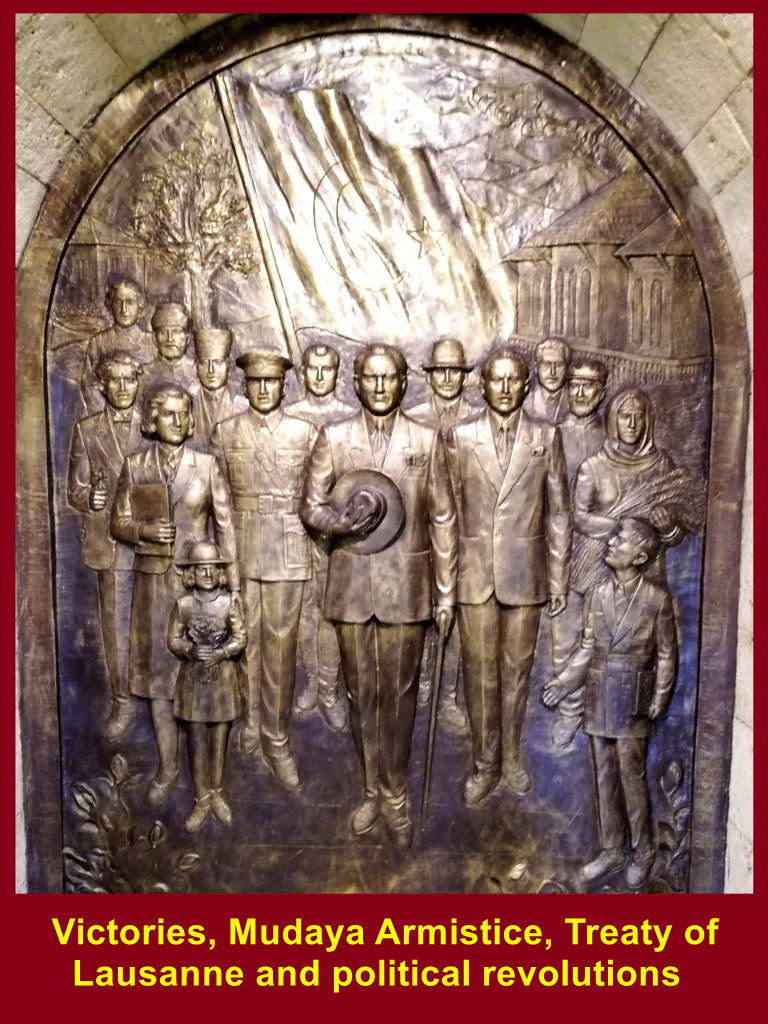
(v) Reforms in law, women’s rights and adoption of surnames
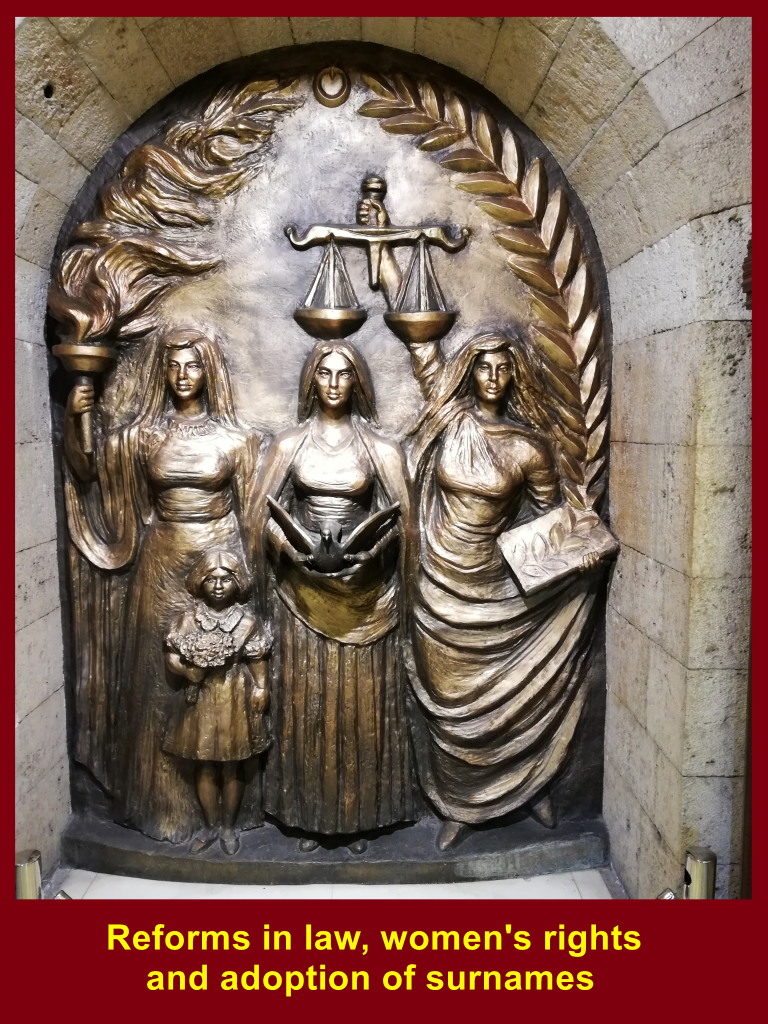
(vi) Turkey’s progress in agriculture, forestry, industry and commerce
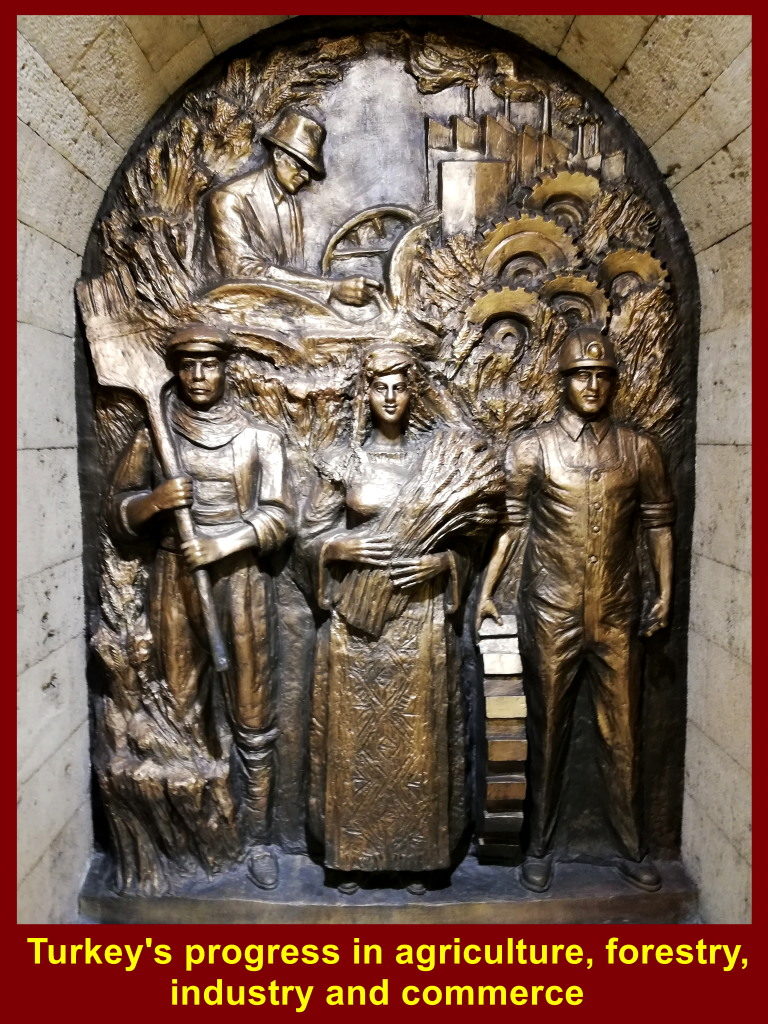
(vii) President of Turkey, Mustafa Kemal Taturk, and his ministers were active in domestic and foreign political events during his term from 1923 until 1938.
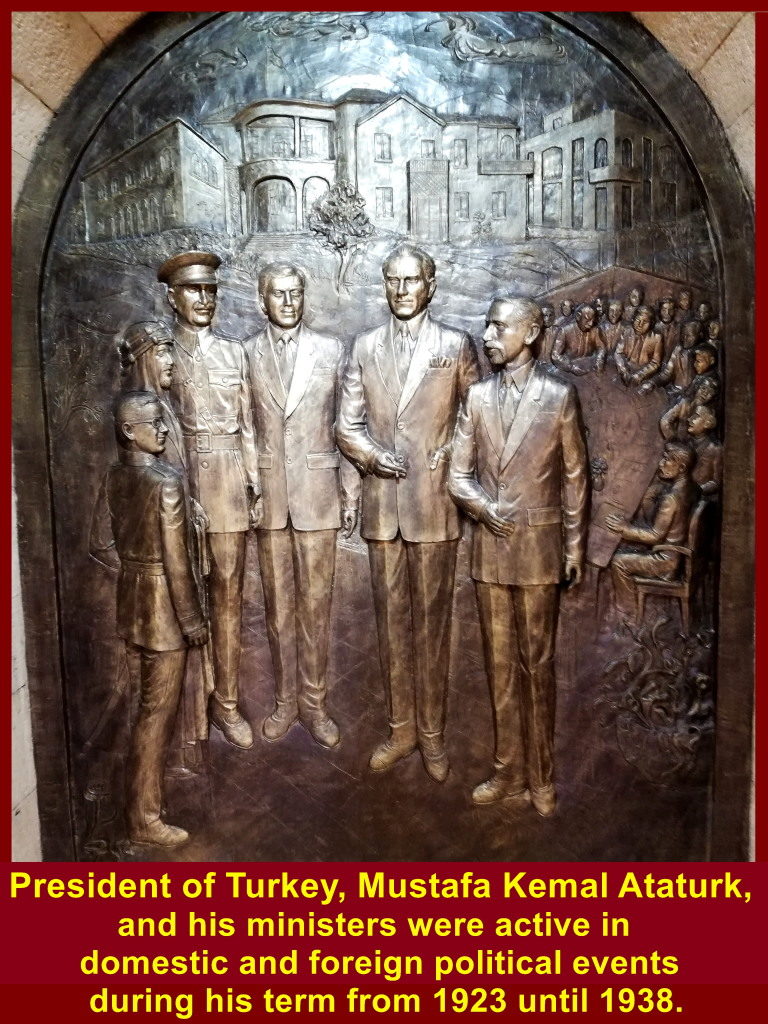
(viii) People of Republic Turkey founded by Mustafa Kemal Ataturk in 1923
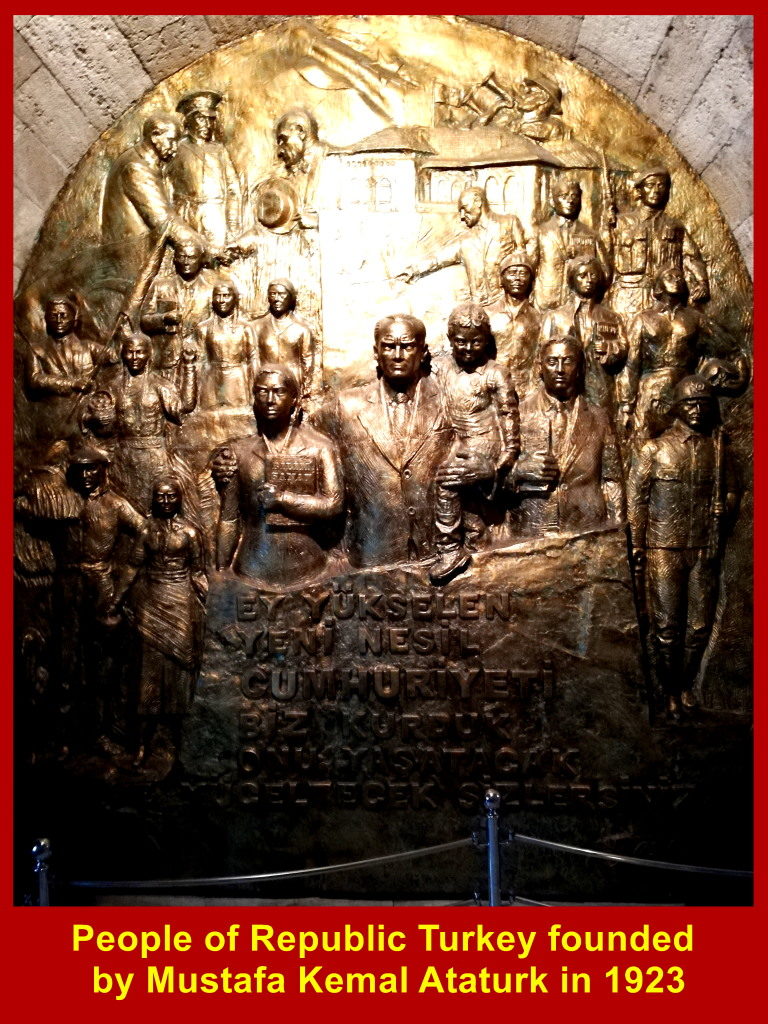
Anitkabir Guards
There are several guards at Anitkabir, Mausoleum of Mustafa Kemal Ataturk, in Ankara. Although there ars standing motionless, they are always watching the visitors.
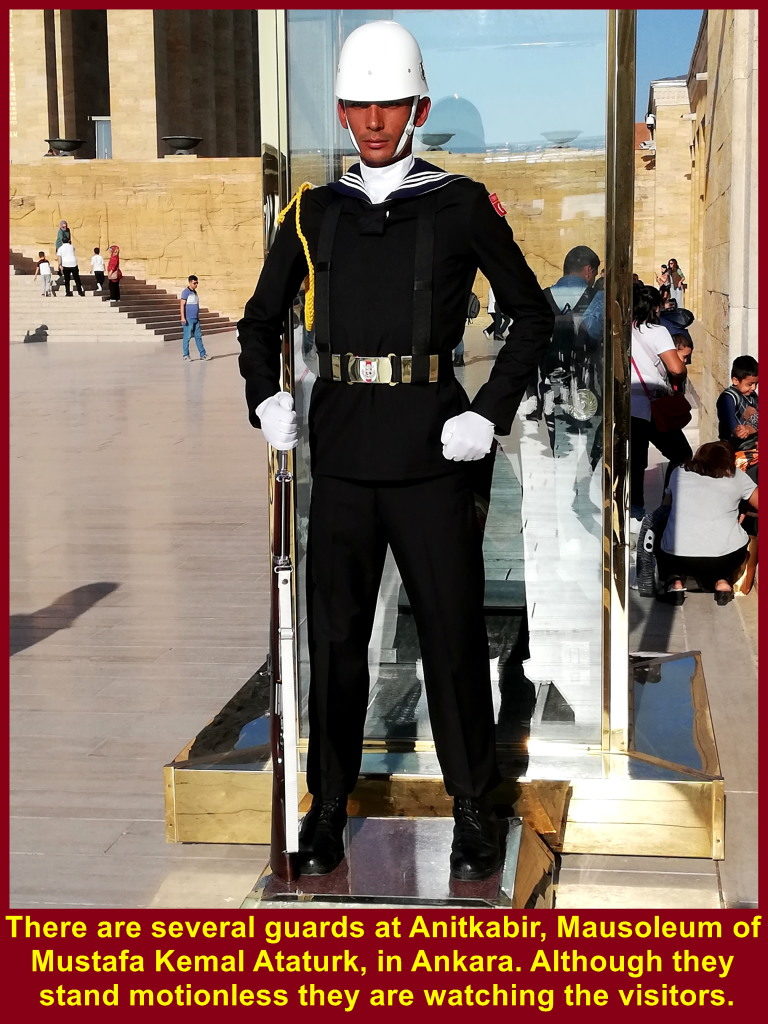
Bera Ankara Hotel, Ankara
At 4 p.m we left Anitkabir, the Mausoleum of Mustafa Kemal Ataturk, and went to Ankara City to have dinner and then checked into a hotel, Bera Ankara Hotel.
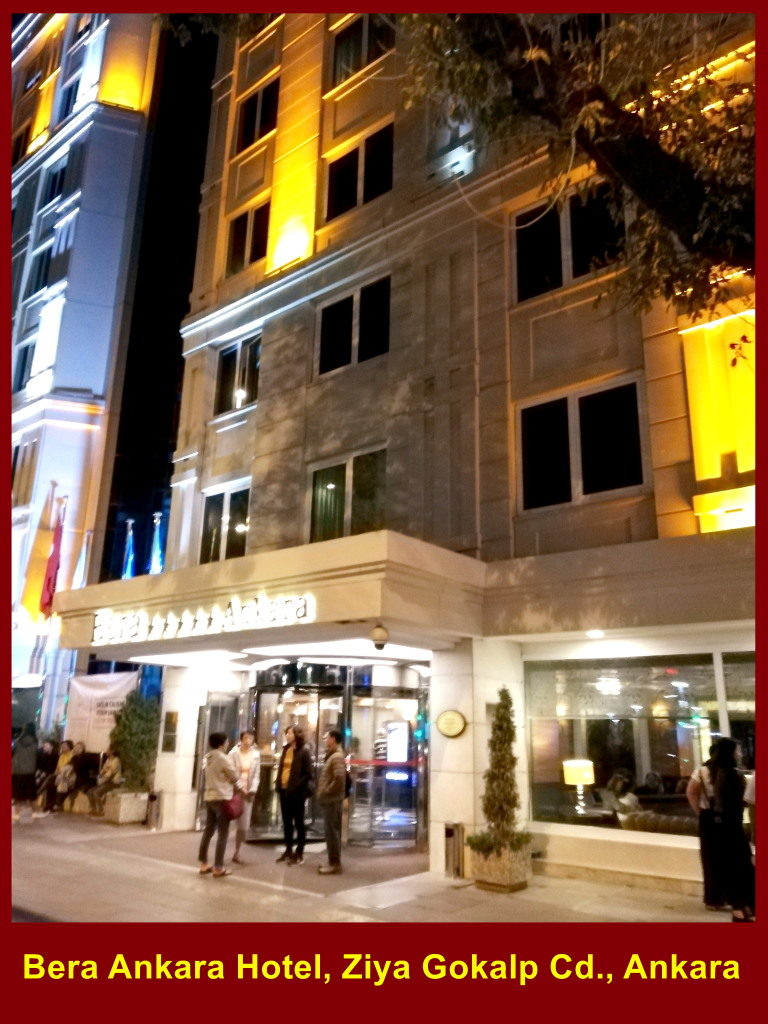
Ziya Gokalp Cd.
At 7 p.m. our tour-manager, Brian Wong, brought us to see the shops along a busy street, Ziya Gokalp Cd., in the City of Ankara.
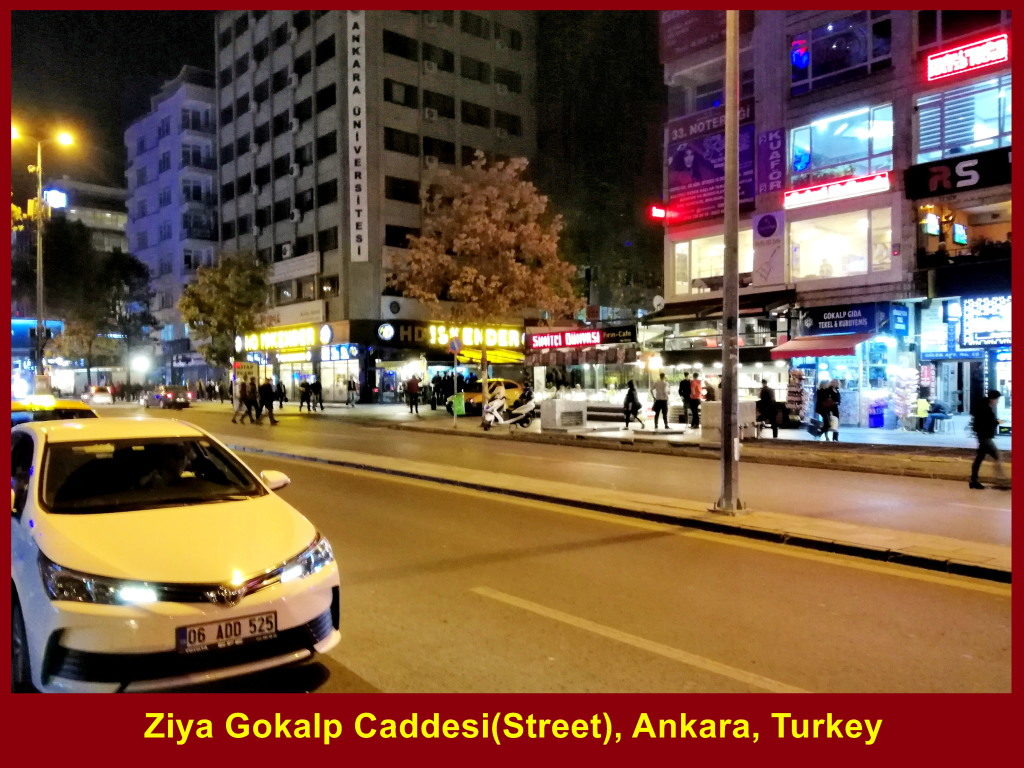
Ice-Cream Delight
After walking a few hundred metres, we stopped at an ice-cream shop, Mado Cafe, and everyone bought an ice-cream each.
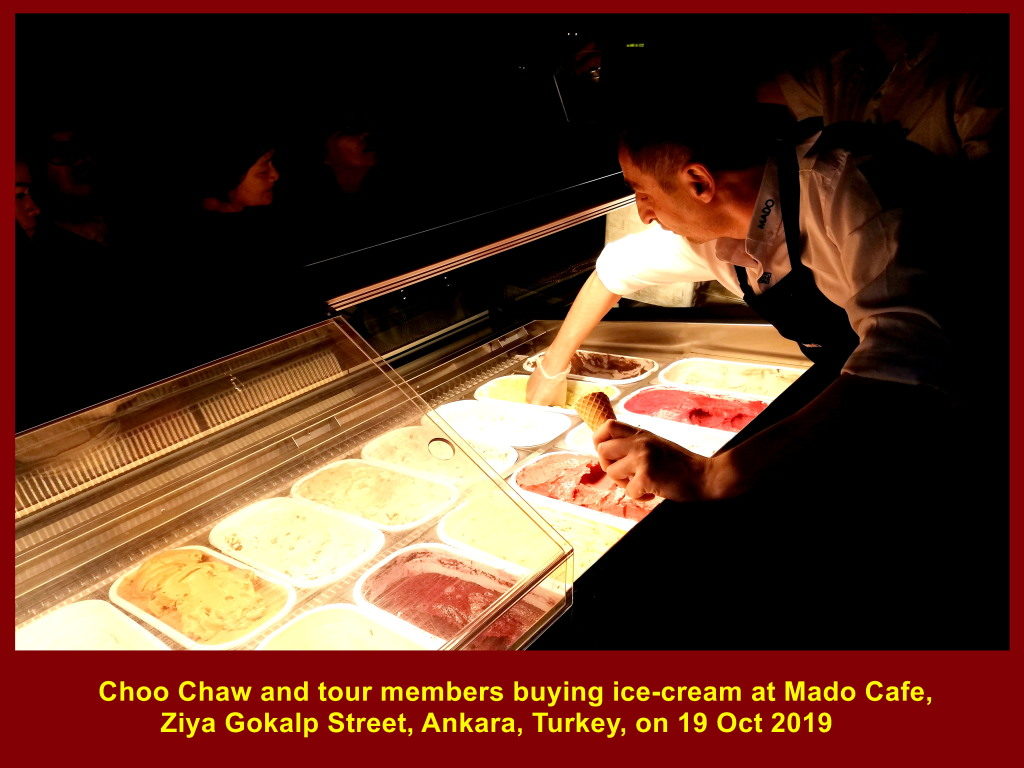
“Wefie”
For remembrance, we took a photo together showing our ice-creams.
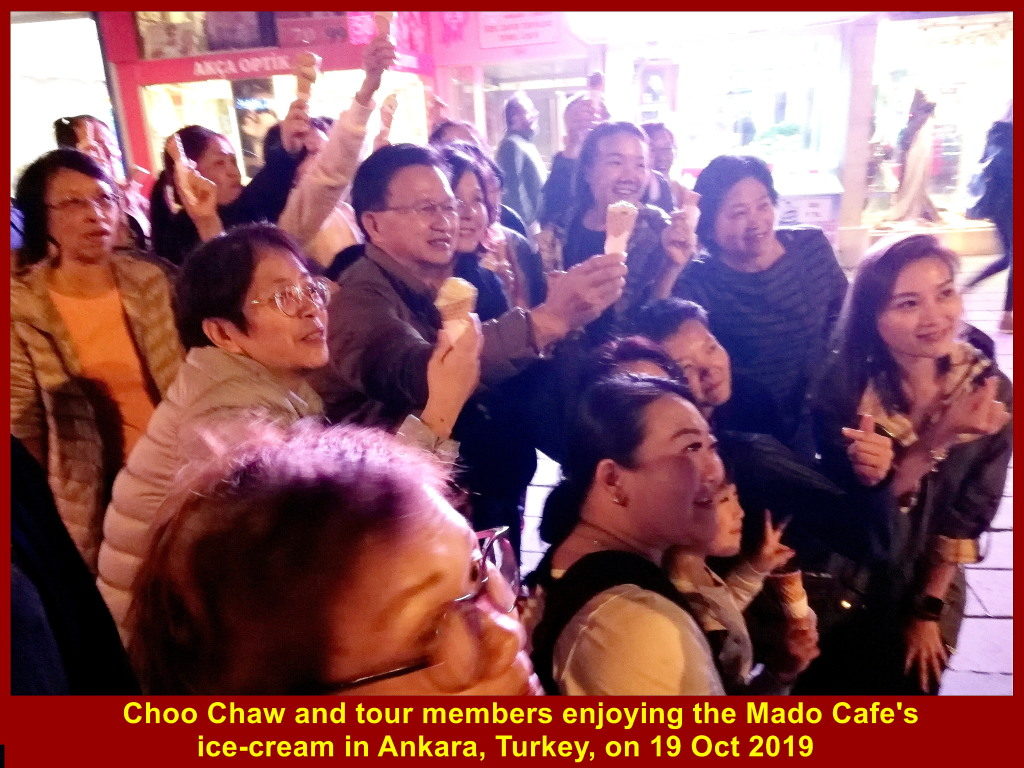
Previous Page / Home / Next Page
Places visited during Turkey Tour(13-22 Oct 2019):
Trojan Horse/Ancient Troy Cities Asklepion Ephesus Hierapolis/Pamukkale Travertine Sultanhani Caravanserai Pasabag Valley Uchisar Valley/Kaymakli Underground City Gerome Valley/Turkish Night Show Hot Air Balloon/Lake Golu/Anitkabir Hagia Sophia/Topkapi Palace/Blue Mosque Bosphorus Boat Cruise Spice Bazaar/Grand Bazaar

